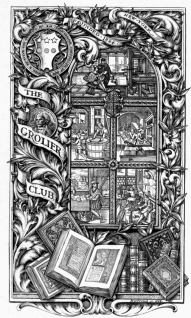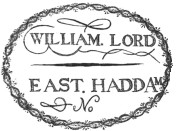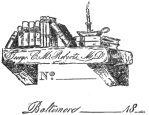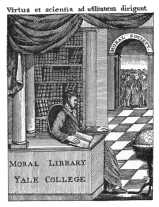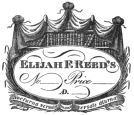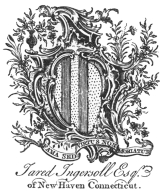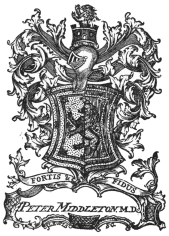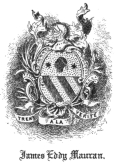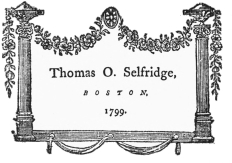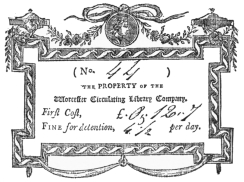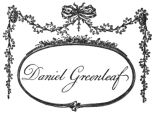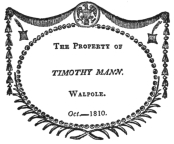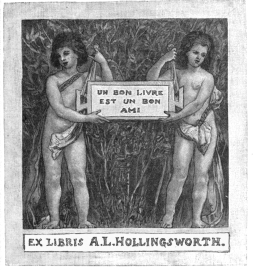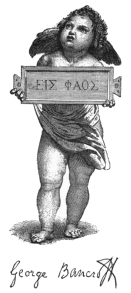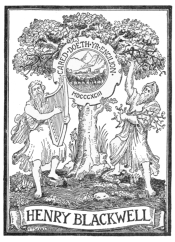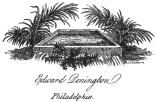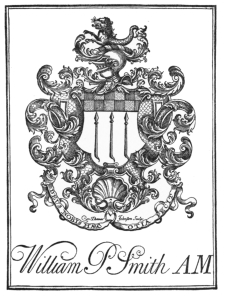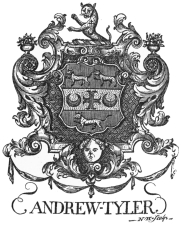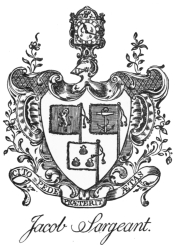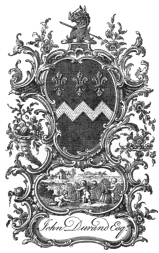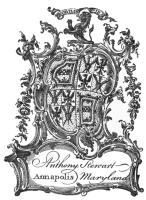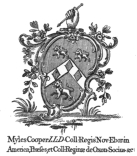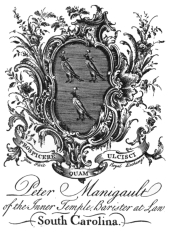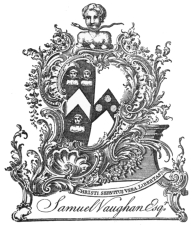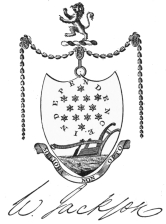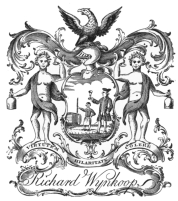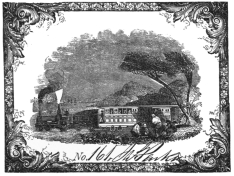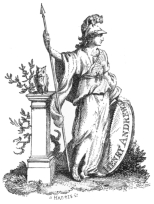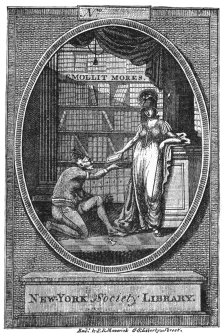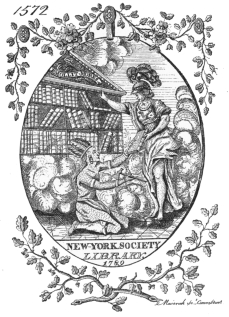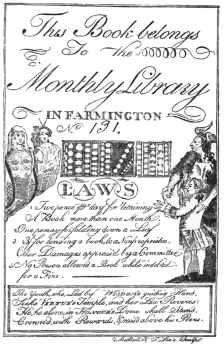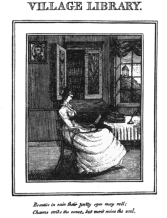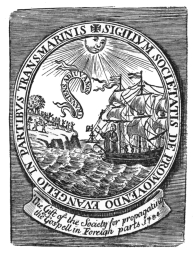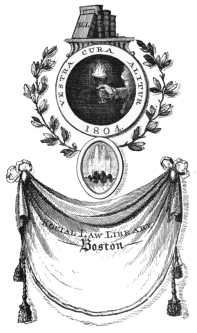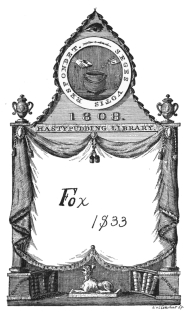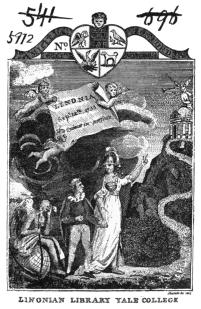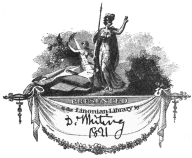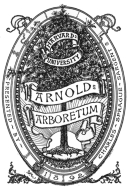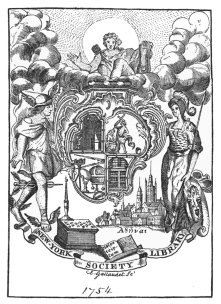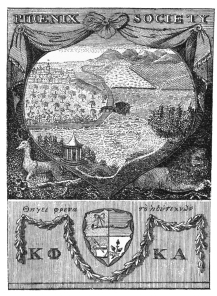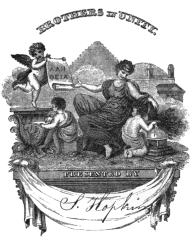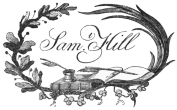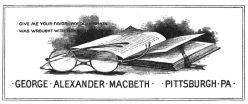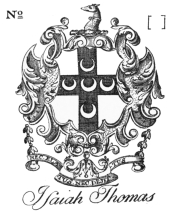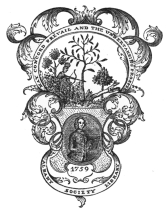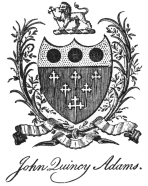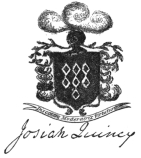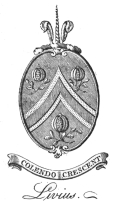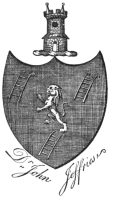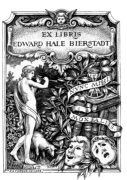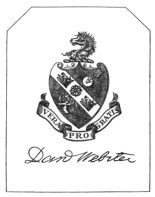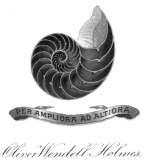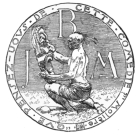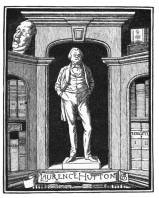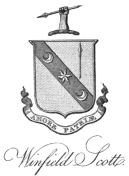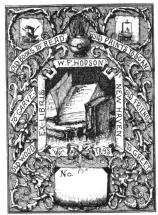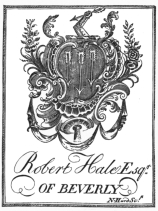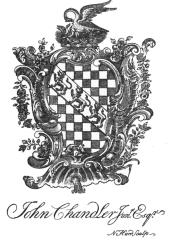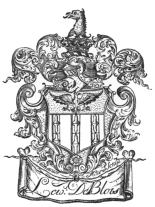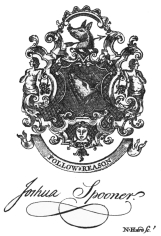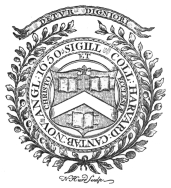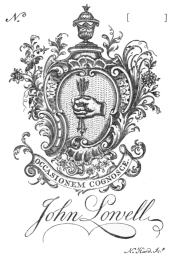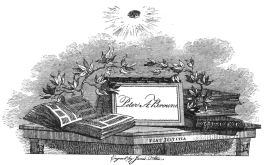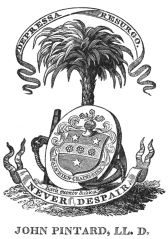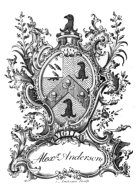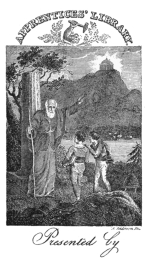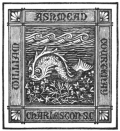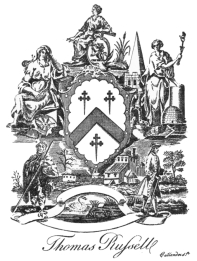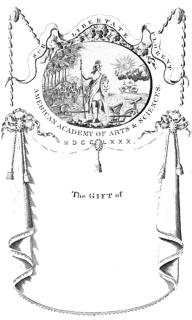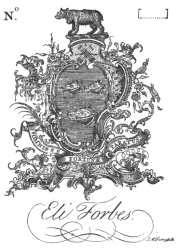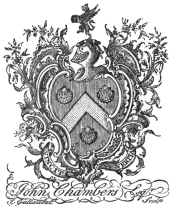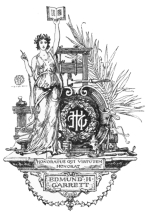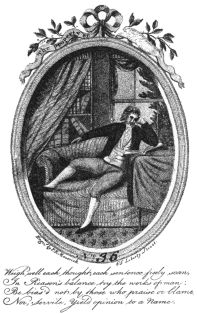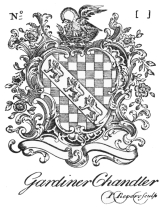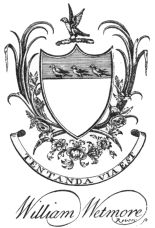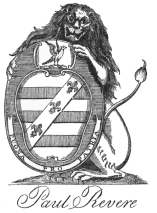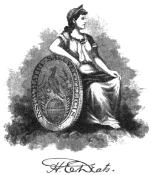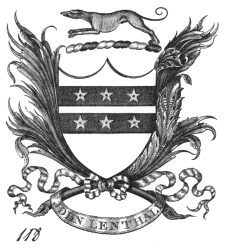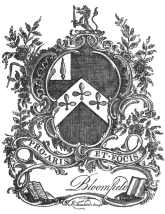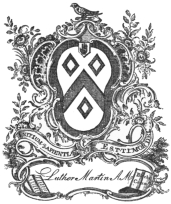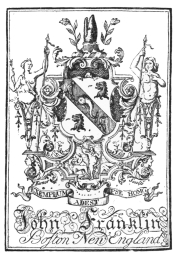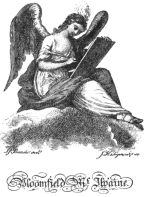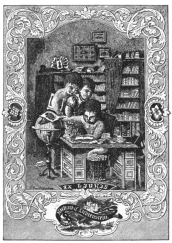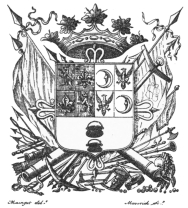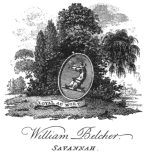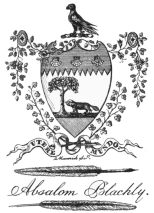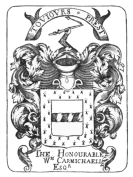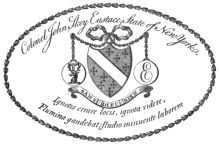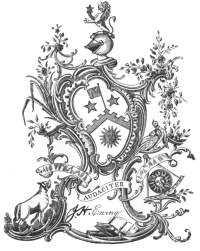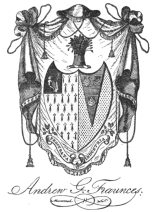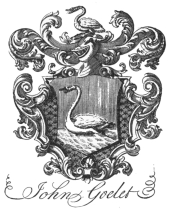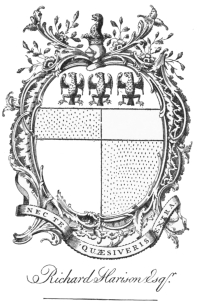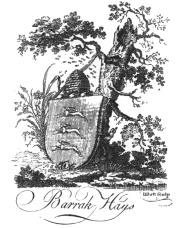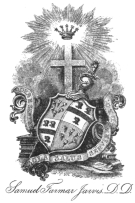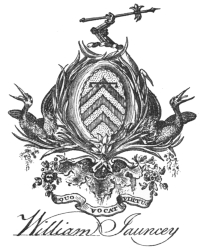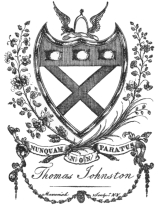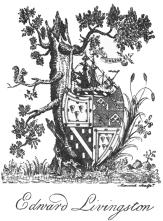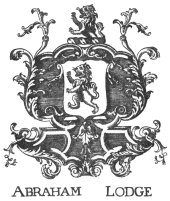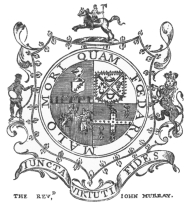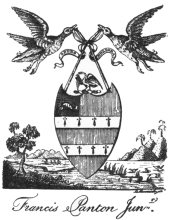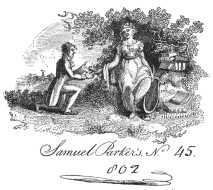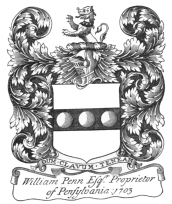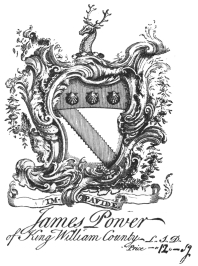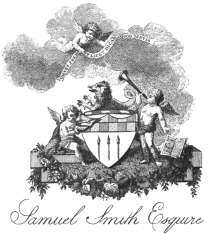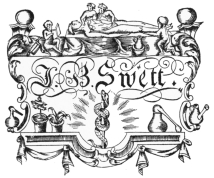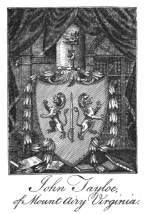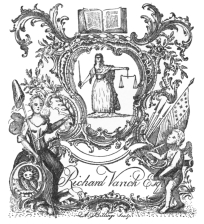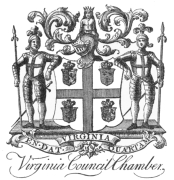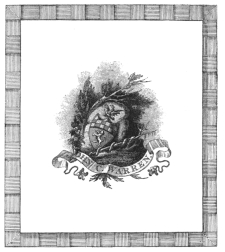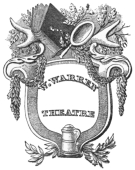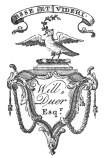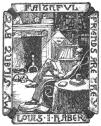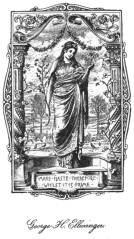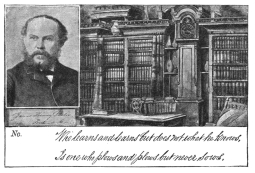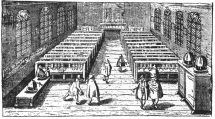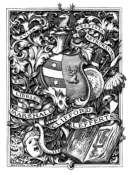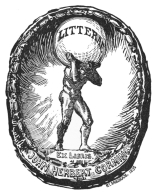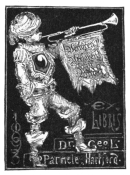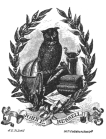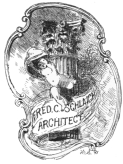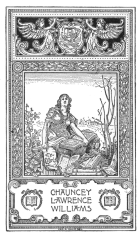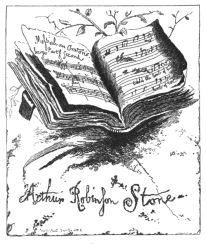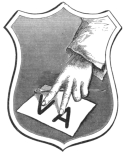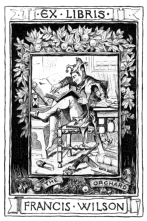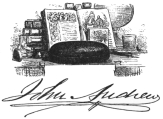*** START OF THE PROJECT GUTENBERG EBOOK 47682 ***
|
Contents.
List of Illustrations.
In certain versions of this etext, in certain browsers,
clicking on this symbol  will bring up a larger version of the illustration.
will bring up a larger version of the illustration.
Index.: A,
B,
C,
D,
E,
F,
G,
H,
I,
J,
K,
L,
M,
N,
O,
P,
Q,
R,
S,
T,
U,
V,
W.
(etext transcriber's note) |
AMERICAN BOOK-PLATES
(EX-LIBRIS)
American Book-Plates
A Guide to their Study with Examples
By Charles Dexter Allen
Member Ex-Libris Society London · Member Grolier Club New York
Member Connecticut Historical Society Hartford
With a Bibliography by Eben Newell Hewins
Member Ex-Libris Society
Illustrated with many reproductions of rare and interesting book-plates
and in the finer editions with many prints from the original
coppers both old and recent


New York · Macmillan and Co. · London
Mdcccxciv
Copyright, 1894,
By MACMILLAN AND CO.
Norwood Press:
J. S. Cushing & Co.—Berwick & Smith.
Boston, Mass., U.S.A.
PREFACE.
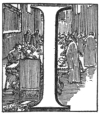 N a few years Book-plate literature will have a place
in the catalogues of the Libraries, as it now has in those of the
dealers in books. The works of the Hon. J. Leicester Warren (Lord de
Tabley), Mr. Egerton Castle, and Mr. W. J. Hardy on the English plates,
Mr. Walter Hamilton, M. Henri Bouchot, and M. Poulet-Malassis on the
French, Herr Warnecke on the German, and M. Carlander on the Swedish,
are all the work of master hands, and are recognized as authorities. In
our own country the lists and essays of Mr. Richard C. Lichtenstein and
Mr. Laurence Hutton have long been of invaluable service, and occupy a
position both at home and abroad of undisputed eminence.
N a few years Book-plate literature will have a place
in the catalogues of the Libraries, as it now has in those of the
dealers in books. The works of the Hon. J. Leicester Warren (Lord de
Tabley), Mr. Egerton Castle, and Mr. W. J. Hardy on the English plates,
Mr. Walter Hamilton, M. Henri Bouchot, and M. Poulet-Malassis on the
French, Herr Warnecke on the German, and M. Carlander on the Swedish,
are all the work of master hands, and are recognized as authorities. In
our own country the lists and essays of Mr. Richard C. Lichtenstein and
Mr. Laurence Hutton have long been of invaluable service, and occupy a
position both at home and abroad of undisputed eminence.
A large number of articles has also been contributed to periodical
literature by those well informed upon the subject, and numerous
monographs testify to the growth of interest in this fascinating study,
and by the names of their authors, to the class of scholars and students
of antiquarian lore who deem the humble book-plate worthy of their
attention.
In view of what has been and of what will be written, this present
modest attempt to introduce more fully than has yet been done, the
book-plates of America, needs to be understood as simply a pioneer work;
a great deal of information will reward the patient and painstaking
investigator of the future, which is now inaccessible, and without
doubt, too, much will be found even within the present to supplement
these pages.
This book could not have been undertaken nor carried to completion had
the writer been denied the generous assistance and hearty sympathy of
our collectors, to whom he desires to express his appreciation of the
kindnesses shown him.
Especially to Mr. R. C. Lichtenstein, Mr. E. N. Hewins, and Mr. Fred J.
Libbie of Boston, does he feel under deep obligation for the generous
loan of their splendid collections, for ready advice and counsel, for
cheerful assistance whenever asked for, and for that tangible sympathy
and lively interest which are worth so much to one engaged in such work.
To many others also is he indebted, both for the loan of plates and for
kindly words of encouragement.
To Mr. S. P. Avery, Mr. Beverly Chew, Mr. E. H. Bierstadt, Mr. Henry
Blackwell, Mr. D. McN. Stauffer, Mr. Edward D. Harris, Mr. Laurence
Hutton, and Mr. E. W. Nash, of New York City; to Mr. W. G. Brown of
Washington and Lee University at Lexington, Va.; Mr. H. E. Deats of
Flemington, N.J.; Dr. C. E. Clark of Lynn; Hon. W. A. Courtnay of
Charleston, S.C.; Miss Helen E. Brainerd of the Columbia College
Library; Mr. Pickering Dodge of Washington, D.C.; Mr. Charles T. Martin,
Mr. Frank B. Gay, Mr. A. C. Bates, and Mr. John C. Parsons, of
Hartford; Dr. Henry C. Eno of Saugatuck; Dr. J. H. Dubbs of Lancaster,
Penn., President of Franklin and Marshall College; Mr. D. V. R. Johnston
of the State Library at Albany; Mr. Nathaniel Paine of Worcester; Mr.
Daniel Ravenel of Charleston, S.C.; Mr. Howard Sill of Glendale, Md.;
Mr. R. A. Brock of Richmond, Va.; Mr. Howard Edwards of Philadelphia;
Dr. Swan M. Burnett of Washington, D.C.; Mr. Richard Wijnkoop of
Brooklyn; Mr. Bisbee of Dartmouth College; Mr. William Kelby of the New
York Historical Society; and to Mr. Lyon G. Tyler of Williamsburg, Va.,
President of William and Mary College, does he wish to make
acknowledgment for the favors which have contributed so much to the
value of the work. From over the sea, particularly kind assistance has
come from Rev. T. W. Carson, the veteran collector and eminent authority
of Dublin.
To all others who by letter, gift, or advice have assisted him, the
writer wishes hereby to make suitable and hearty acknowledgment.
The writer’s thanks are also extended to those who have so kindly
permitted him the use of their plates for the illustrating of the book.
A word more is due to Mr. E. N. Hewins, who very kindly, at the writer’s
request, accepted the labor of preparing the excellent Bibliography
which appears in the volume.
CHARLES DEXTER ALLEN.
Hartford, Conn., June, 1894.
CONTENTS
| | PAGE |
| Preface | v |
| A List of the Illustrations | xi |
| Introductory | 1 |
| Name-labels and Mottoes | 16 |
| Armorial Book-plates | 35 |
| Pictorial and Allegorical Book-plates and Plates of Colleges, Libraries, and Societies | 57 |
| Book-plates of Special Interest | 79 |
| Early American Book-plate Engravers, with Lists of Their Work | 104 |
| An Alphabetical List of Early American Book-plates | 160 |
| A Chronological List of the Dated Plates | 313 |
| An Alphabetical List of the Signed Plates, showing the Exact Manner of Signing | 314 |
| A List of Mottoes found upon the Early Plates, with Translations | 323 |
| A Few Recent Examples | 340 |
| The American Collectors and Collections | 377 |
| The Ex Libris Societies | 387 |
| Bibliography (American, English, and French) | 389 |
| Conclusion | 421 |
| Index:
A,
B,
C,
D,
E,
F,
G,
H,
I,
J,
K,
L,
M,
N,
O,
P,
Q,
R,
S,
T,
U,
V,
W. | 422 |
LIST OF ILLUSTRATIONS.
| Copper-plates. |
|---|
| The Grolier Club, by E. D. French | Frontispiece |
| Charles Dexter Allen, by E. H. Garrett | Title-page |
| | To face page |
| Edward Hale Bierstadt, by E. D. French | 90 |
| Oliver Wendell Holmes | 98 |
| Alexander Anderson, by Anderson | 120 |
| American Academy of Arts and Sciences, attributed to
Callender | 126 |
| George Goodwin, attributed to Doolittle | 132 |
| Marshall C. Lefferts, by E. D. French | 352 |
| George Dudley Seymour, by W. F. Hopson | 370 |
| Francis Wilson, by E. H. Garrett | 376 |
| Full-page Reproductions. |
|---|
| Jereh. Wadsworth | 1 |
| Moral Library, Yale College | 6 |
| James Eddy Mauran | 16 |
| Eugene Field | 35 |
| Jacob Sargeant, by Jacob Sargeant | 46 |
| Peter Manigault, by Yates | 52 |
| John Williams | 54 |
| Richard Wynkoop | 56 |
| Social Law Library | 66 |
| George Alexander Macbeth | 79 |
| W. F. Hopson, by W. F. Hopson | 104 |
| William Ashmead Courtenay | 122 |
| Edmund H. Garrett, by E. H. Garrett | 138 |
| H. E. Deats | 150 |
| Richard C. Lichtenstein, by George Moore | 160 |
| Louis J. Haber | 323 |
| George H. Ellwanger, by Sidney L. Smith | 340 |
| John E. Russell, by M. T. Callahan | 357 |
| Dean Sage | 360 |
| Fred C. Schlaick, by Howard Sill | 362 |
| Arthur Robinson Stone, by George M. White | 364 |
| F. W. Hoyt | 366 |
| Illustrations in the Text. |
|---|
| | PAGE |
| George Lee Tuberville, Virginia | 2 |
| Timothy Newell, printed by Isaiah Thomas | 3 |
| William Lord, East Haddam | 5 |
| Geo. C. M. Roberts, M.D., Baltimore | 6 |
| Elijah F. Reed | 7 |
| Jared Ingersoll, Esq., of New Haven, Conn. | 8 |
| John Walters Gibbs, Charleston, S.C., by Abernethie | 9 |
| Peter Middleton, M.D., by J. Lewis | 10 |
| Harrison Gray Otis | 11 |
| Lieut. E. Trenchard, U. S. Navy | 12 |
| Samuel Elam, Rhode Island | 13 |
| John Adams | 15 |
| Hannah Reynolds | 17 |
| E Libris Thomæ Holt | 18 |
| John Campbell, Charles County | 19 |
| Richard Sprigg, Jr., by T. Sparrow | 20 |
| Thomas O. Selfridge, Boston, 1799 | 22 |
| Worcester Circulating Library | 23 |
| Daniel Greenleaf | 25 |
| Timothy Mann, Walpole, Oct., 1810 | 27 |
| A. L. Hollingsworth, Boston, Mass. | 29 |
| George Bancroft | 31 |
| William Prescott | 32 |
| Henry Blackwell, New York City | 33 |
| Edward Pennington, Philadelphia | 34 |
| Gabriel Jones, Attorney at Law, in Virginia | 36 |
| Joseph Dudley, 1754 | 38 |
| Jer. Dummer, Anglus Americanus | 39 |
| Minot, Boston | 40 |
| Frederik Philipse, Esq. | 42 |
| William P. Smith, A.M., by Thomas Johnston | 45 |
| Andrew Tyler, by Hurd | 46 |
| John Durand, Esq. | 47 |
| Anthony Stewart, Annapolis, Md. | 48 |
| Myles Cooper, LL.D., etc. | 49 |
| Andrew Oliver, attributed to Hurd | 50 |
| Benjamin Kissam, by Dawkins | 51 |
| Samuel Vaughan, Esq. | 53 |
| W. Jackson | 54 |
| De Witt Clinton, by Maverick | 55 |
| James Parker | 58 |
| Henry Andrews, by Harris | 59 |
| New York Society Library, by Maverick | 60 |
| New York Society Library, 1789, by Maverick | 61 |
| Monthly Library in Farmington, Conn. | 63 |
| Village Library, Farmington, Conn. | 65 |
| Society for Propagating the Gospel in Foreign Parts | 66 |
| Hasty Pudding Library, Harvard College | 68 |
| Linonian Library, Yale College | 69 |
| Linonian Library (Yale College) | 70 |
| Arnold Arboretum, 1892, by Geo. Wharton Edwards | 72 |
| New York Society Library, by Elisha Gallaudet | 74 |
| Phoenix Society | 76 |
| Brothers in Unity, Yale College, by Pelton | 77 |
| Samuel Hill | 78 |
| Stephen Cleveland | 80 |
| Columbia College Library, New York, by Anderson | 81 |
| Isaiah Thomas | 83 |
| Albany Society Library, 1759 | 84 |
| John Quincy Adams | 86 |
| Josiah Quincy | 87 |
| Livius | 88 |
| Dr. John Jeffries, attributed to Callender | 89 |
| Geo. Washington, genuine | 91 |
| Geo. Washington, fraudulent | 94 |
| Bushrod Washington | 96 |
| Daniel Webster | 97 |
| Brander Matthews, by E. A. Abbey | 99 |
| Edmund Clarence Stedman | 100 |
| Laurence Hutton | 102 |
| Winfield Scott | 103 |
| Robert Hale, Esq., of Beverly, by Hurd | 107 |
| John Chandler, Jr., Esq., by Hurd | 108 |
| Lewis De Blois, by Hurd | 109 |
| Joshua Spooner, by Hurd | 110 |
| Harvard College, by Hurd | 112 |
| John Vassall, Esq., by Hurd | 114 |
| John Lowell, by Hurd | 115 |
| Peter A. Browne, by Akin | 118 |
| John Pintard, LL.D., by Anderson | 120 |
| Apprentices’ Library, New York City, by Anderson | 121 |
| Thomas Russell, by Callender | 125 |
| Henry D. Gilpin, by Childs | 127 |
| Whitehead Hicks, by Dawkins | 130 |
| Social Library, Wethersfield, by Doolittle | 133 |
| Eli Forbes, by Furnass | 135 |
| John Chambers, by Elisha Gallaudet | 136 |
| Anonymous, by Maverick | 141 |
| Abraham Bancker, by Maverick | 143 |
| Gardiner Chandler, by Revere | 146 |
| William Wetmore, by Revere | 147 |
| Paul Revere, by Revere | 148 |
| John Lenthall, by Thackara | 153 |
| Bloomfield, by Trenchard | 154 |
| Luther Martin, attributed to Trenchard | 155 |
| John Franklin, Boston, New Eng., by Turner | 156 |
| Bloomfield McIlvaine, by Seymour | 157 |
| G. A. Smith | 159 |
| Anonymous, by Maverick | 161 |
| William Belcher, Savannah | 171 |
| Absalom Blackley, by Maverick | 173 |
| Hon. William Carmichael, Esq. | 181 |
| Col. John Skey Eustace | 199 |
| Ewing | 201 |
| Andrew G. Fraunces, by Maverick | 205 |
| John Goelet, attributed to Maverick | 209 |
| Richard Harison | 215 |
| Barrack Hays, by Hutt | 219 |
| Samuel Farmar Jarvis, D.D. | 227 |
| William Jauncey | 229 |
| Thomas Johnson, by Maverick | 231 |
| Edward Livingston, by Maverick | 238 |
| Abraham Lodge | 240 |
| Rev. John Murray | 253 |
| Francis Panton, Jr., by Maverick | 259 |
| Samuel Parker | 260 |
| William Penn | 263 |
| James Power | 270 |
| Samuel Smith | 283 |
| J. B. Swett | 289 |
| John Tayloe | 291 |
| Richard Varick, by Billings | 295 |
| Virginia Council Chamber | 297 |
| John C. Warren | 299 |
| W. Warren | 301 |
| William Duer | 322 |
| Malvians | 339 |
| Thomas Bailey Aldrich | 343 |
| Melvin H. Hapgood | 344 |
| Joseph Henry Dubbs, D.D. | 345 |
| James Phinney Baxter | 348 |
| Albert C. Bates | 350 |
| George Wharton Edwards | 351 |
| John Herbert Corning, by H. Sandham | 354 |
| George L. Parmelee | 355 |
| Paul Lemperly, by Bert K. Canfield | 359 |
| Joseph H. Wheeler | 361 |
| Chauncey Lawrence Williams, by Geo. R. Halm | 364 |
| Samuel Wesley Marvin | 366 |
| Adam Van Allan | 367 |
| Marcus Benjamin | 369 |
| Henry S. Rowe | 376 |
| Julia Dexter Coffin | 374 |
| Jeremiah Evarts | 386 |
| John Andrew | 388 |
| Paul Lemperly, by E. H. Garrett | 421 |


{1}
AMERICAN BOOK-PLATES.
INTRODUCTORY.
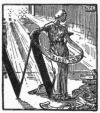 E cannot venture to guess which was the first
book-plate made in America, nor to say with absolute certainty whence
came the first plate used in our country; but undoubtedly the latter
came over already pasted into some book of a Dutch or English settler.
E cannot venture to guess which was the first
book-plate made in America, nor to say with absolute certainty whence
came the first plate used in our country; but undoubtedly the latter
came over already pasted into some book of a Dutch or English settler.
The larger part of our books came from England, and very few plates are
found with arms of other nationalities. The colonists who came from
England bringing books, brought also the home ideas concerning books,
and the book-plate was a natural piece of property to acquire. Their
descendants, who continued the connection with the mother-country, used
plates more generally, and the fashion spread naturally. It never became
very general, but was confined to those of gentle birth; the clergy, the
lawyers, and men of education. We shall see that it was not confined to
the men alone, but that the women of literary accomplishments also used
plates.{2}

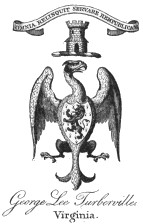
By far the greater part of the plates are cut on copper, but there are
some woodcuts as will be seen in an examination of the list; also, there
are some which look as if cut in silver, which was an easier metal to
work, or perhaps in type-metal. One example is known in which brass was
used, and this old plate is now in the possession of the writer. The
steel engravings are of rather recent date; and while there are a number
of these, the{3} new plates are mostly on copper. The simple labels are
printed from type.
The larger part of our early plates are armorial in character; and while
heraldry forms so prominent and important a feature, it is left
practically untouched in the present volume. The number interested in
the science is small, the authorities on coats-of-arms and on blazoning
differ, and the present writer had not the time to make the thorough
investigation necessary to a satisfactory treatment of this interesting
branch. Upon consultation with other collectors, and with their advice,
it was decided to leave this subject for a future volume should any call
for it arise.

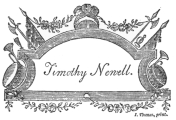
A decided difference is noticed between the book-plates of the Northern
and the Southern Colonies. In the South, to which came men of wealth and
leisure with cultivated tastes, we would expect to find the little
superfluities and niceties of daily life sooner in vogue and more{4}
generally used. Bringing books and musical instruments with them,
retaining their connection with the far-away home by correspondence and
visits, sending their sons to the great Universities to be educated, and
to the Law Schools for a finishing course, and ordering their clothes,
books, furniture, and all of the luxuries of life from England, they
would naturally be the first to use the book-plate. Very few of the
Southern plates were engraved by American engravers. They were nearly
all done in London, when some member of the family was over, or by order
from the Colony; for this reason the Southern plates are better in
heraldry, design, and execution than those of New England and New York.
They were the product of men experienced in such work; they were all
armorial and in the prevailing English mode.
The earliest comers to New England had a prejudice against coats-of-arms
and trinkets of such-like character, which their descendants, however,
soon forgot. Pride of ancestry and love of the display of aristocratic
claims developed when the hard circumstances of the former years had
worn off, and we find the prominent families of the North using
book-plates, and having their arms upon their coaches. In one important
feature, however, these Northern plates differ from the Southern,—they
are mostly the work of our native engravers, very few being done in
England.
The work of these native artisans, who were mostly self-taught in this
art of engraving on copper, is confessedly inferior to that of the
London{5} experts found upon the Southern plates, both in drawing and
execution, but their work is of more value to the collector from this
very fact of their being American work. They furnish examples of native
skill, both in engraving and in copper-plate printing.
The ornamentation of buttons, spoons, tableware, and other articles of
silver was already practised when the demand for the book-plate arose,
so that there were skilful men ready to turn their attention to this new
branch of their art.
The War of the Revolution naturally affected the native production of
book-plates, but a few years after its close, when Boston, New York, and
Philadelphia were active in publishing books, the engraver found work
more plenty, and very many who were employed upon the plates for the
illustration of books also produced book-plates.{6}
Nathaniel Hurd was the principal engraver of book-plates in the North
before the war, though Thomas Johnson, who was born before him and who
also died before he did, made some plates, while Turner and Paul Revere
were also working at this period.
Henry Dawkins, in Philadelphia, came over from England, and so did the
elder Maverick, who made so many plates for the New Yorkers.
The literary plates are smaller in number than we could wish, and they
do not show a wide range of ideas either. Very probably some of the
designs were borrowed from English plates, and were produced over again
for different customers, or were freely copied by other engravers who
liked, or who found customers who liked, the design of others. The plate
used by George Goodwin is one of four of this same design. The shelf
of books is also seen in the plate of G. C. M. Roberts, M.D., Thomas
Robbins, and the{7}
Elijah F. Reed, which is a direct reproduction of the Robbins. Piles
of books, but not the regulation “Book-pile,” are seen in the Brown
and Lewis plates, while the only real library interiors are the
Tayloe plate, the Moral Library and the Village Library
(Farmington, Conn.). John Allan, the old-book lover of New York, used a
plate with an open book against an anchor, and the plate of Edmund
Penn shows a love for books in the dainty volumes disposed about the
frame.
The patriotism of our book-lovers is shown in very many designs, which
use the American flag or the eagle. The thirteen stars also, the motto
of the United States, and various private mottoes of a very patriotic
nature, are frequently used.
It is noticeable that as compared with the Southern plates there are but
few of the Northern examples which give the address or residence of the
owner; that is, speaking of the armorial{8} plates, the printed name
labels give these particulars quite often.
The Jared Ingersoll plate gives New Haven as the residence of the
owner, while Rhode Island follows the name on the plate of Samuel
Elam. Other Northern plates which are so engraved are the Colonel
Eustace of New York, Comptroller Elliston also of New York, Lenox
of Philadelphia, Atlee of Lancaster, John Franklin, Boston, New
England, and Robert Hale of Beverly. Of the Southern plates,
Wormeley, Waller, Tuberville, Tazewell, Skelton, Randolph,
and Ludwell{9}

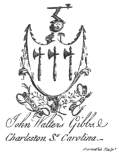
give Virginia as their residence; Drayton names South Carolina,
the Dr. Cabell plate names Richmond, and the John Walters Gibbs
names Charleston, S.C. The plates used in the West Indies also show
the residence quite often. There, too, as well as in the Southern
colonies, the profession or position of the owner, as well as the London
law school in which he was educated, are often given. Thus we have
William Blanc, Middle Temple, Dominica; Chas. Pinfold, LL.D.,
Governor of Barbadoes; Peyton Randolph of the Middle Temple, London;
Francis Page of the Inner Temple Esqr.; William Assheton of Gray’s
Inn. In the Northern examples we find John Gardiner of the Inner
Temple, and Jonathan Belcher, E Societate Medij Templi.{10}
We note also in running through the List that the occupations most often
noted on the book-plates are those of the medical and the legal
profession. Barristers, lawyers, and attorneys are often so named, and
the initials M.D., or the full word Doctor, are seen.
The abbreviations of other degrees are found also, and the plates of
clergymen are not uncommon.{11}
Several plates remain unnoticed in the following pages, which are
probably American, but which, for lack of positive information, it is
thought best not to include. Among these is an early Dutch plate which,
if it could be accurately traced to its original owner, might prove to
be one of the earliest plates used in America.

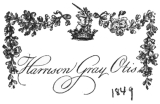
It seems that a word is needed in defence of the perfectly legitimate
and gentle pursuit of collecting book-plates. A great deal of sarcasm
and indignation have found their way into the columns of periodical
literature, particularly in England, the especial purpose of which is to
trouble the humble collector, and to discredit him in the eyes of the
world. He is pointed out as a destroyer of valuable books, as an animal
so greedy in the pursuit of his insignificant prey as to ruin elegant
bindings that he may secure worthless bits of paper, and as actually so
devoid of good sense as to remove such of these as are interesting—for
it is reluctantly admitted that{12} some interest does attach to the plates
used by certain men of fame in historical annals—from their rightful
place within the covers of the very books read and handled by these
illustrious owners.

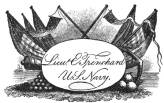
Let it be remembered that but a small part of the many books published
have a permanent value, and that a book once eagerly sought may outlive
its usefulness, and come to have a commercial value of so much a pound
as old paper, instead of so much a copy in different styles of binding.
Surely, no one can quarrel with the collector who removes the
book-plate, found within it, from such a worn-out specimen, even if the
removal necessitates the ruin of the cover. But to remove a book-plate
does not necessarily mean to ruin the cover; it requires some skill and
considerable patience to remove a valuable plate without injury to
either itself or the cover upon which it was pasted, but it is done
daily. Surely no one can find fault with this—a skilful operation
resulting satisfactorily to the plate-collector and to the book-owner.{13}

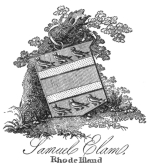
Again, no intelligent book-plate collector will separate the plate of a
famous man from the book which has been its home for years, and which
was once handled and read by its famous owner. Even a worthless book
will thus be saved by the collector, which was fit but for the fire or
the ash-heap, and which would have gone thither, plate and all, save for
his discriminating eye, while a valuable book no one would think of
despoiling. Would an intelligent collector, having a book from the
library of George Washington, with his plate upon the cover and his
autograph in its accustomed place, think of soaking off the plate and
cutting out the signature? Not at all; no matter how worthless the book
might chance{14} to be, the fact that it was Washington’s is sufficient to
insure it from any harm, while the presence of the autograph and the
book-plate but adds to the value as establishing beyond peradventure the
original ownership.
The book-plate collector is naturally a book-lover. He must not be
accused or suspected of crimes against his own kith and kin. He is a
harmless and useful specimen of the genus collector, who with
assiduity, perseverance, and intelligence seeks to preserve these
memorials of past days, which in the rage for indiscriminate collecting
were overlooked, and are but now beginning to receive the attention they
are worthy of.
It is, however, to be admitted that at first glance, the general reader
who has not developed a special liking for the things of the past in
history, art, or biography, may see no especial interest in book-plates.
But let him examine a collection of good plates with their intelligent
owner, who can point out to him the facts worthy of note; let him once
understand that celebrated artists like Albrecht Durer, Jost Amman,
William Hogarth, William Marshall, George Vertue, Bewick, Bartolozzi,
and even Raphael Morghen were willing to devote time and taste to the
designing or engraving of the book-plate; let him handle some of their
work, and reflect upon the effort the master considered so small a
design worthy of; let him see the plates of some of the noted names in
history, art, letters, medicine, the sciences, and the professions; let
him take in his hands the plates of William Penn, the friend of{15} the
Indian and benefactor of his race, of Laurence Sterne, of David Garrick,
of Horace Walpole, of Samuel Rogers, of Charles Dickens, or of George
Washington, of John Adams, and Charles Carroll, signers of the
Declaration; let him see a plate engraved by Paul Revere whose services
in the Revolution he has known of from his schooldays;—let him see
these and scores more of similar interest, and he cannot fail to respond
to the enthusiasm of their owner. But indeed it is a pursuit, the
delights of which are discernible to those only who bring to it the
capacity for such pleasures.

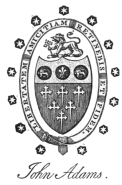
{16}
NAME-LABELS AND MOTTOES.
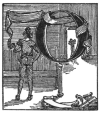 F all forms of book-plates the simplest possible is the
printed name of the owner, unaccompanied by either motto, device, or
ornamentation of any kind. Such a plate had Philip Hone, one of the
founders of the Mercantile Library, and in the early twenties a mayor of
the city of New York. His plate is merely a bit of paper with his name
in bold script printed upon it from an engraved copper-plate.
F all forms of book-plates the simplest possible is the
printed name of the owner, unaccompanied by either motto, device, or
ornamentation of any kind. Such a plate had Philip Hone, one of the
founders of the Mercantile Library, and in the early twenties a mayor of
the city of New York. His plate is merely a bit of paper with his name
in bold script printed upon it from an engraved copper-plate.
This style of plate is not chronologically the earliest, but is taken as
our starting-point because of its unrelieved simplicity; this fulfils
the mission of the book-plate,—it proclaims the ownership of the book
in which it is seen; not in delicate language, to be sure, not with any
invitation to dip into the volume in hand, not with any evidence of the
owner’s taste in reading, but with a directness not to be misunderstood.
The essential part of the book-plate is the name of the owner; and while
this is sufficient of itself, it is found profitable and pleasant to
accompany it with an apt quotation from a favorite author, with a
caution against the improper{17}
handling of books, with a warning of the sad result of declining
Wisdom’s guidance, or with an invitation to enjoy the beauties of
literature and to share the benefits of careful reading. In addition to
these mere typographical adjuncts an opportunity is offered for the
display of those more decorative garnishments which have led to the
development of the handsomer styles of plates.

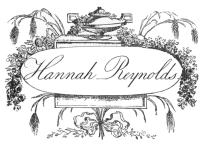
Alexander Stedman’s: Thomas Thaxter’s, 1791: William W. Potter’s Book:
Aaron Woolworth’s, Ex Dono Rev. S. Buell, D.D. These plates use the
possessive case, are embellished with borders of ornamental type, and
supply some further information by showing the date of their being used,
or by naming the giver of the volumes. Other styles of expressing
book-ownership are afforded by the following: Nicolas Pike His{18} Book
1768: Hannah Adams, Medfield 179-: The Property of John Clap,
Roxbury 1791: Davidis Dickinson Liber, A.D. 1796: Lieut. E.
Trenchard, U. S. Navy: Simeon Baldwin, Owner: Ex Libris I. G.
Thomas: Library T. W. Curtis, No.: Belonging to the Library of
Thomas Forrest Betton, Germantown Pa.: The Property of John Weld
native of Pomfret, Conn. Resident of Pomfret, Bo’t of Mr. James Steele
of Hartford, January 12, 1796: W. Lewis, Ejus Liber: Johann
Christoph Kunze, Prediger in Philadelphia: Emmanuel Jones e Coll; Gul;
et Ma: 1756.

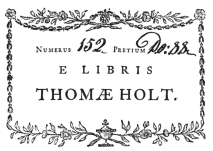
These old type-set labels with their quaint borders of ornamental
type,—scrolls, flourishes, stars, vines, and even grammatical
signs,—are usually found to be printed on good white handmade paper,
which was seldom trimmed with care;{19} occasionally a tinted paper is
found,—yellow more often than any other, but sometimes a blue or green;
these served the less pretentious of our ancestors in lieu of the
coats-of-arms and family mottoes of those of higher lineage, and are
found in quantities throughout the New England and Middle States: even
farther south they are not uncommon, but are not so numerous.

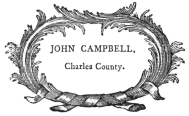
In making up these ornamental borders the type was usually set in the
form of a parallelogram, occasionally in a square, oval, circle, or
diamond, and seldom in fanciful shapes. The most ambitious plate of this
kind which has come under my observation is that which once graced the
books of Mary McGinley; this is a rather large plate, and the type is
set in the form of an urn, within the lines of which are given the motto
and the owner’s name.
A step in advance of these wholly typographical examples are those which
employ a woodcut{20} border to surround the name, and instances can be
given of such a border enclosing the name printed from type; festoons of
flowers or of cord, and draperies of cloth, were also used as a simple
setting for the owner’s name. In this connection mention may be made of
the work of T. Sparrow, an obscure engraver of Maryland; no heraldic or
pictorial examples of his workmanship have been identified, and he
probably confined himself to the simple woodcut designs of which but a
small number are known. Always using a border of floriated scrolls, he
never omitted an original contrivance which is the characteristic mark
of his work,—a group of thirteen stars surrounded often by a wreath.
This is always found in a prominent place, and is an indication of his
patriotism as well as that of the owner of the plate.

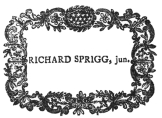
It must not be supposed that the heraldic book-plate was an outgrowth or
development of{21} the name-label: not at all; they were contemporaneous
and were both used in England long before they were here.
Coming now to the subject of mottoes, we find a wide field to travel
over, many languages to read, many quotations to recognize, with hints
and warnings, and even threatenings, by the score, from jealous
book-lovers. Mottoes readily fall into two classes: those which are
chosen by the owner for some personal reason, and those which are family
mottoes, and which are used without thought because they are a family
inheritance, or with a commendable pride in such legacies from an
honorable ancestry. Latin is the language most often used probably,
though English is a strong rival, while German, French, Greek, and even
Hebrew and Welsh are also found upon our book-plates. Sentiments
opposing the habit of book-borrowing are of frequent occurrence, and in
some instances are of such severity as to leave no doubt of their
effectiveness. For brevity and pointedness the following example can
hardly be exceeded:—
This book was bought and paid for by
D. C. Colesworthy.
Borrowing neighbors are recommended
to supply themselves in the same manner.
Price seventy-five cents.
On the book-plate of D. W. Jayne the following verse from the Bible is
used:—
Go ye rather to them that sell and buy for yourselves. Matt. Chap.
xxv. ver. 9.
{22}
Verses from Holy Writ are quite frequently used on plates, and the style
of expression found in the Psalms and Proverbs is borrowed as adding an
authoritative emphasis to the words of caution and advice,—
The wicked borrow, and returneth not: do thou not like unto them.
Return what thou borroweth with the most sacred punctuality, and
withhold it not.
On the plate of a book-lover in Charleston, S.C.,—
And ye shall keep me until the fourteenth day. And it shall be
when thou hast made an end of reading this book. Send me away unto
my master. Ex. xii. 6: Jer. li. 63: Gen. xxiv. 54.
{23}
Every one has suffered from book-borrowers, even from school-day times,
when the rude doggerel,—
Steal not this book for fear of shame,
For here you see the owner’s name,
or its variant,
Steal not this book for fear of strife,
For its owner carries a huge jack-knife,
was printed in coarse letters across the cover of the books most likely
to go astray. How irritating it is to find the very volume one needs at
the moment, missing from its accustomed place on the shelf; if anything
is lacking to complete the{24} torment of the discovery, let it be
impossible to find out who has taken the desired volume, or to get any
clew as to when it went or where!
Private Library of J. N. Candee Cole, This book is not loaned.
Matt. xxv. 9.
Read not books alone: but men, and be careful to read thyself. The
property of John Lambert, South Reading.
To Borrowers of Books.
You remember, my friend, I freely comply’d
With the favour you asked me, and fully relied
On a favour from you, which, tho’ promised, I find,
As it hasn’t been granted, is out of your mind,
To return in due time what I’ve wanted to see,
The Book, which ’tis long since you borrow’d of me.
Another I now with reluctance implore,
’Tis only to ask that you borrow no more.
Stolen from J. W. Houx,
Book-keeping taught in three words,
Never lend them.
The would-be borrower who finds these sentiments in the book he was
about to ask for will scarcely be encouraged to do so, and for
directness they are exceeded by only one example, in which the owner’s
name is followed by the simple declaration, He does not lend books.
The motto on the plate of the late George Ticknor—Suum cuique, To
every man his own—was also calculated to discourage the borrower.{25}
But some people do lend books, and have them returned too,—in good
second-hand condition. And so it comes about that the proper use of
books is made the subject of another class of mottoes.
My Friend! Should you this book peruse,
Please to protect it from abuse:
Nor soil, nor stain, nor mark its page,
Nor give it premature old age:
And, when it has effected all,
Please to return it ere I call.
The following verse is common property and is found on several plates:—
If thou art borrowed by a friend,
Right welcome shall he be
To read, to study, not to lend,
And to return to me.
Not that imparted learning doth
Diminish learning’s store,
But books, I find, if often lent,
Return to me no more.{26}
Read slowly,
Pause frequently,
Think seriously,
Return duly with the corners of the leaves not turned down.
Neither blemish this book, nor the leaves double down,
Nor lend it to each idle friend in the town:
Return it when read,—or if lost please supply
Another, as good to the mind and the eye.
With right and with reason you need but be friends
And each book in my study your pleasure attends.
If through respect or love I lend
This book unto my worthy friend,
He must not soil, abuse, nor tear,
But read with diligence and care;
And when its contents you have learned,
Remember, it must be Returned.
On the plate of Samuel W. Francis appear the following lines:—
Any one may borrow,
But a gentleman returns.
The property
of
Thomas C. Cowan.
Borrower,
read, mark, and Avoid
the former part
of
Psalm xxxvii. 21.
If you borrow, freely use it,
Take great care and don’t abuse it:
Read, but neither lose nor lend it,
Then unto the owner send it.
{27}
Never open a book farther than to bring both sides of the cover on
to the same plane. Never lend a borrowed book, but return it as
soon as you are through with it, so that the owner may not be
deprived of its use. You may think this a strange request, but I
find that although many of my friends are poor arithmeticians, they
are nearly all of them good book-keepers.
In strong contrast to all the preceding are those mottoes of generous
souls who find no pleasure in withholding their treasures, but who wish
to have it understood that they are for the use of all; not very many
are bold enough to thus advertise their willingness to lend, but a few
do so, and generally by the use of the Latin, Sibi et amicis, or et
amicorum.
Sentiments in praise of books and reading are not uncommon, and
quotations from classic{28} writers both in prose and poetry do good
service on book-plates. Pope’s well-known lines—
A little learning is a dangerous thing,
Drink deep or taste not the Pierian Spring;
Where shallow draughts intoxicate the brain,
But drinking largely sobers us again.
are found on an old American plate.
On a recent New York plate,—
Far more seemly were it for thee to have thy Study full of Books
than thy purse full of money. Lilly.
On a Maine plate,—
Who learns and learns but does not what he learns,
Is one who plows and plows but never sows.
————
Weigh well each thought, each sentence freely scan,
In Reason’s balance try the works of man.
Be bias’d not by those who praise or blame,
Nor, Servile, Yield opinion to a name.
On a recent Boston plate,—
Un bon livre est un bon ami.
On a recent Western plate,—
A jolly goode booke,
Whereon to looke,
Is better to me than golde.
On a recent Washington plate,—
A trusty villain, sir, that very oft when I am dull with care and
melancholy lightens my humour.
{29}
{30}
The mottoes on the plates of those who have achieved distinction have a
peculiar interest, especially when chosen by the owners themselves. The
plate of Henry W. Longfellow bears the following line:—
which is from an unknown author and is found in the following verse:—
Non vox sed votum,
Non chordas sed cor,
Non clamor sed amor,
Sonat in aure Dei.
Not voice but vow,
Not harp-string, but heart-string,
Not loudness but love,
Sound in the ear of God.
The motto of George Washington,—Exitus acta probat, is not given in
the accepted lists as the family motto of his ancestors, but it may have
been such. The meaning of it has brought out criticism recently because
of its Jesuitical sound,—“The end shows the deed.” But this may also
be taken as a patriotic utterance in view of the part of the illustrious
owner of this plate in the Revolution.
On the plate of William Penn we see a motto most fitting for the
character he sustained, Dum clavum rectum teneam—“While I hold to
glory, let me hold to right.” In the plate the third word is omitted,
as the engraver found the motto too long for the space reserved, and
through some{31}
{32}
blunder the r in clarum is changed to a v, which makes no sense at
all.
On the plate of George Bancroft, the late historian, a chubby cherub
bears a panel on which is the motto, Sursum corda. Another plate was
also used by Mr. Bancroft which was in all respects like the above,
except that the motto was changed to ΕΙΣ ΦΑΟΣ.
The plate of the late Mr. George W. Childs has the following motto
whose appropriateness is evident at once,—The pen is mightier than the
sword. Above this a second motto of equal appropriateness is
given,—Nihil sine labore.
On the plate of Dr. Oliver Wendell Holmes, Per ampliora ad altiora
is given upon a ribbon under a beautiful drawing of the “chambered
nautilus.”
Instances of mottoes which are cleverly made to carry some meaning, or
some word, which will be seen at a glance to be taken from the name of
the owner, are found often.
On the plate of Harold Clarence Ernst this motto is given, Ernst ist
das Leben.{33}
On the plate of George Curry, D.D.,—Sic curre capias.
On the plate of Edward Spencer Dix,—Quod dixi id feci.
In concluding this list of mottoes two from the Welsh can be instanced,
one on the plate of a New York collector of Welshiana, which is Cared
Doeth Yr Encilic, meaning, “The learned love the{34} things of the
past.” The other is on a Washington plate, and reads thus, A fynno Dwy
y Fydd, meaning, “What God wills, will be.”
In the list of languages used on book-plates, we must now include the
Volapük, for we have the first instance of its use already in a New York
plate; the motto reading, Menad bal pukbal, and meaning, “One
humanity, one language.”
{35}
ARMORIAL BOOK-PLATES.
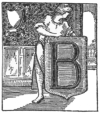 OOK-PLATES admit of many kinds of extraneous
ornamentation, and wholly apart from the special function of recording
the ownership of books, they serve as expressions of artistic taste;
they lend themselves readily to many forms of design, and have passed
through several changes or “styles” in the three hundred years of their
existence; they can be dignified or flippant, serious or punning, of
artistic beauty or positive deformity; they can express the owner’s
choice of reading and can preserve lines from his favorite authors; can
convey warning or invitation, and can, in short, be made a very personal
affair.
OOK-PLATES admit of many kinds of extraneous
ornamentation, and wholly apart from the special function of recording
the ownership of books, they serve as expressions of artistic taste;
they lend themselves readily to many forms of design, and have passed
through several changes or “styles” in the three hundred years of their
existence; they can be dignified or flippant, serious or punning, of
artistic beauty or positive deformity; they can express the owner’s
choice of reading and can preserve lines from his favorite authors; can
convey warning or invitation, and can, in short, be made a very personal
affair.
The first book-plates were heraldic. In those early and, in some senses,
good old days, before the schoolmaster was abroad in the land, when
learning was the possession of the aristocrats and the churchmen only,
and consequently when handwriting was not in use among the people,
families were distinguished by emblems which were known of all. These
heraldic devices were painted on their shields, carved upon their
walls,{36} engraved upon their breast-plates, woven upon their banners and
their tapestries, displayed upon their own persons, upon those of their
dependents, and even upon their animals and the furniture and books of
their homes; even the purely ornamental and ephemeral luxuries came to
be adorned with the family coat-of-arms.

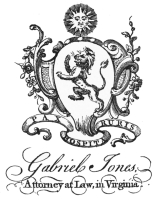
The armorial bearings, stamped upon the back or sides of a book, or
printed upon paper and pasted within the cover, were sufficient, without
a name, to identify the family to which it belonged. Libraries descended
from father to son,{37} and were kept intact for generations; and the
family arms and motto were the most appropriate label possible.
Warren, one of the first to study book-plates and to give to others the
benefit of his researches, has divided the armorial plates into general
classes, and has given them suitable names, which are accepted the world
over. A considerable number of subdivisions has been made; and while
they may be serviceable where book-plates are plentiful, they are but an
incumbrance to the collector of the early plates of America, for our
examples are few in number, and are quite sufficiently
distinguished—for the purpose of the present work, at least—by the
following styles: Early English, Jacobean, Chippendale, Ribbon, and
Wreath. Distinctive, easily remembered characteristics pertain to each
of these, and fairly accurate dates of their adoption and continuance
can be given.
Adopting then the nomenclature of Warren, and following his lead, we
come now to consider the meaning of the different styles and the
diversity of their designs.
The very earliest class is the Early English, in which the shield of
arms is present with all its accessories. In these plates the mantling
is very profuse, and in large full-rounded curves surrounds three, and
often all four, sides of the shield. This is the only ornamentation,
nothing incidental being added as yet; the name of the owner is usually
or often accompanied by a title and address, and quite frequently also
by the date.{38}

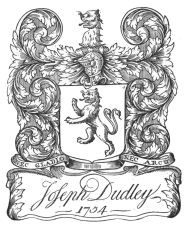
We have but few examples of this style; perhaps the most satisfactory as
an example of the class will be the plate of Joseph Dudley, dated
1754. (This plate was really engraved much earlier than this. Hurd
erased the original name, and cut the present one with the date in its
place.) In this the mantling, running out beyond the edges of the
shield, curls both upward and downward, and completely envelops three
sides;{39} the design takes on a strong resemblance to oak leaves, and a
single leaf of this is engraved upon the helmet: the background, or
space enclosed within the scroll-work, is filled in with perpendicular
lines which might be taken for the tincture gules; in the
name-bracket, the oak-leaf pattern is again made use of, forming a neat
finish to the ends.

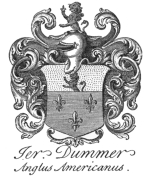
In the plate of The Honourable Wm. Carmichael, Esqr., the mantling is
not so completely transformed into the oak-leaf design, although the
latter is here apparent. The plate of Jer. Dummer, Anglus Americanus
is peculiar in that the space enclosed by the scroll-work is lined with
the solid brick wall of the later Jacobean style; in this the{40}

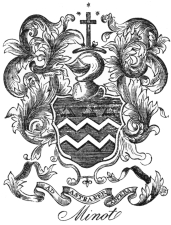
mantling is less striking than in the Dudley, but it surrounds the
shield well, and curves upward about the crest. In the Minot plate,
which is very peculiar and rather difficult to classify, the mantling is
very unworthy of the name; it does not proceed from the helmet, nor
indeed from anywhere in particular, but in wild and very eccentric
fashion, envelops the crest and most of the shield; the field of the
shield is tinctured azure, and it is{41} enclosed within a border or
moulding which nearly surrounds it, but leaves a portion at the base
unprotected; a further peculiarity of this moulding is that it is an
integral part of the helmet, for it curves over at the top of the shield
and actually proceeds from the helmet.
A very fine example of this style is the Francis Page plate.
The next style is the Jacobean, commonly spoken of as existing from
about 1700 to about 1745; the styles overlap naturally, and no
hard-and-fast period can be established within which only one particular
style of plate was used. Examples of the Jacobean plate are found in
England which would date later than 1745, and the style which succeeded
this was used somewhat before the year which begins its accepted period:
the dates of the periods, then, are approximate. The names by which the
different styles are known have all a good reason for their acceptance,
although each one was suggested by differing circumstances.
The style of book-plate in vogue at the time of the last James is
designated as Jacobean; and, while it continued in use long after the
death of the deposed monarch who gave it its name, any change in its
designation would be misleading. The principal features of this style
are its heavy, carved appearance, the evenly balanced proportions, and
the exact coincidence of the two sides of the design. The shield, always
of regular outline, is usually placed upon an ornamental frame whose
background, or lining, is either filled in{42}

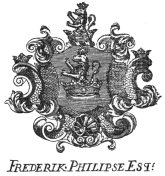
with a fish-scale pattern, diapered into the lozenge form or built up
solidly with a wall of brick. This lining shows at both sides of the
shield, below, and, less often, above it; its sides are convoluted; they
run out in foldings and scrolls resembling the carving on wood, and are
often worked into elaborate patterns: sometimes, too, the design is
surrounded by a carved moulding which makes a heavy frame of rectangular
form and massive appearance. This style of plate, well-handled, is
exceedingly handsome, and is capable of more repose and dignity than any
other. Very forbidding indeed, and over-solemn, are some examples, but
in the main the purely Jacobean plates are{43} very pleasing. Among the
accessories usually found are a scallop-shell with the concave side
turned towards the observer, and placed either below the shield to
support it, or above it to set it off: this shell is always looked for
in the Jacobean plates, and indeed a shelly motive is apparent
throughout very many examples. The helmet and mantling are conspicuous,
especially the latter, as it is often enlarged and emphasized by being
drawn into the general scheme of decoration; very full, reaching far
down the sides of the shield-frame, and indeed often curiously woven
into the convolutions of the frame itself, it at times loses its
significance: grotesque faces sometimes peer from the ornamentation, and
heads of satyrs and demons are frequently used to rest the base of the
shield upon. In some instances the name is placed upon a bracket similar
to the upper part of the plate in decoration, or, again, it may be seen
upon a small curtain or lambrequin caught up at the ends with string.
Very often, too, no setting is provided for the name, and it is simply
engraved beneath the design. Eagles, lions, termini, cherubs, and
sometimes cornucopiæ of fruit or flowers, angels blowing upon trumpets,
and stiff stalks of flowers are introduced into the ornamentation. But
these do not succeed in enlivening the style of the plate materially,
for it is essentially heavy, conservative, and formal in design and
spirit. No graceful airiness rests upon it, and it provokes no joyous
sentiment, but rather rouses respect and enforces stateliness. The
general appearance of the Jacobean plate is as if carved{44} from wood. We
do not expect old carving to be anything but solid and immobile, and
these characteristics are present in this style of book-plate. Indeed,
Warren, in his chapter on the Jacobean style, says that no antiquary can
fail to note the strong similarity of treatment and design between the
wood-carving preserved in the churches of the time of Charles the Second
and the mouldings on the monuments of the same period, and the
book-plates of the style we have considered. Our finest example of the
Jacobean book-plate is found in the work of Thomas Johnston, who made
the plate of William P. Smith, A.M. This is a typical example of the
later Jacobean style, and is worthy of particular study. The Elizabethan
shield is set against a frame which is very elaborately carved and
ornamented; the lining is covered with the fish-scale pattern, and this
extends also to the arms and convolutions upon the sides. At the base of
the shield the scallop-shell is in position as prescribed, and is
surrounded by a little frame of its own; the mantling is very slight
indeed, breaking out from the wreath and also from the lower part of the
helmet, in short and simple spirals. The motto is found on a ribbon
which is gracefully strung upon the scrolls at the bottom of the design.
In the Spooner plate, by Hurd, the shield, also of Elizabethan
pattern, is set against a diapered background; beneath the shield,
within a little frame, the head of a sphinx is seen; term-figures are
placed in the scroll-work at either side, and from their hands depend
bouquets of flowers;{45}
{46}
the crest is overarched with a bit of old scallop-shell, and the motto
is given on a plain ribbon which, wholly unsupported, maintains a curved
position under the whole design. In the Andrew Tyler plate, also by
Hurd, a grotesque face supports the shield, the lining is elaborately
diapered, and a festoon of cloth depends from the lower scrolls of the
frame. In the small-sized plate of John Allen, the lining is
embellished with the simple lattice-work, in two patterns.
{47}
Closely succeeding the Jacobean, and indeed coming into use before the
latter was wholly discarded, the Chippendale style of book-plate may be
regarded as in a way an evolution from the Jacobean. If the parent was
dignified and conservative, the offspring was dainty and progressive;
the Jacobean style maintained its dignity and{48} decorous nicety to the
end, but the Chippendale, which started in with a taking air of modest
and light gracefulness, in strong and pleasing contrast to the solidity
of its predecessor, rapidly assumed a most elaborate and ornate manner,
and finally sank into a wild, riotous, and well-nigh sensuous profusion
of decorative expression, which being too heavy for it to sustain, bore
it down to its end. The character of the Chippendale plate, while
attractive and beautiful in its pure form, had essential elements of
weakness, which, hardly able to resist development, were certain to
cause its downfall.
{49}
As is natural to suppose, the name was bestowed upon this style because
of its assimilation of the ornate and flowery spirit which the famous T.
Chippendale at this period introduced into wood-carving and upholstery.
As compared with its immediate predecessor, the differences in this
style of plate are seen to be principally the liberating of the
decorative features from the stiffness which thralled them in the
Jacobean. Not now resembling ponderous carvings in oak and mahogany, but
rising free and unrestrained, the rose branches and sprigs seem to be
copied from Nature herself; not arranged with careful nicety and labored
uniformity as formerly, but springing from any convenient niche, they
add grace and delicacy to the whole design. The helmet is seldom{50}

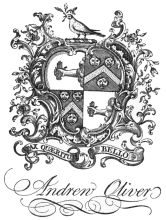
seen in this style of plate, the mantling is consequently absent, and
the bracket supporting the shield of arms undergoes a transformation;
the convolutions and scrolls on the sides become finer, freer, and less
imposing; the shield is never found of any set rectangular pattern, but
often is pear-shaped, shell-like in form, or indeed not unlike the
oyster or the human ear in general outline; the scallop shell which
formerly served as a base for the shield to rest on, is now broken into
dainty{51} fragments with the pectinated edges disposed about the shield
itself; the name-frame is no longer a cloth curtain, but is a scroll
with indented edges and curling outlines.

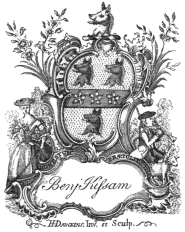
In its highest development the Chippendale plate is a beautiful piece of
work; the richness of its curves, its plentitude of graceful scrolls,
its profusion of roses in garlands or on the stem, and the elaborate
detail noticeable in all its parts,{52} combine to make a plate of
delightful airiness and dainty nicety; but in the hands of weak
designers, as pointed out by Warren, its possibilities of
over-ornamentation were seized upon, and we find the most unexpected and
incongruous assortment of figures from life, architectural fragments,
allegorical subjects and other features not to be included in any
particular class, occupying convenient places about the escutcheon; we
find sleek shepherds clad in the fashionable clothes of the
day,—knee-breeches, ruffled shirt with Byron collar, large felt hats,
and buckled shoes; we see would-be shepherdesses in big hooped-skirts,
very low-necked bodices and slight waists, wearing frizzly hair and
Gainsborough hats, and carrying dainty crooks; scantily draped figures
recline under the trees, while attendant cupids make music or hasten up
with books. Turning from these pastoral scenes, we come across plates
which have a most frightful dragon with scaly body, forked tail, and
fiery, bulging eyes, who spits fire as he crouches among the roses; in
others we find cornices, columns, arches, and urns; fountains,
hand-glasses, ships, nautical instruments, lambs, dogs,—in short, it is
useless to name the great number of irrelevant articles which were made
use of. The plate was made to carry any amount of heterogeneous
ornamentation which the designer fancied; it seems in some cases as if
the details were employed with rightful reference to the tastes or
pursuits of the owner, but in the greater number the fancy was allowed
free play.
Hurd’s work furnishes us with the best examples{53}
of the pure Chippendale style; the Chandler plate, the Wentworth,
and the Dumeresque are good examples; Dawkins gives us the later and
debased Chippendale with all its profusion of extrinsic ornamentation.
The Samuel Vaughan plate is a very fine example of good
Chippendaleism, and may be taken as a standard by which to recognize the
features of this style. The Robt. Dinwiddie plate is a fine example of
this style,{54} though the heraldry may be questioned: this, according to
Hardy, is of Scotch make.
In the Ribbon and Wreath style, which came into vogue in England about
1770, and in the United States not much before 1790, we note a return to
simplicity. The later Chippendale plates, with their over-burdened
frames, now yield to this quiet style, which is unassuming and very
pleasing. In this the shield is usually{55}

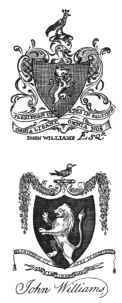

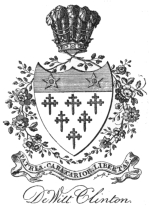
heart-shaped, is not set against a background, and has absolutely no
carved work about it; the shield is often unsupported, but is sometimes
hung by ribbons or festoons from wall-pins above; the decoration, as the
name suggests, consists principally of ribbons, and wreathing in various
forms. At the present day we use in our wall-paper, upholstery, and
wood-carving on furniture and mantels, and even on outside cornices, a
certain form of garland or festoon tied with ribbon which we call
“Colonial”; in a general way this resembles{56} the decoration features of
the Ribbon and Wreath book-plate. From wall-pins with fancy oval or
round heads, festoons of flowers depend above the shield; branches of
holly and palm, often tied with a ribbon whose fluttering ends bear a
motto or the name, are crossed beneath the shield, and their graceful
sprays extend up either side. Some of the festoons are rich with
blossoms, others, more slender, are of leaves only, while a few are made
of cloth; the full garlands are usually hung from above the shield,
while the thinner style is draped in any place and manner acceptable to
the designer, and with more or less of gracefulness, as his skill
permitted. This style of plate calls for nothing more than its
legitimate features to render it effective and satisfactory, and in
general the plates are in the pure style; but in some of the New York
plates, there are books, writing materials, and bits of landscape
introduced under the shield.
The Thomas Johnston plate by Maverick is a fine example of this style.
Maverick was the most prolific worker in the Ribbon and Wreath, while
Callender and Rollinson also used it very largely. The Prosper Wetmore
plate by Maverick, the John Sullivan by Callender, and the Horatio
Shepherd Moat by Rollinson, are all excellent examples.{57}
PICTORIAL AND ALLEGORICAL BOOK-PLATES, AND PLATES OF COLLEGES
LIBRARIES, AND SOCIETIES.,
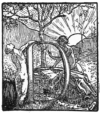 ESIGNS which are wholly pictorial or which are meant to
convey meaning by their symbolism are not very numerous with us. This
style of design is no better suited to the plates of public libraries,
schools, and societies, than to those of individuals, but nearly all of
our early examples of this style are found to belong to the former
class.
ESIGNS which are wholly pictorial or which are meant to
convey meaning by their symbolism are not very numerous with us. This
style of design is no better suited to the plates of public libraries,
schools, and societies, than to those of individuals, but nearly all of
our early examples of this style are found to belong to the former
class.
One of the early personal plates of this kind is that of James Parker,
who was a collector of curios, medals, and books. He was a conductor on
the old Western Railroad, and ran the first train between Worcester and
Springfield. This plate is fully described in the List.
Of an entirely different style is the plate engraved by Harris for
Henry Andrews. This is pictorial, introducing classical features, but
hardly rising to the height of allegory. The plate of Bloomfield
McIlvaine is also pictorial, and probably allegorical, as the figure
seems to represent History. In the Samuel Parker plate we have{58}
{59}
allegory with a label to identify it; for the bank on which the muse of
History reclines is labelled Clio. A very peculiar pictorial plate is
that of Edward Pennington, which seems to represent an overflowing
reservoir.
The plates of McMurtrie, Kip, Mann, Russell, Swett and
Hooper are good examples of the class. Examples could be given at
greater length, but as all are carefully described in the List, the
reader is referred to it.
The most interesting of the old society and{60}
{61}
{62}
library plates are the three of the New York Society Library, the two
of the libraries in Farmington, Conn., and that of the Society for
Propagating the Gospel in Foreign Parts.
In the plates of the Society Library allegory is rampant. Minerva
appears in all of them, and in the two by Maverick is the principal
figure. In both of these she appears to an American Indian, whose
attitude shows his deep appreciation of the benefits of education as
offered by the resplendent goddess. In one case she is represented as
having just arrived from Olympus, and is still encircled by clouds; in
the other, she seems quite at home in the alcove of the library, and has
taken a suitable volume from the shelf for the use of the savage. In the
plate by Gallaudet for this library the allegory is extended, and other
prominent inhabitants of the abode of the celestials are present. The
arts and sciences which the books of the library treat of are
represented by implements and symbols easily recognized.
The plate of the Monthly Library in Farmington also uses allegory. The
designer and engraver of this plate was Martin Bull, an old deacon in
the village, who was quite an interesting man. He was a goldsmith, a
maker of silver buttons, and spoons; a manufacturer of saltpetre when
needed by the army, a conductor of church music, town treasurer for
eight years, clerk of probate for thirty-nine years, a strong patriot,
and a writer of long and appallingly solemn letters to the youth of the
village when{63}
{64}
at college. The library was founded in 1795,—about as soon as our
soldier-citizens could settle down into reading stay-at-homes,—and was
conducted upon the plan of monthly exchanges. On the first Sabbath of
the month all members would assemble in the evening and pass in their
books and receive others, the choice being auctioned off. Two dollars
and a half a month was thus realized, and the meeting was the event of
the month to the sturdy inhabitants of the quiet town, to say nothing of
the younger folk, to whom it must have afforded coveted opportunities
for pleasant meetings, and quiet walks along the lanes. On the first day
of the new century, January, 1801, the library changed its name to that
which appears upon the book-plate, and on which the good deacon
exhibited a specimen of his highest art. Previously to this date it had
gone under the name of “The Library in the First Society in Farmington,”
and its first book-plate, probably engraved by the good deacon, had the
simple name with no pictorial accessories.
Contemporaneously with this, another library called the Village
Library, was in operation, and continued until 1826, when it was merged
with a third. This library also had a book-plate, but it was undoubtedly
beyond the powers of the engraver of its forerunners. In this we see the
interior of a room, in which a young lady patron of the library is
storing her mind with those choice axioms which, if put in practice, far
exceed the attractiveness of mere personal beauty; so says the couplet
beneath the picture.{65}
Beauties in vain their pretty eyes may roll:
Charms strike the sense, but merit wins the soul.
The plate of the Society for Propagating the Gospel in Foreign Parts
is also pictorial, and represents a ship of the Society, with its
missionary, approaching the shore of savage America: this plate is dated
1704, and is very curious and interesting. The society grew from the
efforts of one Rev. Thomas Bray, who established thirty-nine parochial
libraries in the American Colonies for the purpose of propagating the
doctrines{66}
of the Church. In 1698, King’s Chapel, Boston, received some two hundred
books from this society, which were described as “an arsenal of sound
theological, ecclesiastical, and political doctrines for the Ministers
of His Majesty’s Chapel.” For the prevention of loss or embezzlement,
and that they might be known wherever{67}
found, “in every book, on the inside cover shall be these words, ‘Sub
auspiciis Wilhelmi III,’ and also the Library to which they belong, thus
‘E Bibliotheca Bostoniana.’ ” This must have been in addition to the
plate we are considering, as no words descriptive of particular
ownership are given: possibly this plate was used in all the books
belonging to the society, and the supplementary one was for use in each
individual library.
————
College plates are as a general thing very plain, but the plates used by
the societies supported by the students and the alumni, are often very
elaborate. The early societies in Harvard and in Yale had curious and
very interesting examples of the allegorical and symbolic plate.
The Hasty Pudding Society and the Porcellian Club of Harvard
College, the Linonian Society and the Brothers in Unity of Yale
College, are examples. In Dartmouth College, the Social Friends
Society, and in the smaller colleges numerous other fraternities and
societies, used plates of simpler style.
The books of the Library of Harvard College were marked with plates by
Hurd and Bowen, as noted in the list; on these plates, the gifts of
various benefactors are recorded, with the class to which they belonged,
conditions regarding the gift of the books, or a statement of the fund
from whose income the money for the books is derived.
The plate of the Library of Congress is an engraved label having the
name and spaces for{68}
{69}
{70}
entries surrounded by a border of oak leaves and acorns: the design is
very neat, and is old in appearance.
A very beautiful plate is used by some Orphan Asylum, which does not
give its full name upon its plate. In this a beautiful picture of the
Christ blessing the little ones is given; the line “Forasmuch as ye did
it unto one of the least of these, ye did it unto Me,” is given under
the vignette.
In the plate of the Library of the New York State Agricultural
Society, which was incorporated in 1832, Ceres is seen in the field;
behind her the sheaves of wheat extend in rows; one arm clasps a
cornucopia, and with the hand of the other she extends a wreath.
In a great many instances the plates of libraries{71} had no pictorial
features, or indeed anything at all ornamental, being but the printed
rules governing the users of the books. Two examples of this kind of
plate are given below.
This VOLUME
belongs to
PRICHARD’S
Circulating Library,
Containing nearly Two Thousand Volumes,
In Market Street, Baltimore,
where
LADIES OR GENTLEMEN
may become
READERS
By subscribing for one Month, three Months or by
Agreement for a single Book. Said Prichard has also a
very great Variety of NEW and OLD BOOKS for Sale.
He, likewise,
Gives Ready Money for New and Old Books.
———
Union Circulating Library,
201 Chestnut Street, Philadelphia.
Subscribers to pay in advance, six dollars for a year: three dollars
and fifty cents for six months: two dollars for three months: one dollar
for one month: each subscriber to have three Duodecimo volumes, or one
Octavo and one Duodecimo at a time. A subscriber detaining an Octavo
longer than four weeks or a Duodecimo longer than two weeks to pay as a
non-subscriber. For each Octavo one eighth of a dollar per week until
the end of the fourth week when the rate was doubled. For a Duodecimo
one sixteenth of a dollar per week until the end of the second week.
Constant attendance at the Library from Sunrise till 8 o’clock in the
evening.{72}
In mentioning a few examples of the plates recently made for societies
and libraries, no attempt is made to furnish a complete list, nor even
to mention all the attractive plates, but to speak of a few which seem
of especial interest.
A pleasing architectural plate is used in Columbia College Library to
mark the books of the Avery Architectural Library. This was designed
by Russell Sturgis, and is in the form of a memorial window or mortuary
mural tablet. The central panel bears the inscription, and the date
MDCCCXC is given below.{73}
The plate of the Arnold Arboretum, designed by George Wharton Edwards,
is very attractive; the just-rising sun shines upon a white pine which
stands within an elliptical frame; the names of the Institution and of
the University appear upon ribbons which float from the pine. The plate
is dated 1892, and is signed, G. W. E.
The same artist designed the first book-plate of the Grolier Club of
New York City. In this, Atlas is seen supporting the arms of the club
within a circular frame which bears the name, and the date of the
founding of the club, 1884; rich foliations with a pounced background
surround this central design. The plate is signed G. W. E.
The Public Library of the old whaling town of New London has a plate
which is wholly nautical in construction; the name is given on a wheel
which is held by a seaman, while the captain stands by in pea-jacket and
rough-weather helmet, giving orders; the sail, which rises behind them,
affords space for the number of the book; below the deck on which the
mariners stand, are seen harpoons and spears of various sizes and kinds;
two dolphins are disporting in the waves. This plate is signed by the
name of the artist in full. It is by Mr. Edwards.
The Sutro Library of San Francisco uses a plate which gives a large
and interesting picture of the natural resources of the locality, and
the enterprises carried on in its vicinity; the motto, Labor omnia
vincit, appears on the ribbon which floats in the air.{74}
{75}
The Watkinson Library of Hartford uses one of the very few portrait
plates in the country; just why this style of plate should not be common
is not easy to understand. They are used in Boston and Worcester, as
mentioned below, but these instances are all that occur in public
libraries. In this plate the portrait of David Watkinson, the founder of
the library, is enclosed within an oval frame which bears the name and
the date of incorporation, 1858. The plate is signed by the American
Bank Note Company, New York, and is an excellent piece of steel
engraving.
Almost all of the historical societies use plates in which the arms of
the state or city in which they are located, are used. The
Pennsylvania, Connecticut, and Maine Historical Societies have
plates of this kind. In the last-named plate an inescutcheon bears four
important dates in the history of the state of Maine.
| 1605, | First voyage along the Coast by Waymouth. |
| 1649, | Election of Godfrey as Governor. |
| 1678, | Usurpation of Maine by Massachusetts. |
| 1820, | Separation from Massachusetts. |
The Rowfant Club of Cleveland uses a small plate representing the
corner of a library; the open window admits the fading light of the sun,
which is sinking into the sea; the lattice swings idly, and the pile of
books on the table proclaim a busy day.
A very striking plate is used by the University Club of Washington. A
wall of rough-faced stone is pierced by a small quatrefoil window in
which{76}
{77}
a book is laid; the date 1891 is stamped upon the side of the book.
Below this, Ionic columns support the wall; between them, in a smooth
space, is carved the name and city of the club. The plate is signed Hy.
Sandham.
In the Boston Public Library a large number of different plates is
used for the volumes coming from different legacies or funds, and in
very many{78} cases these plates give a portrait of the donor. Thus we find
these portraits on the plate used in the books from the Ticknor Fund,
the Phillips Fund, and the Franklin Club Fund. The books remaining from
the library of Thomas Prince are also marked with a plate which gives
his portrait and a picture of the old meeting-house, in which he
preached, and in which the books were stored at one time.
Portraits also appear upon the book-plates of the American Antiquarian
Society, which gives that of Ginery Twichell; and the Massachusetts
Historical Society, which has a plate giving a portrait of James
Savage.
The public libraries of to-day do not usually use elaborate plates in
their book-covers; simple labels, with perhaps a city or corporation
seal, are the common kind.
{79}
BOOK-PLATES OF SPECIAL INTEREST.
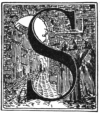 EVERAL reasons can be given for the fact that
collectors regard some book-plates as of more value than others. With
book-plates, as in other lines of collecting, rarity is a desirable
feature, and is a prominent element in deciding values.
EVERAL reasons can be given for the fact that
collectors regard some book-plates as of more value than others. With
book-plates, as in other lines of collecting, rarity is a desirable
feature, and is a prominent element in deciding values.
All of our early American plates can fairly be called scarce when
compared with the foreign examples of the same period, for they
outnumber ours, fifty to one; but many among ours are rarer than others.
The John Franklin, brother of Benjamin, signed by Turner, is an
exceeding rare plate; the Thomas Dering, signed by Hurd, is very rare.
The plates of Stephen Cleveland, Samuel Chase, Francis Kinloch,
Edward Augustus Holyoke, John Vassal, Lewis De Blois, Lenthal,
Apthorp, the John Pintard, by Anderson, and many others are not seen
in many collections. The plate of George Washington is the most
valuable probably of our plates; and while we know the location of a
good many of his books that have the plate within the covers, they are
in no way{80} obtainable: this plate is not very common, but more copies of
it are owned than of some others.

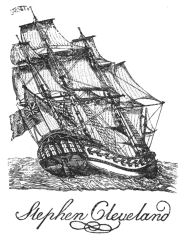
The libraries of our early days, while of respectable size, were not so
large as to require the printing of thousands of book-plates; fire and
mob violence have destroyed many books of those old collections and
their plates with them. Harvard, Yale, William and Mary, and Princeton{81}

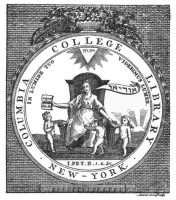
have all suffered the loss of books by fire, while many smaller private
libraries have been thus devastated. Mr. John Pintard used to say that
he had seen the British soldiers carrying away books from the library of
Columbia College to barter for grog, and a similar fate from similar
hands overtook many of the books stored in the belfry-chamber of the Old
South Church, Boston, while later in our history, worse depredations
were committed in the Southern cities by soldiers, who took the liberty
which war accords to contestants, to despoil many a building, both
public{82} and private, ruining books, records, paintings, and other
property of antiquarian and historical value. So that the early American
plates, at the first not so very numerous, have been reduced at times by
wholesale measures.
A second item of interest to the collector is the signature of the
engraver of the plate. Signed plates have a value over those which are
not signed. The identification of a plate, or the determination of its
age, may be considerably strengthened if the engraver’s name appears
upon the copper. Then, too, the name of a famous engraver lends much
additional interest to a plate. A book-plate signed by Paul Revere
arrests the attention of any observer at once, and establishes a value
to the same. Likewise a plate signed by Hurd, Doolittle, Dawkins,
Anderson, Maverick, Callender, or Turner is worth much more to the
collector than one of equal age but of unknown workmanship.
Dated plates also rank among the more valuable examples. A glance at the
chronological list will show how small a number of these we can boast:
many of those appearing in the list, too, are simply printed
name-labels, which do not rank as high as the more pretentious
specimens. Our very earliest dated example is the label of the Rev.
John Williams, 1679, the first minister in Deerfield, Mass., and who
with his wife and children was carried into captivity by the Indians in
1704. Coming next are the plates of Francis Page, 1703, and William
Penn, 1703, but they are both of English make. The plate of Thomas{83}
{84}
Prince, who was for forty years the pastor of the Old South Society in
Boston, is a simple label dated 1704. The plate of Thomas Dering,
signed by Hurd, and dated 1749, is the first American plate by an
American engraver that is both signed and dated. The John Burnet, by
Dawkins, dated 1754, is next in order; then comes the Greene plate, by
Hurd, 1757, the Albany Society Library, 1759, concerning which very
little is known, and every few years an example until we come to the
opening of the century.
{85}
Naturally the artistic quality of a book-plate influences its value; the
more elaborate designs are preferred to the plain armorials or the
printed labels. Pictorial plates, introducing bits of landscape,
interiors of libraries, or allegorical subjects, are sought for, as are
plates which are accepted as particularly good types of the different
styles. In addition to these technical reasons for valuing one plate
more highly than another may be given others which will appear more
reasonable perhaps to the general reader. All articles belonging to the
noted men of the past have a certain antiquarian value greater than
attaches to the kindred belongings of their contemporaries of lesser or
no fame. So with book-plates.
A glance at the list will show a goodly number of names which we
remember with pride and interest; the names of patriots, orators,
lawyers, statesmen, officers of the army, officers of the state and
nation, members of Congress, signers of the Declaration, governors,
old-time merchants, authors, divines, physicians, and not a few of that
plucky number who stood by the King in trying times—the American
Loyalists. Quakers, too, as well as royal office-holders, and titled
Americans are among those whose book-plates have come down to us.
Of our early Presidents, the plates of George Washington, John Adams,
John Quincy Adams, and John Tyler are known to us. All of these except
the last, which is a plain printed label, are armorial.
{86}Members of the Boston Tea Party, of the Constitutional Convention, and
of the early Assemblies are among those whose plates we know.
Of royal officers we have: Craven, one of the Lords Proprietors of South
Carolina; Elliston, Collector of His Majesty’s Customs at New York; Sir
William Keith, Governor of Pennsylvania; John Tabor Kempe,
Attorney-General under the Crown at New York; and William Penn,
Proprietor and Governor of the colony which bore his name.
Owners of large estates, employers of numbers of slaves, merchants whose
vessels carried on a{87} trade with remote and prosperous shores, and who
established names that have endured, used book-plates which are still
known to us. Among these are the plates from the following families,
well-known in New England: Ames, Bowdoin, Cabot, Chandler, Chauncey,
Coffin, Lodge, Lowell, Minot, Quincy, Sears, Winthrop, Barrell, Greene,
Perkins, Swan, Vassall, and Vaughan.
Of those well-known in and about New York may be mentioned, Clinton,
Colden, Constable, Cutting, De Peyster, Duer, Ellery, Goelet, Hoffman,
Ogden, Paulding, Phillipse, Pintard, Van Cortlandt, and Van Rensselaer.
To these should be added the Livingstons, which family had the largest
number of book-plates of any we know.{88}
In Philadelphia were the Logans, Morgans, Powels, Banckers, and
Hamiltons; while further South, the Lees, Lightfoots, Tayloes,
Wormeleys, Pages, Cabels, Tubervilles, Armisteads, Byrds, Blands,
Bollings, Dinwiddies, Fitzhughs, Hubards, Magills, and Randolphs used
plates and were families of prominence and distinction.
Among the prominent Loyalists are Chalmers, Cooper, Hallowell, Hamilton,
Livius, Lloyd, Oliver, and Robinson. Of titled Americans the following
used book-plates: Fairfax, Gardiner, Murray of Dunmore, and the
Pepperrell families.{89}
Of the early authors we can mention Alsop, Antill, Bozman, Byrd, Dana,
Key, Stith, and Abercrombie; of physicians, Assheton, Bond, Beatty,
Holyoke, Middleton, and Jeffries; of the statesmen, Bayard, Carmichael,
Dana, Duane, Gallatin, Jay, Lewis, Marshall, Norris, and Randolph.
Among the early clergymen can be named Apthorp, Boucher, Williams,
Jarvis, and Provoost.
Allen and Thomas, early printers; Aitkin, who made the first American
edition of the Holy Bible; and Bartram, the great botanist, used plates,
which are described in the list.{90}
Bloomfield, Brearly, Banister, Chester, Eustace, Hale, Mercer, Schuyler,
Sullivan, and Varick are among the soldiers of the Revolutionary army;
and of the orators we have Otis and Randolph.
Coming now to the signers of the Declaration, we find that we know thus
far the plates of eleven of them: John Adams, Charles Carroll, Samuel
Chase, Thomas Hayward, William Hooper, Francis Hopkinson, Benjamin Rush,
Richard Stockton, George Taylor, Oliver Wolcott, and George Wythe.
Surely the book-plates of all these men whose mention stirs patriotic
feeling, are of exceeding interest, and worthy to rank with any in point
of value and appreciation.
No book-plate, however, is of greater interest to the American collector
than that of George Washington, not alone by reason of the prominence
of that eminent man, but because of the scarcity of the plate, the high
price it brings, and the interesting fact that it is the only American
plate which has been deemed worthy of counterfeiting.
A genuine contemporary print of this plate is readily recognized by the
connoisseur. The plate has no striking features, but is a regular design
in the pure Chippendale style. The arms are displayed upon a shield of
the usual shell-like form, and the sprays and rose branches of this
style are used in the ornamentation of the sides of the escutcheon. The
motto, Exitus acta probat, is given upon its ribbon at the base of the
shield, and the name is engraved in script on{91}
the bracket at the bottom of the design. In general appearance the plate
is like scores of Chippendale plates of the period.

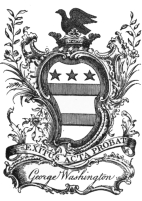
The interesting question of the probable engraver of the plate has
arisen, and in a most readable article from the pen of Mr. R. C.
Lichtenstein, in the “Curio,” on the Library of Washington, the
following opinion is advanced: “It was his [Washington’s] habit as a
general rule to write his name on the right-hand corner of the
title-page and place inside his book-plate. It has been a matter of
uncertainty as to whether that{92} book-plate was engraved in England or in
this country. Washington, like other Virginia gentlemen before the
Revolution, was in the habit of ordering goods every year from London;
but we have searched the various orders to his agents in London, and
examined as far as practicable the items of his household expenses,
without finding any such item. The strongest argument that can be said
in its favor proving it to be American work is the poor heraldry
displayed in its coat-of-arms, general make-up, and drawing. It will be
noticed that the engraver has placed a wreath under the crown (an
absolute heresy), and this, with the faulty drawing of the raven, makes
the whole plate a very slovenly piece of work. No engraver with any
knowledge of the fundamental laws of heraldry would be guilty of drawing
such a coat-of-arms as this. The arms of Washington engraved on his seal
and ring, undoubtedly cut in England, are correctly done. It seems more
than probable, if the plate had been done in England that the engraver
would not have been guilty of making such blunders. We have seen a great
many English plates, but have never noticed one bearing these
peculiarities. From its general appearance we should say that the plate
was made in America somewhere between the years 1777 and 1781.”
Collectors are divided in their opinions upon this question, and
although not ready to hazard a guess at the engraver, the present writer
believes the plate was engraved in England, and would place the date
nearly a decade earlier. As the{93} friend of the Fairfax family,
Washington might have had the plate made upon the occasion of their
ordering work of the same kind from England, or, indeed, it might have
been a gift to him from them, or from some admiring friend. As he was a
methodical man, the fact that no entry of an expense for such an article
is found in his records may lend color to the presentation theory. As to
the errors in heraldry, there is a plate of one Richard Washington,
which has all the peculiarities of this plate, and this is signed by
Bickham, who was an English engraver of some note. He was a trifle early
perhaps to have been the engraver of the George Washington plate, but
he may have made the plate which served as a copy for it. But whether
the plate was of domestic or foreign make, we know that the copper was
in this country, and that impressions were made from it not so very many
years ago. The late Mr. Mauran of Newport knew the man who owned this,
and it seems that having printed what he deemed a sufficient number of
re-strikes from it, this man, fearing lest others would in time get it
and make more prints, cut the copper into pieces and going out on a
bridge over the Schuylkill River, threw them in! There they may be
looked for by any who choose.
The counterfeit of this plate appeared in an auction sale of books, in
the city of Washington, about the year 1863. The late Dr. W. F. Poole
with Dr. J. M. Toner was present at the sale. The plate was placed in
these books for the purpose of getting a higher price for them than
could{94}

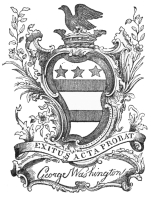
otherwise have been obtained. These gentlemen detected the fraudulent
plate, and denounced it as such in the auction-room, and the books
brought only their actual value as books. Copies of this plate turn up
now and then, and the unsuspecting are still deceived by it. It is
readily detected if one is forewarned. The work is manifestly inferior
to the good plate, the alignment of the name is poor, the quality and
appearance of the paper belie its professed age, and the printing is of
decidedly different appearance, being bold and strong in the genuine,
and weak and thin in the{95} forgery. A further difference is noted in the
crest, which is tinctured gules in the forgery and sable in the
genuine. These plates are sometimes claimed to be genuine and to be an
early and unsatisfactory piece of work, which Washington rejected, and
which was replaced with the other and accepted plate. This idea is
plausible perhaps to some, but to any who had information from Dr. Poole
it is an impossible theory. Another source of confusion is in the
reproductions of the plate which have been made from time to time to
illustrate works on the life of Washington, some of these being quite
faithful duplicates of the genuine plate with its trifling flaws; but
the paper and the printing are usually conclusive proof of the age of
the print. It is safe to say that there is but one genuine Washington
plate. It is true that the re-strikes of the original copper are about,
but these, too, are readily distinguishable by the printing and paper.
The plate of Bushrod Washington, nephew of George, is also of much
interest, and the manifest similarity of its design to some of the
plates by Dawkins has led to the suggestion that he made this plate. But
to the mind of the writer, Dawkins was not a man of originality, and was
a regular copyist when it came to book-plates; the similarity of the
plate of James Samuels to this plate is rather to his mind a further
evidence of the clever adoption of a reasonably good design by Dawkins,
than of his having been chosen by Judge Washington to engrave his
book-plate. The design of this plate is more spirited than any{96} of the
authenticated work of Dawkins; indeed, it surpasses the plate of the
General in that respect.

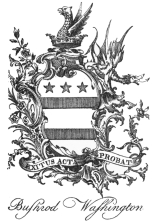
The arms are the same in these two Washington plates. In his “Barons of
the Potomac and the Rappahannock” (published by the Grolier Club, 1892),
Mr. Moncure Daniel Conway has referred to the older form of the arms as
used by earlier members of the family. The earliest shields held “Gules
on a barre argent 3 Cinquefoiles of ye first.” The second step was made
by changing to the{97} following, “Gules on a fesse sable 3 mullets.” The
last and present form is, “Argent, two bars gules: in chief three
mullets of the second.” These last, it is claimed, suggested our
national flag.
The plate of Elizabeth Graeme of Philadelphia should be noted here, as
it is the only example of an heraldic plate used by a lady of colonial
times. It is fully described in the list.
Leaving now these older plates of special interest to be discovered in
the Lists, we turn to a few modern plates which are worthy of particular
attention.
The plate of Daniel Webster is a plain armorial{98} with the motto, Vera
pro gratis, on the ribbon below the shield.
The etched plate of the late James Eddy Mauran, the early collector of
American and other book-plates, was an armorial of very handsome
appearance. The shield is surrounded with the style of decoration used
on the Chippendale examples, oak leaves being used in lieu of mantling.
An earlier plate in two sizes shows some differences in the design.
The plate of the late George W. Childs seems wholly in keeping with
the career of its distinguished owner. The sword, broken into pieces by
the quill, is depicted within an oval garter which bears the motto,
Nihil sine labore. The words from Lytton’s Richelieu, The pen is
mightier than the sword, are also given just within the frame.
Coming now to mention a few plates of our well-known men of letters, we
naturally accept the plate of Oliver Wendell Holmes as worthy of the
chiefest place. In this the motto, Per ampliora ad altiora, is given
on a ribbon beneath a beautiful representation of the “Chambered
Nautilus,” the
Ship of pearl, which, poets feign,
Sails the unshadowed main,—
The venturous bark that flings
On the sweet summer wind its purple wings
In gulfs enchanted, where the Siren sings,
And coral reefs lie bare,
Where the cold sea-maids rise to sun their streaming hair.
“If you will look into Roget’s ‘Bridgewater Treatise,’ ” said the
Autocrat one morning, “you{99}
will find a figure of one of these shells and a section of it. The last
will show you the series of enlarging compartments successively dwelt in
by the animal that inhabits the shell, which is built in a widening
spiral. Can you find no lesson in this?
“ ‘Build thee more stately mansions, O my soul,
As the swift seasons roll!
Leave thy low-vaulted past!
Let each new temple nobler than the last,
Shut thee from heaven with a dome more vast,
Till thou at length art free,
Leaving thine outgrown shell by life’s unresting sea.’ ”
A plain armorial plate with the motto, Vitam impendere vero, and the
name in fac-simile of his autograph, was used by J. G. Holland.
The plate of Brander Matthews, designed by Edwin A. Abbey, represents
the discovery of a mask of the old Greek comedy by an American{100} Indian.
With feathers stuck in his scanty hair, and his tomahawk laid on the
ground beside him, he appears to deliberate upon the possible use of the
enormous face which grins at him from his knee. On a circular frame
surrounding this picture the following words from Molière are given,
Que pensez vous de cette comedie. The appropriateness of the design is
apparent for one who is a collector of the literature of the French
drama, and the author of several books relating to the stage both in
America and France.


In the plate of Edmund Clarence Stedman, the author of “The Poets of
America,” we see Pan piping in the sylvan glades; the shepherd and the
nymph are charmed by the music, and the god is apparently at the height
of his effort. The frame surrounding the design bears the words, Le
Cœur au Metier, which were suggested by the address of Matthew Arnold
to the Authors’ Club in 1883. This plate is made in three sizes.{101}
The plate of Thomas Bailey Aldrich presents within a square frame a
picture of a black bird resting upon a comic mask; the heavy panelled
frame bears the owner’s name and the words, His Mark. In his essay on
American Book-plates, Mr. Laurence Hutton questions whether this black
bird is representative of the Daw, and symbolic of Margery of that name.
In the plate of Eugene Field we have a beautiful example of the plain
armorial, unaccompanied by motto or ornamentation of any kind.
Of similar character is the plate of Richard Grant White. This is
armorial, but the motto, The right and sleep, is given, and the shield
is decorated in a conventional manner, with mantling and scrolls.
A pleasing library interior is used by Arlo Bates. This represents an
Oriental interior; a youth in scull-cap and flowing hair is reading a
large book; a lily stem rises from a vase of striped Tyrian glass at his
side; rows of books are seen at his back; and out of the arched window
the distant fields are seen, with the palm and cypress trees on the
hillside. This plate is produced in a new manner, being a gelatine print
or half-tone direct from the pencil sketch. It preserves a very soft and
pleasant effect; indeed, one feels sure it will smirch if rubbed.
Laurence Hutton in his plate places a full-length statue of Thackeray
within a canopy, which seems to be a niche within a book-case. Volumes
flank both sides, and the amiable face of the drastic writer looks
directly at the beholder.{102} The name of the owner is given on a ribbon at
the bottom of the design.
The books of the lamented actors, Edwin Booth and Lawrence Barrett,
were marked with book-plates, the former using a plain armorial with no
name engraved upon it, and the latter showing the mask of Tragedy upon
an open volume, with the motto, Esto quod esse videris.
The reading monk, with the nimbus and star over his head, is seen in the
plate of Edward Eggleston. The sentiment, Flie fro’ the presse and
dwell with sothfastnesse, is given in old English letters.{103}
Mr. Rossiter Johnson uses a very plain but effective label bearing the
initials R. J. printed within a plain ruled border: all in red ink.
The patriotic motto of General Winfield Scott is the family motto of
the Scots of Whitislaid, Scotland, and well did the character of the man
who used the book-plate depicted below coincide with its meaning.
It would be interesting to extend this list of plates used by men well
known throughout the length and breadth of our land, but, unfortunately,
many whose names will occur to the reader do not use a book-plate.
{104}
EARLY AMERICAN BOOK-PLATE ENGRAVERS.
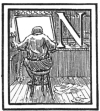 ATHANIEL HURD, who was born in Boston, Feb. 13, 1730,
and who died in 1777, was the best of our early engravers of
book-plates. Very little is now known of him, the principal source of
information being an article in the third volume of “The New England
Magazine,” published in Boston in 1832 by J. T. and E. Buckingham. The
only known portrait of Hurd, which is copied from an original painting
of him by Copley, and which in 1832 was owned by a descendant of Hurd in
Medford, Mass., also accompanies this article, and shows him as a young
man with smooth face, very pleasing and intelligent features, and
wearing a cap, white neck-cloth, and clothes of a pattern which give him
a decidedly clerical appearance.
ATHANIEL HURD, who was born in Boston, Feb. 13, 1730,
and who died in 1777, was the best of our early engravers of
book-plates. Very little is now known of him, the principal source of
information being an article in the third volume of “The New England
Magazine,” published in Boston in 1832 by J. T. and E. Buckingham. The
only known portrait of Hurd, which is copied from an original painting
of him by Copley, and which in 1832 was owned by a descendant of Hurd in
Medford, Mass., also accompanies this article, and shows him as a young
man with smooth face, very pleasing and intelligent features, and
wearing a cap, white neck-cloth, and clothes of a pattern which give him
a decidedly clerical appearance.
The only book-plate work mentioned in this article is the large plate
for Harvard College. It is said that the prints done in red ink were for
use in the highly valuable books which the students were not allowed to
take from the library. Several brilliant caricatures, a portrait of the
Rev.{105}
Dr. Sewell of the Old South Church, done in 1764, and a few other
examples of his art are mentioned. He is (probably inaccurately) claimed
to be the first person who undertook to engrave on copper in the United
States. He was a man of natural talent and real genius, was
self-instructed in his art, and was regarded as the foremost seal-cutter
and die-engraver of his time, in this country.
The following advertisement from the Boston “Gazette” of April 28, 1760,
is of some interest:—
“Nathaniel Hurd Informs his Customers he has remov’d his shop from
Maccarty’s Corner on the Exchange to the Back Part of the opposite
Brick Building, where Mr. Ezekiel Price kept his Office, where he
continues to do all Sorts of Goldsmiths Work. Likewise engraves in
Gold, Silver, Copper, Brass, and Steel, in the neatest Manner, and
at reasonable Rate.”
Hurd worked principally in the Chippendale style; he made some plates in
the Jacobean and a few in the Ribbon and Wreath styles, but he died
before the latter was much in use, and the former was really going out
when he took up the making of plates. Judging from the appearance of his
work, his first attempts were in the Chippendale style, and the few
Jacobeans he made were done after he had attained considerable
efficiency.
One of his earliest specimens was undoubtedly the plate of Edward
Augustus Holyoke, the famous doctor of Boston, who lived to be one
hundred years old, and who was but a year or two the senior of Hurd. In
this plate he used a design which he evidently believed he could improve
upon, and in which he felt there were good{106} features, for we find a
number of future plates of very similar design but much better
execution. In the Holyoke plate the work is very crude, the lines are
stiff, the drawing is poor, and the lettering of the motto and name are
not good. An ugly scroll is placed under the name, and the festoon of
cloth which is draped at the bottom of the frame and around the motto
ribbon is especially poor; the shell at the base of the escutcheon which
figures so often in future plates is here used, and the queer little
flow of water from it would not be recognized as such were this the only
specimen in which it occurs; the arrangement of the rose sprays, the
form of the shield, and the employment of the shelly edge show a
thorough study of the elements of this style. Very likely this design
was copied in great part from some foreign example which had come into
his possession.
In the Thomas Dering plate, which is the earliest plate dated and
signed by an American engraver, this same design is improved upon; it is
more compact in appearance, a little freer in execution, and the drawing
is improved. The name is still not very well engraved, and top-heavy
flourishes weigh down the capitals.
In the Theodore Atkinson plate the same design is still further
improved upon; the flow of water from the scallop shell is here caught
in a little bowl, a little additional flowery ornamentation is added,
and the heraldic drawing is better. The name is again embellished with
graceless flourishes.{107}
The design seems to reach perfection in the Wentworth plate; every
feature is markedly better, the water still flows out of the scallop
shell, the same shaped shield is used and the motto is placed upon a
graceful ribbon with ends which run off into fancy foliations. The name
is neat in appearance, but still there are too many scrolls.
In the plate of Robert Hale of Beverly, the old festoon of cloth
noticed in the Holyoke plate is seen again, and no motto is given. The
name is fairly well engraved.{108}
Later developments of this style are seen in the plates of Henry
Marchant, Danforth, Nathaniel Tracy, and John Marston; in these
some of the features of the former are wanting, but they are evidently a
legitimate progeny in the matter of style.
Another, and without doubt the highest type of the Chippendale plate
which Hurd made, is seen in the John Chandler, Jr., the Dana, the{109}
Philip Dumeresque, the Vassall, and the Wilson plates. In these
the shield becomes larger, the whole scheme of decoration shows more
fine detail work, and the effect is lighter, more graceful, and seems at
once the work of a master. The names are engraved in large bold type,
with a characteristic dash after the last period.
In the Jacobean style, the earliest of Hurd’s work is undoubtedly the
Lewis De Blois. This is crude in workmanship, not very good in
drawing, but excellent in design, and faithful to the characteristics{110}
of the style; the shield is placed against a frame which is lined with
the regulation fish-scale pattern; the sides are richly foliated, the
mantling is profuse and very well drawn, and the name is placed upon a
fringed curtain which is tied up at the ends with ribbon.
The handsomest Jacobean plates by Hurd are the Robert Jenkins, the
Spooner, and the Andrew{111} Tyler. In the former the lining is
diapered, the scroll work at the side of the arms is very fine, and at
the bottom, under the shield, a small vignette of a ship under full sail
is very pretty. At the top of the scrolls on either side two turbanded
female heads peer at each other across the crest.
In the Tyler plate the frame is very similar to the Jenkins, the
lining is diapered, and the scroll at the side are the same. The little
vignette at the bottom, however, is displaced by a sour face with gray
hair. The two faces are replaced by urns filled with flowers, and the
old cloth festoon is draped below the whole design. The Spooner plate
bears no resemblance to the others, and is a more graceful design. The
lining is latticed, the Sphinx head under the shield is enclosed within
a frame of its own, and at either side are term figures from whose hands
depend bouquets of flowers; the crest is overarched with a bit of the
old scallop shell, and the motto is on a ribbon, which, wholly
unsupported, maintains a curved position under the frame.
The Jacobean plates of Benjamin Greene and Peter R. Livingston are
almost identical in design; the small frame which encloses the shield is
lined with the fish-scale pattern, the mantling is handsome and profuse,
and the motto ribbon is stretched in rather stiff manner below the
frame.
Only two examples of the Ribbon and Wreath style are known as Hurd’s
work, the John C. Williams and the Jonathan Jackson. These are both
signed, and are very similar in design. Garlands{112} of roses depending
from rings above follow closely the outline of the heart-shaped shield,
and the ribbon for the motto is placed beneath, and is ornamented with
fancy ends.
In the “detur” plate for Harvard College Hurd conformed to the English
manner and adopted the seal-shaped design. The arms are displayed upon a
heart-shaped shield which is enclosed within a circle which bears the
name and motto, and this again is enclosed by a wreath of holly
branches.
Hurd’s work is the most interesting found in our early days, and a study
of it shows him to{113} have been progressive as well as painstaking. The
Ribbon and Wreath style did not come into general use in England until
about 1770, yet Hurd, who died in 1777, had used it. The colonies could
not be expected to adopt the new styles of the old country immediately,
and the condition of things from 1770 on to the time of Hurd’s death was
not such as to encourage the introduction of “fads” or to allow much
time for the development of the fine arts.
A word must be said about the heraldry on Hurd’s book-plates. This
science, heraldry, was not held in such general esteem among the New
Englanders as it was further south, and while many of the governors and
men of high standing in the Northern colonies brought armorial seals
with them, a great many who used them did so without strict heraldic
authority, and when it became the fashion to use coats-of-arms in
various ways, the herald painters of those days, who had but slight
knowledge of heraldry and who were possessed of a copy of Guillim or
some other writer on the subject, would find therein the arms of some
family bearing the name of their prospective customer, and without
further research would proceed to produce the coat as described. Not
always were these arms so ordered correctly borne; indeed, there is much
uncertainty about the arms used after about 1730 when our native
engravers and painters took up the work of producing arms upon orders.
Such seals as were brought by the colonists from England, and such as
were used by their descendants are undoubtedly{114} correct, but the
questionable arms are those which, as mentioned above, were looked up in
this country only, by means of such heraldic works as were at hand. The
presence of the arms then on some book-plates cannot be relied upon as
sufficient and indisputable proof of their owners’ right to them.

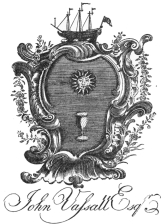
A list of the book-plates signed by Hurd is appended.{115}
A LIST OF BOOK-PLATES SIGNED
BY NATHANIEL HURD. |
| Theodore Atkinson | Chippendale. |
| Thomas Brown | |
| John Chandler, Jr. | Chippendale. |
| Rufus Chandler | |
| Francis Dana | Chippendale. |
| Danforth | Chippendale. |
| Lewis De Blois | Jacobean.{116} |
| Thomas Dering | Chippendale. |
| Philip Dumeresque | Chippendale. |
| Isaac Foster | Jacobean. |
| Benjamin Greene | Jacobean. |
| Thomas Greene, Jr. | Jacobean. |
| William Greenleaf | |
| Robert Hale, Esq., of Beverly | Chippendale. |
| Harvard College | Seal. |
| Harvard College | Pictorial. |
| William Hooper | Chippendale. |
| Jonathan Jackson | Ribbon and Wreath. |
| Robert Jenkins | Jacobean. |
| Peter R. Livingston | Jacobean. |
| John Lowell | Chippendale. |
| Henry Marchant | Chippendale. |
| John Marston | Chippendale. |
| Samuel Osborne | Chippendale. |
| Henry Pace | |
| Joshua Spooner | Jacobean. |
| Nathaniel Tracy | Chippendale. |
| Andrew Tyler | Jacobean. |
| Wentworth | Chippendale. |
| John C. Williams | Ribbon and Wreath. |
A LIST OF PLATES ATTRIBUTED TO HURD,
ALTHOUGH NOT SIGNED. |
| Thomas Child | Chippendale. |
| Henry Courtenay | Chippendale. |
| Edwd. Augs. Holyoke | Chippendale. |
| By the name of Hurd | Plain Armorial. |
| Loring | Chippendale. |
| Lucretia E. Newton | Ribbon and Wreath. |
| | (Same copper as the John C. Williams.) |
| Andrew Oliver | Chippendale. |
| Samuel Page | Label: Chippendale frame. |
| Phillips Academy | Chippendale. |
| Ezekiel Price | Chippendale. |
| John Simpson | Chippendale. |
| John Vassall | Chippendale. |
| David Wilson | Chippendale. | }One copper. |
| James Wilson | Chippendale. |
{117}
Of James Akin, who signs the Coffin and Browne plates, nothing is
learned. The Hector Coffin book-plate is also signed by Francis
Kearney, which would seem to indicate that Akin was associated with him.
The Browne is a Philadelphia plate, and Akin may have been employed by
the firm of Tanner, Vallance, Kearney and Company, which was in
successful operation in Philadelphia for some years.
* * *
S. Allardice was apprenticed to Robert Scott, who had been a pupil of
Robert Strange, and who, coming to America, was made die-sinker to the
Mint. He had previously made the architectural plates for Dobson’s
Encyclopædia.
Only one example of the book-plate work of Allardice is now at hand, and
that is simply an engraved label for the Library Company of Baltimore.
Ornamented with flourishes, and some fancy work, it is yet of no merit
as a book-plate or an example of art.
* * *
Alexander Anderson, who was the first American wood-engraver, was born
in the city of New York, April 21, 1775, and lived to the advanced age
of ninety-five years, dying, in 1870, in Jersey City, N.J., on the 17th
of February.
At the age of twelve, with the spring of a pocket-knife, sharpened for
the purpose, he tried{118}
{119}
to engrave on copper pennies rolled thin. In this way he made his first
plate, which was a head of Paul Jones; and his first impression from it
was made in red oil paint by a rude kind of a press of his own
contrivance. With tools made by a blacksmith, he went on to cut little
ships and houses on type metal for the newspapers. Being in some way led
to take an interest in certain medical works, he copied many of the
plates, and his father, feeling that this was a true sign of his fitness
for the profession of medicine, and not discerning the talent for
engraving, placed him with Dr. Joseph Young, as a student of medicine.
This step was taken with great reluctance by the youth; but he found
time for both the cares of his new study, and for the pleasures of his
old pastime. Various successes encouraged him, and in 1793 he cut a
tobacco-stamp on wood, which appears to have been his first use of that
material. Soon after this, he obtained a copy of Bewick’s “Quadrupeds,”
and with the cuts found therein he was delighted. They had a strong
influence upon his later work, and he has been well called the “American
Bewick,” for his small wood-cuts closely resemble those of the English
master in design, and his prominence in this country was equal to
Bewick’s in England.
A life of Dr. Anderson has lately (1893) been issued in New York; but,
to the disappointment of book-plate collectors, not a word is said of
his making book-plates.
Of the seven plates by Anderson known at present, four are on wood, and
three are on copper.{120}
Only one of those on wood is signed. The Lot Tripp and Josh. Russell
plates are simple labels, and the Typographical Society of New York
and the John Pintard, LL.D., which is signed, are pictorial. In the
former, the emblems and implements of the printing trade are prominent,
and in the Pintard, which is a fine example{121}
of Anderson’s best work on wood, the shield of arms is shown with a
landscape for background.
The plates on copper are the Anderson, which is a Chippendale, the
Apprentices’ Library, and the Columbia College, which are
allegorical.
All the above will be found described in the List.{122}
There is a plate of the Apprentices’ Library Company of Philadelphia
which strongly resembles the wood-cut work of Anderson, but as it is not
signed it is not safely attributed to him. In the plate of A. Griggs
of Philadelphia, an even more marked resemblance to his little designs
on wood is seen, but this, too, is not signed.
* * *
Annin and Smith. This firm consisted of W. B. Annin and George C.
Smith, and they were established in Boston from 1820 to 1837. Annin
died in 1839, in Boston, and Smith, who lived to quite an advanced age,
died in 1878. They engraved a number of plates for the “Token,” and for
other annuals so popular sixty years ago.
The plates of Richard Taylor Auchmuty, A. L. Peirson, William H.
Prescott, John Lowell, Jr., and an armorial plate for the Boylston
Medical Library are signed by them, and will be found described in the
List.
* * *
Abel Bowen, whose name appears on one of the plates of Harvard
College, was the first wood-engraver in Boston. He was born in New York
state in 1790, and he took up engraving before he was of age. In 1812 he
was a printer in Boston, probably attracted thither by his uncle, who
was the proprietor of the Columbian{123}
Museum. Nathaniel Dearborn claims to be the first engraver on wood in
Boston, but the honor is usually accorded to Bowen. He issued, in 1816,
the “Naval Monument,” and in 1817 was associated with Dearborn in
engraving for Shaw’s “History of Boston.” In 1834 Bowen, with others,
founded “The Boston Bewick Company,” which was an association of
engravers. In the following year they issued a map of Boston, and
undertook the publishing of the “American Magazine.” They were burned
out in this same year. Bowen died in 1850.
* * *
John Boyd, who engraved the plate of Samuel Chase, which is taken to
be the plate of the signer of the Declaration, was a Philadelphia
engraver. This is the only specimen of his work on book-plates which we
have, and it is a very pretty Chippendale design, delicately engraved.
In Dunlap, a J. Boyd is simply mentioned, who was engraving in
Philadelphia in 1812. This, if the engraver of the Chase plate, would
make him rather young at the time of doing it, and it is very good work,
and not the experiment of a novice. Whether this is the same engraver, I
do not know.
* * *
Joseph Callender was born in Boston, May 6, 1751. Very little is known
about him, but he is reported to have acquired the plates of Peter{124}
Pelham, who was presumably the first to engrave on copper in America,
and to have destroyed them. Callender made most of the dies for the
second Massachusetts Mint, at a cost of £1 4s. each. This was
considered an exorbitant price by the superintendent, who made a
contract with a Newburyport artisan, Jacob Perkins. Callender received
£48 12s. for making thirty-nine dies, and repairing three others,
while Perkins received but £3 18s. 10d. for his work. Callender died
in Boston, Nov. 10, 1821, and was buried in the Granary Burying Ground.
The only Chippendale plate by Callender is a copy of the Atkinson
plate by Hurd, and is for a member of the same family. As compared with
its model, this plate shows very little difference, it is so close a
copy, but the motto ribbon which is added is more graceful than those of
Hurd usually were, the heraldic drawing is quite as good, and the
lettering of the name is better. Callender, of course, would not have
begun to engrave much before Hurd’s death; indeed, the preponderance of
the Ribbon and Wreath style in his designs goes to show that his work
dated towards the close of the century.
His plates in this style are very light and graceful, with no
overloading; and a faithful use of the usual features of the style is
apparent.
In the Russell plate he was again a copyist, using for his model the
Joseph Barrell plate. The plates for the American Academy of Arts and
Sciences, and for the Massachusetts Medical Society are practically
alike; the curtain, and the{125}
{126}
ribbon and festooning are very similar, while the view within the oval
frame is, of course, adapted to the use of the books of the respective
societies. Callender would seem by these signs to have been a lazy
engraver, or to have considered his designs so perfect as to call for no
further effort.
| A LIST OF BOOK-PLATES SIGNED BY CALLENDER. |
| —— Andrews | Pictorial. |
| William King Atkinson | Chippendale. |
| Jonathan Baldwin | |
| Luke Baldwin | |
| Boylston Medical Library | Plain armorial. |
| John Callender | Pictorial. |
| Thomas Cary | Ribbon and Wreath. |
| William Erving | Ribbon and Wreath. |
| John Francis | Plain armorial. |
| Hasty Pudding Library | Pictorial. |
| Massachusetts Medical Society | Allegorical. |
| Thomas Russell | Allegorical. |
| Daniel Sargent, Jr. | Ribbon and Wreath. |
| John Sullivan | Ribbon and Wreath. |
| James Swan | Plain armorial. |
| Dudley Atkins Tyng | Ribbon and Wreath. |
| Solomon Vose | Ribbon and Wreath. |
A LIST OF PLATES ATTRIBUTED TO CALLENDER,
ALTHOUGH NOT SIGNED. |
| American Academy of Arts and Sciences | Allegorical. |
| William Emerson | Ribbon and Wreath. |
| Gray | Ribbon and Wreath. |
| Dr. John Jeffries | Plain armorial. |
| Porcellain Library | Allegorical. |
{127}
Cephas G. Childs, who engraved the plate of Henry D. Gilpin, was born
in Pennsylvania, in 1793. In the years 1827 to 1830, he published a set
of views of the city of Philadelphia and its vicinity (Baker).

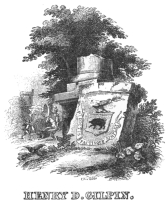
Henry Dawkins was an engraver of but few original ideas, if we may judge
him rightly by his book-plate work. In this he was very largely a
copyist. Working altogether in the Chippendale style, his designs for
the most part are variations of one general plan, which seems to have
been borrowed from an English-made plate. In{128} his plates we see
“Chippendalism run wild.” Here are introduced the love-sick swains who
play upon the flute; the dandy shepherds in stiff clothes of the most
fashionable cut, flowing curls, and large felt hats; the flirting young
damsels in very low-cut bodices, who play at being shepherdesses for the
sake of following the above-mentioned gentle keeper of sheep. Here are
the music-loving Cupids, the scantily clad females who are attended by
the Cupids, and who are far from home among the trees of the wood. In
the James Duane plate we find a fountain is fixed to the side of the
frame, and is spouting water from the mouth of a man’s head.
But the plates of Samuel Jones, Samuel Stringer, and Peter W.
Yates are proof that Dawkins could confine himself to the legitimate
features of good Chippendale plates. In these no outside objects are
introduced, and the design is good.
We do not know much about Dawkins. Dunlap says he was probably from
England, and that he was first noticed in New York. Originally he was an
ornamenter of buttons and other small bits of metal, but in America he
worked at anything that offered, “suiting himself to the poverty of the
arts at the time.” Dunlap dates him about 1774, evidently on the
strength of the word of Dr. Anderson, who remembered to have seen
“shop-bills and coats-of-arms for books,” done by him previous to 1775.
However, in 1761, he engraved music for a book of Psalm Tunes published
in that year in Philadelphia. His earliest dated book-plate is that of
John Burnet (1754).{129} He was skilful enough to make counterfeit
Continental currency, but not to avoid arrest; and in 1776 we find him
suffering for this misdeed. Some time later, he forwarded the following
unique petition to the Committee of Safety:—
“May it please Your Honours,—The subscriber humbly relying on the
known goodness and humanity of this honourable house, begs leave to
lay his complaint before them, which is briefly as follows. That
your petitioner was about six months past taken upon Long Island
for a trespass which this house is thoroughly acquainted as by
Israel Youngs he was led away to perform an action of which he has
sincerely repented and your petitioner was torn away from an only
son who was left among strangers without any support, or protection
during the inclemency of the approaching winter, as his unhappy
father hath since the first day he was taken had but one shirt and
one pair of stockings to shift himself, and hath been affected
during his imprisonment at White Plains with that worst of enemies
hunger, and a nauseous stench of a small room where some twenty
persons were confined together which hath introduced a sickness on
your distressed subscriber which with the fatigue of travelling
hath reduced your unhappy petitioner to a state of despondency—he
therefore being weary of such a miserable life as his misconduct
has thrown him into begs for a termination by death to be inflicted
upon him in what manner the honourable House may see fit. The kind
compliance of this honourable House will ever lay an obligation on
your distressed humble servent
Henry Dawkins.”
We do not know in what manner the honorable house received this
extraordinary petition; but, as book-plates are in existence in his
later style, probably it was not granted. Dawkins used three distinct
varieties of the Chippendale style. The plates of Benjamin Kissam, the
Ludlow and Roome plates, the Whitehead Hicks and the James Duane
are examples of the debased{130}

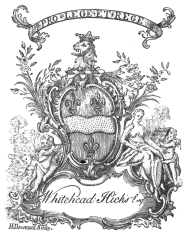
Chippendale. He had also a style which is illustrated by the
Hopkinson, Samuels, and Tomlinson plates, which is closely allied
to the style of the Bushrod Washington. The same hissing dragon, the
same tilt to the whole design, and the similarity in detail and
execution have led to the question of his being the engraver of the
latter plate. It is not a question easy to decide, and collectors are
divided over the question. This{131} style of plate came originally from
England, we can be sure; and as Dawkins is seen to be a copyist, it is
quite as likely that he copied from the Bushrod Washington plate, as
that he designed it. He always used a squarer copper than the Washington
plate is engraved upon; but this has evidences of having been cut down
after engraving. The present writer does not think the plate can be
safely attributed to Dawkins. The Child and Jones plates exemplify
the third style.
The debased Chippendale plates which Dawkins made were apparently copied
from an English example he had seen.
| A LIST OF BOOK-PLATES SIGNED BY DAWKINS. |
| Gerard Bancker | Chippendale. |
| John Burnet, 1754 | Chippendale. |
| Francis Child | Chippendale. |
| James Duane | Chippendale. |
| Francis Hopkinson,} one copper | Chippendale. |
| Joseph Hopkinson, } one copper | Chippendale. |
| Whitehead Hicks | Chippendale. |
| Archibald Hunter | |
| Samuel Jones | Chippendale. |
| Benjamin Kissam | Chippendale. |
| John Cooke Ludlow | Chippendale. |
| Gab. Willm. Ludlow | Chippendale. |
| Jacob Roome | Chippendale. |
| John L. C. Roome | Chippendale. |
| James Samuels | Chippendale. |
| Samuel Stringer | Chippendale. |
| William Sword | Chippendale. |
| John Tomlinson | Chippendale. |
| Unidentified | Chippendale. |
| Josias Short Vavasour | Chippendale. |
| W —— Whitebread | Chippendale. |
| Peter W. Yates | Chippendale. |
{132}
The plates of Cornelius Low and Lambert Moore, although not signed,
are attributed to Dawkins.
* * *
Nathaniel Dearborn was born in 1786, and was the son of Benjamin
Dearborn, a man of attainments in science. Nathaniel was one of the
first wood-engravers in Boston, and was associated with Abel Bowen for a
time.
The only armorial book-plate signed by Dearborn is the Charles Beck,
which is a peculiar design, following no particular style, but making a
pretty plate.
A second plate signed by Dearborn is the simple engraved verse for
Isaac Child.
* * *
Amos Doolittle, who was born in 1754, was one of the first engravers of
historical scenes in America. In Barber’s “History and Antiquities of
New Haven,” published in 1831, is an advertisement of “four different
views of the Battle of Lexington, Concord, etc. on the 19 April 1775.” A
list of the plates follows, and it is remarked that they were “neatly
engraved on copper from original paintings taken on the spot.” In a note
which follows, it is further remarked that the pictures were first drawn
by Mr. Earl, who was a portrait painter, and who with Mr. Doolittle was
a member of the Governor’s Guard which went to Cambridge and the scene
of action under the command of Arnold.{133}

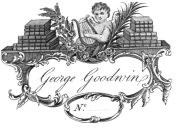

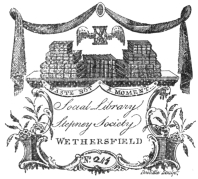
As a maker of book-plates, Doolittle was fond of the allegorical style.
He made two plates for the Societies of Yale College, and one for the
village library of Wethersfield. The latter is an ornamental label
only, but the former are quite elaborate examples of the allegorical.
The plates of Benjamin S. Brooks, in the Ribbon and Wreath style, and
Charles H. Wetmore, which is a copy of one of Maverick’s favorite
designs, complete the number of his signed examples. The Guilford
Library and George Goodwin plates, which have some features in common
with the Wethersfield Library, are confidently attributed to him.{134}
| Benjamin S. Brooks | Ribbon and Wreath. |
| Brothers in Unity | Allegorical. |
| Linonian Library | Allegorical. |
| Social Library, Wethersfield | Literary. |
| Charles H. Wetmore | Ribbon and Wreath. |
* * *
Gideon Fairman, whose signature is on one of the plates of Henry
McMurtrie and one of the Linonian Society of Yale College, was born
in Connecticut in 1774. He showed an early fondness for engraving, and
made rude attempts which showed undoubted talent. In 1810, having made
himself a master of his art, he went into partnership with Murray,
Draper, and others, in Philadelphia. He made considerable money, and
went over to England with Jacob Perkins, where, with Charles Heath for a
third partner, they were successful but for a short time, the
extravagance of Murray proving their ruin.
* * *
John Mason Furnass was the nephew of Hurd, to whom the latter left his
engraving tools by will, as the young man showed so much ability in the
art practised by his widely known uncle.
He was also a painter of portraits, and he had a studio in Boston, which
was also used by Trumbull.
The only plate signed by this engraver, which the present writer has
seen, is the Eli Forbes. This plate shows but few traces of the
influence of Hurd. It is a Chippendale design, but{135}
is not in either of the characteristic modes of Hurd. It is an ambitious
plate, and was meant to be very fine, evidently. It is full of
flourishes, and the little spiral flourish at the lower right-hand side
is wholly out of place; the robin picking rose leaves at the side is an
innovation. The scrolls under the name are somewhat in the{136} manner of
Hurd. The heraldic drawing is poor, and the bunch of arrows between the
shield and the crest must be in allusion to the occupation of the owner,
who was a missionary to the Indians.
There is said to be a plate by Furnass owned in Boston, by the name of
Foster, but no definite knowledge of it has been obtained.
* * *
E. Gallaudet, who signed the plate for the New York Society Library
and the plate of John{137} Chambers, was one Elisha Gallaudet, who
practised his art in New York City towards the end of the last century.
Edward Gallaudet, a relative of the above, was superior to him as an
engraver, and the Gallaudet plate mentioned in the List is by him. He
was of the present century.
* * *
Abraham Godwin was born in New Jersey in 1763. He was intended for the
profession of the law, and was placed in the office of his brother, at
Fishkill, in New York state. Both men joined the army, however; and when
Abraham returned to his home, it was to take up the art of engraving,
towards which he had had an inclination from boyhood, when he made his
first attempts on the silver plate of his friends, with a graver made by
a blacksmith.
The only example of his book-plate work is a plate fully described under
the heading, “Unidentified,” in the List. Most unfortunately, the only
example known has the family name torn out. The first name is John.
The plate is rather rudely engraved, but is quite ambitious, showing the
interior of a large room, which might be either a school-room or a
library.
* * *
S. Harris, who engraved the pictorial plates of Henry Andrews and the
anonymous Williams, was a New England engraver, who was in Boston
about 1798.{138}
Charles P. Harrison, who signed the plain armorial book-plates of
William Betts and David Paul Brown, was a son of William Harrison,
an English engraver, who came to New York in 1794, and was for a time an
instructor of Peter Maverick the second.
* * *
Samuel Hill was a copper-plate engraver in Boston, about 1790, and his
work consisted mostly of portraits and book work.
The following are examples of his work:—
Willm. P. & L. Blake’s Circulating
Library at the Boston Book Store | Ornamented label. |
| Charles Pierpont | Ribbon and Wreath. |
| William Winthrop | Ribbon and Wreath. |
Also the plate of Saml. Hill, which is of a literary flavor, is
probably the engraver’s own plate.
* * *
S. S. Jocelyn, of New Haven, who made a very handsome plate for the
Brothers in Unity of Yale College, became an engraver of vignettes for
bank-notes.
* * *
Thomas Johnson was born in Boston in 1708. He was buried in King’s
Chapel Burying-ground, May 8, 1767. He engraved Psalm Tune plates{139}
for the Tate and Brady edition of 1760, and did some commendable work as
a herald painter. In the inventory of his estate, fifteen copper plates
are appraised at 40s.
Only one specimen of his book-plate work is authenticated, and that is
the Joseph Tyler, which is signed in full,—Johnson.
* * *
Thomas Johnston signs the very beautiful Jacobean plate of William P.
Smith, A.M., and the rougher Chippendale of Samuel Willis. Whether
this is the same engraver as the above is uncertain; the difference in
the spelling of the name would not disprove the claim, as in those days
such differences were frequent. The Willis plate bears strong
resemblance to the work and designs of Hurd. If this is the same
engraver as the above, these two plates are likely to be the earliest
signed plates by an American, as Johnson was born some twenty years
before Hurd. The Willis plate is quite inferior to the Smith, which
latter is a striking example of the Jacobean style.
* * *
Francis Kearney, who signs the plate of Henry McMurtrie and Hector
Coffin, was born in 1780. He was a pupil of Peter R. Maverick, who
received two hundred and fifty dollars for instructing him for three
years. The advantage was all with Maverick. Soon after the opening of{140}
the century, he was engaged with Anderson, the younger Maverick, Boyd,
and others, in engraving plates for a quarto Bible published by Mr.
Collins, of New York.
In 1810 he removed to Philadelphia, as that city was far ahead of New
York in the publishing of books, etc. He was in that city for over
twenty years. His greatest work is the engraving of Leonardo da Vinci’s
picture of the “Last Supper.”
* * *
Peter Rushton Maverick was born in England, April 11, 1755, and came to
America about 1774. He was originally a silversmith, and came of a
family whose members were for several generations well known as
engravers, and who made the art their occupation. He was an energetic
worker, getting most of his practical knowledge by his own endeavors. He
was the teacher of William Dunlap and of Francis Kearney, as well as of
his own son, who ultimately became a more proficient engraver than his
father, and, who after instructing A. B. Durand for five years, took him
into partnership.
Peter R. Maverick died in New York, about 1807, and his son Peter whose
partnership with Durand resulted disastrously, died in 1831.
As a designer and engraver of book-plates, Maverick was the most
prolific of all the early engravers. It is presumed that all the plates
signed either P. R. Maverick, or simply Maverick, were by the same hand,
as a large collection of{141}
Weigh well each thought, each sentence freely scan,
In Reason’s balance try the works of man:
Be bias’d not by those who praise or blame.
Nor, Servile, Yield opinion to a Name.
{142}proofs from his plates which furnishes examples of both ways of signing
is now in the possession of the New York Historical Society, and the
librarian informs me that all of the plates in that collection were done
in 1789 by the elder Maverick. This collection consists of sixty-five
plates, of which thirty-eight different ones are signed by Maverick.
There are also others which are undoubtedly his work, although not
signed, and there are examples by Dawkins, Hutt, and Child. Quite a
number of the plates are duplicated, too. This very interesting
collection of proofs, kept by Maverick himself, and sewed together
roughly, was in the library of his friend, John Allan. By far the
greater part of Maverick’s plates are of the Ribbon and Wreath style,
but he made a few Jacobeans, a few Chippendales, and one or two
pictorial and allegorical designs. He used the same features over and
over in his plates, and seems to have been a rapid worker. The plates in
the following list marked * are by the younger Maverick.
| A LIST OF BOOK-PLATES SIGNED BY MAVERICK. |
| Anonymous | Plain armorial. |
| Anonymous (Jacob Brown) | Pictorial. |
| Flamen Ball | Ribbon and Wreath. |
| Abraham Bancker | Pictorial. |
| Absalom Blackley | Ribbon and Wreath. |
| Philip Brasher | Ribbon and Wreath. |
| *Epaphroditus Champion, Jr. | Plain armorial. |
| De Witt Clinton | Ribbon and Wreath. |
| William Cock | Ribbon and Wreath. |
| James S. Cutting | Ribbon and Wreath. |
| William Cutting | Ribbon and Wreath. |
| John Cuyler | Ribbon and Wreath.{143}
|
| Frederick De Peyster | Plain armorial. |
| Barnard Elliott | Plain armorial. |
| Erasmus Hall Library | Allegorical. |
| Ebenezer Foot | Ribbon and Wreath. |

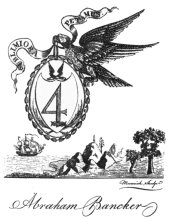
| Andrew J. Fraunces | Plain armorial. |
| James Gibs | |
| James Giles | Military. |
| *Elias Hicks | Plain armorial. |
| Philip L. Hoffmann | Ribbon and Wreath. |
| Horanian Society Library | Allegorical. |
| William J. Hunter | Ribbon and Wreath.{144} |
| John I. Johnson | Pictorial. |
| John Johnston | Ribbon and Wreath. |
| Thomas Johnston | Ribbon and Wreath. |
| Benjamin S. Judah | Ribbon and Wreath. |
| John Keese | Ribbon and Wreath. |
| John Keese | Ornamental label. |
| Rufus King | Ribbon and Wreath. |
| Isaac L. Kip | Ribbon and Wreath. |
| Edward Livingston | Landscape. |
| Maturin Livingston | Ribbon and Wreath. |
| William Smith Livingston | Ribbon and Wreath. |
| Hugh McLean | Ribbon and Wreath. |
| Peter Masterton | Ribbon and Wreath. |
| —— Maxwell | Ribbon and Wreath. |
| *Nathaniel F. Moore | Ribbon and Wreath. |
| New York Society Library | Allegorical. |
| New York Society Library | Allegorical. |
| *Lewis Morris Ogden | Ribbon and Wreath. |
| Francis Panton, Jr. | Landscape. |
| W. Paulding | |
| William L. Pierce | Ribbon and Wreath. |
| John Pintard | Ribbon and Wreath. |
| William Popham | Ribbon and Wreath. |
| Halcott B. Pride | Ribbon and Wreath. |
| Samuel Provoost | Ribbon and Wreath. |
| William Seton | Ribbon and Wreath. |
| John Sitgreaves | Ribbon and Wreath. |
| James Scott Smith | Ribbon and Wreath. |
| Thomas Smith, Jr. | Ribbon and Wreath. |
| Thomas J. Smith | |
| William Smith | Ribbon and Wreath. |
| William Taylor | Ribbon and Wreath. |
| *James Thompson | Plain armorial. |
| Thomas Tillotson | Ribbon and Wreath. |
| P. I. Van Berkel | Plain armorial. |
| K. K. Van Rensselaer | Ribbon and Wreath. |
| Prosper Wetmore | Ribbon and Wreath. |
| Polydore B. Wisner | Ribbon and Wreath. |
{145}
A LIST OF PLATES ATTRIBUTED TO MAVERICK,
ALTHOUGH NOT SIGNED. |
| James Agnew, Esq. | Chippendale. |
| Boudinet | Ribbon and Wreath. |
| Charles Bridgen | Plain armorial. |
| Willm. Duer | Ribbon and Wreath. |
| John Goelet | Jacobean. |
| Herbert | Chippendale. |
| Morgan Lewis, Esq. | Ribbon and Wreath. |
| Rob’t R. Livingston, Esq., of Cleremont | Ribbon and Wreath. |
| Walter Livingston | Chippendale. |
| Jonathan Meredith, Jr. | Ribbon and Wreath. |
| Joseph Murray | Chippendale. |
| William Pasley | Ribbon and Wreath. |
| Saml. Provoost. Coll. Pet. Cant. | Chippendale. |
| William Stephens | Jacobean. |
| John C. Ten Broeck | Ribbon and Wreath. |
| Stephen Van Rensselaer | Plain armorial. |
* * *
Oliver Pelton, who engraved a plate for the Brothers in Unity, at Yale
College, was born in Portland, Conn., in 1799, and learned his trade
with Abner Read, a bank-note engraver, of Hartford. He was an assiduous
worker, and was taken into partnership after two years’ work, with Mr.
Read and one Samuel Stiles. Samuel G. Goodrich (Peter Parley) soon
induced him to go to Boston with him, to engage in the engraving of
plates for his works. This enterprise was successful, and in 1863 Pelton
formed a partnership with William D. Terry, which was the foundation of
the New England Bank-Note Company of Boston. The plate mentioned is the
only example of his work on book-plates.{146}
R. Rawdon, who signs the plate of William L. Stone, which is a very
handsome steel-plate design, was born in Tolland, Conn., and was
associated with his brother in Albany. The brother subsequently moved to
New York.
Paul Revere, the Revolutionary patriot whose “midnight ride” is known
the world over, was born in Boston, January 1, 1735, and died there on
the 10th of May, 1818, after a life of great usefulness, leaving a name
never to be forgotten.{147}
He came of a Huguenot family, who spelled the name Rivoire originally.
He was self-instructed in the art of engraving on copper, although
brought up by his father to the business of a goldsmith. He went on the
Crown Point expedition, 1756, and after his return, married, and settled
down to the business he had already learned. He was naturally fond of
mechanics, and made himself master of its general principles. One of his
earliest attempts{148} on copper was the portrait of his friend, Dr. Mayhew.
He also engraved several caricatures which were popular, and some
historical pictures which are valuable now to the collector.
Not many book-plates have come down to us by this celebrated patriot,
and the following list comprises all that are signed.
| Gardiner Chandler | Chippendale. |
| David Greene | Chippendale. |
| Epes Sargent | Chippendale. |
| William Wetmore | Ribbon and Wreath. |
{149}
Revere’s plates do not have the compact appearance of Hurd’s, and are
not so well designed or so well engraved as the latter’s. Presumably
this branch of work was not very profitable to him, or very much
cultivated.
The accompanying design was undoubtedly a book-plate, and beyond
question is the work of Revere. It is a very rare plate.
* * *
William Rollinson was born in England, in the year 1760. He was in youth
brought up to the trade of ornamenting buttons; and, upon coming to New
York, made the gilt buttons which decorated the coat worn by Washington
at his inauguration as President. He did this without remuneration, so
thoroughly sympathizing with the country of his adoption as to feel the
honor of this service for Washington a full compensation. He was,
through the friendship of Messrs. Elias Hicks and John C. Ludlow,
recommended to the publishers of Brown’s Family Bible, for which he made
several plates. Previous to this, he found work in the shops of
different silversmiths, and had taught himself the art of engraving on
copper. At the beginning of the century, Archibald Robertson painted a
portrait of Alexander Hamilton, which Rollinson boldly undertook to make
a large engraving from. He did not understand all the processes of
engraving, and invented such as he was compelled to use, as he went on.
The duel in which Hamilton{150} lost his life occurred before the portrait
was fully engraved. Indeed, it had been undertaken more as an experiment
than with the idea of sale; but the friends of the dead statesman urged
him to complete it, which he did, and the print found a good sale.
Later, Rollinson invented a machine for ruling waved lines, which was of
vast importance in the manufacture of bank-notes.
As an engraver of book-plates, he adopted the Ribbon and Wreath style
naturally, as it was the style in vogue when he took up the work. He
made one or two plain armorials, and for the New York College of
Pharmacy one of more ambitious design. His plates, all neat in design,
are clear, skilful engraving. His work and that of Callender, in the
same style, resemble each other.
The following plates are signed by Rollinson:—
| Richard Harrison | Plain armorial. |
| Elias Hicks | Ribbon and Wreath. |
| George Ludlow | Ribbon and Wreath. |
| W. T. McCoun | Plain armorial. |
| Horatio Shepheard Moat | Ribbon and Wreath. |
| New York College of Pharmacy | Ornamented label. |
| James Adam Smith | Plain armorial. |
| Thomas N. Stanforth | Ribbon and Wreath. |
| Teachers’ Union, St. George’s Church | Engraved label. |
| John W. Watkins, A.M. | Ribbon and Wreath. |
| Charles Wilkes | Plain armorial. |
| Azarias Williams | Ribbon and Wreath. |
———
J. Smithers, an Englishman, originally a gun-engraver employed in the
Tower of London, came to Philadelphia in the year 1773.{151}
He had a good name as a man and as an engraver, and made the blocks for
the Continental money. A large plan of the city of Philadelphia on three
plates, which was his work, was subsequently purchased, when copper was
scarce, for thirty dollars, and cut up into smaller pieces. Among his
pupils was Trenchard, of whose work we have a few examples.
The following plates are signed by Smithers:—
| John Day | Plain armorial. |
| Fenwick | Chippendale. |
| Henry Hale Graham | Plain armorial. |
| John Magill | Chippendale. |
| Henry McMurtrie | Pictorial. |
He sometimes signed with the final s, and sometimes without it. His
book-plates are not especially brilliant in any way, but are good, and
in the pure style. His finest attempt is the landscape plate for Dr.
McMurtrie of Philadelphia.
* * *
T. Sparrow was an obscure engraver on wood, who worked at his trade in
Annapolis from 1765 to about 1780, and who did considerable work for
“Ann Catherine Green & Son, Printers,” of that town, on title-pages,
tail-pieces, etc. He engraved on copper the title-page for the “Deputy
Commissary’s Guide of Maryland,” published by the above firm in 1774,
and which is a creditable piece of work. All the book-plates known at{152}
present are on wood, and they are but two in number: the Richard
Sprigg and the Gabriel Duvall, both of whom were men of prominence in
the colonial times, in Maryland.
* * *
William D. Terry, who was mentioned as the founder, with Pelton, of the
Bank-Note Company, in Boston, engraved a plate for the Redwood
Library, of Newport. This is a large representation of the library, and
is a fine piece of work.
* * *
James Thackara was a partner of John Vallance, in the engraving
business, and they were together for a good many years. Thackara was
inferior to his partner as an engraver, according to Dunlap, and was for
a long time the keeper of the Pennsylvania Academy of Fine Arts.
We know but one example of his book-plate work, and that is the
Lenthall plate, which is a large and very interesting example of the
Ribbon and Wreath style. It is an excellent piece of engraving, full of
style, and graceful in design.
* * *
James Trenchard was born in Cumberland County, New Jersey, about 1746.
He was a pupil of Smithers, and engraved in Philadelphia,{153}
{154}
about 1785. Among his pupils were Thackara, Vallance, and his nephew,
Edward Trenchard, who became an officer in the United States Navy, and
served in the War of 1812.
Trenchard was one of the owners of the “Columbian Magazine,” published
in Philadelphia from 1786 to 1792, and he engraved many plates for its
pages.
One signed book-plate of his is known,—the Bloomfield. This is a
Chippendale plate of no{155} striking features. The Luther Martin plate is
so similar to this as to leave hardly any doubt that it too was by
Trenchard.
* * *
James Turner is another of the early American artists of whom very
little is known now. He was at one time in Boston, but later removed to
Philadelphia. He did some portrait and some music work. Of his
book-plate work we have but three signed specimens. By far the most
interesting and valuable of these is the extremely{156} rare plate of John
Franklin of Boston in New England. This is very fully described in the
List of Early American Book-plates. The other plates are the Sir John
St. Clair, and the plate for Isaac Norris, of the family of the
Quaker Chief Justice of Pennsylvania.
{157}
The plate of James Hall, although not signed, is also attributed to
him.
* * *
John Vallance, whose name is connected with that of Thackara, engraved
with him many plates for Dobson’s Encyclopædia. He made heads of
Franklin and Howard, which were pronounced successful, and he had a high
reputation as an engraver.
One authenticated example of his book-plate{158} work is known, the Joseph
Wiseman, in the Ribbon and Wreath style; and the David Brearly,
although not signed, is attributed to him.
* * *
Of the other engravers whose names appear on but one or two plates, no
information has been obtained. There were probably many who had but a
local fame, and who made but a few plates. Their names are remembered
now in a way not expected at the time of signing them, undoubtedly.
* * *
In a recent article on Count Rumford, in the “New England Magazine,” it
is said that, when a youth, he designed book-plates. No authentic
examples of his work are known, and no information can be obtained
concerning any.
* * *
Jacob Hurd, the father of Nathaniel, was a goldsmith of Boston, and his
name is on pieces of plate in the First and Second churches in Boston,
and the First Church, and Christ Church, in Dorchester. He very probably
made book-plates, though no signed work is known. He died in 1758. He
appears in the list of subscribers to “Prince’s Chronological History of
New England,” as taking six copies.{159}
In the “Boston Evening Post,” for March 4, 1745, the following
advertisement appears:—
“Francis Garden, Engraver from London, engraves in the newest
Manner and at the cheapest Rates, Coats-of-Arms, Crests or Cyphers
on Gold, Silver, Pewter or Copper. To be heard of at Mr.
Caverley’s, Distiller, at the South End of Boston. N.B. He will
wait on any Person in Town or Country, to do their Work at their
own House, if desired: also copper-plate printing perform’d by
him.”
No signed example of this gentleman’s work has thus far come to our
knowledge. It is fair to presume, however, that he engraved book-plates.
{160}
A LIST OF EARLY AMERICAN
BOOK-PLATES.
The following List of Early American Book-plates makes no claim to
completeness: indeed it is earnestly hoped and believed that time will
prove it to be quite incomplete: old plates new to collectors are
continually coming to light, and there is every reason to expect their
number to increase. We are persuaded that certain of the worthies of
colonial times used book-plates, although no copies are now known, and
that some future investigator will unearth these much-desired treasures.
Some plates will be found included which do not have a satisfactory
description: this is due to their not being seen by the compiler of the
List: correspondents at a distance cannot always send full details, and
without them it is better to attempt little in the way of description.
The aim has been to be accurate and as full as possible. There are
hundreds of simple name-labels which have no place here, but all
armorial examples which could be discovered are mentioned.
The plates are given in alphabetical order, and are numbered for
convenience in reference. As far as possible, the first line of the
description of each plate gives the exact wording of the original, with
its spelling and abbreviations: the mottoes also, as well as the manner
of signature, are given exactly as they appear on the original plate:
wherever throughout this List italics are used, they denote the exact
language employed upon the plate.
1. Anonymous.
Armorial. A very beautiful plate with French arms: a crown above
and military trophies behind the shield: French banners, cannon,
quivers of arrows, anchor, horns, swords, drum, tomahawks, bugle,
lances, etc. Signed, Maingot delt. Maverick, Sct.
{161}
2. Abercrombie. James Abercrombie.
Armorial. Ribbon and Wreath. Two mottoes, Vive ut vivas, and Meus in
arduis aequa. Of Philadelphia, and mentioned in Boswell’s “Life of Dr.
Johnson.”
3. Adams. John Adams.
Armorial. The Boylston arms. The shield surrounded by a garter on which
the motto is given,—Libertatem amicitiam retenebis et fidem. The
whole design surrounded by thirteen stars. Second President of the
United States.
4. Adams. John Quincy Adams.
Simply the name rudely engraved and surrounded by a narrow line.
Probably the first of the J. Q. A. book-plates. Sixth President of the
United States.{162}
5. Adams. John Quincy Adams.
Armorial. Boylston arms. Ribbon and Wreath. Motto-ribbon empty.
6. Adams. John Quincy Adams.
Armorial. The Boylston arms; the shield enclosed within a garter, on
which the motto appears,—Fidem—Libertatem—Amicitiam.
7. Adams. John Quincy Adams.
Armorial. The shield is quartered, and bears in the first quarter a
curious specimen of home-made heraldry. The ancestors of the President
bore no arms, and in their place appears a stag standing at gaze before
a pine tree, while below in the water a fish, probably a cod, is
swimming; the whole design surrounded with thirteen stars. This was his
own invention. The other quarters bear the Smith, Quincy, and Boylston
arms. The whole shield is surrounded by a garter bearing the motto
Fidem, Libertatem, Amicitiam retinebis. From “Tacitus.”
8. Agar. Property, Lydia Agar. 1806.
Pictorial. An eagle bears a broad ribbon, on which the word property
is given; an oval frame encloses what resembles a row of eggs.
9. Agnew. James Agnew, Esq.
Armorial. Chippendale. Motto, Consilio non impetu. Attributed to
Maverick.
10. Aitkin. Robert Aitkin.
Simple name label: the printer of the “Aitkin Bible.” Philadelphia,
1782. The first American edition.
11. Albany. Albany Society Library. 1759.
A peculiar plate something in the shape of the figure 8, with
intertwining foliations above and at the sides. The upper part of the
frame is the larger, and contains a spirited illustration of an Indian
in ambush aiming an arrow at a leaping fox. On the frame surrounding
this is the motto, May concord prevail and the undertakeing prosper.
In the lower and smaller part is depicted a prim{163} man, bewigged and
ruffled, with an open book in his hand; presumably a patron of the
Library. Very little can be learned concerning this early Library. It
was probably interrupted by the Revolution. Some of its books are in the
New York State Library.
12. Allan. John Allan.
Pictorial. An open book, across the pages of which is printed the name
of the owner. Behind all an anchor. This is the plate of the old book
collector of New York City.
13. Allen. John Allen.
Armorial. Jacobean. Motto, Law & Right. This is believed to be the
plate used by John Allen, an early bookseller of Boston. He published
the “News-Letter.” From the general design and the crude engraving, it
must be taken for early American work: circa 1720. Illustrated in
“Curio,” page 15.
14. Allison. Joseph J. Allison.
Armorial. Chippendale. Hour-glass, books, globe, palette, and brushes,
grouped above the escutcheon. Motto, Hinc labor et virtus. Of
Philadelphia.
15. Alsop. Richard Alsop.
Armorial. Belongs to no particular style, although the ornamentation is
of Chippendale tendency. Beneath the shield, at either side, stands a
cupid holding out a bunch of arrows: the drawing of these figures is not
above criticism: they seem to have one arm each, and but one wing also.
A Connecticut poet. Born, 1761; died, 1815. One of the famous “Hartford
Wits.”
16. Ambler. Armorial. Of Virginia.
17. American. American Academy of Arts and Sciences. MDCCLXX.
A very handsome plate, having a large curtain looped back by ribbons and
cords, whereon to record the name of the giver of books to the{164} library,
and above this an oval vignette representing Minerva with shield and
spear in hand, and helmet on her head, standing upon the sea-shore (of
Massachusetts), watching a three-master which sails far away under a
glaring sun and a heavy cloud: through a corn-field and then through the
woods lies the path to the distant village whose roofs can be seen: on
the sand about the goddess lie scattered the scientific and agricultural
implements, the uses of which it was the function of the Academy to
teach. The Academy was instituted in 1779. Very good engraving but not
so good drawing. The work is attributed to Callender.
18. Anderson. Alexr. Anderson.
Armorial. Chippendale. Motto, Vigila. Signed, A. Anderson, Sculp.
The original plate had only the last name engraved; the first name was
added afterwards and evidently by a different hand. This plate is
sometimes found with the name of his brother, John, written in before
the family name, indicating perhaps that the plate was designed for the
general use of the family. This is the plate of Dr. Anderson, the first
engraver in wood in America.
19. Andover. Institutio Theologica Andover. Fundata MDCCCVII.
A severely plain pediment, raised upon Doric columns, bearing on the
architrave the name. A blaze of glory above has in the centre the words,
יהוה. Similar rays shine over the open Bible at the foot, on which is
written, Ps. cxix, 169, and JOH. xvii, 17. On the base are the words,
ΑΚΟΓΩΝΙ ΣΟΥ ΧΡΙΚΤΟΥ.
20. Andrew. John Andrew.
Pictorial. The implements of the engraver lie scattered upon the bench:
the name is given in fac-simile of the autograph.
21. Andrews. Armorial. Of Virginia.
22. Andrews.—— Andrews. (First name obliterated.)
Pictorial. The scene is out of doors and the sun rises in full strength
behind a long oval frame on{165} which the name is engraved. A little patch
of earth, two well-grown trees, and scant herbage complete the
accessories. Signed, Callender Sc.
23. Andrews. Eliza Andrews.
Pictorial. Exactly the same as the succeeding, with the exception of the
change in the name and the omission of the engraver’s signature.
24. Andrews. Henry Andrews.
Pictorial: representing Minerva, crowned, with spear and shield: the owl
sits upon a convenient pedestal. The name of the owner is put upon the
edge of the shield which the goddess rests upon the ground. Signed, S.
Harris. Sc.
25. Antill. Edwad. Antill. Esqr., A.M.
Armorial. Chippendale. Motto, Probitas laudatur et alget. A New Jersey
author. Illustrated in “Art Amateur,” April, 1894.
26. Apthorp. Apthorp.
Armorial. Chippendale. Motto-ribbon empty.
27. Apthorp. East Apthorp, A.M. Cambridge MDCCLXI.
Armorial. Late Jacobean. Motto, Nemo nisi Christus. Eminent Episcopal
divine, born in Boston, 1733; educated at Cambridge, and died, 1816.
28. Apthorp. Jno. Apthorp.
Armorial. Chippendale. Motto, Fari quae sentiat. The same plate as the
one mentioned above as having the motto-ribbon empty. In this example
the name Jno. is written, and so is the motto.
29. Apthorp. Thomas Apthorp.
Armorial. Chippendale. Motto, Juste rem para. Flowers, and a huge bee
in the decoration. Printed in blue ink. Born, 1741. Died in England.
30. Archdeacon. S. Archdeacon.
Armorial. Chippendale. Motto, Esse quam videri. Signed, W. S. A
pretty design, with the caduceus of Mercury introduced in the
ornamentation.
31. Archer. William Archer.{166}
Armorial. Of Chesterfield County, Virginia.
32. Archer. William Archer, Powhatan. A plain label with the name
within a type border.
33. Armistead. William Armistead.
Armorial. Of Virginia. Of Revolutionary fame.
34. Ashwell. Charles Ashwell of Grenada. Plain armorial.
35. Assheton. Ralph Assheton, M.D., Philadelphia.
Armorial. Chippendale. Motto, In Domino confido. Son of the
Councillor; studied medicine in Edinburgh.
36. Assheton. Willm. Assheton Esqr. of Barbadoes.
Armorial. Chippendale. Very ornate. No motto. Began the practice of law
in Penna., and was afterwards described as “of the Parish of St.
Michael’s in Barbadoes, gentleman.” He was Provost-Marshal of Barbadoes.
37. Assheton. William Assheton Esq. of Gray’s Inn, Judge of the Court
of Admiralty of Penn. 1718.
Arms, crest, and quarterings.
38. Atkinson. Theodore Atkinson.
Armorial. Chippendale. No motto. Signed, N. Hurd. Scp. This is the
same design that was used in the Wentworth plate, but is much better in
execution. The peculiar flow of water from the shell beneath the
escutcheon is caught in a bowl: the only instance. Secretary of the
colony of New Hampshire, 1741; Chief Justice, 1754; Major-General of
militia, 1769; delegate to Congress at Albany, 1754.
39. Atkinson. William King Atkinson.
Armorial. Chippendale: a copy of the preceding design. Motto, Nil
facimus non sponte Dei. Signed, Callender Sc. A noted lawyer of
Portsmouth, N.H. (1764-1820). Changed his name from King to Atkinson out
of respect to Judge Atkinson.
40. Atlee. Willm. Augs. Atlee Esqr. of Lancaster PENNSYLVANIA.
Armorial. Chippendale. Motto-ribbon empty;{167} bears some marks of being
unfinished. Judge of the Supreme Court of Pennsylvania, 1777-1791.
41. Atwood. Harry Atwood.
Armorial. Chippendale. Very ornate; architectural and landscape effects
used. No motto.
42. Auchmuty. Richard Tylden Auchmuty. Plain armorial. Motto, Dum
spiro spero. Signed, A & S.
43. Backhouse. W. Backhouse, M.A.
Armorial. Chippendale. Motto, Pax et amor.
44. Backus. Elijah Backus.
Armorial. Jacobean. No motto; name on motto-ribbon. Very crude
workmanship.
45. Baldwin. D. Baldwin, Owner. An Engraved Label, the Words Being
Within an Oval Wreath.
46. Baldwin. Jonathan Baldwin.
Armorial. Signed by Callender.
47. Baldwin. Luke Baldwin.
Armorial. Signed by Callender.
48. Ball. Flamen Ball.
Armorial. Ribbon and Wreath. Motto, Semper caveto. Signed, P. R.
Maverick. Sct.
49. Ballord. Wm. Ballord’s.
Armorial. Plain. No Motto.
50. Baltimore. The Library Company of Baltimore. Simply the Name
Engraved Within an Oval Frame. Signed, S. Allardice Phi.
51. Bancker. Abraham Bancker.
Pictorial. An eagle bears aloft an oval
frame which contains the large figure 4 always seen on the book-plates
of this family. A ribbon flying from the beak of the eagle bears the
motto, Sublimiora petamus; beneath, a three-masted vessel, with homing
pennant streaming, passes half-submerged trees and a chain of mountain
peaks. Signed, Maverick Sculp’.{168}
52. Bancker. Charles N. Bancker.
Armorial in style, but showing no actual arms. The shield is occupied by
a large figure 4, which is an old “merchant mark.” Chippendale. Puffy
cupids are seated on either side of the frame with accessories which
indicate the pursuit of science. Motto, Dieu Defend le Droit. Signed,
Jones Sc. Of Philadelphia.
53. Bancker. Charles N. Bancker.
A Chippendale frame enclosing the
figure 4, and showing the same motto as the above. Helmet, wreath and
crest, the eagle’s wings erect, ppr. Not signed.
54. Bancker. Evert Bancker, Junr.
A smaller and older plate than the
others of this name, and showing the same figure 4, with rather wild
mantling, and crest.
55. Bancker. Gerard Bancker.
Chippendale. A cupid holding a globe
converses with a companion, perhaps about commerce and ocean currents;
behind them a pyramid rises, and two other cupids are consulting a plan.
The figure 4 is again prominent in this plate. Signed, Dawkins
Sculpsit.
56. Bancroft. George Bancroft.
Pictorial. A chubby cherub approaches,
with a panel in his hands on which the words ΕΙΣ ΦΑΟΣ are given. Another
plate, identical in all other details, gives the motto, Sursum corda.
Historian of the United States.
57. Banister. John Banister.
Plain armorial. (arms of Banester of
Easington, County York, according to Burke). No motto. Of Virginia.
Revolutionary soldier. Died, 1787.
58. Barrell. Joseph Barrell.
An allegorical plate full of detail. In
the centre is the shield with the arms, while above the crest sits Hope
with her anchor. As indicative of Industry, a very trim female figure is
presented, surrounded by{169} signs of prosperity, such as the beehive,
palette and brush, and square and dividers. In contrast to this a
bare-footed, raggedly clad woman with a dead fish in her lap, snails on
her shoulders, broken tools around her, and with every appearance of
misery and squalor, is shown at the left. The contrast between Thrift
and Indolence is continued in a second series of pictures below the
shield. In these it is the begging tramp and the erect, well-clothed
gentleman who depict the moral. Dilapidated shanties and well-built
houses are also in contrast. Mottoes, Not always so—Indure but hope.
A rich Boston merchant. A pioneer in the Northwest coast trade.
59. Barroll. William Barroll. Chestertown. 1795.
An engraved name
label, with the all-seeing eye above the oval frame which encloses the
name. The palm and holly are crossed beneath.
60. Barton. William Barton.
Armorial. Perhaps the plate of the capturer of Genl. Prescott (1777) in
Narragansett Bay.
61. Bartram. John Bartram.
Armorial. Chippendale. Motto, Foy En Dieu. A second motto, J’avance.
Celebrated Botanist of Pennsylvania.
62. Bathurst. Armorial. Of Virginia. See Burke’s “extinct Baronetage.”
63. Bay. William Bay. M.D.
Armorial. Ribbon and Wreath, Motto, Quo Fata Vocant. The heraldic
drawing is poor and the charges are reversed. Born, Albany, 1773. Died,
1865.
64. Bayard. James A. Bayard.
The name well engraved within an oval
wreath. The Delaware statesman, leader of the Federal party, and one of
the negotiators of the Treaty of Ghent. Born, 1767; Died, 1815.
65. Bayard. Saml. Bayard.
Armorial. Chippendale. No motto. This is a very interesting specimen of
the debased Chippendale.{170} As decorative features the following are used:
a large globe, quadrant, compass, sun-dial, beer-stein, and a little
landscape. The branches of the frame are made to support these objects
named. Jurist. Published books on law.
66. Bayley. Armorial. of the Eastern Shore, Va.
67. Beatty. J. Beatty. M.D.
Armorial. Pictorial. The shield rests against the bole of an oak, and
while the arms on it (Arg. a beehive surrounded by bees) are not given
in Burke, the crest appears in Fairbairn, with some changes. A globe,
open book, scroll, caduceus, and cornucopia of fruit complete the
accessories. Not a common type among American plates. John Beatty was
born in Pennsylvania, 1749, and died in New Jersey in 1826. Rose to the
rank of Colonel In the Revolutionary War, and was delegate to Congress,
1783-1785. Member of Federal Convention, and member of Congress.
Illustrated in “curio,” page 114.
68. Beck. Charles Beck.
Armorial. Ribbon and Wreath. Signed, N. D. Sc. (nathaniel Dearborn). Of
Cambridge, Mass. Scholar and Author.
69. Bedlow. William Bedlow.
Armorial. Monogram B L at foot of arms. Jacobean. Motto, My hope on
high. Of Bedlow’s Island, New York.
70. Beete. Joseph Beete. Demerary. Plain Armorial. Motto, Fortuna
perit, honestas manet.
71. Belcher. (Anonymous.)
Armorial. Jacobean. Motto, Loyal jusqu’à la Mort. This is the plate of
the Colonial Governor of Massachusetts and New Hampshire, 1730-1741
(Jonathan Belcher). The arms are the same as borne on the plate of his
son Jonathan, except that this plate shows a label for difference. There
is also a shortening of the motto in the other plate.{171}
72. Belcher. Jonathan Belcher E Societate Medij Templi.
Armorial. Jacobean. Very similar to the last. Motto, Loyal au mort.
Son of the preceding; born in Boston, 1710. Graduate of Harvard, student
at the Middle Temple, one of the first settlers of Halifax, N.S. Died
there, 1776. Illustrated in “Curio,” page 113.
73. Belcher. William Belcher, Owner.
Literary. A shelf of books enclosed within an oval
which bears the mottoes, With welcome use—but
use with care. The wicked borrow,—but never
return. Of New London, Conn., circa 1790.
74. Belcher. William Belcher. Savannah.
Armorial. Pictorial. A very beautiful engraving.
The shield rests upon the ground and is supported
by the oak tree which spreads over it; willows and
pines complete the little group of trees, and beyond
a stretch of water is seen. The motto, Loyal au
mort, is on the ribbon which flutters along the
ground beside the shield.{172}
75. Bel-chier. J. Bel-Chier.
Armorial. Jacobean. Motto, Loyal jusq’ a la
mort. Printed in red ink.
76. Beresford. Richard Beresford, Charleston. 1772.
Armorial.
77. Betts. William Betts.
Armorial. Plain. Motto, Malo mori quam foedari.
Signed, C. P. Harrison Del. Sct.
78. Beverley. Harry Beverley.
Armorial. Chippendale. No motto.
79. Beverly. Robert Beverly.
Armorial. Of Virginia. Historian.
80. Beverly. William Beverly.
Armorial. Signed, J. Kirk.
81. Blackley Absalom Blackley.
Armorial. Ribbon and wreath. Motto, Utere
mundo. Signed, Maverick Scp. The name supported
by two quills.
82. Blake. Willm. P. & L. Blake’s Circulating Library at
the Boston Book Store.
An engraved label enclosed in an ornamental oval
frame. Signed, S. Hill. Sc.
83. Blanc. William Blanc. Middle Temple. Dominica.
Crest only. Motto on a garter enclosing the crest,
Frangas non flectan.
84. Blatchford. Thomas W. Blatchford.
Plain armorial. Motto, Providentia sumus. Signed,
Wm. D. Smith sc.
85. Bleecker. Bleecker.
Plain armorial. A festoon of cloth behind the
shield.
86. Blenman. Jonathan Blenman, Attoray, Genl. & Judge of
ye Admty. in Barbadoes.
A small plate, without motto, rather poorly engraved.
A little ornamentation of Jacobean
manner appears at either side, and the mantling is
rather profuse, but well above the shield.{173}
87. Bloomfield. Bloomfield.
Armorial. Chippendale. Rudely drawn books
used in the frame. Motto, Pro aris et focis.
Signed, J. Trenchard. Major Joseph Bloomfield
was a soldier in the Revolution, Governor of New
Jersey, Brigadier-General in War of 1812, member
of Congress, 1817-21. Illustrated in the “Art
Amateur,” April, 1894.
88. Bolling. Robt. Bolling Esq’r.
Armorial. Chippendale. Figures are used as
supporters which would appear to symbolize the
freedom of the Garden of Eden, and the learning
of classic Greece. Motto-ribbon empty; no crest.
Of Chellowe, Va. Illustrated in “Curio,” page 15.{174}
89. Bonaparte. Jerome Napoleon Bonaparte.
A plain label, with an ornamental type border.
Nephew of Napoleon the Great. Born in England,
1805; died in Baltimore, Md., 1870.
90. Bond. T. Bond, Surgeon.
Armorial. Chippendale. Signed, W. H. Native
of Maryland; 1712-1784. A distinguished physician
and surgeon of Philadelphia.
91. Booth. Benjn. Booth.
Crest only. Autograph in a wreath under the
crest. Of New York, until the Revolution broke
out.
92. Booth. George Booth.
Literary. A lighted candle and books in confusion
are placed upon a table. The name is
carved upon the edge of the table. On one of the
book-covers appears the Booth crest. An etched
plate.
93. Boston. Shakspeare Circulating Library, Charles Callender,
No. 25 School Street, Boston.
A very curious old woodcut, with a large oval
medallion of the famous writer for whom the
library was named placed in the centre against a
rough rock background; the masks of Comedy
and Tragedy lie at the foot, and the hilts of foils
can be made out; a garland of roses falls at the
right hand, and the rays of the sun come over the
top. This is a rough engraving, very black and
indistinct.
94. Boston. Social Law Library. Boston.
The name appears on a curtain looped up and held
by cord and tassel; above this a small oval encloses
a view of four waterspouts, each from behind a
rock; above this the circular frame encloses a hand
bearing a lighted torch; on the frame is the motto,
Vestra cura alitur, and the date 1804; a pile of
books above for crest, with S.L.L. on the cover
of one.{175}
95. Boucher. Jonathan Boucher.
Armorial. Chippendale. Motto, Non vi sed
voluntate. A Loyalist clergyman in Virginia, whose
estates were confiscated, after which he returned
to England whence he had come in 1754.
Published a tract on the causes and consequences
of the Revolution, and compiled a glossary of
Provincial and Archæological Words, which was
purchased of his family in 1831, for the proprietors
of Webster’s Dictionary.
96. Boudinot. Boudinot.
Armorial. Ribbon and Wreath. Motto, Soli Deo
gloria et honor. Elias Boudinot, born in 1740,
in Philadelphia, of Huguenot extraction. Sided
strongly with the colonies in the Revolution, and
was President of Congress in 1782. A signer of the
Treaty of Peace. Died, 1821. This plate is not
signed, but it is the work of Maverick. Illustrated
in “Curio,” page 111.
97. Bowdoin. Honble. James Bowdoin. Esqr.
Plain armorial. Motto, Ut aquila versus coelum.
The same plate as the Bowdoin College, whose
benefactor he was.
98. Bowdoin. Bowdoin College.
Plain armorial. The arms of the Hon. James
Bowdoin are given with his motto, Ut aquila versus
coelum. The sun in splendor shines above the
crest, and the name of the college is engraved over
it. This college was chartered in 1794, and then
presented with eleven hundred pounds and one
thousand acres of land, by Hon. James Bowdoin,
son of the governor of the colony. By his will a
further gift was made to the college.
99. Boylston. Boylston Medical Library.
Plain armorial. The arms of the Boylston family
are given without ornamentation or motto. Signed,
Annin & Smith. Ward Nicholas Boylston, a patron
of medical science, gave to the medical school of
Harvard College a valuable collection of anatomical
and medical books and engravings, in the year 1800.{176}
100. Boylston. Property of the Boylston Medical Library
Cambridge.
Armorial. The arms of the Boylston family are
given. Signed, Callender Sc.
101. Bozman. John Leeds Bozman. Esqr of the Middle
Temple.
Armorial. Ribbon and Wreath. Motto, Sine
virtute vani sunt honores. Lawyer, poet, and
historian; born in Maryland in 1757, died in 1823.
University of Penn., 1783. Completed his studies
in London. His chief work is the “History of
Maryland to the Restoration in 1660.” An “Historical
and Philosophical Sketch of the Prime Causes
of the Revolutionary War” was suppressed; in this
Washington was praised and Franklin depreciated.
This same copper has been used more recently
with the following words added: on either side of
the crest, “John Leeds Kerr of Talbot Co. Md.
15th Jan. 1780, 21st Feb. 1844;” at the bottom,
under the name of Bozman, “The Maryland Historian,
25th Aug. 1757, 20th April, 1823.”
102. Brasher. Philip Brasher.
Armorial. Ribbon and Wreath. Motto, Beata
Domus, Custodita Sic Cuja Deo Domino Est.
The shield, with its motto-ribbon and flowery
ornamentation, seems to be held up by the winged
female who grasps the portcullis of the crest.
Below the shield a patch of ground is strewn with
books and writing material. A dwarfed weeping
willow bends mournfully at the left. Signed on an
unrolled sheet of paper, Maverick Scp. Was a
prisoner in a sugar-house in New York during the
Revolutionary War, which suggested the crest; he
had no right to the arms.
103. Brazer. John Brazer.
Plain armorial. Shaded mantling. Motto, Try.
Of Salem, Mass.
104. Brearly. David Brearly.
Armorial. Ribbon and Wreath. Motto, Honor
virtutis praemium. A large plate; attributed to{177}
Vallance. Jurist, of Trenton, N.J. A brave officer
in the Revolution.
105. Bridgen. Charles Bridgen.
Plain armorial. Motto, Probitate et industria.
This plate is not signed, but it is very probably the
work of Maverick.
106. Brimage. William Brimage.
Plain armorial. Impaling Gilbert. Arms closely
surrounded by a garter on which the name appears.
Motto below, Deus dux certus. Of Virginia.
107. Brisbane. William Brisbane.
Armorial. Ribbon and Wreath. Motto, Dabit
otia Deus.
108. Brooks. Benjamin S. Brooks.
Armorial. Ribbon and Wreath. Motto, Sustinere.
Signed, A. D. (Amos Doolittle).
109. Brown. David Paul Brown.
Plain armorial. Motto, Patria cara, carior libertas.
Signed, C. P. H. St. Lawyer, of Philadelphia.
110. Brown. The Property of Jacob Brown.
Pictorial. The interior of a library is depicted,
within an oval frame which is ornamented above
with a ribbon and a spray of holly; the name is
given on the fluttering ends of the ribbon. The
central portion of the library is occupied by a
couch, covered with striped cloth, on which a
youth, dressed in the height of the fashion,
reclines; a book is laid upon the convenient corner
of the table, and he is reading from this; behind
him the shelves of books are seen partly covered
by a curtain; through the window are seen the
nodding pines; the carpet is adorned with thirteen
stars. The following lines are given below the
frame:—
Weigh well each thought, each sentence freely scan,
In Reason’s balance try the works of man;
Be bias’d not by those who praise or blame,
Nor, Servile, Yield opinion to a Name.
{178}
Signed, Engrd. by P. R. Maverick 65 Liberty Street. As the name Jacob
Brown is not engraved, but is printed by hand, it is quite likely that
this plate was for promiscuous use; either to be filled up with the name
of any who ordered it, or to be pasted in the books sold by some
bookseller.
111. Brown. John Carter Brown. Crest only. Motto, Gaudeo.
112. Brown. Thomas Brown.
Armorial. Arms, ... on a chevron, between three leopards’ heads
cabossed, or as many escallops.... Crest, an eagle’s head erased or.
Motto, En espérance je vie. Signed by Hurd.
113. Browne. Peter A. Browne.
Literary. A plain table, with the scull
and crossbones carved in two places upon it, supports several large
volumes, on the side of one of which is the name of the owner. On the
side of the table the motto is cut, Fiat Justitia. A wreath of laurel
rests upon the books, and the all-seeing eye looks upon the scene from
above. Signed, Engraved by James Akin. A prominent lawyer in
Philadelphia, and the author of “Browne’s Reports.”
114. Brownson. Oliver Brownson’s Property.
An engraved label with the
name curved over a peacock which is perched on a scroll.
115. Bruen. M. Bruen.
Plain armorial. Motto, Fides scutum. Matthias
Bruen was a clergyman in New York City; ordained in London, 1819.
116. Bruff. The Property of J. G. Bruff, Portsmouth, Va. 183-.
Pictorial. On this, a weeping elm supports a large shield on which the
inscription is given; so large is the shield that only a little of the
tree shows around the edge of the shield. A woodcut.
117. Buchanan. W. B. Buchanan.
Armorial. Motto, Clarior hinc honos.{179}
118. Bull. Martin Bull.
Armorial. A plain armorial plate with the mantling extending down the
side of the shield. Motto, Virtus basis vitae. This is the plate of
one of the engravers of the old Farmington book-plate, Deacon Bull. See
“Ex Libris Journal,” Vol. III, page 187.
119. Burke. James Henry Burke Esqr.
Armorial. Ribbon and Wreath. Motto, Sola salus servire Deo. Of
Virginia.
120. Burnet. John Burnet. Attorney at Law New York.
Armorial. Jacobean frame; mantling. Motto, Virescit vulnere virtus.
This plate is earlier than the succeeding one by Dawkins.
121. Burnet. John Burnet Esqr New York.
Armorial. Chippendale. The usual pastoral scene which Dawkins used is
found here; the shepherdess, and the cupids making music on the flute,
and bringing books for leisure moments. Motto, Virescit vulnere
virtus. Signed, H. Dawkins Sculp. 1754. Illustrated in “Curio,” page
13.
122. Byam. Francisci Byam, ex Insula Antigua.
Armorial. Jacobean. Motto, Claris dextera factis. Rich mantling
continued around the whole shield; the background shell-lined. Printed
in brown ink.
123. Byrd. William Byrd of Westover in Virginia Esqr.
Armorial. Jacobean. A very interesting specimen of its class. The
profuse mantling thrown high in the air, the shell-lined background, and
the curtain upheld at the ends (on which the name and address are given)
are prominent characteristics as pointed out by Warren. A rich abundance
of fruit overflows from two cornucopiæ, and the motto-ribbon is twined
in and out through the scrolls at the base. Motto, Nulla pallescere
culpa. Colonel Byrd was a very distinguished Virginian: was born to an
ample fortune, liberally educated, and became the patron of science and
literature in his native state. President of the Council of the colony;{180}
author of the “Westover Manuscripts,” and of other essays. Born, 1674;
died, 1744. Illustrated in “Curio,” page 14.
124. Cabell. Doct.r Geo. Cabell Richmond Virga.
Allegorical. In the
centre of the design a flaming heart rests upon the shank of an anchor.
A thin patch of ground, which grows a few trees, and looks like an
island, upholds these emblems of hope. The motto is just above,—Spes
mea in Deo. Above this again the all-seeing eye, wreathed in clouds,
appears. The whole is enclosed in a design of Ribbon and Wreath
arrangement. Evidently the work of Brooks, who engraved the plate of Dr.
I. Dove of the same city.
125. Cabell. Samuel Jordan Cabell, of Soldier’s Joy.
Pictorial. The
name is printed from type upon a large oval medallion; this is supported
by the half-draped figure of Liberty holding the pole with the cap upon
it, and an officer in the uniform of the Continental Army. The arms of
the United States are above the medallion. The pictorial parts of this
are cut in wood.
126. Cabot. William Cabot.
Armorial. Wild Chippendale. No motto. Of Massachusetts.
127. Cadena. M. V. C. (Mariano de la Cadena.)
Plain armorial. An
ordinary square shield supported by a very peculiar frame. Motto, Fidem
servat vinculaque sulvit. A Professor of Spanish in Columbia College.
128. Cadena. Don Mariano Valazquez de la Cadena. Plain armorial. No
motto. Of New York City.
129. Cadena. Mariano Valazquez de la Cadena. Small, plain armorial. Of
New York City.
130. Caillaud. John Caillaud. Esqr.
Armorial. Ribbon and Wreath. The frame enclosing the arm is oval in form
and quite peculiar in construction; an eagle with a chaplet in his beak
appears as a crest.{181}
131. Callaway. Thomas Callaway. Plain armorial. Motto, Aliis quod ab
aliis.
132. Callender. John Callender.
Armorial. Pictorial. The shield rests against a rock, mossgrown and
over-topped by shrubs. Signed, Callender Sc. Of Massachusetts.
133. Calvert. Thos. Calvert.
Armorial. Chippendale. Motto-ribbon empty.
134. Campbell. Donald Campbell. Jamaica.
Armorial. The shield affixed to the mast of a lymphad. (The crest of
this family of Campbells.) Motto, Fit via vi.
135. Carmichaell. The Honourable Wm Carmichaell Esqr.
Armorial. Early English. The very full mantling nearly surrounds the
shield. Motto, Toujours prest. Diplomatist. Born in Maryland. Delegate
to Congress, 1778-1780. Foreign minister. Illustrated in “Curio,” page
16.{182}
136. Carroll. Charles Carroll.
Armorial. Chippendale. No motto. The last surviving signer of the
Declaration. Died, 1832. This was the Charles Carroll who added “of
Carrollton” after his signature to the Declaration, that no mistake
might ever be made in recognizing him. Illustrated in “Book Lovers’
Almanac,” 1894. Duprat and Co., New York.
137. Carroll. Charles Carroll Barrister at Law.
Armorial. Jacobean. No motto. The same arms as the Charles Carroll.
138. Carroll. Charles Carroll of ye Inner Templer Esqr,
Second Son of
Daniell Carroll of Litterlouna Esqr. in the Kings County in the Kingdom
of Ireland.
Armorial. Early English. Elaborate mantling all about the shield.
Motto-ribbon empty. Grandfather of Charles Carroll of Carrollton, the
signer. Emigrated to Maryland about 1686.
139. Carroll. Ephm. Carroll.
Armorial. Ribbon and Wreath. Motto, In fide et in bello fortes.
140. Cary. Alpheus Cary. Jr.
Plain armorial. The shield surrounded by an oval frame of sun’s rays.
Signed, A. Cary del. H. Morse Sc. Of Massachusetts.
141. Cary. Miles Cary.
Armorial. Chippendale. Motto, Sine Deo careo. Of Virginia.
142. Cary. Thomas Cary.
Armorial. Ribbon and Wreath. Motto, In medio tutissimus ibis. Signed,
Callender Scp. Of Massachusetts.
143. Cay. Gabriel Cay.
Crest only. Name enclosed in Jacobean frame. No motto. Of Virginia.
144. Chalmers. Geo. Chalmers.
Armorial. Motto, Spero. A resident of Maryland; a stiff Loyalist;
author of “Chalmers’ Annals.{183}”
145. Chambers. Benjamin Chambers’s Book.
Armorial. False heraldry. Plain armorial plate with supporters,
surrounded by a circular wreath. Motto, Spiro. Founder of
Chambersburg, Penn.
146. Chambers. John Chambers Esqr.
Armorial. Arms not in Burke. Az. a chevron or. bet. three cockle shells
of the last. Chippendale. Motto, Vincit veritas. Signed, E. Gallaudet
Sculp. Chief Justice of New York, 1754.
147. Chandler. Gardiner Chandler.
Armorial. Chippendale. Motto-ribbon empty. Signed, P. Revere Sculp. Of
Massachusetts.
148. Chandler. John Chandler Junr Esqr.
Armorial. Chippendale. A very handsome design in the best of Hurd’s
styles. Has the characteristic flow of water from the large shell at the
bottom. No motto. Signed, N. Hurd Sculp. Of Massachusetts.
149. Chandler. Rufus Chandler.
Armorial. Attributed to Hurd.
150. Chase. Sl. Chase.
Armorial. Chippendale. Motto, Ne cede malis. Signed, Boyd Sc. A
signer of the Declaration from Maryland.
151. Chauncey. Chauncey.
Plain armorial. Motto, Gloria.
152. Chauncey. Charles Chauncey.
Plain armorial. Motto-ribbon empty.
153. Chauncey. Charles Chauncey M.D.
Plain armorial. Motto, Sublimis per ardua tendo. Two fierce lions
couch upon the ends of the motto-ribbon, and the mantling envelopes the
shield. The initials C. C., in cipher, are given between the two
names.
154. Chauncey. J. St. Clair Chauncey.
Plain armorial. Motto, Gloria. An officer of the United States Navy.
155. Chawney. Armorial. Of Pennsylvania.{184}
156. Chester. John Chester.
Plain armorial. On a ribbon tied above, By the name of Chester. No
motto. Of Wethersfield, Conn. Colonel in the Continental Army; commander
of the “elite corps”; was in the battle of Bunker Hill.
157. Child. Francis Child.
Armorial. Chippendale. Motto, Pro lege et rege. Signed, H. Dawkins.
Sculpt. Very fine work.
158. Child. The Property of Isaac Child.
Under the name is the verse beginning—
If thou art borrowed by a friend,
Right welcome shall he be, etc.
Signed, Sold by N. Dearborn & Son. Undoubtedly engraved by Dearborn.
159. Child. Isaac Child, Boston.
Literary. Four shelves of books. Probably by Dearborn.
160. Child. Thomas Child.
Armorial. Chippendale. Motto, Fari aude. Not signed, but evidently the
work of Nathaniel Hurd. First Postmaster of Portland, Me.
161. Child. William Henry Child.
Armorial in form, but displaying no arms on the shield. Crest, two doves
with olive branches in their mouths. The initials W. H. C., in cipher,
occupy the shield. Ribbon and Wreath. No motto. Very similar in design
to the plate of George Grote, the historian. Illustrated in “Art
Amateur,” April, 1894.
162. Clark. D. Lawrence Clark.
Armorial. Ribbon and Wreath. Motto, Semper idem. Undoubtedly the arms
are not genuine: the argent field of the shield is charged with a branch
of holly, and the crest is the American eagle, with a star above its
head.
163. Clark. John Clark. M.D.
Plain armorial. Motto, Semper idem. The arms are undoubtedly assumed;
az. an oak branch ppr. Crest, an American eagle, with a star (mullet)
above.{185}
164. Clarke. Alfred Clarke.
Crest only. Motto, Soyez ferme. Of Cooperstown, N.Y.
165. Clarke. George Clarke.
Crest only. Motto, Soyez ferme. Signed, J. F. Morin. Sc. N.Y.
166. Clarke. Peter Clarke.
Armorial. Chippendale. Motto, Coronat virtus cultores suos. Printed in
blue ink.
167. Clarkson. David Clarkson Gent.
Armorial. Jacobean. No motto. Of New York. Illustrated in “Curio,” page
66.
168. Clarkson. M. Clarkson.
Armorial, plain. No motto. Matthew Clarkson was for twenty-one years the
President of the Bank of New York.
169. Cleborne. C. I. Cleborne. M. D.
Armorial. The shield canted to one side, surmounted by the helmet; it
and the mantling is enclosed within a circular ribbon, on which the
motto, Clibor ne sceame, is given. A second ribbon over the design
bears the motto, Virtute invidiam vincas. Signed, Jarrett London.
170. Cleveland. Stephen Cleveland.
Pictorial. A very unusual plate: a full-rigged British man-of-war, with
ten guns peering from the loop-holes, is hastening from the observer;
the English ensign flies from the stern. A very spirited piece of work.
It is said that his commission as Captain in our Navy just after the
Declaration was the first one issued. Born in Connecticut, 1740, died in
Massachusetts, 1801.
171. Clinton. De Witt Clinton.
Armorial. Ribbon and Wreath. Motto, Patria cara carior libertas.
Signed, P. R. Maverick. sculpt. Governor of New York, 1817-1822, and
1824-1827. Illustrated in “Art Amateur,” February, 1894.{186}
172. Cock. William Cock.
Armorial. Ribbon and Wreath. Motto, Quod fieri non vis alteri ne
fueris. Signed, Maverick Sculpt. The tinctures in the crest—which
looks like a leghorn—are indicated by the words, gules and or, engraved
outside, and connected with the parts thus tinctured by dotted lines,—a
new method. Of New York. Illustrated in “Art Amateur,” March, 1894.
173. Coffin. Coffin arms: name erased.
Armorial. Ribbon and Wreath.
Motto, Post tenebras speramus lumen de lumine. Signed, J. Akin
Sculp. The name N. W. Coffin is written upon the copy at hand. The
arms are of the family of Sir Isaac Coffin, who was born in Boston,
1759.
174. Coffin. Hector Coffin.
Armorial. Ribbon and Wreath. Motto, Exstant recte factus praemia.
Signed, J. Akin del. F. Kearny Sc. Of Boston.
175. Coffin. John Coffin. 1771.
Armorial. A frame of Jacobean tendencies. Motto-ribbon empty. Of
Massachusetts.
176. Colden. Cadwallader D. Colden.
Plain armorial. Motto, Fais bien crains rien. Mayor of New York City
in 1818. Friend and coadjutor of De Witt Clinton.
177. Columbia College. Columbia College Library New York.
Allegorical. The scene is out-of-doors; a throne placed on rising ground
is occupied by the Goddess of Learning; the Shekinah blazes above and
the rising sun peeps over the horizon. Three little nude beginners in
learning stand before the Goddess, in whose hand an open book is
extended bearing the motto, Λογια Ζὡνζα. From her mouth a scroll issues
bearing in Hebrew the motto, אוריאר Let there be light. Beneath this
scene is the reference I Pet. II i. 2 &c. The name of the library
appears upon the circular frame which encloses the whole scene; the
motto, In lumine tuo videbimus lumen, follows the inner line of the
circle. Above,{187} an urn is overfilled with the blossoms of knowledge,
while the background of the whole is a brick wall. Signed, Anderson
sculp.
178. Connecticut Theological Institute. Theol. Institute of Con. 1833.
Presented by
Pictorial. The representation is of a pulpit with winding stairs on
either side, and a very tall solemn-looking sounding-board behind it,
partially hid by a curtain. The front panel of the pulpit has the
following, ΚΗΡΥΣΣΟΜΕΝ ΧΡΙΣΤΟΝ ἙΣΤΑΥΡΩΜΕΝ.
179. Connecticut Theological Institute. Society of Inquiry. Theological
Institute of Connecticut.
Three book shelves disclosed by a drawn
curtain.
180. Connolly. Charles M. Connolly.
Armorial. Motto, En Dieu est tout. Signed, J. G. Bolen, 104 B’way.
181. Constable. William Constable.
Plain armorial. Motto, Post tot Naufragia portus. Of the early New
York family that owned large estates near Utica, N.Y. This plate is
circa 1783 and was engraved in New York. It is interesting as a specimen
of twisted heraldry; the correct arms are “Quarterly, gu. and vaire,
over all a bend or.” (Flamburgh. Co. York, descended from Robert De
Lacy, second son of John De Lacy, Baron of Halton, and Constable of
Chester). See Burke. In this plate the arms are “Quarterly vaire and gu.
over all a bend sinister or.,” which are manifestly incorrect. It was
not probably the purpose of the engraver to make this alteration, but
not understanding heraldic drawing he drew the arms correctly on the
copper, which reversed them in the print.
182. Cooley. Abial A. Cooley’s Property.
An elaborate plate of its kind, which is unusual; it is regular
die-sinker’s work, and is printed in red ink. The word Property is on
a ribbon which is arched over a peacock and a dove; scrolls abound in
convenient places. The only copy seen is in a Boston imprint. 1742.{188}
183. Cooper. Myles Cooper LL.D. Coll. Regis Nov. Ebor. in America.
Praefes, et Coll. Reginae de Oxon. Socius &c.
Armorial. Chippendale. No motto. Second President of King’s College (now
Columbia). His Loyalist inclinations resulted in a hasty flight from the
college; he escaped to England, where he was an honored preacher.
Illustrated in “Art Amateur,” April, 1894.
184. Courtenay. Henry Courtenay.
Armorial. Chippendale. No motto. Very similar in style to the Philip
Dumaresque. Not signed, but undoubtedly by Hurd. Of Massachusetts.
185. Cox. Chris. C. Cox. A.M. M.D.
A name-label with the skull and crossed bones above the name. The motto,
Lectorem delectando paritque monendo, is given below.
186. Cox. Chris. C. Cox. A.M. M.D. LL.D.
Armorial. Crest only. Motto, Fortiter et fideliter.
187. Cranch. Richd. Cranch. Braintree.
An engraved label. The name is within an oval frame, formed of oak and
laurel leaves. This plate was engraved by William Bond of Falmouth (now
Portland), in 1786. Richard Cranch was a brother-in-law of John Adams,
and lived in Quincy, and also in the adjoining town of Braintree.
188. Craven. Craven.
Armorial. Motto, Verus in actione consistit. This is the plate of Lord
William Craven, one of the Lords Proprietors of South Carolina.
189. Crookshank. Judge Crookshank.
Armorial. Chippendale. Motto, Lege et ratione.
190. Cunningham. James Cunningham, Junior.
Armorial. Jacobean. No motto. Printed in blue ink.
191. Cunyngham. Robert Cunyngham, of Cayou in ye Island of St.
Christopher in America, Esqr.
An old armorial plate; no further information at hand.{189}
192. Curwen. (Anonymous.)
Armorial. Jacobean. No motto. A crude piece of work. Of Salem, Mass.
193. Cushing. Jacob Cushing, His Book. 1746.
A plain printed label with border of ornamental type.
194. Cushman. Cushman.
Plain armorial. Motto, Habeo pro jus fasque. Signed, Pulini Inc. The
famous actress, Charlotte Cushman.
195. Custis. Geo. Washg. Park Custis.
Armorial. Chippendale. No motto. The last of Washington’s
family—builder of “Arlington.” Son of the following.
196. Custis. John Park Custis.
Armorial. Presumably assumed arms; arg. an eagle displayed ppr. Crest,
an eagle’s head erased ppr. Chippendale. No motto. Son of Mrs.
Washington by her first husband, Daniel Parke Custis. The engraver
omitted the e from the middle name.
197. Cutting. James S. Cutting.
Armorial. Ribbon and Wreath. Motto, Postero ne credo. Signed,
Maverick Sct. Of New York.
198. Cutting. William Cutting.
Armorial. Ribbon and Wreath. Motto, Carpe diem: postero ne crede.
Signed, P. R. Maverick Sct. Of New York.
199. Cuyler. John Cuyler.
Armorial. Ribbon and Wreath. Motto-ribbon empty. Signed, Maverick
Sculpt. Of New York.
200. Dana. Edmund Trowbridge Dana.
The same copper as the following plate, with slight alterations. In the
upper left-hand corner the date A.D. 1569 is given. Presumably the
date of the grant of arms. Son of R. H. Dana. Translator and editor of
works on International Law.
201. Dana. Francis Dana.
Armorial. Chippendale. Motto, Cavendotutus. Signed, N. H. Scp. A
handsome plate in Hurd’s best style. Statesman and jurist. Born,
Charlestown, Mass., 1743; died in Cambridge, 1811.{190}
202. Dana. Richard Henry Dana.
The same old copper again retouched. The date 1569 is in new type, and
the name is changed to the present user. Poet and essayist.
203. Danforth. Danforth.
Armorial. Chippendale. Motto, Ubi plura offendar maculis nitent non ego
paucis. Signed, N. H. Scp. At the upper left-hand corner, outside the
design, the sun shines in full strength. Presumably the plate of Dr.
Samuel Danforth of Boston. Born, 1740; died, 1827.
204. Dartmouth College. Library of Dartmouth College. Presented by
Isaiah Thomas Esq A.D. 1819 in his Donation of 470 Volumes.
These words printed from type within a border of ornamental type
disposed in an oval.
205. Dartmouth College. Social Friends Library.
A plain shield with thistles for decoration bears the number of the
volume. Motto, Sol sapientiae nunquam occidet. The full sun above the
shield.
206. Davenport. Armorial. Of Virginia.
207. Davidson. Henry Davidson.
Armorial. Ribbon and Wreath. Motto, Sapienter si sincere. A very neat
plate. The wreath has not the proper twisted effect, but appears more
like a row of eggs than an heraldic wreath.
208. Davis. Davis.
Plain armorial. Motto, Auspice Christo.
209. Day. John Day.
Plain armorial. Signed, J. Smithers. Sculp. Of Philadelphia.
210. Day. M. W. Day.
Pictorial. A collection of literary property is grouped in an open space
where the rising sun shines strongly; the name is given upon a ribbon
which floats above; from it depends a lamp; to the right, a book-case;
to the left, a bust of Franklin, a large globe, books, ink-pot and
quills;{191} in front, an unrolled parchment which purports to be a list of
books. The following motto:—
’Tis education forms the common mind,
Just as the twig is bent, the tree’s inclined.
Signed, W. Chapin del & Sc.
211. Deane. John Deane.
Armorial. Ribbon and Wreath. No motto. Name on motto-ribbon.
212. De Blois. Lew’s. De Blois.
Armorial. Jacobean. No motto. Signed, Nathaniel Hurd Sculp. The
mantling is well conceived but rudely engraved; the shell-lined
background is here, and the curtain upheld at the corners, on which the
name is given. The whole appearance of the plate shows it to be quite
early, and among the first attempts of Hurd.
213. De Blois. N.J. De Blois.
Armorial. Jacobean, with handsome mantling. Motto, Je me fie en Dieu.
“These arms are assumed by some members of the family of this name
living in Newport, R.I. The first of the name in America was born in
Fort George, N.Y., some time before the Revolution; his descendants in
New York and Newport carried on a great hardware business with their
parents in England, but when the troubles occurred they became Tories
and left the country. Some of the wax seals on their old letters bear
the impression of a Moor’s head, which may have been correct. Others had
either the conceit or ignorance to assume the armorial bearings of the
famous and noble family of Châtillon of France, which historical race
became extinct in 1762. As, during the 14th century some members of the
Châtillons were Comtes de Blois, this title, extinct in 1364, over 500
years ago, is most unwarrantably used as if it were the family name, and
the Châtillon arms adopted in a most extraordinary way, reversing the
ordinary way of acquiring arms; so audacious and arrogant is the
assumption and so sublime the impudence it entitles{192} the fact to a high
place in the Curiosities of Heraldry.” (These notes are found
accompanying the copy of the plate in the collection of the late Mr.
James Eddy Mauran.) This plate is apparently copied from the one by
Hurd, and as that is much earlier, it may be that the assumption of the
arms was due to him instead of to the later users, who simply copied
what appeared to be the legitimate plate and arms of an ancestor.
214. Dedham. Library of the “Young Men’s and Young Ladies’ Societies
for the Study of the Sacred Scriptures.” Dedham, (Ms).
The above inscription is printed from type within an oval frame which is
cut on wood; elongated cornucopiæ extend their blossoms above and around
the central panel; above in a small frame a lute and some music books.
215. Denny. William Denny.
Armorial. Motto, Et mea messis erit. Governor of the Province of
Pennsylvania.
216. De Peyster. Frederick De Peyster.
Armorial. A plain, heart-shaped shield supported by two eagles on palm
branches, which are crossed under the shield and extend upwards on
either side. No motto. Signed, P. R. Maverick Sct. Of New York.
Illustrated in “Art Amateur,” February, 1894.
217. Derby. Martha Derby.
The name printed within a border of flowers and sprays. A group of
musical instruments above.
218. Dering. Nicoll H. Dering.
Armorial. No motto. The Thomas Dering plate by Hurd, with the name
altered.
219. Dering. Thomas Dering.
Armorial. Chippendale. No motto. Signed, N. Hurd Sculp 1749. This is
the earliest plate by an American engraver which is both signed and
dated. But one copy is known at this writing. Illustrated in “Curio,”
page 14.{193}
220. Dering. Thomas Dering.
Crest only, enclosed within a circular ring. The half-date 17— is
given. Resembles the work of Hurd somewhat.
221. De Witt. Richard Varick De Witt.
A small pictorial plate, representing Minerva standing helmeted and with
spear and shield in hand. On some copies of this plate the following
additional inscription is found engraved, From his uncle Richard
Varick.
222. Dexter. Samuel Dexter’s. MDCCLXXXV.
A printed label, with a border of ornamental type. Eminent lawyer and
statesman. Secretary of War 1800, and Secretary of the Treasury, 1801.
223. Dill. John E. Dill. Boston.
A name-label in which the name is printed within a border made up of
ornamental type, although it does not look so at first glance. The back
of the design resembles a brick wall; the frame is made up of bouquets
in holders, hearts, and an assortment of odds and ends.
224. Dinwiddie. Rob’t. Dinwiddie.
Armorial. Chippendale. Motto, Ubi libertas ibi patria.
Lieutenant-Governor of Virginia, 1751-1758. See “Ex Libris Journal,”
Vol. II, pages 89, 125.
225. Dolbeare. Benjamin Dolbeare of Boston in New England. Oxford.
Printed at the Clarendon Printing House. October 6, 1739.
A very large printed label, with three rows of ornamental type border,
between which the following is printed, “The Noble Art and Mystery of
PRINTING was first Invented by JOHN GUTTENBERG of Mentz, a City of
Germany in the YEAR 1440 and brought into ENGLAND by JOHN ISLIP of
London in the year of our LORD 1471.” This is very like the plate of
Martha Bartlett, illustrated in “The Book-plate Collectors’ Miscellany,”
page 20. See note from Mr. Tuer in same, page 29. There was an Edward
Dolbier in the Boston Tea-party, 16th December, 1773.{194}
226. Dove. Doct. I. Dove. Richmond. Virga.
Armorial. Crest only. A dove ppr. holding an olive branch in her bill.
Motto, Deus providebit. The design is completed by a festoon and
crossed branches in Ribbon and Wreath style. Signed, Brooks Sculp. The
Doct. Cabell plate was evidently the work of this same engraver.
227. Dove. Samuel E. Dove. Richmond. Va.
Pictorial. The dove with the olive branch in her bill flies past
mountains with water at their foot. Motto, Ab initio Deus providebit,
on a circular garter enclosing the picture.
228. Drayton. Drayton, South Carolina.
Armorial. Ribbon and Wreath. Motto, Non nobis solum.
229. Drayton. Jacob Drayton, South Carolina.
The same copper as the above with the first name added.
230. Drayton. Wm. Drayton, Middle Temple.
Armorial. Chippendale. Motto, Non nobis solum. A smaller plate than
the preceding, with the same arms. The name and address are given in a
bracket bordered with scrolls and foliations. A jurist of South Carolina
and Florida.
231. Drayton. William Henry Drayton.
Armorial. Statesman. Born at Drayton Hall-on-the-Ashley, near
Charleston, S.C., 1742; died, 1779.
232. Duane. James Duane. Esqr.
Armorial. Chippendale. Motto, Nulli praeda. Signed, H. D. fect. The
usual pictorial elements of Dawkins’ style are here introduced. The prim
shepherdess and attendant swain on one side of the shield, and a lonely
young girl singing to herself by a fountain, to the music of her guitar;
her home cannot be far away as she wears no hat and is in décolleté
attire. Of New York. Statesman. Member of the Old Congress. Illustrated
in “Art Amateur,” March, 1894.{195}
233. Dudley. Joseph Dudley 1754.
Armorial. Early English. The mantling is very full, curling upwards as
well as downward and completely envelopes the shield. It is the common
type of denticulated mantling, but not so elegant as some examples.
Motto, Nec gladio nec arcu. The name appears on the usual scroll
beneath the shield. Of the family of the Governor of the colony of
Massachusetts. This date, 1754, was added by Hurd, and is much later
than the actual date of the plate.
234. Duer. E Libris Gul. Alex. Duer.
Plain armorial. Motto, Esse et videri. Of New York. Brother-in-law of
Beverly Robinson. President of Columbia College from 1829 to 1842. Son
of following.
235. Duer. Willm. Duer. Esq.
Armorial in form. Crest only. Ribbon and Wreath. Motto, Esse quam
videri. Attributed to Maverick: the frame strongly resembles the
Maturin Livingston. The name is on the shield. Born, 1747. Delegate to
Continental Congress.
236. Dumaresque. Philip Dumaresque.
Armorial. Chippendale. No motto. Signed, N. Hurd. Sculp. One of the
first officers of old Trinity Church in Boston.
237. Dummer. Jer. Dummer Anglus Americanus.
Armorial. Early English. No motto. In the diary of John Hull, the coiner
of the early specie of Massachusetts, the following entry is found:
“1659. 1st of 5th. I received into my house Jeremie Dummer and Samuel
Paddy, to serve me as apprentices eight years.” In the “Heraldic
Journal” we learn that Jeremiah Dummer was a goldsmith. Married in 1672
Hannah Atwater. He was the father of Governor William Dummer, and of
Jeremiah Dummer the younger, the probable owner of this plate, who was
Massachusetts agent in England, 1710-1721.{196}
238. Duncan. James H. Duncan.
Armorial. Ribbon and Wreath. Motto, Disce pati. Very crude work.
239. Dunkin. Robert Henry Dunkin.
Armorial. Motto, Disce pati. Signed, I. H. (Hutt.) Of Philadelphia.
240. Dunning. Charles E. Dunning.
Armorial. Chippendale. Motto, Semper paratus. Foliage, roses and a
griffin in the ornamentation.
241. Dunning. Charles S. Dunning.
Armorial. Impaling Wijnkoop. Chippendale. (Late.) Motto, Semper
paratus. More elaborate design than the above.
242. Durand. John Durand. Esqr.
Armorial. Chippendale. Very fine. Presumably by the brother of Asher B.
Durand, who was a fine engraver. A medallion beneath the shield shows
cupids in a corn-field.
243. Duvall. E Bibliotheca Gabrielis Duvall. A.D. 1778.
The name printed from type within a woodcut border, in which thirteen
stars form a patriotic allusion. Signed, T. S. (Sparrow.) Of Huguenot
descent. Born in Maryland, 1752. Jurist and Federal officer.
244. Dyckman. Dyckman.
Armorial. Ribbon and Wreath. The crossed branches are under the shield,
and its edge is embellished with close festooning. J. G. written
before the name. Motto, Zyt bestindig. Illustrated in “Art Amateur,”
April, 1894.
245. Dyckman. States Morris Dyckman.
Armorial. Ribbon and Wreath. Motto, Zyt bestendig.
246. East Windsor. Miscellaneous Literary Association, East Windsor.
Allegorical. Minerva in repose. A Greek mask near by.{197}
247. Edwards. Bryan Edwards Esqr. Greenwich Park, Jamaica.
Armorial. Chippendale. Very ornate. Motto, Nosce te ipsum. Signed,
Ashby Sculp, Russel Court, London. Historian, and wealthy merchant in
Jamaica.
248. Edwards. Charles Edwards.
Plain armorial. Motto, The North against the World. Lawyer and author
of New York. Born in 1797.
249. Edwards. Isaac Edwards. North Carolina.
Armorial.
250. Elam. Samuel Elam. Rhode Island.
Armorial. Pictorial. A bit of landscape is introduced, and the shield
hangs from a ring around the bole of a shattered oak. A very pretty
design and well engraved, reminding one somewhat of the book-plates by
Bewick.
251. Eliot. William H. Eliot.
Armorial. Crest only, within an oval garter on which is given the motto,
Non nobis solum.
252. Ellery. Benjamin Ellery.
Armorial. Chippendale. No motto. Of New York. The same plate is found
bearing the name Harrison Ellery.
253. Elliott. Barnard Elliott.
Plain armorial. Colonel in the Revolution. Signed, P. R. Maverick.
254. Elliston. Robert Elliston Gent. Comptrolr. of his Majesties
Customs of New York in America.
Armorial. Jacobean. A very handsome plate indeed, engraved in an
excellent manner. The shield is set against a diapered background, and
the ornamental moulding of the side is lined with shell-work; the shield
rests upon an upturned shell, and two eagles have alighted upon the
upper arms. The motto, Bono vince malum, is given upon a ribbon under
the frame, and there is no curtain or scroll to receive the inscription,
which is engraved plainly in three lines beneath all.{198}
255. Elliston. Robert Elliston Gent. Comptrolr. of his Majestie’s
Customs of New York in America.
This is very similar to the preceding, but is a trifle larger, and in
some respects superior. As before, the shield is placed within the
enfolding arms of a Jacobean frame, but the diapered pattern is
succeeded by an all-over shell pattern, and a grinning canephoros head
supports the shield. On a ribbon above the crest the date is given,
M.DCC.XXV. The motto, Bono vince malum, as before, is on its ribbon
under the frame. Again the usual curtain is omitted and the inscription
is engraved in three lines below all, with a little more attention to
grammatical marks, and in bolder type. The eagles have disappeared. The
copy before me has the following in handwriting:—His gift to the
library of St. Georges’ Ch: in ... Queens County province of New York.
1730. Illustrated in “Curio,” page 65.
256. Emerson. William Emerson.
Armorial. Ribbon and Wreath. The work looks very much like Callender’s.
Motto, Fidem servabo. Father of Ralph Waldo Emerson.
257. Erasmus Hall. Erasmus Hall Library.
Allegorical. Signed, Maverick Sculpt New York. The plate is divided
into two sections: the upper one is enclosed within a circular frame,
and contains the allegorical picture. Diana is seen in the foreground
directing the attention of a youth to the glories revealed upon the
heights above them. Two temples are seen which bear dedications to Fame
and to Virtue. Surrounded by clouds the angel of Fame is even now
appearing above her sacred fane. The implements of study are at the foot
of the youth, and under this scene are the words, FORTITER! ASCENDE. The
lower part of the design is simply a wreath enclosing the name. The
Erasmus Hall Library belonged to an Academy which was founded at
Flatbush, L.I., in 1786.{199}
258. Erving. William Erving. Esqr.
Plain armorial. Mottoes, Quo fata vocant, and Flourish in all
weathers. Signed, Callender Sct. Undoubtedly of the Boston family of
Loyalists.
259. Erving. (Anonymous.)
Plain armorial. Quartering, “Ar. an eagle displayed sa. within a border
invected of the last.” The first and third quarters are the Irvine arms.
260. Eustace. Colonel John Skey Eustace, State of New York.
Armorial. Ribbon and Wreath. Motto, In hoc signo vinces. The arms are
not correct, as one cross-crosslet is missing, and it is not certain
that the crest which hangs in unusual style on a plate, from the
festoon, belongs to this family. The crest is balanced by a plate on the
other side of the shield, on which a letter E is engraved. The whole
is contained within an elongated wreath. The name appears above the
shield following the curve of the wreath, and at the bottom two
additional lines in Latin serve as another motto,{200} Ignotis errare
locis, ignota videre, Flumina gaudebat: studio minuente laborem. A
variant of the above,—the same copper altered,—gives this motto in
place of In hoc signo vinces,—Sans Dieu rien. A Revolutionary officer
whose bravery was recognized by Congress.
261. Evarts. Jeremiah Evarts.
A simple name-label with the motto under the name and a festoon of cloth
above it. Motto, Nil sine magno vita labore dedit mortalibus. Father
of the Senator.
262. Everdell. William Everdell.
Armorial in form, though no real arms are shown. Motto, Semper
paratus. The four quarters of the shield are occupied with implements
of the draughtsman’s art. Of New York.
263. Everett. Edward Everett.
Plain armorial. Motto, Patria veritas fides. Scholar and orator. Born,
1780; died, 1851.
264. Ewing. Ewing. (John.)
Armorial. Chippendale. A very porky lamb, books, two cooing doves, and a
quadrant are introduced into the framework. Motto, Audacter. A
Philadelphia clergyman.
265. Fairfax. Bryan Fairfax.
Armorial. Motto, Fare fac. Eighth and last baron; friend of
Washington.
266. Farmington. Library in the First Society in Farmington.
A large engraved label.
267. Farmington. This Book belongs to Monthly Library in Farmington.
Allegorical. Signed, M. Bull’s & T. Lee’s Sculp. A large plate in
which the Laws and the names with the attendant flourishes take a good
deal of the space. In the centre a shelf of books separates two groups
of figures. At the right a very stiff youth, in the court costume of the
period, with wig, ruffles, and buckled shoes, is seen under the guidance
of a portly female figure who impersonates Wisdom. {201}
{202}
She appears to be warning the youth of the dangers
of pursuing the two sirens who beam at him across
the shelf; or else they are meant to represent the
sources of Knowledge, and the youth is being conducted
to them. As Deacon Bull was not a great
engraver we may be pardoned if we do not clearly
understand his allegory. However, the LAWS of
the Library are very plain, and are neatly engraved
under the row of books mentioned.
| 1. | Two pence pr day for retaining A Book more than a Month. |
| 2. | One penny for folding down a Leaf. |
| 3. | 3/ for lending a book to a Nonproprietor. |
| 4. | Other Damages apprais’d by a Committee. |
| 5. | No person allowed a Book while indebted for a Fine. |
Below these stringent rules the following verse is given:—
The Youth, who, led by WISDOM’S guiding Hand,
Seeks VIRTUE’S Temple, and her Laws Reveres:
He, he alone, in HONOUR’S Dome shall Stand,
Crown’d with Rewards, & rais’d above his Peers.
The design is very ambitious, but is rather poor in execution.
268. Farmington. Village Library.
Library Interior. A young lady, very prim, and exceptionally neat and
austere in her virtuous demeanor, sits upright in a chair beside a
table, on which a few books are laid, and an ink-pot with the quill in
it. An open case of books on the wall, a closed writing-desk under it,
and a print of Washington complete the furniture of the room. Out of the
window can be seen the inspiring sight of a steep hill, upon the summit
of which the pillared Temple of Honor stands.
The following verse is given:—
Beauties in vain their pretty eyes may roll:
Charms strike the sense, but merit wins the soul.
Also of Farmington, Conn.{203}
269. Fauquier. Francis Fauquier. Esqr.
Armorial. Chippendale. No motto. Lieutenant-Governor of Virginia from
1758 to his death in 1768. Regarded by Jefferson as the ablest executive
of Virginia. Illustrated in “Art Amateur,” May, 1894.
270. Fendall. Philip Richard Fendall.
Armorial. Arms very doubtful. Ribbon and Wreath. Motto, Esse quam
videri.
271. Fenwick. Fenwick.
Armorial. Chippendale. Motto, Perit ut vivat. Signed, J. Smither.
Sc. A plate showing fertility of design in the engraver, but not much
skill with the burin.
272. Fish. Hamilton Fish. Stuyvesant Square New York.
Plain armorial. Mantling. Motto, Deus dabit. Governor of New York
State, 1849-1851.
273. Fisher. Joshua Fisher.
Armorial. Ribbon and Wreath. No motto, name on motto-ribbon. Native of
Delaware. A leading merchant of Philadelphia during the Revolution.
274. Fitzhugh. (Anonymous.)
Plain armorial. Motto, Pro patria semper. Of Virginia.
275. Fitzhugh. Willm. Fitzhugh Junr.
Armorial. Chippendale. Motto, Pro patria semper. Of Virginia.
276. Foot. Ebenezer Foot.
Armorial. Ribbon and Wreath. Signed, Maverick. Sct. Of New York.
277. Foote. Ebenezer Foote. Plain armorial. No motto.
278. Foote. Foote.
Plain armorial. No motto. The name John P. is written in before the
family name on the copy at hand.
279. Forbes. Eli Forbes.
Armorial. Chippendale. Motto, Omni fortunae paratus. Signed, T. M.
Furnass, St. This is the only specimen so far discovered of the work
of{204} this engraver, who was a nephew and pupil of Hurd. The owner was
Chaplin in the army of the Revolution and a missionary to the Indians.
(1800.)
280. Forman. Forman.
Armorial. Chippendale. Motto, Deo et amicitiae. An officer of the
Revolutionary army. Had an estate named “Rose Hill,” in Maryland.
281. Foster.
A plate of this family name is owned in Boston, but no information
concerning it can be obtained. It is said to be the work of Furnass.
282. Foster. Isaac Foster.
Armorial. Jacobean. Motto, Mille mali salutis habeo, species mille.
Signed, N. Hurd. Scpt.
283. Fowler. C. Fowler.
Armorial. Ribbon and Wreath. No motto. Name on motto-ribbon. A small
plate. Of Rhode Island.
284. Fownes. From the Library of the late Rev. Joseph Fownes, of
Shrewsbury, 1790.
A printed label.
285. Foxcroft. John Foxcroft.
Armorial. Of Boston.
286. Francis. John Francis.
Plain armorial. Motto, Manet amicitia florebit que semper. Signed,
Callender Sculp.
287. Franklin. John Franklin Boston New England.
Armorial. Jacobean. Motto, Exemplum adest ipse homo. Signed, J.
Turner Sculp. The shield rests upon a very elaborately ornamented
frame, the background of which is covered with a diaper pattern. As
supporters, Artemis, the goddess of the moon, with spear and arrow in
hands appears upon the left hand, and Apollo, likewise with spear,
attends upon the right. Both are represented with the lower part of the
figure diminishing into a vase, in the manner of the Termini. They stand
upon an ornamental bracket which encloses a sketch of Diana sounding the
hunter’s horn, while an attendant unleashes the hound. The points upon
which{205} the figures of Artemis and Apollo rest are supported by female
busts in profile. The whole design is very ornate, and the plate is
perhaps the rarest of our early Americans. John Franklin was the brother
of Benjamin of greater fame.
288. Franklin Institute. Library of the Franklin Institute.
Portrait plate. A very fine portrait of Benjamin Franklin enclosed in a
typical picture-frame of the day.
289. Fraunces. Andrew G. Fraunces.
Armorial. Mantle of estate. Motto, Procurator industria. Signed, in
the flourishes under the owner’s name, Maverick Scp. An unusual style
for Maverick.{206}
290. Freeman. Nathaniel Freeman.
Armorial in form, but no arms displayed. The shield hangs upon a dwarfed
tree, and has the initials N. F. in cipher upon it. A long ribbon
trails on the ground and over the shield and tree, bearing the motto,
וראת וחררו דאשיו דעת.
291. French. Jonathan French.
Armorial. Late Chippendale. Motto-ribbon empty. Of Massachusetts.
292. Gallatin. Gallatin.
Plain armorial. Motto, Persevere. This is the plate of Albert Gallatin
(1761-1849), the statesman. He is said to have adopted this motto in
place of the family motto.
293. Gallaudet. Gallaudet.
Plain armorial. Motto, Ut quiescas labora. Not signed, but engraved by
Edward Gallaudet.
294. Gardiner. By the name of Gardiner.
Armorial. Chippendale. No motto, the name occupying the motto-ribbon.
This is the plate of John-Lion, the seventh proprietor of Gardiner’s
Island, who was born November 8, 1770, and who died November 22, 1816.
The arms are the same as those of John Gardiner, but the tinctures
differ; the bugle-horns are gules in this plate, and sable in the
other. This plate is also found with the autograph of David, the eighth
and last proprietor, under the will of Mary, the widow of Lion.
295. Gardiner. John Gardiner.
Armorial. Chippendale. Motto-ribbon empty. This is the plate of the
fifth proprietor of Gardiner’s Island. Born, 1714; died, 1764.
296. Gardiner. John Gardiner of the Inner Temple.
Armorial. Chippendale. Motto, Pro patria mori. A witty and eloquent
lawyer of Boston.
297. Gardiner. Samuel Gardiner.
Plain armorial. No motto. Of the Maine family.
298. Garnett. John Garnett.
Armorial. Chippendale. Motto-ribbon empty. No crest.{207}
299. Georgetown College. Georgetown College.
Pictorial. An eagle just rising from the stump of a tree carries a
ribbon floating in his beak, on which the legend, Presented to the P.
Society Library. Motto above, Lex libertas salusque gentis.
300. Georgetown College. Collegium Georgiopolitanum, ad ripas Potamaci
in Marylandia.
The American eagle displays the shield of our country on his breast; one
talon is upon a globe, the other grasps a cross. The motto, Utraque
unum, is given upon a ribbon which flutters from the beak of the eagle.
Above, in a blaze of glory, an ancient lyre is seen. Branches of oak
rise on either side of the design.
301. Ghiton. William R. Ghiton. 1718.
Armorial.
302. Gibbes. Edmund A. Gibbes.
Plain armorial. No motto. Of South Carolina.
303. Gibbes. James S. Gibbes.
Plain armorial. Motto, Amor vincit naturae. Of Charleston, S.C.
304. Gibbs. John Walters Gibbs.
Armorial. A very peculiar frame showing Jacobean, Chippendale, and
Ribbon and Wreath features. No motto. Crude work.
305. Gibbs. John Walters Gibbs. Charleston. So. Carolina.
Armorial. Ribbon and Wreath. Motto, Beware my edge, in reference to
the battle-axes of shield and crest. Signed, Abernethie Sculpt. The
edge of the shield is close-trimmed with festooning, and tall vases rest
upon the scrolls at the sides.
306. Gibs. James Gibs.
Armorial. Of New York. Signed by Maverick.
307. Giles. Daniel Giles.
Armorial. Ribbon and Wreath. Motto, Toujours le même.
308. Giles. James Giles.
Armorial. Military trophies with slight Ribbon and Wreath ornamentation.
Motto, Libertas et patria{208} mea. Signed, Maverick Sculp. Behind the
shield a plentiful supply of munitions of war are arranged. The flags of
the United States and of England, swords, pikes, lances, muskets,
bayonets, cannon in the act of discharging, trumpets, drums, wormers,
ramrods, cleaners, piles of cannon-balls, and kegs of powder are in the
assortment.
309. Gilmer. Armorial. Of Virginia.
310. Gilpin. Henry D. Gilpin.
Pictorial. The arms are carved upon a large fragment of the adjacent
ruins, and which lies at the base of a broken column. The ribbon under
the shield bears the motto, Dictis factisque simplex. A large tree
rises behind the broken column and cuts off the view, but a part of a
castle is visible, and between it and the fore view a knight on
horseback assisted by one on foot is chasing a wild boar, which is a
plain reference to the charge on the shield. Signed, C. G. Childs.
Attorney-General of the United States. 1840-1841.
311. Gilpin. Henry D. Gilpin.
A plate so nearly identical with the preceding as to be taken for it
without close examination. This plate is not signed.
312. Gilpin. (Anonymous.)
The plate of John Gilpin, English Consul at Newport. Motto, Dictis
factisque simplex.
313. Goelet. John Goelet.
Armorial. Jacobean. A beautiful example. No motto. Not signed, but
probably by Maverick.
314. Goodwin. George Goodwin.
Pictorial. A bracket of graceful design and ornamentation supports two
substantial piles of books, between which ensconced in branches of
flowers and holding a lyre in his hands, sits a pleasant-faced cupid.
Attributed to Doolittle. Publisher of “The Courant,” Hartford, Conn.
315. Gorham. Joseph Gorham.
Armorial. Chippendale. Motto, Par espérance et activité nous
surmontons. Signed, W. Smith Sculp.{209} At the right hand, standing on
the name scroll, is an Indian with his feet upon a snake which is
stretched at full length. The savage is in civilized clothing, and
carries a tomahawk in his folded arms; behind him the ends of bows,
arrows, quiver, and tomahawk stand out from behind the shield. On the
other side is a British regular with drawn sword in his folded arms; for
a background he has a powder-horn, drum, lances, and the British flag.
316. Gourgas. J^N. J^S. J^H. Gourgas.
Armorial. Apparently of French make. No motto. Signed, P. L. In the
New York Directory of 1837, the name of John J. J. Gourgas is given;{210} a
merchant. This plate is from the same copper as the Jean Louis Gourgas,
which is a French plate seen in several collections.
317. Gracie. Robert Gracie.
Crest only. Motto, God grant grace. Signed, Lewis Sculp. In the New
York Directory of 1826 as a merchant.
318. Graeme. Elizabeth Graeme.
Armorial. The arms are in a lozenge with Chippendale ornamentation of
exceeding gracefulness. No motto. Of Philadelphia. An accomplished woman
in literature.
319. Graham. Henry Hale Graham.
Armorial. Signed, J. Smither sc. Eminent lawyer of Chester, Penn.
320. Graham. John A. Graham. M.D.
Armorial. Ribbon and Wreath. Motto, Ne oublie.
321. Grant..... Grant. (First name erased.)
Plain armorial. Motto, Stand sure. Of Scottish descent.
322. Gray. Gray.
Armorial. Ribbon and Wreath. Motto, In Deo fides. Probably by
Callender.
323. Green. Francis Green.
Armorial. Chippendale. Motto, Aestate hyeme que idem. A Boston
merchant. Signed, N. Hurd Sculp.
324. Green. Garrett Greens’ Private Library. 809 Greenwich Street.
A printed label with the following motto, When we are deprived of
friends we should look upon good books (they are true friends that will
neither flatter nor dissemble:), and we should study to know ourselves.
The borrower will please read and return this Book uninjured and without
delay. Circa, 1822.
325. Green. John Green Jr. of Worcester.
A grotesque plate. The name is enclosed within a frame which is filled
with mementoes of the dissecting room, and with various mottoes.{211}
326. Greene. Benjamin Greene.
Armorial. Jacobean. Motto-ribbon empty. Signed, N. H. Scp. A very neat
and pretty plate. A wealthy merchant of Boston; of a branch of the Rhode
Island family.
327. Greene. Benjamin Greene. 1757.
The same copper as the above but with the date 1757 added beneath the
name; this was probably placed there some time subsequent to the date of
engraving, although very likely the correct date. Signature unchanged.
Illustrated in “Art Amateur,” April, 1894.
328. Greene. B. D. Greene.
Armorial. Ribbon and Wreath. No motto. A small plate, very neat in
appearance.
329. Greene. David Greene.
Armorial. Chippendale. Motto, Nec timeo nec sperno. Signed, Revere
scp. Of Massachusetts.
330. Greene. Thomas Greene Junr.
Armorial. Jacobean. Motto, Study to know thyself. Signed, N. Hurd
Scp. Very similar to the plate of Benjamin Greene.
331. Greenleaf. William Greenleaf.
Armorial. Signed, N. Hurd. Scp.
332. Greenough. The Property of David Stoddard Greenough.
A printed name label with borders of ornamental type. The motto, Return
what thou borrowest, with the most sacred punctuality, and withhold
it not, is printed between the borders. A woodcut pattern of festooning
and sprays of flowers encloses the whole. Signed, William Greenough
fecit.
333. Greenwood. Isaac Greenwood.
Pictorial. An anchor enclosed within a circular frame which bears the
name; slight foliations within the frame. Resembles an old printer’s
mark somewhat.{212}
334. Griggs. A. Griggs Philadelphia.
Pictorial. In a position quite impossible to imagine outside of the
picture, are three books thrown upon a huge rock, holding a scroll
outspread, which hangs down over a rushing brook. Indeed, one corner of
the scroll dips into the water; a few brushes and stunted or dead trees
complete the landscape. This is a woodcut in the style of Anderson.
335. Guilford Library. Guilford Library.
Literary. Motto, Improve your hours for they never return. A shelf of
books very similar to that in the plate of George Goodwin, has a cloth
festoon looped above it; the motto is on a circle enclosing the winged
hourglass; the scroll-work above this is made into the form of a face.
This plate closely resembles that of the Stepney Society, in
Wethersfield, which is by Doolittle, and leads to the conclusion that
this is also his work. In 1737 the towns of Guilford, Saybrook,
Killingsworth, and Lyme formed a Library Association. It was dissolved a
little before 1800, and Guilford formed one by itself: at about the same
time the young people of the town started a library, and these two were
united in 1823 and formed the Union Library whose plate is noticed
below.
336. Guilford. Union Library.
Pictorial. The American eagle, with shield, olive branch, bunch of
arrows, and the ribbon with the motto, E pluribus unum, is printed
from a woodcut; the motto, Improve your hours for they never return,
is printed from type beneath.
337. Guinaud. Henry Guinaud.
Armorial. Chippendale. Motto, Sans venin. A bow and quiver of arrows
and a Gainsborough hat with a stick thrust through it are seen in the
ornamentation. The arms are peculiarly unpleasant, being a huge
ten-legged scorpion printed very black. This is repeated in the crest.
Of Baltimore.{213}
338. Gurney. Henry Gurney. Esqr. Philadelphia.
Armorial. Ribbon and Wreath. Motto, Sperne successus alit.
339. Hale. Robert Hale Esqr of Beverly.
Armorial. Chippendale. No motto. Signed, N. Hurd Scp. Prominent man in
Massachusetts; under Pepperell at Louisburg. From this family of Hales
came Nathan Hale.
340. Hall. James Hall.
Armorial. Chippendale. No motto. Not signed, but attributed to Turner.
Lawyer and author of Philadelphia.
341. Hall. Thomas Hall. 1787.
Armorial. Ribbon and Wreath. Believed to be the first postmaster under
Washington, in Charleston, S.C.
342. Hall. William Hall.
Armorial. Arms, Quarterly 1st and 4th, Sable, three talbot’s heads
erased argent, collared gules, 2nd and 3rd, Sable, three leopard’s heads
jessant-de-lys, orgeant. Crest, a talbot’s head erased sable.
343. Hallowell. Robert Hallowell.
Armorial. Ribbon and Wreath. Motto-ribbon empty. This plate is not
signed, but is probably the work of Callender. Comptroller of the
Customs in Boston. A Loyalist whose home was mobbed. One of his sisters
married Samuel Vaughn, whose plate impales the Hallowell arms.
344. Hamersley. J. W. Hamersley.
Plain armorial. Motto, Honore et amore. Signed, Faithorne. A New
York lawyer.
345. Hamilton. William Hamilton.
Armorial. Ribbon and Wreath. No motto. Of Pennsylvania. A Loyalist.
Nephew of Governor James Hamilton. His country seat was “The Woodlands,”
now the Woodland Cemetery of Philadelphia.{214}
346. Hanchett. John Hanchett.
Armorial. Ribbon and Wreath. No motto. Taken from a book containing the
autograph of the owner, with the date, Aug. 28, 1768, and the residence
given as Hartford.
347. Harris. Alexander Harris, Architect, Boston.
An engraved label.
348. Harison. Richard Harison. Esqr.
Armorial. Chippendale. Motto, Nec te quaesiveris extra. A large plate,
very pretty in appearance, but strange in the tincture of the arms. Of
New York.
349. Harrison. Rich’d. Harrison.
Crest only. Motto, Nec te quaesiveris extra. A lambrequin looped up
with cord and fasteners above. Signed, Rollinson Sculpt. Presumably
belonging to the same owner as the last.
350. Hartford. Hartford Library Company.
An engraved name-label; the name within an oval frame, with a festoon of
roses about it, and sprays of palm crossed beneath. Now the Hartford
Public Library.
351. Harvard. Sigill: Coll: Harvard: Cantab: Nov: Angl: 1650.
Armorial. Signed, N. Hurd Sculp. Motto, Christo et ecclesia. The
design is in the form of a seal, and is enclosed within branches of
holly. Above all a ribbon bears the words, Detur digniori, showing the
use and purpose of the plate to have been for insertion in books
presented as prizes to the students. This is the earliest of the Harvard
plates.
352. Harvard. Sigill: Coll: Harvard: Cantab: Nov: Angl: 1650.
Armorial. The arms of the college enclosed within a double circle which
bears the inscription. The motto, Christo et ecclesia, is just inside
the border. The framework is embellished with a profusion of fruit and
flowers; in the place of the crest, a pile of three books with the sun
in splendor above them;
{215}
{216}
on each side of the books two slender vases standing upon an upward curl
of the ornamentation hold bouquets; below this whole design a gorgeous
curtain is spread out to contain the name of the giver of the book; this
is backed by a frame whose edge only is seen; this is elaborately
scrolled, and is finished at the bottom with the canephoros head and
shell pattern; two globes at the uppermost part, on either side,
complete the decoration. Signed, N. Hurd Boston. Several plates are
known very similar to this, but having different names upon the curtain.
One of them has simply the words Ex Dono, with the curtain left blank
for the writing of the giver’s name. Others have the name of donors of
quantities of books engraved upon the curtain; among these are,
Hancock and Thorndike.
353. Harvard. Sigill: Coll: Harvard: Cantab: Nov: Angl:
1650.
A very close copy of the above in all particulars;
indeed, a fac-simile of it. Signed, A. Bowen. On
some of them appear the name of Shapleigh, and
on others, Ex Dono Samuelis A. Eliot.
354. Harvard. Sigill: Coll: Harvard: Cantab: Nov: Angl:
1650.
This is again a copy in the main of the plate by
Hurd, but is later than the last. The ornamentation
is similar to that used by Hurd, but is changed
in some particulars; the canephoros head is replaced
by a bunch of grapes, the sun is missing
above the pile of books, and all the work has lost
in beauty of execution. Signed, Andrew Filner.
This plate is used to record the gifts of many
persons, among them being:—
| Samuel Shapleigh. | (Class of 1789.) |
| Joshua Green. M.D. | (Class of 1818.) |
| Samuel Abbott Green. M.D. | (Class of 1851.) |
| Jonathan Brown Bright. | (1884.) |
355. Harvard. Academiae Harvardianae Sigillum. 1638.
The arms of the college as usual, with the addition of the word
Veritas upon the open books. This{217} plate in its general design was
suggested by the plate of Hurd, but is quite different in details. The
curtain, simpler in make, is still here, and the shield is in the usual
position, but the fruit and flowers are replaced by an august assemblage
of the gods and goddesses who are the special patrons of learning.
Signed, H. Billings del. C. G. Smith Sc.
356. Harvard College. Hasty Pudding Library.
Pictorial. Two Doric pillars uphold a large curtain which is looped at
the top, and left plain in the centre for the writing in of donors’
names. Above this a circular frame encloses a picture of an iron pot,
supposedly full of pudding, towards which two hands, one with a bowl in
its clasp, and one holding a spoon, approach. The motto, Seges votis
respondet, is given upon the frame. Directly under this is the date,
1808. Below the curtain a figure of the Sphynx is seen surrounded by
books in curved shelves. The bases of the pillars bear the words,
Concordia discors. Signed, Callender Sc. A Harvard College Society
plate.
357. Harvard College. Porcellian Library.
A large and handsome curtain looped up with cord in large bow-knots is
left as usual for the donors’ names; above it two small pillars with the
Greek letters on their bases, Ὁμ Ἑλ; the pillars are joined by a chain
which passes behind an oval medallion on which the clasped hands are
shown; above this the circular frame bearing the name encloses the hog;
the frame is ornamented with sprays of palm and roses, and a pile of
three books, as so often in plates of Harvard College, form the crest.
This plate is not signed, but it strongly resembles the work of
Callender.
358. Harvard College. Porcellian Club. 1803.
Allegorical. Two stone pillars support a circular frame within which the
hog is pictured. On the frame the name of the club is given; below hangs
a poor curtain for the name of the donor of books;{218} above are the arms
surrounded by the grape-vine, and having books, a loving cup, lance, and
foil grouped about. The motto across the face of the shield on a bend,
Fide et Amicitia. Greek letters on the base of the pillars, Ὁμ Ἑλ.
359. Harvard College. Porcellian Library.
In this plate the curtain is suspended between two very tall amphoræ
which rest upon books bearing the Greek letters Ὁμ Ἑλ upon their backs;
behind the curtain two hogs disport themselves; the circular frame is
above them and encloses the representation of a punch bowl, under which
is the motto, Dum vivimus vivamus. Above all, the shield of arms with
the motto on a bend, Fide et Amicitia, is graced by grape-vine
branches, and the crossed lance and sword. Signed, F. Mitchell. Del.
360. Hawks. Francis L. Hawks.
Armorial. Motto, Never check. Clergyman and author. Left a large
collection of books to the New York Historical Society, where they are
kept in a room appropriated to their sole occupancy.
361. Hay. Mr. George Hay.
Armorial. Chippendale. Motto, Serva jugum. Jurist of Virginia.
Prosecutor of Aaron Burr.
362. Hay. Peter Hay. M.D.
Armorial. Chippendale. Motto, Serva jugum.
363. Hay. William Robert Hay. M.A.
Plain armorial. No motto. Was a student at the Inner Temple, London, in
1781.
364. Hayne. Isaac Hayne.
Armorial. Revolutionary patriot. Born, 1745; hanged by the British in
Charleston, S.C., 1742.
365. Hayne. Robert Hayne.
Armorial. Ribbon and Wreath. No motto.
366. Hays. Barrack Hays.
Landscape. The shield rests against a shattered tree. In the distance,
hills and water. Signed, I. Hutt Sculp.{219}
367. Hayward. Benjamin Hayward. Of Charleston, S.C.
368. Hayward. George Hayward.
Armorial. Ribbon and Wreath. No motto. Flags, cannon, a trumpet, and a
lance form the background to the shield; the mantling runs down and
joins the flowering branches which are crossed beneath the shield. Below
the name which is on the motto-ribbon, hangs a small curtain, probably
for the number of the volume.
369. Hayward. Sarah Hayward.
Armorial. The same copper as the above with the first name altered.{220}
370. Hayward. Thomas Hayward.
Armorial. Chippendale. No motto. A signer of the Declaration from South
Carolina.
371. Heath. John Heath. Boston.
An engraved label in which the sun
rises above the name, which is enclosed in festoons and sprays.
372. Heming. Samuel Heming. de sancta Anna Parochia in Jamaica.
Armigr.
Armorial. Chippendale. Motto, Aut nunquam tentes aut perfice. Very
fine work.
373. Henderson. James Henderson, Williamsburg. Pictorial. Military. A
woodcut very similar to the Timothy Newell.
374. Herbert. Herbert.
Armorial. Chippendale. Motto, Un loy, un roy, un foy. Not signed, but
probably the work of Maverick.
375. Herman. Sum Ex Libris Frederici Hermani, Sapientia praestat
divitiis. Printed label. Of Pennsylvania.
376. Hicks. Elias Hicks. Plain armorial. Behind the shield a sword is
seen and on its belt the motto is given, Tout en bonne heure. Signed,
P. Maverick. S. Distinguished Quaker preacher.
377. Hicks. Elias Hicks.
Armorial. Ribbon and Wreath. Motto, Judicemur agendo. Signed,
Rollinson Sct.
378. Hicks. Whitehead Hicks. Esqr.
Chippendale. Motto, Pro lege et
rege. Signed, H. Dawkins. Sculpt. At the left a cupid is playing a
flute; to which accompaniment his companion sings from a sheet of music
held in his hand. At the right, a female in a costume of extreme
simplicity sits under a jutting rose branch, while awaiting a cupid who
is seen struggling towards her with a large volume. Of the same Quaker
family. Mayor of New York City, 1766-1776.{221}
379. Hill. Marcus Samuel Hill.
Armorial. Ribbon and Wreath. Motto, Non sibi sed patriae.
380. Hill. Sam’l. Hill.
Literary. Within an oval formed by branches of
palm and holly, two books with quill and ink-pot upon them. Probably the
plate of the engraver.
381. Hoar. Richard Hoar.
Armorial. Jacobean. No motto. This plate is not signed, but it bears a
strong resemblance to the work of Hurd.
382. Hoffman. Philip L. Hoffman. Esqr.
Armorial. Ribbon and Wreath. Motto, Carpe diem. Signed, Maverick
Sculpt. New York. A bit of landscape introduced below the shield, as
was often Maverick’s way; a stretch of water, trees, books, and writing
materials complete the adjuncts. The name is signed on an open scroll;
this lower part of the plate is very similar to the plate of Prosper
Wetmore by the same engraver. Of New York.
383. Holladay. Armorial. Of Virginia.
384. Hollingsworth. Levi Hollingsworth. Armorial. Chippendale. No
motto.
385. Holyoke. Edward Augustus Holyoke.
Armorial. Chippendale. Motto, Duce natura sequor. Not signed, but
without doubt the work of Hurd. Eminent physician and surgeon of
Massachusetts. Lived to a great age and performed an operation at the
age of 92.
386. Holyoke. (Anonymous.)
Armorial. Ribbon and Wreath. Motto, Sacra quercus. This plate is
presumably of the Holyoke family, as the motto is the family motto, the
arms are meant to be the Holyoke arms, and the crest is correctly an
oak-tree. The design and execution of this plate are poor.
387. Hooper. Swett Hooper. Pictorial. Over a vase full of flowers, two
cupids bearing a scroll on which is the motto, The wicked borrow &
return not.{222}
388. Hooper. William Hooper.
Armorial. Chippendale. Motto, Haec etiam parentibus. Signed, N. H.
Scp. Plate of the signer of the Declaration from North Carolina.
389. Hopkins. (Anonymous.) Plate of Reuben Hopkins.
Armorial. Ribbon and Wreath. Motto, Piety is peace. The frame which
supports the shield rests upon two books; other books, a globe, and a
telescope are among the decorations.
390. Hopkinson. Francis Hopkinson.
Armorial. Chippendale. Motto, Semper paratus. Signed, H. Dawkins
Sculp. The frame is very like that of the Bushrod Washington plate in
some respects. This type is not uncommon; the peculiar cant of the
shield, the hissing griffin perched threateningly upon the corner of the
frame, and the very form and arrangement of the flowers and spray are
duplicated in several instances. Son of Thomas Hopkinson, the Councillor
of Pennsylvania. A signer of the Declaration from New Jersey.
391. Hopkinson. Joseph Hopkinson.
Armorial. The same copper as the last, with the name changed. The first
name, Francis, is not well removed and shows in the printing of the
plate. Son of Francis. A distinguished lawyer. Author of “Hail
Columbia.”
392. Horanian Society. Horanian Society Library.
Allegorical. The
large shield displays a picture of the Madonna; the supporters are Diana
and the Muse of History; the crest is a pile of three books with an owl
perched upon them. A large pediment supports the shield and the figures,
and on its face the name is given within an elliptical frame; festoons
and a curtain of cloth hang about it, and the motto, Mutual
Improvement, is given upon a ribbon which is draped across the top of
the frame. Signed, P. R. Maverick Sct. No. 3 Crown Street. N.Y.{223}
393. Horry. Dan Horry. Esqr.
Armorial. Chippendale. Motto, Toujours fidèle. Of South Carolina.
394. Horsmanden. Daniel Horsmanden. Esqr.
Armorial. Jacobean. Motto, De interior templo socius. Author of “Negro
Plot of New York, 1741.” Published in 1810. Born, 1691; died, Flatbush,
1778. Illustrated in “Curio,” page 65.
395. Hubard. Armorial. Of Virginia.
396. Humphrey. Henry B. Humphrey.
Pictorial. A very graceful framework
encloses several spaces which are occupied by decorative features. Above
the name, Minerva, helmeted and robed, with shield and spear, is seated
attended by the owl. Beneath her the motto appears on a curved portion
of the frame, Inter folia fructus. Beneath this again is the name
within an oval formed by two writhing snakes; at either side of this are
female griffins, sejant. At the very lowest point of the design a
grotesque canephoros head is seen. Of Boston.
397. Hunter. Archibald Hunter.
Armorial. Signed by Dawkins.
398. Hunter. John Hunter. Plain armorial. No motto. A small plate.
399. Hunter. His Excellency, Robert Hunter. Esqr.
Armorial. Jacobean. Motto, At re non impetu. In writing, the General
and Chief General of Jamaica. Author of the famous letter on
“Enthusiasm,” which was attributed to Shaftesbury and to Swift. Became
Governor of Jamaica in 1728.
400. Hunter. William J. Hunter.
Armorial. Ribbon and Wreath. Motto, Sola bona quae honesta. Signed,
Engrd. by P. R. Maverick 65 Liberty St. N. Y.
401. Hurd. Name of Hurd.
Armorial. The arms seem to be wholly imaginary, or at least borrowed
from some other family.{224} Arms, Az. a lion ramp. or. on a chief ar. a
stork ppr. between two mullets sa. Crest, A bird sa. on a garb fess-ways
ppr. No motto. The name occupies the ribbon. This plate is crude in
appearance, and not unlike the work of Nathaniel Hurd; it may have been
an early attempt of his for himself or some member of his family. The
copy before me has written upon it, “Isaac Hurd’s presented to Barzillai
Frost.”
402. Hyslop. By the name of Hyslop.
Armorial. Ribbon and Wreath. No motto, the name occupying the
motto-ribbon.
403. Hyslop. Robt. Hyslop.
Armorial. Ribbon and Wreath. Motto, Vincit omnia veritas. A rude piece
of engraving. The garland draped behind the shield is very stiff, and
the oak branches at the sides are ungraceful.
404. Ingersoll. Jared Ingersoll Esqr. of New Haven Connecticut.
Armorial. Chippendale. Motto, Fama sed virtus non moriatur. Lawyer;
born, 1749; died, 1822. Studied in the Middle Temple, London. Member of
the Old Congress, 1780-1781. In 1812 was the Federal candidate for
Vice-President of the United States. Author of a rare pamphlet on the
Stamp Act, New Haven, 4to, 1766.
405. Inglis. Inglis. Plain armorial. Motto, In tenebris lucidor. Of
New York.
406. Inglis. Alexr. Inglis.
Armorial. Chippendale. Motto, Lucidor in tenebris. The heraldry is
mixed and the motto twisted. Of South Carolina.
407. Inglis. George Inglis. Petersburg.
A woodcut border with the name
in type within it. The border is elaborate, with cornucopiæ of flowers
at either side, and ornamental pieces in the corners. In the copy at
hand the type is set in wrongly, so that the frame is bottom up.{225}
408. Inglis. John Inglis.
Armorial. Chippendale. Motto, Recte faciendo securus. Of Pennsylvania.
409. Ingraham. (Anonymous.)
Armorial. Chippendale. Motto, Magnanimus esto. Name bracket empty.
410. Ingraham. Edward D. Ingraham.
Armorial. Chippendale. Motto, Magnanimus esto. It was said of him that
if he wanted a book, he would prefer to buy it; if he could not buy, he
would borrow (not to return), and if necessary would even steal it. A
man of great learning and eccentricity. Lawyer of Philadelphia.
Illustrated in “Art Amateur,” April, 1894.
411. Ingraham. Edwd. D. Ingraham. Crest only.
412. Ingraham. Edward D. Ingraham. Plain armorial. No motto.
413. Ingraham. Edward D. Ingraham. Crest only, enclosed in a garter on
which the motto is given,—Magnanimus esto.
414. Innes. Colonel Innes. Plain armorial. Motto, Je recois pour
donner. Of North Carolina.
415. Iredell. James Iredell.
Armorial. Chippendale. No motto; name on motto-ribbon. Jurist of North
Carolina. Illustrated in “Art Amateur,” March, 1894.
416. Iselin. Helen Iselin. Plain armorial. Crude work; the mantling
very scraggly. No motto.
417. Izard. R. S. Izard.
Armorial. Pictorial. The arms are carved on what bears strong
resemblance to a gravestone; a draped female figure stands leaning upon
the stone holding a book open, on which the motto, Hoc age, is given.
418. Jackson. James Jackson.
Armorial. Ribbon and Wreath. Motto, Bona quae honesta.{226}
419. Jackson. Jonathan Jackson.
Armorial. Ribbon and Wreath. Motto, Bona quae honesta. Signed, N. H.
Scp. A Massachusetts statesman. Member of Old Congress. Illustrated in
“Art Amateur,” April, 1894.
420. Jackson. W. Jackson.
Ribbon and Wreath. A shield is suspended
from a wall-pin under the crest, on which assumed arms are shown; in
chief a group of thirteen stars surrounded by the word Independence;
in base is a plough, indicative of the spirit of the owner. Motto,
Meliora non opto. Perhaps the plate of Major William Jackson, a
prominent patriot of the Revolution; held many offices.
421. Jamaica. The Bishop of Jamaica.
Armorial. Motto, Simplius sicut columbae. Signed, Griffiths &
Weigalls 3 St James St Londn.
422. Jarvis. Jarvis.
Armorial. Pictorial. A very handsome and peculiar plate, in which the
shield resembles a wind-filled sail; angry waves roll at the foot, and a
part of a mast and sail are seen. The ornamentation at the sides takes
the form of trees and sprays of holly, while roses appear at the sides.
Motto, Adversis major par secundis.
423. Jarvis. Samuel Farmar Jarvis. D.D.
Armorial. Literary. Mottoes: Hora é sempre, and see Sola salus
servire Deo. The shield rests against a pile of books, and above the
cross and crown are seen in a blaze of glory. Son of Bishop Abraham
Jarvis.
424. Jauncey. Jauncey.
Armorial. Ribbon and Wreath. Motto, Quo vocat virtus. The name
William is written in on the copy at hand. He was a merchant in New
York. His father was an eminent ship-captain.
425. Jay. John Jay. Plain armorial. Motto, Deo duce perseverandum.
Statesman.{227}
426. Jeffries. Dr. John Jeffries.
Plain armorial. No motto. It is said
that he was the surgeon who recognized the body of Warren at the battle
of Bunker Hill. This plate is not signed, but bears strong resemblance
to the work of Callender.
427. Jeffries. J. J.
Crest only. Plate of John Jeffries.
428. Jeffry. James Jeffry.
Armorial. Early Chippendale. Motto-ribbon empty. Same arms as the
succeeding.
429. Jenkins. Robert Jenkins.
Armorial. Jacobean. Motto, Non reverter invitus. Signed, N. Hurd.
Some copies are dated 1751 in mss. A very handsome plate in which the
arms are{228} placed against a diapered background, enclosed by ornamental
scroll-work, set off at the bottom by a spirited scene in which a ship
under full sail hastens from view. At the upper part of the frame two
grotesque female faces peer at each other from across the space in which
the crest is given. In the steeple of Christ Church, Boston, in which
the lanterns of Paul Revere were hung, a chime of eight bells, made by
Abel Rudhall of Gloucester, England, was placed in 1744; each bell bears
an inscription; on the sixth we read that the subscriptions for these
bells was completed by Robert Jenkins and John Gould, Church Wardens,
Anno 1744.
430. Johnson. (Anonymous.)
Armorial. Chippendale. Motto, Deo regique debeo. The shield rests upon
an elaborately carved pedestal, on which the supporters, American
Indians, stand. This is very probably the plate of Sir William Johnson,
nephew of Admiral Sir Peter Warren, and colonial agent of George II. for
the control of Indian affairs in the colony of New York (1756). Still,
the plate seems hardly old enough to have been his, and may have been
his son’s. Only one copy is known to the writer.
431. Johnson. John I. Johnson.
Pictorial. A cherub coming down on the
clouds carries a curtain before him, spread out, and on this the name is
given. A brick wall frames the oval which holds the picture. Signed,
Maverick. St.
432. Johnson. Thomas Johnson.
Armorial. Chippendale; rather wild. No motto. The design is supported
upon four short columns which rest upon a large shell. Query: Is this an
early effort of Hurd’s (as it resembles his work), or is it the work and
plate of Johnson, the engraver and herald painter?
433. Johnson. W. L. Johnson.
Armorial. Chippendale. Motto, Per aspera ad astra. Of South Carolina.
{229}
{230}
434. Johnson. Wm. S. Johnson of Connecticut Esqr.
Armorial. Chippendale. Motto, Per aspera ad astra. Born in
Connecticut. Distinguished jurist and scholar. Delegate to Congress,
1765; agent of Connecticut in England, 1766-1771.
435. Johnson. Wm. S. Johnson LL.D.
The same plate as the above with
the inscription altered. President of Columbia College, 1787-1801.
436. Johnston. Johnston.
Armorial. Book-pile. Motto, Nunquam non paratus. This is in the
conventional book-pile style, and is the only example we have of this
peculiar arrangement of books. The volumes are piled in three tiers
about an open scroll which is suspended in the centre and which bears
the arms. On the copy before me the letter G is written before the
name. Of Maryland.
437. Johnston. John Johnston.
Armorial. Ribbon and Wreath. Motto, Nunquam non paratus. Signed,
Maverick Sculpt. Not so striking as the Thomas Johnston.
438. Johnston. Robert Johnston.
Armorial. Of Turkey Island.
439. Johnston. Thomas Johnston.
Armorial. Ribbon and Wreath. Motto, Nunquam non paratus. Signed,
Maverick Sculp N.Y. A beautiful plate.
440. Jones. Gabriel Jones. Attorney at Law in Virginia.
Armorial. Early Chippendale. Motto, Pax hospitia ruris.
441. Jones. Gardner Jones.
Armorial. Ribbon and Wreath. Motto-ribbon empty. Of Boston.
442. Jones. Samuel Jones Esqr.
Armorial. Chippendale. Motto, Trust in God. Signed, Dawkins Sc. This
plate has none of the extraneous ornamentation so common to Dawkins.
Member of Constitutional Convention. Illustrated in “Art Amateur,”
March, 1894.{231}
443. Jones. William G. Jones.
Armorial. Ribbon and Wreath. Motto, Pax et copia. Born Aug. 5, 1787.
Of New York. The same copper as the Gardner Jones with the name altered,
and the motto placed on the ribbon.
444. Judah. Benjamin S. Judah.
Armorial. Ribbon and Wreath. Motto, Fortitudo et justitia. Signed,
Maverick Sculpt.
445. Judah. Benjamin S. Judah.
Armorial. Ribbon and Wreath. Motto, Fortitudo et justitia.{232}
446. Keese. John Keese.
A small engraved label, with Chippendale
frame, and books at either side. Signed, Maverk. Sct. Earlier than the
following; a very unusual signature for Maverick.
447. Keese. John Keese.
Armorial. Ribbon and Wreath. Motto, Bello virtus. Signed, Maverick
Sculpt. Of New York.
448. Keffer. John C. Keffer. Pictorial. A figure representing Commerce
is seated on a rock with implements of Agriculture around her; in the
distance can be seen an expanse of water with boats upon it.
449. Keith. Ex Libris Gul. Keith.
Armorial in form, though no arms are shown. Early English; heavy
mantling. On the shield the inscription is given. The only copy known
(Loganian Library) is dated 1727 in ms. Governor of Pennsylvania,
1717-1726. He was a “desperate intriguer.” See “Franklin’s
Autobiography.”
450. Kemble. Peter Kemble.
Armorial. Chippendale. Motto-ribbon empty. Signed, J. Lewis. Rather
crude work. An illustration apparently from the original copper may be
found in “The Pilgrims of Boston,” etc., by Thomas Bridgman.
451. Kempe. John Tabor Kempe. Esqr.
Armorial. Early Chippendale. Motto, Labour to rest. Last Royal
Attorney-General of New York. A Loyalist whose estates were confiscated.
452. Kerr. John Leeds Kerr. (See John Leeds Bozman.)
453. Key. F. S. Key, Georgetown, Columbia.
Label with type border.
Lawyer and poet, born in Maryland, 1779; writer of “The Star Spangled
Banner.”
454. King. Miles King.
Armorial. Of Norfolk, Va.{233}
455. King. Morris King.
Armorial. Chippendale. Motto, Loyall au mort.
456. King. Rufus King.
Armorial. Ribbon and Wreath. Motto, Recte et suaviter. Signed,
Maverick Sculpt.
457. King. Sally King, Owner.
Pictorial. A peculiar plate, drawn in
ink, by hand. Two columns support an entablature, in the centre of which
a large representation of a mariner’s compass is given. The motto,
Cherish Virtue, is on the circular frame enclosing it. The work on all
parts of the design is very fine, and shows a master hand. Not many of
these plates are known, but a few are certainly known to have been in
use. They were, presumably, the work of some member of the family who
was efficient with the pen, and had time and inclination to use his
talent thus. Although dating probably about 1800, the ink is fresh, and
the plate clear and excellently drawn.
458. Kingston. Kingston. Plain armorial. No motto. Of Pennsylvania.
459. Kingston, Canada. Santa Johanis Evangelistae Sigilum Collegi
Latomorum. Kingston, Canada, 1794. Vesica-shaped shield, on which a
robed figure holds an open book, which shows masonic emblems on its
pages.
460. Kinloch. Francis Kinloch. Esqr.
Plain armorial. Motto, Altius tendo. A student at Gray’s Inn in 1774.
461. Kip. Isaac L. Kip.
Armorial. Ribbon and Wreath. Motto, Victoris aut mors. Signed,
Maverick Sculpt. The signature is on a scroll upheld by a winged
cherub, who rests against a stump. Among the accessories are a book
labelled LAW, an ink-pot, etc.
462. Kip. Leonard Kip, New York.
Pictorial. Two quills are crossed
above a scroll on which the name is given. Signed, B. Brown. Sc.
President of the North River Bank.{234}
463. Kip. Leonard Kip.
Plain armorial. Motto, Vestigia nulla
retrorsum. Same as preceding.
464. Kirkpatrick. James Kirkpatrick.
A woodcut label; books and other
literary property are distributed about; the name is on an opened
scroll.
465. Kissam. Benjamin Kissam.
Armorial. Chippendale. Motto, Honestum Praetulit util. Signed, H.
Dawkins. Inv. et Sculp. This is in the happiest vein of this engraver.
At the left a young lady in the low-necked, hooped dress of the period,
carrying a shepherd’s crook, and at the right the shepherd himself, but
having his crook, is seated. By his side a very docile, even weakly
appearing lamb, listens while he plays the flageolet. A prominent lawyer
in New York in the middle of the last century.
466. Knight. Jonathan Knight’s Book No.
Armorial. Jacobean. A small plate of rude workmanship. On the
motto-ribbon are the words, By the name of Knight. A Revolutionary
army surgeon; died in Norwalk, Conn., 1829.
467. Knights. Knights of the Square Table.
Armorial. Architectural. A stone canopy is erected in Pointed Gothic
style, across the face of which, and hiding from view the long windows,
a curtain is stretched, along the top of which the motto, Cassis Tutis
Sima Virtus, is shown. The shield of arms is placed above the
window-tops, and is surrounded by mantling rather straight and original
in design. At the very foot the date 1809 appears.
468. Knox. William George Knox. Trinidad. Plain armorial. Motto,
Moreo et proficio.
469. L. Ex Libris L.
Armorial. The shield is enclosed within a large letter L, a French crown
surmounts it, and on a ribbon at the foot is seen Joe L—. Signed, P.
Riera. Of South Carolina.{235}
470. Ladd. Ladd.
Armorial. Chippendale; rough. No motto, the name occupying the
motto-ribbon. Signed, S. Felwell. Sculpt. Of New Hampshire.
471. Lamb. John Lamb.
Armorial. A gallant soldier of the Revolution.
472. Lardner. Lynford Lardner.
Armorial. Pictorial. Landscape. The shield rests against the bole of an
oak, and around it are sparse bushes and grass. Motto, Mediocria
firma. Of Philadelphia. Probably the grandson of the Provincial
Councillor.
473. Laurens. Edward R. Laurens.
Armorial. Belongs to no particular style. The shield is highly
ornamented with scrolls and flowers. Motto, What is, is best. Signed,
Stout del et Sculpsit. Of South Carolina.
474. Lawrence. J. Tharp Lawrence. Plain armorial. Motto, In cruce
salus. An ermine mantle behind the shield.
475. Leavenworth. Capt. Gideon Leavenworth.
Armorial. Jacobean. No motto, the name on the motto-ribbon. Very crude
work, resembling the Elijah Backus plate.
476. Lee. Armorial. Of Virginia. (Richard Henry Lee?)
477. Lee. Edward Lee. Esqr.
Plain armorial. No motto, the name occupying the motto-ribbon. Of
Virginia.
478. Lee. Cpt. John Lee. A crude name-label, with a border suggestive
of nothing. Signed, S. Mcintire.
479. Lee. Philip Ludwell Lee, Esqr of the Inner Temple LONDON.
Armorial. Chippendale. Motto, Non incautus futuri. Of Virginia.
480. Leiper. Armorial. Of Virginia.{236}
481. Lenthall. John Lenthall.
Armorial. Ribbon and Wreath. Motto-ribbon empty. Signed, Thackara. A
large plate, the only signed specimen of this engraver’s work. Very
probably the plate of John Lenthall, an Englishman employed by Latrobe
on the public buildings at Washington, and a very valuable architect.
482. Lenox. David Lenox. Philadelphia.
Armorial. Ribbon and Wreath. Motto, Auctor pretiosa facit.
483. Lenox. James Lenox. Plain armorial. Motto, Auctor pretiosa
facit. The founder of the Lenox Library, New York City.
484. Lewis. Joseph S. Lewis.
Literary. No motto. Four large books in
an impossible position; the topmost one has the name engraved upon the
side; an ink-pot and two quills, with a sprig of holly, complete the
ornamentation. A prominent merchant of Philadelphia seventy-five years
ago.
485. Lewis. Mordecai Lewis. No.
A very handsomely engraved name-label.
A frame of Chippendale gracefulness surrounds the name. A canephoros
head of pleasant expression appears in the lower edge. A Philadelphia
merchant. Born, 1784; died, 1851.
486. Lewis. Morgan Lewis Esqr.
Armorial. Ribbon and Wreath. Motto, Courage sans peur. This plate is
not signed, but it is undoubtedly the work of Maverick. Soldier and
jurist. Was on the staff of General Gates in the Revolution, and was in
action again in the War of 1812.
487. Lightfoot. Philip Lightfoot.
Armorial. Of Virginia. Tomb at Sandy Point, dated 1784.
488. Lightfoot. Wm. Lightfoot Esqr. Tedington. 1750.
Armorial. Chippendale. No motto.{237}
489. Linn. Rev. Matthias Linn.
Armorial.
490. Lisle. Henry Maurice Lisle, Attorney at Law.
Armorial. Ribbon and Wreath. Motto, Legibus viro. Of Hingham, Mass.
Circa 1800
491. Livermore. Edmund St. Loe Livermore.
An engraved name-label, with
the motto on an ornamental ribbon above, Miseris succurrere disco.
Lawyer of Boston.
492. Livingston. Brockholst Livingston Esqr.
Armorial. Chippendale. Motto, Spero meliora. Son of Governor William
Livingston. Accomplished scholar and lawyer. Of New York. Illustrated in
“Curio,” page 63.
493. Livingston. Edward Livingston.
Landscape. The shield upheld
against a shattered oak by a ribbon; the ship in distress for crest;
Spero meliora on a dainty ribbon among the twigs. At the foot of the
tree, close to which a marsh is seen, a pointer barks at a squirrel
sitting unconcernedly on a bough eating acorns. Signed, Maverick
Sculpt. A beautiful plate. Jurist and statesman. Son of Robert R.
Illustrated in “Curio,” page 64.
494. Livingston. John R. Livingston.
An engraved label, the name being
within an oval frame.
495. Livingston. Maturin Livingston.
Armorial. Ribbon and Wreath. Motto, Spero meliora. Signed, Maverick
Sculpt. Of New York.
496. Livingston. Mortimer Livingston. Plain armorial. Motto, Spero
meliora.
497. Livingston. Peter R. Livingston.
Armorial. Jacobean. Motto, Prestat opes sapientia. Signed, N. Hurd.
Scp. The whole within an oblong frame. Illustrated in “Curio,” page 62.
498. Livingston. Robert L. Livingston.
Armorial. Chippendale. Motto, Spero meliora. Crest, a demi-barbarian
with a bludgeon raised in{238} his right hand, and a coiling serpent in the
other. Illustrated in “Curio,” page 64.
499. Livingston. Rob’t. R. Livingston Esqr. of Cleremont.
Armorial. Ribbon and Wreath. Motto, Spero meliora. Not signed, but
probably the work of Maverick. Illustrated in “Curio,” page 63.
500. Livingston. Rob’t. R. Livingston. Esqr. Of Clermont.
Armorial. Pictorial. The shield rests against a broken column; at its
base a large globe, caduceus, scrolls, and vellum-bound books. A garland
of roses falls across the shield, and a view of the distant plain is
afforded through the bushes at the{239} side. A large palm above droops over
all. Motto, Spero meliora. Crest, the ship. A very beautiful plate.
Eminent lawyer. Illustrated in “Curio,” page 63.
501. Livingston. Walter Livingston.
Armorial. Chippendale. Motto, Spero meliora. Not signed, but
undoubtedly the work of Maverick. Books and a lighted lamp among the
ornamentations.
502. Livingston. William Livingston of the Middle Temple.
Armorial. Chippendale. Motto, Aut mors aut vita decora. Born in
Albany, 1723; graduated from Yale at the head of his class, 1741.
Intending to go to London, he obtained permission to enter the Middle
Temple, but seems to have never done so. The book-plate must have been
engraved about this time (1742). Statesman. Illustrated in “Curio,” page
62.
503. Livingston. Willm. Smith Livingston.
Armorial. Ribbon and Wreath. Motto, Spero meliora. Signed, Maverick
Sculpt. A peculiarly shaped frame. Illustrated in “Curio,” page 63.
504. Livius. Livius.
Plain armorial. Motto, Colendo crescent. Of New
Hampshire. Peter Livius; same as following.
505. Livius. Livius Chief Justice of Quebec.
Plain armorial. Motto,
Non flectere a vero. The same copper as the above with the name
changed, the motto altered, and an in-escutcheon added. A Loyalist.
Chief Justice, 1777-1786.
506. Livius. George Livius.
Armorial. Chippendale. No motto. Illustrated in “Art Amateur,” May,
1894.
507. Lloyd. Jno. N. Lloyd.
Armorial. Early English. No motto. Very tempestuous mantling completely
encircles the shield. An old family of Long Island; the manor of Queen’s
Village was in their possession as early as 1679. Of this family came
Dr. James Lloyd, of{240} Boston, a Loyalist, friend of Sir William Howe, and
whose estates on Long Island were seized by the Royal Army, who allowed
three thousand acres of woodland to be cut off. When redress was offered
upon his swearing allegiance to England, Dr. Lloyd refused. Name in
fac-simile of autograph.
508. Lloyd. John Nelson Lloyd. Pictorial. Urn, festoons, and sprays of
palm.
509. Lloyd. Richd. Bennett Lloyd. Esqr.
Armorial. Pictorial. No crest, and no motto. The shield is oval, and is
held upright by a female clad in the Greek manner; an anchor at her
feet.
510. Lodge. Abraham Lodge.
Armorial. Jacobean. No motto.{241}
511. Logan. Charles Logan.
Armorial. Chippendale. No motto. Of Philadelphia; lived also in Powhatan
County, Va. He freed all his slaves in Virgina upon his marriage.
512. Logan. James Logan.
Armorial. Chippendale. No motto, the name occupying the motto-ribbon.
Books and a globe at the base as ornamentation, and as indicative of the
owner’s tastes. Of Philadelphia. Came to this country at the suggestion
of William Penn. A scholar and statesman; left his library to the
public, which was the foundation of the Loganian Library. His
translation of Cicero’s “De Senectute” was the especial pride of
Benjamin Franklin’s press. He printed it with a preface by himself.
Illustrated in “Curio,” page 13.
513. Logan. William Logan.
Armorial. Of Philadelphia. Librarian of the Library.
514. Loganian Library. Loganian Library.
Armorial. Arms not the ones on the plate of James Logan, the donor of
the Library. No motto, the name occupying the motto-ribbon. Chippendale.
Started by James Logan in 1743, who gave books to the value of £1000 and
a building. Illustrated in “Curio,” page 12.
515. Longbottom. Abram P. Longbottom.
Plain armorial. Two shields of
arms side by side under a large American eagle. Mottoes, Labor omnia
vincit, and Pro rege et lege.
516. Lord. William Lord’s East Haddam.
An early engraved copper-plate;
the name and address only within an oval frame of twisted vines.
517. Loring. Loring.
Armorial. Chippendale. No motto. Not signed, but bears some of the
characteristics of Hurd’s work. Undoubtedly his.{242}
518. Lotbiniere. M. le Marquis de Lotbiniere.
Armorial. French heraldic. A lion crouches below the escutcheon, while
eagles scream at either side. Motto, Fors et virtus. A large landowner
in New York City at the beginning of the century.
519. Low. Cornelius Low. Esqr.
Armorial. Chippendale. Motto, Ex necessitate. Not signed, but
undoubtedly by Dawkins. The frame is the same in ornamentation and style
as the Whitehead Hick plate.
520. Lowell. John Lowell.
Armorial. Chippendale. Motto, Occasionem cognoscere. Signed, N. Hurd.
Scp. Jurist and statesman of Massachusetts. Member of Old Congress.
521. Lowell. John Lowell Jr.
Armorial. Chippendale. Motto, Occasionem cognoscere. A second motto is
given, Deo dirigente cresendum est. Signed, Annin & Smith Sc.
Founder of the Lowell Institute, Boston. Illustrated in “Art Amateur,”
May, 1894.
522. Lowell. John Lowell. Jr.
Armorial. Chippendale. Mottoes as the preceding. Signed, A. & S. This
seems to be a lithograph made from the above.
523. Lowell. John Amory Lowell.
Armorial. Chippendale. Motto, Occasionem cognoscere. Very similar to
the design of the John Lowell by Hurd; evidently copied from it.
524. Ludlow. Cary Ludlow.
Armorial. Chippendale. Motto. Fide sed cui vide. Signed, W. Smith
Sculp. Somewhat in the style of Dawkins.
525. Ludlow. Charles Ludlow. A.M.
Armorial. Chippendale. Motto, Fide sed cui vide. Signed, W. Smith.
The arms are the same as on the John Cooke Ludlow. At the left a
scantily robed female is playing the flute, while a cupid holds the book
of music. The surroundings are indicative of a desert.{243}
526. Ludlow. Gabriel Verplank Ludlow.
Armorial. Crest only. Motto, Naturae convenienter vivere.
527. Ludlow. Gab: Wm: Ludlow.
Armorial. Chippendale. Motto, Spero meliora. Signed, H. D. Sc.
(Dawkins.) A very fine plate.
528. Ludlow. George Ludlow.
Armorial. Ribbon and Wreath. Motto, Decus virtuti soli. The festoon of
cloth draped above the shield is trimmed with a string of laurel.
Signed, Rollinson Sct.
529. Ludlow. John Cooke Ludlow.
Armorial. Chippendale. Motto, Spero meliora. Signed, H. D. Sc.
(Dawkins.)
530. Ludwell. Philip Ludwell of Greenspring in Virginia Esqr.
Armorial. Late Jacobean. Motto, I pensieri stretti ed il viso sciolto.
Of Virginia.
531. Lukens. John Lukens.
Armorial.
532. McAlish. Armorial.
533. McComb. John McComb.
Plain armorial. No motto. The plate is enclosed within a frame made of a
festoon of oak leaves above, and straight lines below.
534. McCoun. Wm. T. McCoun.
Plain armorial. Motto, Semper paratus.
Signed, Rollinson. S. Of New York.
535. McDowall. William McDowall. Esqr.
One of His Majtes. Council in ye
Island of St. Christopher in America. An old armorial plate of which no
further information has been noted.
536. McFarlan. Frederick Mc. Farlan.
Armorial. Ribbon and Wreath. Motto, This I’ll defend. Of
Pennsylvania.{244}
537. McIlvaine. Bloomfield McIlvaine.
Pictorial. An angel seated among
the clouds holding a tablet upright upon her knee, is writing upon it
with a quill. A very pretty design. Signed, I. J. Barralet, inv. J.
H. Seymour Sc. Lieutenant United States Navy.
538. McKelden. Andrew McKelden.
Pictorial. The arms of the United
States finely engraved within a circular frame. Motto, E pluribus
unum. The name of the owner written within the circle. Signed, Leonard
Sculpt.
539. McKenzie. Kenneth McKenzie.
Armorial. A Virginia physician.
540. McKenzie. William McKenzie. Surgeon.
Armorial. Chippendale. Mottoes, Luceo non uro. The date 1766 is
written on the copy before me.
541. McLean. Hugh McLean.
Armorial. Ribbon and Wreath. Motto, Altera merces, and Virtus
durissima terit. Signed, Maverick Sct. Oak leaves and branches used
in the decoration.
542. McMurtrie. Henry McMurtrie.
Pictorial. Landscape. The frame is
oval in form; the rising sun discloses a small island on which are five
trees in a straight row; the bank at the left hand also has a similar
row of five trees, and in the immediate foreground a few piles of stone
and more trees are seen. The name is on a ribbon under the picture.
Signed, Smither Sculpt. A physician of Philadelphia.
543. McMurtrie. Henry McMurtrie.
Literary. Books are piled upon a
table; the serpent of Æsculapius carries the motto-ribbon on which are
the words, Respice finum. Cupid weeps beside a mortuary urn whose tip
is aflame. An open book seems to have two words on the pages. The first
one is Rush. The whole design is enclosed in a circle about which
numerous clouds hover. Signed, Fairman del. Kearny Sc. The
Philadelphia physician.{245}
544. McTavish. John McTavish.
Plain armorial. Motto, Non oblitus. Of
Maryland.
545. Mackay. James Mackay. Belfast.
Armorial. Chippendale. Motto, Delectando pariterque monendo. A
resident of Virginia about the year 1760.
546. Mackey. Albert G. Mackey. M.D.
Plain armorial. Motto, My might
makes right. Physician and author of Charleston, S.C.
547. Magill. John Magill.
Armorial. Chippendale. Motto, Perit ut vivat. Signed, J. Smither
Sct. Of Maryland.
548. Manigault. Peter Manigault of the Inner Temple, Barister at Law
South Carolina.
Armorial. Chippendale. Motto, Prospicere quam ulcisci. Signed, Yates
Fecit Royal Exchange. There is no official grant of these arms; they
were engraved in 1754; the crest, an American Indian, had not then been
decided upon.
549. Mann. John Preston Mann.
Literary. A peculiar out-of-door scene,
in which the foreground is occupied with a very tall case of shelves
filled with books; the corner post of the case is made of a pile of
books carefully arranged; in the distance is seen the temple of Honor,
upon the summit of a hill, the ascent to which is rocky and steep; the
American eagle rests upon a globe which is placed upon the tall pile of
books; the whole design is enclosed within an oval border, which is
decorated with scrolls, etc. The last name only is engraved upon the
plate, the first ones being written in.
550. Mann. The property of Timothy Mann. Walpole. Oct.—1810.
The name
is printed from type within a woodcut border; festoons and sprays of
palm compose the frame, in the centre of which, above, is a small circle
with the arms of the United States within it; two ink-pots with quills
in them are on either side of the arms.{246}
551. Manning. Armorial. Of Virginia.
552. March. Charles March.
Plain armorial. Motto, Fortis et veritas. Charleston, S.C. Circa 1819.
553. Marchant. Henry Marchant.
Armorial. Chippendale. Motto, Patria cara carior libertas. Signed, N.
H. Sc. Very similar to the John Marston plate, below mentioned.
Attorney-General of Rhode Island, 1770-17—. Member of Old Congress,
1777-1780 and 1783-1784.
554. Marsh. Frederick Marsh.
Literary. Identical with the George
Goodwin plate mentioned above.
555. Marshall. John Marshall A.M.
Armorial. Chippendale. Motto, Ex candore decus. Chief Justice United
States, 1801.
556. Marston. John Marston.
Armorial. Chippendale. Motto-ribbon empty. Signed, N. Hurd, Sculp.
Illustrated in “Art Amateur,” May, 1894.
557. Martin. The Honble. Josiah Martin of Antigua Esqr.
Armorial. Jacobean. Motto, Pugna pro patria libertas.
558. Martin. Luther Martin A.M.
Armorial. Chippendale. Motto, Initium sapientiae est timor Dei. Inside
the name-frame an open book at either end; one labelled Black’s Comms.
Very similar to the Bloomfield plate, and undoubtedly by Trenchard.
Lawyer; Member of Old Congress; defended Samuel Chase.
559. Martin. Thomas Martin.
Armorial. Chippendale. Motto, Initium sapientia est timor domini. The
same arms as the above, but the crest different.
560. Mason. Jonathan Mason Junr.
Simply the name engraved within a flourish. One of the witnesses of the
Boston Massacre. The book from which the copy before me was taken{247} had
the autograph of the owner in it and the date, 1774. Eminent lawyer and
statesman.
561. Massachusetts. Library of the General Court. Sigillum Reipublicae
Massachusettensis.
The shield of the State, surrounded by the motto of the State, Ense
petit placidam sub libertate quietem, is placed within the circular
frame which bears the name. Above, a pile of three books, similar to
those on the Harvard plate by Hurd, and a globe upon them stand in lieu
of a crest; a blaze of glory flashes out from these symbols of learning.
562. Massachusetts. This Book is the Property of the Historical
Society, Established in Boston. 1790.
A printed label with ornamental type border.
563. Massachusetts. Property of the Massachusetts Medical Society,
incorporated November 1781.
A large curtain, similar to that in the Harvard College plate by Hurd,
is upheld by festoons; this is left blank for the recording of donors’
names. Above this an oval medallion presents a picture of the efficacy
of Nature’s cures; a wounded stag with the arrow still in his side has
come to Æsculapius for healing. He, in rough garb, with the serpent
entwined around his rod, has directed the distressed animal to an herb,
which he is lying down to eat. A motto, Natura duces, is seen over the
picture. Signed, Callender Sc.
564. Massachusetts. The First State Normal School.
The arms of the State of Massachusetts surrounded by an oval garter, on
which the name is given. In the clouds above the motto appears, Live to
truth.
565. Masterton. Peter Masterton.
Armorial. Ribbon and Wreath. Motto, Cogi posse negat. Signed,
Maverick Sculpt. Thistles used in the decoration.
566. Matthew. William Matthew Esqr. Lt. Genl. of His Majtes. Leeward
Carribee Islands: and Lt. Govnr. of St. Christopher in America.
An old armorial plate; no further information obtainable.{248}
567. Matthews. Wm. Matthews of Philada. Nº.
A copper-plate engraving; no design, except a border of scrolls and
flourishes enclosing the inscription.
568. Mayo. John Mayo.
Armorial. Chippendale. Motto, Virtus sola nobilitate. Mantling about
the helmet.
569. Maxcy. Virgil Maxcy.
Plain armorial. Motto, Nullus in verba. Of Maryland.
570. Maxwell. (Anonymous.)
Armorial. Maxwell arms and motto. The arms are enclosed in an oval frame
studded with pearls, and a profusion of flowers is used in the
ornamentation, which comes as near to the Ribbon and Wreath style as to
any. Motto, Riviresco. Signed, Maverick, Sculpt.
571. Mercer. Hugh Mercer.
Armorial. Of Virginia. A gallant General of the Revolution; was killed
at the battle of Princeton, at which the daring plan of crossing the
river was undertaken and carried out upon his suggestion.
572. Mercer. (Anonymous.)
Armorial. Rich mantling encompassing the whole shield. Motto, Per
varios casus. John Mercer of Marlboro, near Fredericksburg; a witness
to the will of Mary Washington.
573. Meredith. Jonathan Meredith Junr.
Armorial. Ribbon and Wreath. Motto, Integra mens augustissima
possessio. This plate is not signed, but is apparently the work of
Maverick.
574. Middleton. John Izard Middleton.
Armorial. Born at Middleton-Place-on-the-Ashley, near Charleston, S.C.,
1785; died, 1849. Author; intimate in the circles of Mesdames De Staël
and Récamier.
575. Middleton. Peter Middleton. M.D.
Armorial. Chippendale. Signed, J. Lewis Sc. Mantling profuse and
reaching well down the{249} shield. Motto, Fortis & fidus. Of New York.
Born in Scotland. Made the first dissection on record in America.
576. Miller. Ferdinand H. Miller.
Literary. Very similar to the Thomas Robbins plate.
577. Miller. {Bruder Jaebez. 178-.
{Petrus Heremit. 1791.
These plates, simple printed labels, were the property of J. Peter
Miller, the Prior of the Convent at Ephrata, Penn.
578. Milner. James Milner.
Armorial. Chippendale. Motto-ribbon empty. Of Virginia.
579. Minot. Minot.
Armorial. Early English. Rough mantling all about the shield. Motto, Ad
astra per aspera. George Richard Minot, historian, Boston.
580. Minot. Minot.
Armorial. Early English. Mantling all about the shield. Motto, Ad astra
per aspera. A better plate than the above. The copy before me has an
S written before the name. Of Massachusetts.
581. Minturn. William Minturn.
Plain armorial. An elaborate frame, with mantling reaching far down the
sides. Motto, Esse potius quam haberi.
582. Mitchell. A. Mitchell Ejus Liber.
Armorial. Chippendale. An early settler of Chester County, Penn.
583. Mitchell. Jacobum Whitely Mitchell.
Literary. The central panel of this design bears the name and the
following lines:—
Hujus si capias dominum
Cognoscere libri, si infra,
Inspicida nomen habebis ibi.
At the left shelves of books are seen, and at the right what seems to be
a heavy press. Above, on a bracket, are grouped several implements of
music, art, etc. This is a rude woodcut.{250}
584. Moat. Horatio Shepheard Moat.
Armorial. Ribbon and Wreath. Motto, Nil desperandum. Signed,
Rollinson.
585. Moore. Lambert Moore. Esqr.
Armorial. Chippendale. Motto, Virtus interrita pergit. This plate is
not signed, but is unmistakably the work of Dawkins. The half-draped
female on the left side is the same as that on the Whitehead Hicks
plate, and the music-making shepherd on the right is reversed from the
Benjamin Kissam plate.
586. Moore. Nathl. F. Moore.
Armorial. Ribbon and Wreath. No motto. Signed, P. Maverick. Of New
York. President of Columbia College, 1842-1849.
587. Moore. Saml. W. Moore.
Plain armorial. Motto, Non est vivere sed valere vita. Of New York.
588. Moreau. John B. Moreau.
Literary. The name on an open book, floating in the clouds.
589. Morgan. John Morgan. M.D. Philadelphia.
Armorial. Chippendale. Motto, Fama praestante praestantior virtus.
This plate is not signed, but is very much in the style of Dawkins’
work. A cupid sits on a flourish of the decoration and pats a large bust
on its crown, presumably representing sculpture. At the other side two
cupids discuss astronomical problems with a globe for reference. One of
these little fellows is an African evidently. Eminent physician educated
abroad. One of the founders of the American Philosophical Society, 1769.
590. Morong. Thomas Morong.
Literary. A pile of books, some open, some closed, lies at the foot of a
cross, above which the crown is seen in glory. A ribbon runs over the
face of one book, bearing the motto, Sola salus servire Deo. A line of
Hebrew is given across the open book.{251}
591. Morris. Gouverneur Morris.
Armorial. Chippendale. Motto, Tandem vincitur. One fold of the ribbon
empty, as if possibly made for a larger motto; a stock pattern. This is
the same copper as the Lewis Morris mentioned below, with the first name
changed. Statesman and orator. Illustrated in “Art Amateur,” February,
1894.
592. Morris. J. M.
Crest only. (Morris of Philadelphia.)
593. Morris. James Morris.
Armorial. Chippendale. No motto. A very handsome plate, rich in
appearance, and full of decorative features. Open books, globe, and
scrolls at the base indicate a literary taste. The sides of the frame
are embellished with the caduceus and a cornucopia of fruit. Of New
York.
594. Morris. Lewis Morris Esqr.
Armorial. Chippendale. Motto, Tandem vincitur. Father of Gouverneur
Morris.
595. Morris. Roger Morris.
Armorial. Early Chippendale. No motto. The mantling is present, very
straight and stiff; the shell-work is prominent, and the whole design is
rather formal than graceful. Illustrated in “Curio,” page 112.
596. Morris. William Morris.
An engraved label, the name being within an oval frame of laurel leaves.
Signed, Shallus Sculpt.
597. Morrison. John Morrison. Portland. U. S. America.
Armorial. Chippendale. Motto, Dum spiro spero. A very neat design. The
sprays which are crossed beneath the shield are connected above by a row
of thirteen stars.
598. Murray. James Murray.
Armorial. Chippendale. Motto, Mens sibi conscia recti. Of Virginia.
599. Murray. John Murray.
Armorial. Ribbon and Wreath. No motto.{252}
600. Murray. The Revd. John Murray.
Armorial in form, but no true arms shown. The motto, Malo mori quam
foedari, is on a circular band which encloses a space, divided into
quarters, colored heraldically and charged with absurd charges; in the
first quarter, which is tinctured az., a shield with a helmet above is
supported by a row of fence posts with cinquefoils between them; the
second, which is tinctured ar., is divided per saltire, and is charged
with a powder-horn, a crescent and stars, an ox-bow, and a crown; the
third, which is tinctured gu., has Gabriel and Apollyon in combat, with
a crown above them; the fourth, which is tinctured az., has the dove
with the olive branch on a peculiar cross which holds thirteen spots
(for lack of a better term); disposed about are three flaming hearts.
This whole design is enclosed in a large shield; the crest is a man on a
prancing steed, carrying a tomahawk; the supporters are a nude Indian
with a wreath about his loins, his feet chained, and the end of the
chain and a shield in his hands; and a crowned lion with three stars on
its body. Motto, under all, Juncta virtute fides. This plate is not
signed. What a pity! Very probably the plate of the Father of American
Universalism, who it is said was greeted with a shower of stones when he
first tried to preach in Boston.
601. Murray. Joseph Murray.
Armorial. Chippendale. Motto, Virtute fideque. Not signed, but
evidently by Maverick.
602. Murray. Murray Earl of Dunmore.
Armorial. Supporters, mantling, and crown. Motto, Furth—Fortune. John
Murray, fourth Earl. Made Governor of New York, 1770; and of Virginia,
1771.
603. Musgrave. Richard Musgrave.
Plain armorial. Motto, Sans changer. On the copy before me is written,
of New Haven Connecticut.{253}
604. Nelson. The arms of the
Rt. Hon. George Nelson Esq. Ld. Mayor.
Armorial. Late Jacobean. No motto. Of Virginia.
605. Newberry. Roger Newberry’s Property.
An engraved label with a festoon above, and the following motto below:—
To Virtue & Science attend,
And Truth & Justice befriend.
606. Newburyport. Newburyport Athenæum.
Pictorial. A large American eagle about to rise from a pile of rocks
bears a ribbon in his beak with the name upon it.{254}
607. Newell. Timothy Newell.
Military. The name is given within a frame, behind which are seen a
various assortment of military implements,—flags, swords, guns, drums,
trumpets, etc. Signed, I. Thomas print. This is a woodcut, and was
printed by Isaiah Thomas, the early printer of Worcester, Mass.
608. Newport, R.I. Redwood Library. Newport. R.I.
Pictorial. A large picture of the library building. Signed, Drawn by
James Stevens Civil Engr. Engd. by W. D. Terry Newport. The library
used other smaller plates, a simple label, and also another view of the
building with the rules governing the use of volumes printed with it.
609. Newton. Lucretia E. Newton.
Armorial. Ribbon and Wreath. Motto, Cognosce occasionem. This is the
plate of John C. Williams, by Hurd, with the name and signature erased,
and the present name printed from type under the shield. An
unwarrantable proceeding.
610. New York. Apprentices’ Library.
A pictorial plate of great beauty. In the immediate foreground an aged
man, clad in classic garb, accosts two youths who have evidently but
just risen, at his approach, from a moss-covered rock on which they had
been studying, if the scattered books are an indication: with uplifted
hand, the old man directs them to the temple of knowledge, which can be
seen in the distance crowning the summit of a lofty hill: at the foot of
the declivity the spires and houses of a village can be discerned:
between it and the place of meeting a broad expanse of water stretches:
a beehive at hand indicates activity, and the broken column behind the
preceptor is a link connecting classic history with present time. Above
the picture the muscular arm holds the hammer, and oak branches are
about it. Signed, A. Anderson. Sc.
611. New York. The Property of the New York College of Pharmacy.
An oblong name-label, with flourishes. Above, a{255} crucible is placed,
with the rays of the sun spreading out behind it. Signed, Rollinson Sc.
New York.
612. New York. The Property of the College of Physicians and Surgeons
of the University of the State of New York.
An oblong printed label with type border. This college was established
in 1807, and is now a part of Columbia College.
613. New York. New York Society Library.
This plate is armorial in form, but presents no real arms. The central
frame, of Chippendale design, contains four quarterings, which represent
the arts of Astronomy, Navigation, Geography, Mathematics, and
Literature; Religion also is represented. Mercury and Minerva support
the frame, standing upon the ribbon which bears the name; above the
frame sits Apollo with his broad back to the full-shining sun; clouds
which resemble toy balloons rise about him. Beneath the frame appear the
outskirts of a city, with spires and towers visible; directly under this
is the word Athenia in Greek (presumably to suggest that New York City
was the modern Athens); a closed chest with a lighted candle upon it has
these words on it, sed in candelabro, and an open book bears across
its face the motto, Nosce teipsum. Signed, E. Gallaudet. Sc.
Illustrated in “Ex Libris Journal,” Vol. III, page 141.
614. New York. New York Society Library.
Pictorial. The interior of the library is shown; Minerva, helmeted, and
with spear resting against her arm, leans upon a pillar; before her, in
obeisance, an American Indian, half draped, with tomahawk under his
foot, receives from the hand of the gracious goddess a book. The
well-filled shelves of the library are disclosed behind them, as the
drawn curtain, upheld by cords, lets the sunlight stream in. This view
is contained within an oval frame which rests upon a pedestal bearing on
its face the name of the library; the whole is filled out to the edges
of the plate by a background{256} representing a brick wall. Signed, Engd.
by P. R. Maverick 65 Liberty Street. A large painting of this design
hangs in the library at present.
615. New York. New York Society Library.
Allegorical. Minerva, just alighted from the clouds, with garments
somewhat displaced by her flight through the air, and with clouds still
about her, finds an Indian waiting to receive the volume she holds out
to him; as he lays hold of it he seems to be offering his tomahawk in
exchange. The shelves of the library are seen behind them, and in the
gable the motto, Emollit mores, is painted. The oval frame enclosing
this scene is upheld by ribbon and festoons, branches of oak are crossed
beneath, and the plate is signed, Maverick. Sct. Crown Street.
616. New York. New York Typographical Society.
Allegorical. A picture of Franklin’s press with the American flag and a
liberty pole crossed before it; above, a large eagle with a medallion of
Franklin depending from his beak. Not signed, but attributed to
Anderson.
617. Norris. George W. Norris.
Armorial. Chippendale. The same copper as the Isaac Norris, with the
name changed. Signed, W. G. M.
618. Norris. Isaac Norris.
Armorial. Chippendale. No motto. Signed, Jas. Turner Sc. Of
Philadelphia. Prominent statesman. He directed the placing of the
prophetic inscription upon the old Liberty Bell. His library went to the
Dickinson College. Illustrated in “Art Amateur,” February, 1894.
619. North Carolina. This book is the gift of ... to the University of
North Carolina. Anno Dom.
These words appear within a frame of Chippendale ornamentation. Several
books disposed about give a literary flavor to what is otherwise a
rather meaningless design.{257}
620. Ogden. Lewis Morris Ogden.
Armorial. Ribbon and Wreath. Motto, Et si ostendo non jacta. Signed,
P. Maverick Sc 1801.
621. Ogden. (Anonymous.) The Ogden arms.
Chippendale. Motto, Et si ostendo non jacto. Of New Jersey.
622. Olcott. George Olcott.
Literary. Very nearly the same as the George Goodwin and the Frederick
Marsh.
623. Olmsted. Charles H. Olmsted.
Pictorial. The beehive surrounded by flowers. Motto, Non sibi sed
aliis. The whole design enclosed in foliated scrolls.
624. Olmsted. H. B. Olmsted.
Pictorial. A beehive beneath low bushes.
625. Oliver. Andrew Oliver.
Armorial. Chippendale. Attributed to Hurd. Motto, Pax quaeritur bello.
Of Massachusetts. Colonial statesman. Distributer of stamps under
Hutchinson.
626. Orphan Asylum. Orphan Asylum.
Pictorial. A beautiful little picture of the Christ blessing the little
ones. The line, Forasmuch as ye did it unto one of the least of these
ye did it unto me, is given under the vignette. Signed, L. Simond del.
Seney, Sc.
627. Osborne. Peter Osborne.
Armorial. Chippendale. No motto. Of Philadelphia. Master of ship
“Pennsylvania Packet,” sailing between Philadelphia and England. Lost in
a gale in September, 1775.
628. Osborne. Samuel Osborne.
Armorial. Early Chippendale. Motto-ribbon empty. Signed, N. Hurd. Scp.
Of Boston. Brother of Captain Jeremiah Osborne, who died July 25th,
1768, on his passage from Isle of May to Newport. The only copy of this
plate known to me is in the Mauran-Deats collection, and was taken by
Mr. Mauran from a folio ledger of 1764.{258}
629. Otis. Harrison Gray Otis.
Crest only. No motto. A graceful festoon on either side of the crest. Of
Massachusetts. Statesman and orator.
630. Otis. James Otis. Feby 1773.
Plain name-label, belonging to the orator and patriot of Massachusetts.
631. Otis. James Otis, junr’s BOOK.
A large name-label with the name in big type, with the request, Please
return this with care. An ornamental type border.
632. Pace. Henry Pace.
The only information obtainable concerning this plate is the solitary
fact that it is the work of Hurd. It is given in Warren’s “First List of
English Engravers.”
633. Page. Francis Page of the Inner Temple Esqr. 1703.
Early English. Full mantling envelopes the shield. Motto-ribbon empty.
Of Virginia.
634. Page. The Property of Samuel Page.
A frame of Chippendale decoration enclosing simply the name. Resembles
the work of Hurd.
635. Paine.
A pictorial plate of the celebrated political and deistical writer,
Thomas Paine, is said to be known. Copied from a tail-piece in the
“Gentleman’s Magazine.”
636. Panton. Frans. Panton.
Armorial. Chippendale. Motto, Meliora spero. Of New York. A
hair-dresser. Had no right to the arms. Not signed, but undoubtedly by
Maverick.
637. Panton. Francis Panton Junr.
Landscape. A very peculiar design. The shield is borne by two ducks, who
have each an end of a ribbon in their bills, the shield being upheld by
it over a stream; mountains in the background, each{259} having one tree on
its peak; ducks are swimming in the marsh, and four men in a boat seem
in no hurry to get anywhere. Motto, Spes meliora. Signed, Maverick
Scp. Of New York.
638. Parke. John Parke. Esqr. A. M.
Armorial. Chippendale. Motto, Terra aut mari. Signed, I. S. Sculp.
This was engraved by Skinner, the famous engraver of Bath.
639. Parker. B. Parker.
Armorial. Jacobean. Motto, Aude fieri justum.
640. Parker. James Parker. Esqr.
Armorial. Ribbon and Wreath. Motto, Cave. A very handsome plate.{260}
641. Parker. Jas. Parker.
Pictorial. Landscape. In the immediate foreground a group of laborers
are discussing the first railroad train, which is passing at a safe
distance; the old-fashioned engine and car are moving to the left of the
picture; behind, mountains, and lakes with shipping, and a distant
village are seen. A very elaborate border encloses the scene.
642. Parker. Samuel Parker’s. No.
Pictorial. Clio, the Muse of history, sits upon a bank of earth on
which her name is given, under the spreading branches of a tree; a youth
on bended knee receives from her fair hand a volume; other books and a
lyre would indicate that the Muse had further gifts to distribute, or
was enjoying a stay at this place. In the dim distance rises{261} the spire
of the school, over which wheels an arrow of wild ducks. Of Roxbury,
Mass.
643. Parkman. John Parkman, BOSTON.
Pictorial. A large scroll is laid over a low bush, which it almost hides
from view, and on this the name is printed. This is a woodcut border,
with the name printed from type within it. Signed (cut in the wood),
Russell and Cutler printers.
644. Parsons. Gorham Parsons.
A very pretty name-label; engraved on copper. The name, with appropriate
flourishes, is enclosed within an oval wreath, festooned above, and with
a cherub’s face among the flowers.
645. Parsons. William Parsons.
Name-label; engraved. Name in an oval frame and festooned above with
flowers.
646. Pasley. William Pasley.
Armorial. Ribbon and Wreath. Motto, Be sure. The thistle and rose used
in the ornamentation. Not signed, but undoubtedly by Maverick. Of New
York.
647. Paulding. J. K. Paulding.
Armorial in form, although no real arms are shown. Ribbon and Wreath.
Motto, Fidelity. The design of this plate is from the “Captor’s
Medal.” An ancestor of the owner of this plate was the principal captor
of Major André. A fine estate of the Pauldings’ lies on the Hudson
River, with a castellated mansion of white marble, in which the notable
library was housed. Author and politician.
648. Paulding. W. Paulding.
Armorial. Signed by Maverick.
649. Peirson. A. L. Peirson.
Armorial. Ribbon and Wreath. Motto, Consilio manuque. Signed, Annin &
Smith Sc. Of Massachusetts.{262}
650. Pease. Lewis Pease.
The PROPERTY of the REV
L ong may you live to spread a Saviour’s name:
E ach day be hallow’d by a serious frame.
W isdom assigns the task—His call obey:
I n fear and meekness, point the narrow way:
S trong are your foes, but Christ is strong as they.
P ursue with pious zeal th’ road that Jesus trod,
E nforce his truths—Exalt a Saviour’s blood:
A ngelic spirits wait to guide you home,
S ustain the cross—shew Men their certain doom,
E nsnar’d by Sin a fatal end must come.
J ... h B ... n.
The above verse is printed from type and enclosed in a border of
ornamental type.
651. Pease. Oliver Pease, Owner.
Pictorial. Motto, Read and return. Of Suffield, Conn. A physician.
Date probably about 1800. Very similar to the Sally King, which see for
a description.
652. Pease. Oliver Pease, Owner.
Pictorial. Motto, Read and return. A variety of the above, in which
but one-half of the compass is shown, and a tessellated floor is laid
under the pillars.
653. Pell. William F. Pell.
Crest only. Motto, Deus amici et nos.
654. Penn. Edmd. Penn.
Pictorial. A number of books rest upon a shelf; with them, an
hour-glass, a sickle, and two sheaves of wheat; a wreath of oak leaves
and palm is erected above them, and the name is given upon a scroll
which falls over the edge of the shelf. Signed, T. Baddick.
655. Penn. Thomas Penn of Stoke Pogeis in the County of Bucks First
Proprietor of Pensilvania.
Early English. Arms and motto as in the succeeding plate, that of his
father. Illustrated in “Curio,” page 14.{263}
656. Penn. William Penn Esqr Proprietor of Pennsylvania. 1703.
Armorial. Early English. Full mantling enveloping the whole shield.
Motto, Dum clavum teneam. Illustrated in “Curio,” page 13.
657. Penn. (Anonymous.) Penn arms.
Supposed to be the plate of Thomas Penn, the son of William. The volume
in which the only copy of this plate has been seen has the autograph of
J. Logan, and the statement that the book was given to him by Thomas
Penn. The William Penn plate is also in the book.
658. Pennington. Pennington.
Plain armorial. Motto, Vincit amor patriae. Of Pennsylvania.{264}
659. Pennington. Edward Pennington.
Name-label; engraved. Festoon above, and sprays of palm and grape-vine
below.
660. Pennington. Edward Pennington. Philadelphia.
Pictorial. A reservoir, from which the water is escaping, is
overshadowed by palms of some kind. The significance of this design is
mysterious. Signed, J. J. Plocher. Sc.
661. Pennington. T. H. Pennington.
The name is printed from type within a circular frame which is engraved.
The peculiarity of the plate is that after the abbreviation No. for
the number of the volume, the word Plates is given. Whether this was
to be erased in volumes which were not illustrated, or the number of
illustrations was to be given in those which had them, is hard to say.
662. Pennsylvania. The Historical Society of Pennsylvania.
Armorial. The arms of William Penn impaling those of the state. Motto,
Dum clavum teneam.
663. Pennsylvania. The Historical Society of Pennsylvania.
A very handsome steel engraving of the coat-of-arms of the state of
Pennsylvania. Motto, Virtue, Liberty and Independence. Another variety
of this plate is intended as a gift-plate.
664. Pepperell. (Anonymous.) Sir William Pepperell.
Armorial. Chippendale. Motto, Virtute patria tuemini. A beautiful
plate. On a ribbon at the very top, Peperi. William P. Sparhawk,
grandson of the first Sir William Pepperell, assumed his name and was
created a baronet, Oct. 29, 1774. This was undoubtedly his plate. The
vast estates of the family were confiscated in 1778, as they were
Loyalists. The crown allowed five hundred pounds to Sir William.
665. Perkins. Thomas Handasyd Perkins.
Armorial. Ribbon and Wreath. No motto. A prominent merchant of Boston.
Born, 1765.{265}
666. Petigru. James Louis Petigru.
Plain armorial. Motto, Verité sans peur. Prominent lawyer of
Charleston, S.C. Born, 1789; died, 1863.
667. Philadelphia. Apprentices Library Co. of Philada.
A group of implements indicative of the work done by the patrons of the
Library. On a panel of a desk are the words, Instituted 1820; below
this, Science, Art, Virtue. An open book upon the desk displays these
words, Take fast hold of instruction let her not go for she is thy
life. Proverbs. Ch. 1. ver. 17.
668. Philadelphia. Apprentices Library Company of Phila. Instituted
1820. Opened for girls 1842.
This plate is a little later than the former, and the scene is shifted
from the class-room to the forest: here by the running brook,
overshadowed by the pines and oaks of the forest, a scroll is found upon
a rock bearing the same quotation from Proverbs that appears upon the
preceding plate. This is a woodcut very much in the style of Anderson.
669. Philadelphia. The Carpenters Company of Philadelphia, 1724.
Armorial in form. On the shield a square is used as a chevron, and is
placed between three pairs of dividers. No tinctures. The full sun
shines powerfully from above.
670. Philadelphia. The Library Company of Philadelphia.
The name printed from type within a border made up of ornamental type.
Motto, Communiter bona profundere Deorum est. Signed, (Printed by
Zachariah Paulson jun. No 106 Chestnut-street. May. 1801).
671. Philipse. Frederik Philipse. Esqr.
Armorial. Jacobean. No motto. The shield is backed by a brick wall, the
foliations are shell-lined, and the upturned shell is in place under the
shield. Of New York. Illustrated in “Curio,” page 111.
672. Phillips. Dinwiddie B. Phillips.
Plain armorial. Motto, Ducit amor patriae. Of Virginia.{266}
673. Phillips. Samuel Phillips His Book 1707.
Name-label, with ornamental type border. Grandfather of the founder of
the Academy at Andover and of the American Academy of Arts and Sciences
at Boston. Born at Salem, 1690.
674. Phillips Academy. In usum Academiae Phillipsiae Exoniensis.
Armorial. (Phillips arms.) Chippendale. This plate is not signed, but is
very similar to the Holyoke plate by Hurd, and is undoubtedly his work.
Motto, Pia mente studeatur. Phillips Academy of Andover, Mass.
675. Phillips.
This plate was used in some of the books of Phillips
Academy, at Exeter, N.H., and has a representation of the arms of the
Phillips family, with a festoon of flowers above it, and below it is
appended the following statement and exhortation:—
The Trustees of Phillips Academy to whom is committed the
distribution of the pious bounty of the late Lt. Gov. Phillips
wishing to co-operate in the same benevolent and useful design,
affectionately recommend this inestimable book to the serious and
careful perusal of every person into whose hands it may fall.
Reader, whoever thou art, the work before you is the production of
one of the ablest and best of men, whose praise is in all the
churches. Though dead, he is instructing thousands by his numerous
and excellent practical (?) writings which have survived him. Among
these, The Saints’ Rest has been most highly esteemed. He wrote
it in the near view of death, when in feeble health, and for his
own immediate use; and he testifies that he derived “more benefit
from it, than from all the other studies of his life.” Few books
have ever received higher commendations, been translated into more
languages, passed through more numerous editions, been more read,
or more useful in the Christian church than this. No person of a
serious mind can read it without profit.
“To allure our desires, it unveils the sanctuary above, and
discovers the glories and joys of the blessed in the Divine
presence, by a light so strong and lively, that all the glittering
vanities of this world vanish in the comparison, and a sincere
believer will despise them, as one of mature age does the toys and
baubles of children. To excite our fears he removes the screen,
and represents the tormenting passions of{267} the damned in those
dreadful colors, that, if duly considered, would check and control
the unbridled licentious appetites of the most sensual.”[A]
Reader, the book is in your hands, read, meditate, and then judge
for yourself. May the Lord bless the instruction for your spiritual
benefit. So will the good design of the pious doner be answered,
and the Agents of his bounty have their desired reward.
676. Phœnix Society. Phœnix Society.
Pictorial. A large shield, heart shaped, encloses a picture of a large
plantation, evidently with a considerable settlement on the rising
ground; a stream meanders through the estate, and various kinds of crops
are under cultivation; a little summer-house is seen at the end of a
long path. A large curtain is draped over the shield, and a stag and a
lion guard it at the foot. Under all, a tablet shows a second smaller
shield quartered heraldically, and bearing a hunter’s horn, a right arm,
a quill and roll of paper, and a twig from an oak tree on the four
quarters; this is draped with a festoon of holly leaves, and a line in
Greek impossible of translation is given above it. The meaning and use
of this plate is mysterious. It came from Charleston, S.C.
677. Pickering. Henry Pickering.
Armorial. Crest only. Poet.
678. Pickering. John Pickering Junr.
Plain armorial. No motto.
679. Pickering. T. A. Pickering.
Armorial. Ribbon and Wreath. No motto. Possibly by Callender.
680. Pierce. William L. Pierce.
Armorial. Ribbon and Wreath. Motto, In futura spector. Signed,
Maverick Sculpt. Of New York.
681. Pierpont. Charles Pierpont.
Armorial. Ribbon and Wreath. Motto, Manet amicitia florebit que
semper. Signed, S. Hill.{268}
682. Pierpont. John Pierpont.
Simply a name-label engraved on copper. Minister and poet of Litchfield,
Conn. Born, 1785.
683. Pinfold. Charles Pinfold. LL.D.
Armorial. Chippendale. Motto-ribbon empty. Two different plates are
known, but they are very similar.
684. Pinfold. Charles Pinfold LL.D. Governor of Barbadoes.
Same as above, with title added.
685. Pintard. John Pintard, LL.D.
Armorial. Pictorial. Signed, Anderson. The shield rests at the foot of
a palm tree; an anchor lies behind it; the motto, Never despair, is
given on a ribbon and the motto, Fais bien crains rien, is on the oval
shield. The following line in Greek is also given, Κατἁ οχοχὁν ὁιωχω,
while a fourth motto, Depressa resurgo, is seen on a ribbon floating
over the top of the tree. This is a fine woodcut. Founder of the New
York Historical Society.
686. Pintard. John Pintard.
Armorial. Ribbon and Wreath. Motto, Fais, bien crains, rien. Signed,
Maverick Sct.
687. Poor. Benjamin Poor.
Plain armorial. Motto, Pauper non in spe. Father of Major Ben: Perley
Poore.
688. Popham. William Popham.
Armorial. Ribbon and Wreath. No motto. Signed, Maverick Scp. Of New
York.
689. Poulson. John Poulson’s.
A name-label printed wholly from type, the border being very elaborate.
Signed, Printed by Zachariah Poulson Junior. Of Philadelphia.
690. Powel. Samuel Powel.
Armorial. Chippendale. Motto, Proprium decus et petrum. This is a
better plate in execution than those made by Dawkins, and as it is
almost identical with the John Morgan, M.D., plate, which is probably by
Dawkins, it may have been his model. He{269} seems to have copied freely
from the designs of other engravers. This plate may have been the work
of W. Smith, who engraved the William Spry. The Ryland Randolph, which
is undoubtedly English in execution, is similar to all these and better
than them all. Of Philadelphia. Twice mayor of the city.
691. Powell. Hare Samuel Powell.
Armorial.
692. Powell. John H. Powell.
The same copper as the Samuel Powell plate, with the name altered.
Founder of Pennsylvania Agricultural Society.
693. Powell. Philip Powell.
Armorial.
694. Power. James Power of King William County. Price.
Armorial. Chippendale. Motto, Impavide. Of Virginia.
695. Pownall. Thomas Pownall.
Armorial. Book-pile. Motto, Videte et cavete ab avaritia. Luke. 12.
xv. This is a typical “Book-pile” plate. The books are arranged in
tiers, with the shield in the centre; globes stand upon the topmost
books at either side; a scroll falls from under the shield and bears the
name; the second motto is placed under all, The Wicked borroweth &
payeth not again. Born in England in 1722; came to America in 1753;
Lieutenant-Governor of New Jersey in 1755; Governor of Massachusetts in
1757, and of South Carolina in 1760; returned to England, entered
Parliament, and died at Bath in 1805.
696. Prescott. William Prescott.
Crest only. Motto, Nil conscire sibi. Father of the historian. Lawyer
and jurist.
697. Prescott. William H. Prescott.
Plain armorial. Motto, Non conscire sibi. Signed, A&S. The eminent
historian.{270}
{271}
698. Preston. William Campbell
Preston.
President of South Carolina College from 1845 to 1851.
699. Price. Benjamin Price. Esqr.
Armorial. Jacobean. No motto.
700. Price. Ezekiel Price.
Armorial. Chippendale. No motto. This plate is not signed, but is
undoubtedly by Hurd. It has the flow of water from the shell beneath the
shield, the peculiar dash after the name, and resembles the Dering
plate. Of Boston.
701. Pride. Halcott B. Pride.
Armorial. Ribbon and Wreath. Motto, Libertas. Signed, Maverick
Sculp. Of New York.
702. Priestley. Joseph Priestley.
Plain armorial. Mantling. Motto, Ars longa, vita brevis. Of
Pennsylvania. Philosopher, chemist, and theologian.
703. Prince. By the name of Prince.
Plain armorial. Signed, Wightman. Sc.
704. Prince. Thomas Prince Liber, Anno Domini: 1704.
A printed name-label surrounded by ornamental type. See illustration in
“Curio,” page 12. Thomas Prince was pastor of the Old South Society
(Boston) from 1718 to 1758. His library is one of the best known of
colonial times; he began to collect books as early as 1703, as is shown
by the following plate: “This book belongs to the New England Library,
begun to be collected by Thomas Prince upon his entering Harvard College
July 6th, 1703,” etc. The volumes were deposited in the steeple-chamber
of the Old South Church, and suffered somewhat during the British
occupation. The remaining volumes are now in the Boston Public Library.
Illustrated in the “Ex Libris Journal,” Vol. III, page 152.
705. Prioleau. Thomas G. Prioleau.
Armorial. Ribbon and Wreath. Motto, Pax in bello. Physician. Of
Charleston, S.C.{272}
706. Proctor. Col Thomas Proctor, Artillery.
Armorial. Motto, Honor virtutis praemium. Colonel of Pennsylvania
Artillery during the Revolution.
707. Provoost. John Provoost.
Armorial. Jacobean. Motto, Pro libertate.
708. Provoost. Saml. Provoost. Esqr. Coll: Pet: Cant.
Armorial. Chippendale. Motto, Pro libertate. Not signed, but
undoubtedly by Maverick. This plate is earlier than the succeeding.
709. Provoost. Saml. Provoost.
Armorial. Ribbon and Wreath. Motto, Pro libertate. Signed, Maverick
Sculpt. First Bishop of New York; elected, 1786. Consecrated in
England. Illustrated in “Ex Libris Journal,” Vol. III, page 157.
710. Pruyn. Samuel Pruyn. Albany.
Pictorial. The scene is towards the close of day, by the side of the
water; Orpheus sits upon a little knoll playing his lyre as he gazes up
into the sky; the passing ship does not distract him, and the rising
clouds and growing dusk are not observed. A very pretty plate. Signed,
D. W. Wilson Sc.
711. Putnam. The Property of Aaron Putnam, Medford. 178-.
A printed label with the motto between the borders. Motto, The Wicked
borrow, but do not return again; See thou art not of that Number.
712. Quincy. Josiah Quincy.
Plain armorial. Motto, Discretio Moderatrix Virtutum. A very fuzzy
plate. The mantling comes well down the sides of the shield, and is
blown above the helmet in very feathery form. An etching, with the name
in fac-simile of owner’s autograph: in two sizes with no great
dissimilarity, though the motto is not given on the larger one. The
Massachusetts patriot.{273}
713. Randolph. John Randolph Esqr of the Middle Temple London.
Armorial. Late Jacobean. No motto. The name and address occupy a double
ribbon at the foot. Signed, BATH. I. Skinner. The copy before me is
dated in writing, 1742. Of Virginia. This is the same copper that the
Peyton Randolph was engraved on. The lower ribbon is added, and the name
imperfectly altered. The old name shows through. Illustrated in “Curio,”
page 64.
714. Randolph. John Randolph of Roanoke.
Plain armorial. Motto, Fari quae sentiat. Very pretty mantling. A
second motto above the crest, Nil admirari. The Virginia orator.
715. Randolph. John Randolph Junr.
Armorial. Chippendale. Motto, Faro quae sentiat. A very handsome
plate. The shield is oval in form and is raised upon an elaborate frame,
trimmed upon its upper edge with a garland of roses, and with the
shell-edging at the base; at the left a cupid is just coming into view,
holding up the festoon of flowers as he comes. The motto is on a ribbon
at the base, and the name on a small curtain whose ends are thrust
through the scrolls of the frame. Of Virginia.
716. Randolph. Peyton Randolph. Esqr.
Armorial. Late Jacobean. No motto. Signed, BATH. I. Skinner. First
President of Congress.
717. Randolph. Ryland Randolph.
Armorial. Chippendale. Motto, Fari quae sentiat. This plate is like
the Powell and Morgan plates, but is superior to them in all ways;
undoubtedly of English make. Of Virginia.
718. Raphael. B. J. Raphael. M.D.
Pictorial. A hand holding a surgeon’s knife; clouds about. Signed,
Rohun and Com. Louisville. Ky.
719. Raphael. B. J. Raphael. M.D.
Pictorial. A skull and crossed bones. Of Kentucky.{274}
720. Ray. Robert Ray.
Plain armorial. Motto, J’espère en Dieu. Of New York.
721. Read. Cha. Read of New Jersey, Esqr.
Armorial. Ribbon and Wreath. Motto, Nec spe nec metu. A peculiar
plate: the shield is surmounted by highly rolled mantling from which
lances depend at either side and suspend the motto-ribbon. Father of the
Colonel Read who figured in the “Joseph Reed Controversy.”
722. Read. Wm. Read.
Plain armorial. The shield is fastened to a tree, the branches of which
are made to resemble mantling, though there is no helmet. Motto,
Indefessus vigilando. Of Maryland.
723. Reed. Catherine P. Reed. Saybrook, Conn.
A printed name-label with ornamental type border. On green paper.
724. Reed. Elijah F. Reed’s.
Literary. An exact reduced copy of the plate of Thomas Robbins, even the
motto being identical.
725. Reverly. Henry Reverly.
Armorial. Chippendale. Signed, F. Kirk Sc.
726. Reynolds. Hannah Reynolds.
A name-label. The oval frame holding the name is festooned with flowers
and wheat stalks; an urn rests upon the frame.
727. Richards. The property of Mrs. Sally Richards. 1794.
A plain name-label in an ornamental type border.
728. Rickets. William Rickets Esqr.
Plain armorial. Very copious mantling rises high above the shield, and
falls low on either side. Of New York.
729. Riddle’s Library. J. Riddle’s Circulating Library. Shakespear
Head, No. 74 South 8th opposite to Sansom Strt. Philadelphia.
Pictorial. A good head of Shakespeare is in the centre of the design;
this copy is numbered 665, showing a fair-sized number of books.{275}
730. Rivoire. Paul Rivoire.
Armorial. No motto. The family name was spelled thus in France, but was
altered very soon upon coming to this country. It is strange that this
spelling should come up again in a book-plate unless engraved by the
owner himself.
731. Robbins. Philemon Robbins, His Book, A.D. 1755.
Printed label. Of Wethersfield, Conn.
732. Robbins. Thomas Robbins.
Literary. The name is given upon an oval medallion, above which rise the
well-filled book-shelves of the owner. A curtain is draped over them,
and sprays of palm are crossed beneath the oval. Under all is the motto
on a ribbon, Nocturna versate manu, versate diurna. (Hor.) A
Connecticut divine, who left his library to the Connecticut Historical
Society. A variation of this plate places the name within an oblong
frame with indented corners. Otherwise the same.
733. Roberts. G. C. M. Roberts. M.D. Baltimore.
Literary. A confusion of books upon a heavy board shelf. A lighted
candle at one end; the name on the front edge of the shelf. Motto,
Alere flammam.
734. Roberts. George C. M. Roberts. M.D. Baltimore.
Similar to the above, but no mott.
735. Robertson. Eben Robertson.
Plain armorial. Motto, Virtutis gloria merces.
736. Robertson. Eben Robertson. Kingston, Jamaica.
Armorial. Chippendale. Motto, Virtutis gloria merces. The man in
chains below the shield.
737. Robinson. Beverly Robinson.
Plain armorial. Motto, Propere et provide. Of New York. Wealthy
Loyalist concerned in the treason of Arnold.
738. Rogers. Fairman Rogers.
Plain armorial. Motto, Dictis factisque simplex. Illustrated in “Art
Amateur,” May, 1894.{276}
739. Roome. Jacob Roome.
Armorial. Chippendale. Motto, Virtute et fide. Signed, H. Dawkins.
Sculpsit.
740. Roome. John L. C. Roome.
Armorial. Chippendale. Signed, H. Dawkins Sculpsit. At one side, a
cupid flies a bird with a string tied to it, and on the other side his
companion attempts the capture of another bird. A Loyalist lawyer of New
York City. Circa 1774.
741. Rosseau. Rosseau.
Armorial. A large plate, with the shield upon an ermine mantle. Signed,
Karst. A book-collector of New York City. His collection of
book-plates passed into the hands of a member of the Ex Libris Society
last year.
742. Routh. David Routh. His Book. Norfolk, 1762.
A label with the name within a double border of fancy type.
743. Royall. Isaac Royall Esqr of Antigua.
Armorial. Jacobean. Motto, Pectore puro. Of Massachusetts. Loyalist.
Benefactor of Harvard College. This plate is very similar to the Belcher
in shape and size. Illustrated in “Curio,” page 15.
744. Ruff. Joanna M. Ruff. Washington City.
Printed from type within a border of ten American eagles.
745. Rush. (Anonymous.) Rush arms.
Armorial. Chippendale. Motto, Miseris succurrere disce. Name-frame
empty; name evidently erased. Probably the plate of the signer of the
Declaration from Pennsylvania, Benjamin Rush. He is said to have
destroyed all the copies of his plate which he could find.
746. Russell. Josh. Russell.
A simple name-label. The name, with the initials above it in a cipher
monogram, is enclosed within a rectangular frame. This is a woodcut, and
is the work of Anderson.{277}
747. Russell. Thomas Russell.
Allegorical. Signed, Callender Sp. This plate is a copy of the plate
of Joseph Barrell.
748. Rutgers. Hendrick Rutgers.
Armorial. Chippendale. Motto, Tantes da dir. Of New York City. Patriot
and philanthropist.
749. Rutherford. John Rutherford.
Armorial. Motto, Nec sorte nec fato. Born in New York about 1760. One
of the proprietors of East Jersey.
750. Rutledge. (Anonymous.) Rutledge arms.
Supporters, a collared lion and an American Indian. They stand upon the
ribbon, which bears the motto, Progredi non regredi. Signed, S. C.
Barnes & Co., Coventry St. Of South Carolina.
751. St. Clair. Sir John St. Clair Bart.
Armorial. Chippendale. Motto, Quo cunque ferar. Signed, Ja. Turner,
Philada., Sculpt. Munitions of war are seen behind the name-bracket. Of
Philadelphia. A British officer, associated with Braddock.
752. St. George’s Church. Library of the Sunday Schools attached to St
George’s Church, established A. D. 1819. Presented by.... No....
Above the words is a pretty little picture of a child on her knees
reading from a book on a table before her. This plate is not signed, and
seems to be better work than was done on the plate of the Teachers’
Union of this same church.
753. St. George’s Church. The property of the Teachers’ Union of St.
George’s Church. Presented by.... No....
An engraved label. No ornamentation beyond flourishes. Signed,
Rollinson.
754. Salter. Richard Salter, Esq. Barbadoes.
Armorial. Jacobean. Motto-ribbon empty. The name is given on the looped
curtain.{278}
755. Saltonstall. Walter Saltonstall.
Armorial. Arms, Argent, a bend gules, between two eagles displayed
sable. Crest, out of a ducal coronet a demi-pelican vulning herself.
756. Saltonstall. William Saltonstall.
Armorial.
757. Samuels. (Anonymous.) Plate of James Samuels.
Armorial. Chippendale. Motto, L’un Pour l’autre. Signed, H. Dawkins,
Philada., Fecit. The hissing griffin, as in the Bushrod Washington
plate, is given here.
758. Sargeant. Jacob Sargeant.
Armorial in form, though no real arms are shown. Chippendale. Motto,
Cito pede praeterit aetas. Not signed, but engraved on brass by the
owner. Of Connecticut. Some dated copies of this plate are about, but
the date is not contemporary or correct. Also, the plate was not signed
originally.
759. Sargent. Daniel Sargent Junr.
Armorial. Ribbon and Wreath. Motto, Nec quaerere honorem nec spernere.
Signed, Callender Sc. Of Massachusetts.
760. Sargent. Epes Sargent.
Armorial. Chippendale. Motto-scroll empty. Signed, P. Revere Sculp.
761. Sargent. Winthrop Sargent.
Plain armorial. Motto, Fortior quo rectior. Of Massachusetts.
Statesman and Revolutionary soldier.
762. Schuyler. Philip Schuyler Esqr.
Armorial. Early Chippendale. No motto. Major-General in the Revolution,
and was, after the war, a Senator. Illustrated in “Curio,” page 110.
763. Schuyler. Samuel Schuyler.
Armorial. Chippendale. Motto, Semper fidelis. Of New York. Born, March
10, 1746; died, 1790.
764. Scott. Benjamin Scott.
Armorial. Chippendale. No motto.{279}
765. Scott. Gustavus Scott.
Armorial. Ribbon and Wreath. Motto, Gaudia magna nuncio. A lawyer of
Virginia. Died in Washington, 1801.
766. Scott. John V.
Armorial. Ribbon and Wreath. Motto, In God we trust. This plate is
just like the De Witt Clinton by Maverick. The last name is torn out in
the only copy seen, but the arms are those of Scott.
767. Scott. Winfield Scott.
Plain armorial. Motto, Amore patriae. Of Virginia. Famous General.
768. Scotton. John Scotton.
Armorial. Jacobean. No motto. Of Boston, Mass.
769. Sears. Sears.
Armorial. Ribbon and Wreath. Motto-ribbon empty.
770. Sears. David Sears.
Armorial. A knight in armor and an Indian for supporters. Motto, Honore
et fides. Circa 1830.
771. Secombe. John Secombe his book 1729.
Name-label, with ornamental type border. Clergyman and poet. Of
Massachusetts.
772. Sedgwick. Theodore Sedgwick Junr.
Crest only. The crest is given above an oval garter, within which is the
motto, Confido in Domino. Publicist and lawyer of Albany, N. Y.
773. Selfridge. Thomas O. Selfridge Boston 1799.
Two fluted pillars are joined at the capitals by festoons of roses; the
name is in the open space between them. A woodcut. Selfridge was the
Federalist lawyer of Boston who shot Charles Austin.
774. Semple. Armorial. Of Virginia.
775. Seton. William Seton.
Armorial. Ribbon and Wreath. Motto, Hazard zit forward. Signed,
Maverick Sculpt. Of New York.{280}
776. Sewell. Armorial.
777. Sheppard. John H. Sheppard.
Armorial. Ribbon and Wreath. Motto, Nil desperandum. Of Massachusetts.
Lawyer and author.
778. Sherman. Rev. Henry B. Sherman. M.A.
Armorial. Jacobean. Motto, Conquer death by virtue. A very peculiar
use is made of the Jacobean features.
779. Shippen. Edward Shippen Esquire.
Armorial. Jacobean. No motto. Jurist. Descendant of Edward Shippen, the
first Mayor of Philadelphia. Educated in London. Illustrated in “Curio,”
page 110.
780. Shippen. Robertus Shippen. S. T. P. Coll. Aen. Nas. Principatis.
A reproduction of the above. Illustrated in “Art Amateur,” May, 1894.
781. Shubrick. Thomas Shubrick, South Carolina.
Plain armorial. Colonel in the Revolution. Illustrated in “Curio,” page
113.
782. Silvester. Peter Silvester Esqr.
Armorial. Ribbon and Wreath. Motto, Nec degener. Signed, Child
Sculpt. No tinctures. Of New York.
783. Simpson. Jonathan Simpson.
Armorial. Chippendale. Motto, Lege et intellige. This plate is not
signed, but is undoubtedly the work of Hurd.
784. Sise. The Property of Edward Sise.
Pictorial. An extremely rude home-made etching. A beautiful bird is
resting upon a stunted tree; an ornamented oval encloses the scene.
785. Sitgreaves. John Sitgreaves of New Bern.
Armorial in form, but no arms shown. Ribbon and Wreath. Motto, Libertas
et natale solum. The name occupies the oval space where ordinarily the
arms are displayed. Books and writing-material{281} are introduced below the
frame. Signed, Maverick Scp New York. Member Old Congress.
Revolutionary patriot.
786. Skelton. Reuben Skelton Hanover County Virginia.
Armorial. Chippendale. Motto-ribbon empty.
787. Skipwith. Fulwar Skipwith.
Armorial. Ribbon and Wreath. Motto, Sans Dieu je ne puis. Of Virginia.
Of the family of Skipwith of Preswould, County Leicester. Baronet.
788. Smith. Smith.
Armorial. Jacobean.
789. Smith. Haziel Smith, Carpenter, New York. Deaf and Dumb.
A printed label, within a circular border. This mention of a physical
infirmity on a book-plate is unique.
790. Smith. Hezekiah Smith.
Armorial. Late Jacobean. Motto, Beauty and Grace. An open book for
crest, with the following Greek on it, Ἑρεονατε τας γραφας; the sun in
splendor above it. Of Massachusetts.
791. Smith. (Anonymous.)
Portrait plate. Showing a young man holding a book, clad in the manner
of the studious youth of the early part of the century. Beneath, the
motto, Qui contentus felix. A very pretty bit of engraving. This was
the plate of G. A. Smith, a book-lover, whose library was sold in New
York City some thirty years ago.
792. Smith. James Scott Smith.
Armorial. Ribbon and Wreath. Motto, Ne crede colori. Signed, Maverick
Sculp. Of New York.
793. Smith. John A. Smith.
A beautiful pictorial plate. On the smooth face of an immense rock the
name is carved; the trees grow close to it on the far side, and in the
long distance other trees are seen; clouds float lazily, and the effect
is sultry. A doctor of medicine in Virginia. Born, 1782; died, 1865.
President of William and Mary College, 1814-1826.{282}
794. Smith. John Adams Smith.
Plain armorial. Motto, Finis coronat opus. Signed, Rollinson Sct.
795. Smith. John J. Smith.
Armorial. Chippendale. No motto; the name occupying the motto-ribbon.
This plate is exactly like the James Logan. Great-grandson of James
Logan. Librarian of Philadelphia and Loganian libraries.
796. Smith. Jonathan Smith. M DCC LX.
A printed name-label from type with ornamental border.
797. Smith. Robert Smith.
Armorial. Major-General Smith of Virginia.
798. Smith. Samuel Smith.
Name-label; name engraved within an oval, trimmed with a wreath.
799. Smith. Samuel Smith, Esquire.
Armorial. Pictorial. A cherub is seated, busily reading, at the right
side, while on the left his companion blows lustily upon a horn, in the
direction of the sky, whence a third cherub approaches, displaying a
long ribbon upon which is the motto, Omnes fremant licet dicam quod
sentio. The whole design rests upon a bracket garlanded with roses.
800. Smith. Thomas Smith.
Armorial. Of Gloucester, Va.
801. Smith. Thomas Smith Junr. Esqr.
Armorial. Ribbon and Wreath. Motto, Nec aspera terrent. Signed,
Maverick Sculpt. The customary landscape beneath the shield, and the
signature on the open scroll. This plate is a copy of the James Scott
Smith plate, and is much better work. Of New York.
802. Smith. Thomas J. Smith.
Armorial. Of New York. Signed by Maverick. Lawyer and scholar.{283}
803. Smith. William Smith.
Armorial. Chippendale. Motto, Chacun a son goût. Not signed, but
undoubtedly by Hurd. Of Massachusetts.
804. Smith. William Smith.
Armorial. Ribbon and Wreath. Motto, Tutus si fortis. Signed, Maverick
Sculpt. Of New York.
805. Smith. William Smith A.M.
Armorial. Jacobean. Motto, Nil utile quod non honestum. Of New York.
Rather wild in appearance.{284}
806. Smith. William Smith LL.D. Charleston S. Carolina.
Armorial. Ribbon and Wreath. Motto, Fidem servabo genusque. Statesman
and lawyer. Born, 1784; died, 1840.
807. Smith. William Loughton Smith.
Diplomatist. Statesman of Charleston, S.C. Born, 1758; died, 1812.
808. Smith. William P. Smith A.M.
Armorial. Jacobean. Motto, Deus nobis haec otia fecit. Signed, Thomas
Johnston Sculp. The most ambitious Jacobean plate of our early period.
Probably the plate of William Peartree Smith of New York. Illustrated in
“Art Amateur,” May, 1894.
809. Smyth. Andrew Smyth.
Armorial.
810. Society for Propagating the Gospel. Sigillum Societatis De
Promovendo Evangelio In Partibus Transmarinus.
Allegorical. An oval frame bears the Latin inscription and a broad
ribbon underneath bears the following, The Gift of the Society for
propagating the Gospel in Foreign parts, 1704. The scene is off the
coast; a three-masted ship, with all sails set, is within a few feet of
the shore; the missionary, whose height is equal to one half the
foremast, stands before that mast with Bible in hand and is already
preaching to the natives who, with outstretched hands, come running down
the declivity. The imminent danger of the ship is possibly the real
cause of the interest on the part of the natives. The full sun bestows
his blessing, and a serpentine ribbon in mid-air bears the motto,
Transiens adiuvanos. Two varieties. Illustrated in “Curio,” page 11.
811. South Carolina. Protestant Episcopal Society for the Advancement
of Christianity in South Carolina.
A printed label.
812. Spaight. Spaight.
Plain armorial. Motto, Vi et virtute. Of North Carolina.{285}
813. Spooner. Joshua Spooner.
Armorial. Jacobean. Motto, Follow reason. Signed, N. Hurd, Scp. Of
Massachusetts. A very fine plate.
814. Spooner. Wm. Spooner.
Pictorial. A play on the name. Two doves are billing and cooing, and two
hearts are overlapped above them. Of Newport. Circa 1825.
815. Spotswood. (Anonymous.)
Armorial. Early Chippendale. Motto, Patior ut potiar. Of Virginia.
816. Sprigg. Richard Sprigg junr.
Name-label within an ornamental border of foliated scrolls, in the top
of which a group of thirteen stars is fixed. Signed, T. Sparrow. Above
his name are the letters F. G., whose meaning is lost. A woodcut.
817. Spry. William Spry.
Armorial. Chippendale. No motto. Signed, W. Smith’s. Of New York. The
design of this plate is similar to some by Dawkins, but the execution is
superior. Probably Dawkins copied from Smith, who was without doubt an
English engraver.
818. Stanford. Thos. N. Stanford.
Armorial. Ribbon and Wreath. Motto, Verum dicit. Signed, Rollinson.
819. Stearns. Stearns.
Plain armorial. Motto, Firm. Of Massachusetts.
820. Stearns. Benjamin Stearns.
Name-label. Above the name a cabalistic arrangement of the letters W. V.
and M. with four hands in pairs pointing at them. Motto, Nihil me
tangere, altered to Noli me tangere. Dated 1833.
821. Stephens. William Stephens.
Armorial. Jacobean. Mantling. Motto, In corrupta fides nudaque
veritas. This resembles the plate of William Cowper, Clerk of
Parliament. Not signed, but possibly by Maverick, although not in his
usual style.{286}
822. Stevens. Henry Stevens, Barnet. Vt. (Walton’s Press, Montpelier.
Vt.).
The arms of the State with its motto, Freedom and Unity. Under this,
in a frame, is the following poem:—
In Paradise, the tree,
Of knowledge was the pride:
By God’s supreme decree,
The man who eat—then died.
But Heaven in mercy since
Does him who tastes forgive:
To know, is no offence:
Now, he who eats—shall live.
The famous bibliographer.
823. Stevens. The Property of Henry Stevens, Barnet, 180-.
A simple name-label, printed, with ornamental type.
824. Stewart. Anthony Stewart Annapolis Maryland.
Armorial. Chippendale. Motto, Nobilis ira. A very handsome design, the
name-bracket being large and handsomely ornamented; rows of roses down
the sides, and the graceful foliation, make a very handsome plate.
825. Stewart. James Stewart. New York.
Armorial. Chippendale. Motto, Nil Desperandum.
826. Stewart. Hon. John Stewart Esqr. Quebec.
Plain armorial. Mantling. Motto, Nobilis ira. Signed, S. Jones Sc
Quebec.
827. Stille. Alfred Stille. M.D.
Plain armorial. Motto, Innocenter, patienter, constanter. A large
plate. Of Philadelphia.
828. Stith. William Stith.
Armorial. Jacobean. Motto, Rather virtue than learning, in Greek. The
historian of Virginia. Date of plate, circa 1745. Illustrated in
“Curio,” page 15.
829. Stockbridge. Charles Stockbridge.
Name-label. Very much in the style of pen flourishes.{287}
830. Stockton. Richard Stockton, A.M.
Armorial. Chippendale. Motto, Omnia Deo pendent. Books are shown at
either side of the shield. Signer of the Declaration and father of
Commodore Stockton of New Jersey.
831. Stone. Wm. L. Stone.
Pictorial. An eagle struggling with a serpent rises into the clouds with
it, and bears an open scroll in one talon on which we read, Demagogues
may frown and Factions rage—Traitors may sigh and Tyrants weep, but
Freemen will rejoice for.... A ribbon above the eagle bears the motto,
Justice, Truth. Signed, R. Rawdon. Alby. Author and editor.
832. Stott. Ebenezer Stott.
Armorial. Of Virginia.
833. Stowe. Stowe.
Plain armorial. Motto, Inter feros per crucem ad coronam. Calvin Ellis
Stowe, clergyman, and husband of Harriet Beecher Stowe.
834. Stringer. Samuel Stringer.
Armorial. Chippendale. No motto. Signed, H. D. fecit. Prominent
physician in Eastern New York State. Born in Maryland, 1734.
835. Strobel. Martin Strobel. Charleston. S.C.
Literary. Identical with the George Goodwin and the Frederick Marsh
plates.
836. Sturges. John Sturges.
Armorial. Signed by Maverick. No further information is obtainable.
837. Stuyvesant. Peter Gerard Stuyvesant.
Plain armorial. Motto, Jovae praestat fidere quam homine.
838. Sullivan. John Sullivan.
Armorial. Ribbon and Wreath. Motto, Modestia victorix. Signed, J.
Callender Scp. Of New Hampshire. Major-General in the Revolutionary
army.{288}
839. Sumner. Thos. W. Sumner.
Name engraved upon a sable tablet; festoon of cloth above.
840. Sumner. W. H. Sumner.
Plain armorial. Motto, In medio tutissimus ibis. The plate of Gen.
William Hyslop Sumner. Born, Dorchester, Mass., 1780; died, 1861.
841. Supreme Council 33°. Supreme Council 33° of the Ancient Accepted
Scottish Rite of Freemasonry for the Northern Masonic Jurisdiction U. S.
A.
Masonic emblems. A triangle with 33 within it; above a regal crown is
shone upon by the full rays of the sun; a double-headed eagle grasps a
sword. Motto, Deus meumque jus.
842. Swan. James Swan.
Armorial. Pictorial. Supporters, a Scotchman in tartan and an Indian
holding a tobacco-plant. Motto, Dum spiro spero. Signed, Callender
Sc. A beehive at the right, and at the left a view of the ocean, with
distant sail in sight. Merchant, politician, scholar, and author before
the age of 22. Born in Scotland; came to Boston when very young; a
member of the “Tea Party”; wounded at Bunker Hill; went to France and
made a fortune; through trouble with a German correspondent he was
imprisoned in St. Pelagie, Paris, for fifteen years; died, Paris, 1831.
843. Swett. J. B. Swett.
A symbolical plate, representing the profession of medicine. In the
upper part a corpse has been laid open for examination, and three cupids
are in attendance; a fourth reads a book of reference with woful face,
and a saw and vessel would indicate that extreme measures were to be
tried. Below the name the serpent of Æsculapius twined about the rod is
placed between retorts, and herbs growing in flower-pots. The execution
of the plate is poor. John Barnard Swett of Newburyport, Mass.{289}
844. Sword. William Sword.
Armorial. Chippendale. Motto-ribbon empty. Signed, H. D. Fecit.
845. Tayloe. Benjn. Ogle Tayloe.
Library interior. The shield occupies more room than anything else in
the library, and is in the immediate foreground, standing upright
against a pillar; a festoon falls over it; behind shelves of books are
seen; books are on the floor, and a globe is in the corner. Of Maryland.
846. Tayloe. John Tayloe of Mount Airy Virginia.
This plate is the same as the preceding, and is probably the older
print, the other being from the same copper with the name altered.
847. Taylor. George Taylor.
Armorial. Of Charleston, S.C.
848. Taylor. (Anonymous.)
Armorial. Ribbon and Wreath. Motto-ribbon{290} empty. This plate has a
guaranteed autograph of George Taylor, the signer of the Declaration
from Pennsylvania; also dated by him in the year of Independence, 1776.
849. Taylor. William Taylor.
Armorial. Ribbon and Wreath. Motto, Jura sunt mea vindi cabo. Signed,
Maverick Sct. Of New York.
850. Tazewell. John Tazewell Virginia.
Armorial. Chippendale. Motto, Ne quid nimis.
851. Ten Broeck. John C. Ten Broeck.
Armorial. Ribbon and Wreath. Motto, Perge coepisti. Not signed, but
very probably by Maverick. Of New York. A soldier of ability in the
Revolution; was with Washington at Valley Forge, and was in many
important battles. The original copper is now owned by Mr. Beverly Chew,
President of the Grolier Club, New York City.
852. Thomas. Geo: Thomas. Ex liber, 1798.
Pictorial. The frame is somewhat of the older Jacobean style, having a
large pediment, upon which rests a circular frame, enclosing a little
sketch of a beehive with the swarm about it, a mortar as large as the
beehive standing beside it, with the pestle in it, and an awkward branch
of a rose-bush, with two huge blossoms upon it, bending over the mortar.
Oak branches ascend on either side of the frame, and what looks as much
like a plum pudding as anything blazes away in place of a crest. The
name and date are written upon the face of the pediment. A physician of
Lancaster, Pa.
853. Thomas. Isaiah Thomas.
Armorial. Jacobean. Motto, Nec elatus nec dejectus. Of Worcester,
Mass. Publisher of “Massachusetts Spy.” Attributed to Johnson.
Illustrated in “Art Amateur,” March, 1894.
854. Thompson. Armorial. Of Virginia.{291}
855. Thompson. James Thompson.
Plain armorial. No motto. Signed, P. Maverick, Durand & Co.
856. Thompson. Robert Thompson.
Armorial. The arms are those of Count Rumford. (Benjamin Thompson.) No
further information obtainable.
857. Thompson. Willm. Thompson Esqr.
Armorial. Chippendale. Motto, Ante victoriam ne cane triumphum. A
handsome plate. A cornucopiæ of flowers at the left.
858. Thorndike. Oliver Thorndike.
Armorial. Jacobean. Motto, Rosae inter spinas nascunter. Of Boston.{292}
859. Thornton. William Thornton.
Armorial. Jacobean. Motto, Deo spes meo. Of Virginia. A woodcut. Circa
1745.
860. Thruston. Armorial. Of Virginia.
861. Tillotson. Thomas Tillotson.
Armorial. Ribbon and Wreath. Motto, Virtus est natale meum. Signed,
Maverick Sculpt New York.
862. Tomlinson. John Tomlinson.
Armorial. Chippendale; rather wild. Motto, Cor unum ira mea. Signed,
H. D. fecit. Similar to the Bushrod Washington plate.
863. Tracy. Nathaniel Tracy.
Armorial. Chippendale. Motto-ribbon empty. Signed, N. H. Scp. Of
Massachusetts.
864. Trenchard. Lieut. E. Trenchard. U. S. Navy.
Pictorial. The name is given upon an oval medallion, back of which are
grouped the United States flag, pennants, bombs, cannon balls, and an
anchor, while in the distance the ship of the Lieutenant is seen. This
plate was probably made soon after the War of 1812. Trenchard was born
in New Jersey in 1784.
865. Tripp. Lot Tripp, New York.
A simple name-label enclosed in an oval frame, and cut on wood by Dr.
Anderson.
866. Tuberville. George Lee Tuberville, Virginia.
Armorial. The shield is on the breast of a large eagle displayed. Motto,
Omnia relinquit servare rempublicam.
867. Tucker. St. George Tucker.
Armorial. Poet, jurist, and Revolutionary soldier of Virginia. Was
called the “American Blackstone.”
868. Tufts. S. Tufts. Newburyport.
A very roughly engraved label. The name is enclosed within a circular
frame.{293}
869. Tuttle. The property of Hugh Tuttle, 1822.
The name is arranged in the form of a diamond with the first letter in
the centre and the others about it in natural order.
870. Tyler. Andrew Tyler.
Armorial. Jacobean. No motto. Signed, N. H. Sculp. The shield is
placed upon a bracket having a handsome diapered pattern; the scrolls
are graceful, the canephoros head on which the shield rests has curled
hair, and the upper arms of the scroll-work support urns filled with
flowers. A goldsmith of Boston.
871. Tyler. Joseph Tyler.
Armorial. Motto, Fari quae sentiat. By Thomas Johnson.
872. Tyng. Dudley Atkins Tyng.
Armorial. Ribbon and Wreath. Motto, Esse quam videri. Signed,
Callender Sp. Of Massachusetts. Descendant of Governor Dudley.
873. Uniacke. Richd. John Uniacke. Esqr. 1801.
Plain armorial. Motto, Faithful and brave. Governor-General of Canada.
874. United States Army. Head Quarters of the Army.
The American eagle displays the shield of our country upon his breast;
the motto, E Pluribus unum, and the thirteen stars are given above.
875. United States Congress. Library of Congress, United States of
America.
Engraved. Oblong border of oak leaves.
876. United States Navy. Navy Department.
The American eagle rests upon an anchor. A circular frame about this
holds the words, Hydrographic Office, U. S. Navy. A ribbon below has
on it, Bureau of Navigation.
877. United States Navy. Navy Department. Bureau of Navigation.
A large plate. Upon the shield is a representation of the mariner’s
compass; the American eagle{294} flies over the waves above; the motto,
Vigilemus ut vigilatis, is given upon a ribbon below. Branches of oak
are used as decoration.
878. Van Berckel. P. I. Van Berckel.
Armorial. Supporters, naked barbarians with bludgeons five feet long,
and wreaths on their heads; they stand on the motto-ribbon. Motto, In
silentio et spe. Signed, Maverick Scp. Of New York.
879. Van Buren. M. V. Buren.
An engraved label; the name is in script and a thin festoon is draped
above it. Very probably the plate of Martin Van Buren, eighth President
of the United States.
880. Van Cortlandt. Van Cortlandt.
Armorial. Military trophies behind the shield. Motto, Virtus sibi
munus. Of the Manor.
881. Van Ness. J. P. Van Ness.
Plain armorial. Motto, Pro Deo et nobilissima patria Batavorum.
Mantling comes down well upon either side.
882. Van Rensselaer. Jer. Vn. Rensselaer. Esqr.
Armorial. Jacobean. Lieutenant-Governor of New York, 1801-1803.
883. Van Rensselaer. K. K. Van Rensselaer. Esqr.
Armorial. Ribbon and Wreath. Motto, Vertus est vera vetustas. Signed,
Maverick, Scp., on an open scroll. Of New York.
884. Van Rensselaer. P. V. Rensselaer.
Armorial. By Billings.
885. Van Rensselaer. Stephen Van Rensselaer.
Armorial. Mantling. The name on a broad ribbon surrounding the whole.
Not signed, but probably by Maverick. The “Patron.”
886. Van Wyck. Van Wyck.
Armorial. Jacobean. Supporters. Of New York.{295}
887. Varick. Richard Varick Esq.
Armorial. Chippendale. Motto-ribbon empty. Signed, A. Billings Sculpt.
Patriotic features are introduced into the ornamentation. The plate of
Colonel Richard Varick, a brave officer in the Revolution: was Mayor of
New York in 1801, and with Samuel Jones revised the law of the State in
1786.
888. Vassall. John Vassall. Esqr.
Armorial. Chippendale. No motto. This plate is not signed, but is
undoubtedly the work of Hurd. Of Cambridge, Mass.; inheritor of a large
fortune, which he augmented largely; a Loyalist, and a refugee; lived
for some time in England, and died{296} there. His mansion-house at
Cambridge became the headquarters of General Washington, and later the
home of the poet Longfellow. He would not use the family motto, “Saepe
pro rege, semper pro republica,” on his coat-of-arms, it is said.
889. Vaughan. Benjamin Vaughan.
Plain armorial. Motto, Prudenter et simpliciter. Of Maine. Educated in
London; gave his library to Bowdoin College.
890. Vaughan. Samuel Vaughan.
Armorial. Jacobean. Motto, In prudentia & simplicitate. Mantling
around the helmet. A wealthy planter of Jamaica. Illustrated in “Curio,”
page 11.
891. Vaughan. Samuel Vaughan Esqr.
Armorial. Chippendale. Motto, Christi servitus vera libertas. The
Vaughan arms impaling Hallewell.
892. Vaughan. Samuel Vaughan Junr.
Plain armorial. Motto, Prudenter et simpliciter. Of Maine.
893. Vaughan. William Vaughan.
Plain armorial. Motto, Prudenter et simpliciter. Very similar to the
Samuel Vaughan Junr.
894. Vaux. Edward Vaux.
Plain armorial. No motto. Of Philadelphia.
895. Vavasour. Josias Short Vavasour.
Armorial. Chippendale. Signed, H. Dawkins. Sc. At the left, a
harlequin in a black mask peers around the frame and touches his
feathered hat; at the right a fashionably clad young lady, noticing the
intrusion, holds up her hand-glass, in which the black mask of the
new-comer is reflected. Motto, Strive for glory.
896. Vinton. John A. Vinton.
The name is printed within a woodcut border, oval in form, and decorated
with a wreath of flowers and a spray of palm. The following quotation is
given: Maximae divitiae sunt prae doctrina et scientia contemnendae:
sed virtus omnibus praestat. Antiquarian.{297}
897. Virginia Council
Chamber. Virginia Council Chamber.
Armorial. First quarter, the arms of England and Scotland; second
quarter, the arms of France; third quarter, the arms of Ireland; fourth
quarter, the same as the first. Motto, En dat Virginia quartam.
Supporters, two men in complete armor, their beavers open, three ostrich
feathers on the helmets, their breasts charged with a cross, and in the
exterior hand a lance. Crest, a virgin queen, couped at the shoulders,
hair dishevelled, and crowned with an Eastern crown. Illustrated in
“Curio,” page 14.
898. Virginia Council Chamber. (Anonymous.)
Armorial. Below the arms, which are the same as those in the preceding
plate, is a scene within the Council Chamber, evidently, as the members
are around the table, and are being addressed by one of their number.
The framework which supports{298} this is Chippendale in construction, the
armed supporters stand upon the upper part, and the very lowest panel is
occupied by the 249th line of the first book of Homer’s “Illiad,” Του
και ἁπο γλὡσσης μἑλιτος γλυκἱων ῥἑεν αὑδἡ. Signed, Dent—Sculpt. Bull
Alley, Lombard Street. London. The design of the plate is attributed to
Samuel Wale, R.A. See “The Book-plate Annual and Armorial Year Book,”
1894. London, A. & C. Black, Soho Square.
899. Vose. Benjamin Vose.
Armorial.
900. Vose. Solomon Vose.
Armorial. Ribbon and Wreath. Motto, Quo fata vocant. Signed,
Callender Sc.
901. Waldo. D. Waldo’s.
Armorial. Jacobean. Motto, Nil sine Deo. Of Connecticut. Soldier in
the Revolution.
902. Walker. Samuel Walker’s.
Pictorial. Above the plain tablet which bears the name, and the mottoes,
Ubi plura nitent paucis non offendar maculis, and Vitanda est improba
Siren defidia, a group of musical accessories is placed; below, two
sprays of oak branches. A rude woodcut.
903. Wall. Wall.
Plain armorial. Motto, Par pari refero. Signed, J. D. Stout. N.Y.
904. Wallace. The Honble. Joshua Maddox Wallace of Burlington in New
Jersey esqr.
Armorial. Chippendale. Motto, Pro patria.
905. Waller. Benja. Waller. Virginia.
Armorial. Chippendale. No motto. A lawyer in Virginia.
906. Walmsley. I. Walmsley. 1792.
Armorial. Very crude work. The mantling encloses the shield.
Motto-ribbon empty. {299}
{300}
907. Warren. G. Washington Warren.
Armorial. Belongs to no class. Ornamented with
scroll-work. The same plate is found with the
name of Lucius Henry Warren upon it.
908. Warren. John C. Warren.
Armorial. Pictorial. The shield rests against a
boulder, and is shaded by a poplar tree; the
serpent and rod of Æsculapius lie on the ground,
and the name is given on a ribbon. Eminent
surgeon and medical writer of Boston.
909. Warren. J. Mason Warren.
Plain armorial. No motto, the name occupying
the motto-ribbon. Same arms as the John C.
Warren.
910. Warren. The Property of Samuel Warren, jun. Providence.
The name is printed from type within an engraved
border, and the date, 1799, appears in MS.
911. Warren. W. Warren. Theatre.
Pictorial. The name is given within a frame of
shield shape, above which a pair of antlers, trimmed
with oak branches and festoons of oak leaves, is
seen; resting between them are a book and looking-glass.
At the foot of the frame a loving cup.
912. Washington. Bushrod Washington.
Armorial. Chippendale. Motto, Exitus acta probat.
Nephew of the President, to whom Mount
Vernon descended. This plate is almost identical
with the Whitebread plate by Dawkins. The
dragon changes places with the long spray of
flowers, otherwise they are the same. It is not
known whether Dawkins did this plate or not,
but presumably he copied the other from this,
which is likely to have been an imported plate. It
is not at all an uncommon type among the English
plates.
913. Washington. George Washington.
Armorial. Chippendale. Motto, Exitus acta probat.
First President of the United States.{301}
914. Waterhouse. John Waterhouse. Halifax.
Crest only. Motto, Veritas vincit omnia.
915. Waties. Thomas Waties.
Armorial. Of South Carolina. An eminent judge
for a period of some forty years. Born, 1760;
died, 1828.
916. Watkins. John W. Watkins. A.M.
Armorial. Ribbon and Wreath. Motto, Fortis et
fidelis. Signed, Rollinson Sct.
917. Watts. John Watts.
Plain armorial. Motto, Forti non deficit telum. A
Loyalist of New York, whose estates were confiscated.
Statue in Trinity Churchyard, New York
City.
918. Webster. Danl. Webster.
Plain armorial. Motto, Vera pro gratis. Name in
fac-simile of signature. Statesman, lawyer, and
orator.{302}
919. Welch. D. T. Welch.
Literary. Similar to the M. W. Day plate. Motto,
Literatura mentem expandit.
920. Weld. Isaac Weld.
Armorial. Chippendale. Motto, Verum atque
decens. Traveller and author.
921. Welford. Beverley R. Welford. M.D.
Motto, The wicked man borroweth and returneth not
again. Engraved name-label. Of Richmond, Va.
922. Wentworth. Wentworth.
Armorial. Chippendale. Motto, En Dieu est
tout. Signed, N. Hurd, Scp. Of New Hampshire.
923. Wethersfield. Social Library, Stepney Society, Wethersfield.
Literary. A shelf of books is raised upon a frame
of Chippendale scroll-work, and has a ribbon
draped upon the front of it, bearing the motto,
Waste not a moment. Above the books on the
shelf a winged hour-glass is seen under the folds of
a draped curtain. Signed, Doolittle Sculpt. This
plate is also found with the signature erased, and
the following line added in fine letters under the
design: Annual Meeting, 1st Monday in Dec. at
6. P.M. when every book is to be returned.
924. Wetmore. Charles H. Wetmore.
Armorial. Ribbon and Wreath. Motto, Virtus
libertas et patria. Signed, Doolittle Sculp. The
open field face of the shield is used for the number
of the volume. Of Connecticut.
925. Wetmore. Prosper Wetmore.
Armorial. Ribbon and Wreath. Motto, Virtus
libertas et patria. The bit of landscape again
comes in, as so often in the work of this engraver.
Signed on an open scroll, Maverick Sculpt. Of
New York.
926. Wetmore. William Wetmore.
Armorial. Ribbon and Wreath. Motto, Tentanda
via est. Signed, Revere sc. Some proofs of this
plate are found without the signature, having been
printed before it was signed. Of Massachusetts.{303}
927. Whatley. Joseph Whatley.
Armorial. Ribbon and Wreath. Motto, Pelle
timorem.
928. Wheeler. David B. Wheeler.
A Masonic plate. The full sun, eight-pointed
star, and crescent moon are above the name,
while below it are the square and dividers, crossed;
the whole enclosed within a frame of ornamental
type.
929. Wheelwright. Nathl. Wheelwright.
Armorial. Chippendale. No motto. Of Massachusetts.
930. White. Daniel A. White.
An engraved name-label, with the name enclosed
in palm branches, and the mottoes on ribbons
above and below. Multum legendum. Esse quam
videri.
931. Whitebread. W ... Whitebread. (First name torn off.)
Armorial. Chippendale. Motto, Pro lege et rege.
Signed, Dawkins, Fecit. Of New York.
932. Whitridge. The Property of J. B. Whitridge.
Pictorial. On a bit of ground surrounded by
water, Hope stands leaning upon her anchor, and
raising her hand towards the motto, In God we
hope, which floats on a ribbon above her. Under
the name a second motto, Cui est amiens, felix.
Signed, J. R. Penniman Delt. W. B. Annin. Sc.
Physician at Charleston, S.C., at the beginning of
the century.
933. Wilkes. Charles Wilkes.
Plain armorial. Motto, Arcui meo non confido.
Signed, Rollinson sc. Of New York.
934. Williams. Williams.
Armorial. Late Jacobean. No motto. Of Massachusetts.
935. Williams. Azarias Williams.
Armorial. Ribbon and Wreath. Motto, Amicitia
cum libertate. Signed, Rollinson Sculpt.{304}
936. Williams. Gulielmi Williams ex Insula Antigua.
Armorial. Pictorial. A beautiful granite canopy is
erected on the shore of the island; a view of the sea
is afforded, and the palmetto-trees yield a grateful
shade; at the foot of the stone-work are grouped a
globe, scrolls, telescope, compasses, books, sextant,
and drawing instruments—significant of the tastes
of the owner; the arms are carved upon the face
of the stone, and the crest is protected by a hood of
graceful design; flowers in long garlands are trailed
over the monument. Signed, S. Ingram fecit a
Paris. A very beautiful plate.
937. Williams. Johannes Williams His Book. 1679.
The oldest dated book-plate we have; probably
the plate of the first minister of Deerfield, Mass.,
whose house was raided by the Indians. A printed
label.
938. Williams. John Williams, Esqr.
Armorial. Late Jacobean. Motto, Floriferis ut
apes in saltibus omnia libant omnia nos. Born,
Wethersfield, Conn., Sept. 11, 1762; Yale, 1802;
died, 1840. This plate bears some resemblance to
the plates of Elijah Backus and Daniel Waldo,
both in design, size, and execution.
939. Williams. John Williams.
Armorial. Ribbon and Wreath. Motto, Floriferis
ut apes in saltibus omnia libant omnia nos. Same
as the preceding.
940. Williams. John Williams.
Armorial. Chippendale. Motto, Y cadam ae
cypwyn. Of Boston. Circa 1767.
941. Williams. John C. Williams.
Armorial. Ribbon and Wreath. Motto, Cognoscere
occasionem. Signed, N. H. Scp. Of Massachusetts.
Quite similar to the Jonathan Jackson plate by the
same engraver.
942. Williams. (Anonymous.)
Armorial. Pictorial. The shield is thrown under
a tree with a confusion of other things,—a harp,
lyre, horn, music-book, violin bow, sword, arrow,{305}
bow, and Indian head-dress. An expanse of water
at the right is illumined by the rising sun. Signed,
Harris, sc. Of Massachusetts.
943. Willis. Willis.
Armorial. Chippendale. No motto. No crest.
944. Willis. Samuel Willis.
Armorial. Chippendale. Motto-ribbon empty.
Signed, Thos. Johnston. Sc. This design seems
to be a copy of one of Hurd’s.
945. Wilson. David Wilson.
Armorial. Chippendale. Exactly like the succeeding,
and probably the same copper with the
name changed.
946. Wilson. James Wilson.
Armorial. Chippendale. No motto. Very handsome
plate in the style of Hurd’s best design; a
border is added, which is unusual with him, and it
is twined with garlands of roses, and has shells in
the corners.
947. Wilson. John Wilson, Barbadoes.
Armorial. Pictorial. The scene is in the tropics;
a cornucopia pours its riches of fruit upon the
ground, just below the oval shield, which is steadied
by a winged cherub, who gazes off into the clouds;
the background shows trees, an expanse of water,
and either icebergs or snow-capped mountains.
948. Wilson. John Wilson, Kingston. Jamaica.
Pictorial. The name is given on an open book,
which is surrounded by a wreath.
949. Winthrop. William Winthrop.
Armorial. Ribbon and Wreath. Motto, Spes
vincit terrorem. Signed, S. Hill.
950. Winthrop. J. W.
Armorial. (Winthrop arms.) Jacobean. Plate
of John Winthrop; born, Boston, 1681; died in
England, 1747.
951. Wiseman. Joseph Wiseman.
Armorial. Ribbon and Wreath. Motto-ribbon
empty. Signed, Vallance Sc. Of Pennsylvania.{306}
952. Wisner. Polydore B. Wisner.
Armorial in form. Ribbon and Wreath. Motto,
Via ad cordem. Signed, Maverick Sculpt. Of
New York.
953. Wolcott. Oliver Wolcott.
Armorial. Jacobean. No motto. Of Connecticut.
Signer of the Declaration.
954. Wood. Joseph Wood.
Armorial. Chippendale. No motto. Of Pennsylvania.
Colonel in Revolutionary Army.
955. Woodbridge. Wm. Woodbridge.
A plain name-label, with the name and the motto,
Wisely for PLEASURE and for PROFIT read:
thus hold high CONVERSE with the MIGHTY
dead, enclosed within a border of ornamental type.
Of Connecticut. Statesman and jurist.
956. Worcester. The Property of the Worcester Circulating
Library Company.
First Cost.... Fine for detention —— per day.
Enclosed in a woodcut border; a coin showing a
monarch with the wreath of victory on his head,
above. Very likely to have been printed by Isaiah
Thomas.
957. Wormeley. Ralph Wormeley of Rosegill.
Armorial. No crest. Chippendale. Motto, Nunc
mihi nunc alii. Books used in the ornamentation.
Of Virginia.
958. Wormeley. Ralph Wormeley of Rosegill.
Armorial. Same arms as above. Chippendale.
Motto-ribbon empty. No crest. Not the same
plate as the preceding.
959. Wright. James Wright Esqr.
Armorial. Chippendale. No motto. Last Royal
Governor of Georgia.
960. Wynkoop. Augustus Wynkoop.
Armorial. Supporters, bacchantes with bottles in
hands and wine-cups held aloft, with scant covering
to their bodies. On the shield, beside a cask, an
old man holds a glass before a young boy, evidently{307}
in warning; a grape-vine grows near by. An eagle
for crest spreads his wings over the mantling. The
supporters stand upon the name-frame. Of New
York.
961. Wynkoop. C. C. Wynkoop.
Same arms as the above. Of New York.
962. Wynkoop. Peter Wynkoop.
Same arms as the above. Supporters are now
hideous boys. No motto on the motto-ribbon,
upon which the boys stand. Of New York. Illustrated
in “Curio,” page 17.
963. Wythe. George Wythe, Virginia.
Armorial. Chippendale. Motto, Secundis dubisque
rectus. Of Virginia. Signer of the Declaration.
964. Yale College. The Property of the Brothers in Unity,
Yale College.
Allegorical. Bordered by an oblong frame, the
name is given in the centre of the design, with this
verse below,
Friendship and Science thus combine
To aid and honour our design:
With us unite an equal claim,
And share alike the social name.
Above, on a ribbon bearing the motto, E parvis oriunter magna, two
grinning females mutually support a circular frame, in which the crowd
of Brothers is seen walking bareheaded under a powerful sun. Omnes in
uno concordia is on the frame. The supporters doubtless depict
Friendship and Science. A pile of books between them completes the
inventory. Signed, Wm. Taylor Deln. A. Doolittle Sculpt.
965. Yale College. Brothers in Unity.
Allegorical. Under the name the following lines are given:—
Hermes eloquio potens recludit
Fontes, ecce, suos: et ampliora
Vena Pierii fluunt liquores:
Atque arces reserat suas Minerva.
{308}
Above is a delightful engraving. Minerva helmeted and robed but without
the spear, attended by Hermes, calls the attention of the approaching
group of young men to the pile of books on the ground before them, and
also to Demosthenes, who on the near-by sea-shore is declaiming
vociferously to the rolling waves. Signed, E. Tisdale Del. S. S.
Jocelyn Sc.
966. Yale College. Brothers in Unity.
Allegorical. Beneath the name, which supports itself in mid-air, Minerva
(?) is seated, and is directing the efforts of two cherubs who are at
work on geographical and architectural problems, as evidenced by the
globe and capital before which each bends; to them comes a third cherub,
and, alighting on the capital before one of the cherubs, holds out a
scroll on which is written ΑΛΗΘΕΙΑ. The goddess calls the attention of
the other cherub to this message. Architectural features abound in the
distance. Signed, O. Pelton. Sc.
967. Yale College. This book belongs to the Linonian Meeting.
A view of the college chapel and one of the halls is shown within a loop
of a ribbon which runs across the top of the plate; on the ribbon,
Concordia societatis nostra vinculum est. Two clasped hands below the
name are enclosed by a ribbon, on which is the word, Amicitia. Rude
quirks and flourishes are introduced, and the whole appearance of the
plate is rough.
968. Yale College. Linonian Library, Yale College.
Allegorical. In the immediate foreground a youth, with some uncertainty
in his air, submits to be led by the hand of Minerva, who turns to cheer
him, and points to the temple of Fame crowning the summit of the hill,
up whose tortuous sides the path they are pursuing leads; Father Time,
with discouraged mien, head resting on his hand, sits upon the globe
amid the ruin of architectural{309} fragments, grasping his faithful scythe
in the right hand; the temple of Fame is surmounted by an angel, who is
blowing mightily on the trumpet of the goddess who presides over the
shrine; the word Immortalitas is inscribed across the entablature;
just over the youth and Minerva, in a cloudy swirl, three cherubs hold
aloft a sheepskin, on which is seen LINONIA Sept. 12. 1753. Quiescit in
perfecto. Above all this a heart-shaped shield is divided into five
parts, which hold a pelican in her piety, a book-case, a dove on the
olive branch, the phœnix rising from the fire, and a puppy dog, whose
meaning is uncertain. Scrolls about the shield bear the motto, Amicitia
concordia soli noscimus. A cherub’s face peers over the shield. Signed,
Doolittle Sc. 1802.
969. Yale College. Presented to the Linonian Society by....
Allegorical. The name is on a curtain draped beneath the picture of the
advancing Minerva, who, helmeted, robed, and with spear in hand, is seen
approaching, and apparently speaking as she comes; behind her, seated by
a pile of books, an attendant maid reclines against an urn of flowers,
and with a sun-glass draws the rays of the sun into strong focus upon a
scroll which brings into plain sight the word Yale. Signed, G.
Fairman.
970. Yale College. Moral Library Yale College.
Library interior. The librarian is seated by the desk, on the front
panel of which the name is carved; an open book is in his right hand; a
large globe before him, and shelves of books behind him; through the
open door, which appears to be some distance off, across the tessallated
floor, a group of students, headed by a professor in flowing robes, is
seen. Over the door the name, Moral Society, is placed. Above all, the
motto, Virtus et scientia ad utilitatem dirigunt.
971. Yale College. Philotechnian Library.
Pictorial. The front of a Greek temple is seen with the space in front
of it filled with the emblems{310} and implements of the arts and sciences.
The date, 1795, is seen on a shield in the centre; probably the date
of the founding of the library. Signed, Jos. Perkins sc N. York.
972. Yates. Christr. C. Yates.
Armorial. Chippendale. Motto, Ne parcas nec spernas. Very rough work,
and hardly worthy to be classed as Chippendale. Illustrated in “Art
Amateur,” March, 1894.
973. Yates. Peter W. Yates. Esqr.
Armorial. Chippendale. Motto, Ne parcas nec spernas. Signed, H. D.
sc. Of New York.
974. Young. Alexander Young.
Plain armorial. Motto, Robori prudentia praestat. Unitarian clergyman
and historian of Boston.
975. Young. The Property of Ammi B. Young. Lebanon. N.H.
A small, neatly engraved label.
976. Young. Thomas J. Young.
Rector of St. Michael’s Church, Charleston, S.C. Born, 1803. Three
plates.
977. Young. William Young.
Armorial. Ribbon and Wreath. Motto, Labore. This plate has very
flowing mantling, which terminates at either side in eagles’ heads; from
their beaks depend the slight festoons which place the plate in the
Ribbon and Wreath class.
978. Unidentified. (Name defaced.) Property of......... Bookbinder, U.
S. A.
Pictorial. An open book; on the first page, a cradle; on the second, a
coffin; behind the book, a sword, quill, and anchor. The following
mottoes are used:—
See some strange comfort ev’ry state attend. POPE.
Ah, when the dream of life shall be passed, what will have availed
all its agitation, if it leave not one trace of utility behind?
VOLNEY.
Crescit amor nummi.
Stultum est in alieno foro sigitare.
A very rude woodcut.
{311}
979. Unidentified. (Name defaced.)
Pictorial. An eagle soars aloft, bearing an oval frame with the name of
the owner upon it; the broad rays of the sun behind the eagle light up
the pine trees on the distant hill-tops. In the lower right-hand corner
the smoke rises from the chimney of a house whose roof is just visible,
shaded by a peculiar tree.
980. Unidentified. (Name defaced.)
Pictorial. An eagle holding a small United States shield in his beak,
and a ribbon on which the United States motto is given, E pluribus
unum. In the oval beneath, Use this carefully and return it
immediately. A Bible under all. Signed, W. Barber. Sculpt.
981. Unidentified. Armorial.
Arms, Vert three garbs ppr. Crest, a swarm of bees about a hive.
Chippendale. Motto, Libertas et patria mea. Signed, H. Dawkins
Sculpt.
982. Unidentified. Pictorial.
Within an oval frame we see the interior of a large room, which might be
a library but looks more like a school-room; seated at a desk in the
centre of the room is a man in the elaborate costume of the gentleman of
the last century; books are before him, and on the floor beside him; a
large globe is at hand; the appearance of the seated scholar is that of
a professor waiting for his class to file in. The name is given upon a
ribbon which is tied above, but it has been cut out of the specimen at
hand. Signed, A. Godwin. Sculp.
* * *
ADDITIONS WHILE PRINTING.
983. Boston. Boston Architectural Library.
A large label made up of type ornaments and a woodcut festoon.{312}
984. Champion. Epaphroditus Champion, Jr.
Plain armorial. Motto, Pro rege et patria. Signed, P. Maverick, Sc.
985. Chin. Henry Chin.
Armorial. Virginia.
986. Edgar. William Edgar.
Plain armorial. No motto. Of New Jersey.
987. Haverhill. Haverhill Library. (Mass.)
A small woodcut label; festoons and an ancient coin.
988. Kunze. Johann Christopher Kunze, Prediger in Philadelphia.
Pastor of a Lutheran Church in Philadelphia. Printed label.
989. Malvians. Malvians.
Pictorial. A skeleton with the motto, Ille ego quiad sanandos vivos
seco mortuos, around it.
990. Muhlenberg. (Anonymous.)
Armorial. Motto, Solus minus solus. This is probably the plate used by
the brother of John Peter Gabriel Muhlenberg, the “fighting parson” of
the Revolution.
991. Oliver. Francis Johonnot Oliver, Boston.
Armorial. Crest only. Motto, L’amour et l’amitié. A very graceful
design of festoons encloses the name and motto.
992. Scott. John N. D. S. Scott.
Armorial. Ribbon and Wreath. Motto, In God we trust. This is the same
copper as No. 766.
993. Sumner. Geo. Sumner.
Armorial. Ribbon and Wreath. No motto.
994. Weiberg. The Property of Samuel Weiberg: ubi libertas ibi patria.
Printed label.
995. Wright. Joseph Wright.
Literary. Identical with the George Goodwin.{313}
A CHRONOLOGICAL LIST OF THE DATED PLATES UP TO 1800.
| Johannes Williams | 1679 | Label. |
| Francis Page | 1703 | Armorial. |
| William Penn | 1703 | Armorial. |
| Society for Propagating the Gospel | 1704 | Pictorial. |
| Thomas Prince | 1704 | Label. |
| Samuel Phillips | 1707 | Label. |
| William Assheton | 1718 | Armorial. |
| William R. Ghiton | 1718 | Armorial. |
| The Carpenters’ Co. of Philadelphia | 1724 | Pictorial. |
| Robert Elliston | 1725 | Armorial. |
| John Secombe | 1729 | Label. |
| Benjamin Dolbeare | 1739 | Label. |
| Jacob Cushing | 1746 | Label. |
| Thomas Dering | 1749 | Armorial. |
| William Lightfoot | 1750 | Armorial. |
| John Burnet | 1754 | Armorial. |
| Joseph Dudley | 1754 | Armorial. |
| Philemon Robbins | 1755 | Label. |
| Benjamin Greene | 1757 | Armorial. |
| Albany Society Library | 1759 | Pictorial. |
| Jonathan Smith | 1760 | Label. |
| East Apthorp | 1761 | Armorial. |
| David Routh | 1762 | Armorial. |
| American Academy | 1770 | Pictorial. |
| John Coffin | 1771 | Armorial. |
| Richard Beresford | 1772 | Armorial. |
| James Otis | 1773 | Label. |
| Gabriel Duvall | 1778 | Label. |
| Aaron Putnam | 178- | Label. |
| Thomas Hall | 1787 | Armorial. |
| Rev. Joseph Fownes | 1790 | Label. |
| I. Walmsey | 1792 | Armorial. |
| Sally Richards | 1794 | Label. |
| Santa Johannis Ev. Sig. Coll. Latomorum | 1794 | Pictorial. |
| William Barroll, Chestertown | 1795 | Label. |
| Thomas O. Selfridge | 1799 | Label. |
{314}
AN ALPHABETICAL LIST OF THE SIGNED PLATES.
* Plates marked thus have not been seen by the writer, and the
exact manner of signing has not been communicated.
| Name. | Manner of Signing. |
| Anonymous | {Maingot del. |
| {Maverick Sct. |
| Anderson | A. Anderson. Sculp. |
| Andrews | Callender Sc. |
| Henry Andrews | S. Harris, Sc. |
| Apprentices’ Library (New York) | A. Anderson. Sc. |
| Theodore Atkinson | N. Hurd. Scp. |
| William King Atkinson | Callender. Sc. |
| Richard Tylden Auchmuty | A & S. |
| | |
| *Jonathan Baldwin | Signed by Callender. |
| *Luke Baldwin | Signed by Callender. |
| Flamen Ball | P. R. Maverick Sct. |
| The Library Co. of Baltimore | S. Allardice Phi. |
| Abraham Bancker | Maverick Sculp. |
| Charles N. Bancker | Jones Sc. |
| Gerard Bancker | Dawkins Sculpsit. |
| Charles Beck | N. D. Sc. |
| William Betts | C. P. Harrison. Del. Sct. |
| *William Beverly | Signed by J. Kirk. |
| Absalom Blackley | Maverick Scp. |
| Blakes’ Circulating Library | S. Hill Sc. |
| Thomas W. Blatchford | Wm. D. Smith. Sc. |
| Bloomfield | J. Trenchard. |
| T. Bond | W. H. |
| Boylston Medical Library | Annin & Smith. |
| Boylston Medical Library | Callender Sc.{315} |
| Philip Brasher | Maverick Scp. |
| Benjamin S. Brooks | A. D. |
| David Paul Brown | C. P. H. St. |
| Jacob Brown | {Engrvd by P. R. Maverick |
| {65 Liberty Street. |
| *Thomas Brown | Signed by Hurd. |
| Peter A. Browne | Engraved by James Akin. |
| John Burnet | H. Dawkins Sculp. 1754. |
| | |
| John Callender | Callender Sc. |
| Alpheus Cary, Jr. | A. Cary del. H. Morse Sc. |
| Thomas Cary | Callender Scp. |
| John Chambers | E. Gallaudet Sculp. |
| Epaphroditus Champion, Jr. | P. Maverick Sc. |
| Gardiner Chandler | P. Revere Sculp. |
| John Chandler, Jr. | N. Hurd Sculp. |
| *Rufus Chandler | Signed by Hurd. |
| Sl. Chase | Boyd Sc. |
| Francis Child | H. Dawkins Sculpt. |
| Isaac Child | N. Dearborn and Son. |
| George Clark | J. F. Morin Sc. N. Y. |
| C. I. Cleborne, M.D. | Jarrett. London. |
| De Witt Clinton | P. R. Maverick Sculpt. |
| William Cock | Maverick Sculpt. |
| Coffin. | J. Akin Sculp |
| Hector Coffin | J. Akin del. F. Kearny Sc. |
| Columbia College Library | Anderson Sculp. |
| Charles M. Connolly | J. G. Bolen. 104 B’way. |
| Cushman | Pulini. Inc. |
| James S. Cutting | Maverick Sct. |
| William Cutting | P. R. Maverick Sct. |
| John Cuyler | Maverick Sculpt. |
| | |
| Francis Dana | N. H. Scp. |
| Danforth | N. H. Scp. |
| John Day | J. Smithers Sculp. |
| M. W. Day | W. Chapin del. & Sc. |
| Lewis De Blois | Nathaniel Hurd Sculp. |
| Frederick De Peyster | P. R. Maverick Sct. |
| Thomas Dering | N. Hurd Sculp. |
| Doct. I. Dove | Brooks Sculp.{316} |
| James Duane | H. D. fect. |
| Philip Dumaresque | N. Hurd Sculp. |
| Robert Henry Dunkin | I. H. |
| Gabriel Duvall | T. S. |
| | |
| Bryan Edwards | Ashby Sculp Russell Court London. |
| Barnard Elliott | P. R. Maverick. |
| Erasmus Hall Library | Maverick Sculpt. New York. |
| William Erving | Callender Sct. |
| | |
| Farmington Library | M. Bull’s & T. Lee’s Sculp |
| Fenwick | J. Smither Sc. |
| Eli Forbes | J. M. Furnass St. |
| Ebenezer Foot | Maverick Set. |
| Isaac Foster | N. Hurd Scpt. |
| John Francis | Callender Sculp. |
| John Franklin | J. Turner Sculp. |
| Andrew G. Fraunces | Maverick Scp. |
| | |
| John Walter Gibbs | Abernethie Sculp. |
| *James Gibs | Signed by Maverick. |
| James Giles | Maverick Sculp. |
| Henry D. Gilpin | C. G. Childs. |
| Joseph Gorham | W. Smith Sculp. |
| J. J. J. Gourgas | P. L. |
| Robert Gracie | Lewis Sculp. |
| Henry Hale Graham | J. Smither Sc. |
| Francis Green | N. Hurd Sculp. |
| Benjamin Greene | N. H. Scp. |
| David Greene | Revere scp. |
| Thomas Greene, Jr. | N. Hurd Scp. |
| William Greenleaf | N. Hurd Scp. |
| David Stoddard Greenough | William Greenough fecit. |
| | |
| Robert Hale | N. Hurd Scp. |
| J. W. Hamersley | Faithorne. |
| Rich’d Harrison | Rollinson Sculpt. |
| Harvard College | N. Hurd Sculp. |
| Harvard College | N. Hurd, Boston. |
| Harvard College | A. Bowen.{317} |
| Harvard College | Andrew Filner. |
| Harvard College | H. Billings del. C. G. Smith |
| Hasty Pudding Library | Callender Sc. |
| Barrack Hays | I. Hutt Sculp |
| Elias Hicks | P. Maverick S. |
| Elias Hicks | Rollinson Sct. |
| Whitehead Hicks | H. Dawkins Sculpt. |
| Phillip L. Hoffman | Maverick Sculpt. New York. |
| William Hooper | N. H. Sep. |
| Francis Hopkinson} one copper | H. Dawkins Sculp. |
| Joseph Hopkinson } one copper |
| Horanian Society Library | {P. R. Maverick Sct No 3 |
| { Crown Street NY. |
| *Archibald Hunter | Signed by Dawkins. |
| William J. Hunter | {Engrd by P. R. Maverick 65 |
| { Liberty St. New York. |
| | |
| Jonathan Jackson | N. H. Scp. |
| The Bishop of Jamaica | {Griffith & Wiegells 3 St. |
| { James St. London. |
| Robert Jenkins | N. Hurd. |
| John I. Johnson | Maverick St. |
| John Johnston | Maverick Sculpt. |
| Thomas Johnston | Maverick Sculp N.Y. |
| Samuel Jones | Dawkins Sc. |
| Benjamin S. Judah | Maverick Sculpt. |
| John Keese | Maverick Sculpt. |
| John Keese | Maverick Sct. |
| Peter Kemble | J. Lewis. |
| Rufus King | Maverick Sculpt. |
| Isaac L. Kip | Maverick Sculpt. |
| Leonard Kip | B. Brown Sc. |
| Benjamin Kissam | H. Dawkins Inv. et Sculp. |
| | |
| Ex Libris L—— | P. Riera. |
| Ladd | S. Felwell Sculpt. |
| Edward R. Laurens | Stout del et Sculpsit. |
| John Lee | S. Mc intire. |
| John Lenthel | Thackara.{318} |
| Edward Livingston | Maverick Sculpt. |
| Maturin Livingston | Maverick Sculpt. |
| Peter R. Livingston | N. Hurd Scp. |
| William Smith Livingston | Maverick Sculpt. |
| John Lowell | N. Hurd Scp. |
| John Lowell, Jr. | Annin & Smith Sc. |
| John Lowell, Jr. | A & S. |
| Cary Ludlow | W. Smith sculpt. |
| Charles Ludlow | W. Smith. |
| George Ludlow | Rollinson Sct. |
| John Cook Ludlow | H. D. Sc. |
| Gab. W. Ludlow | H. D. Sc. |
| | |
| Wm. T. McCoun | Rollinson, S. |
| Bloomfield McIlvaine | {I. J. Barralet, Inv. |
| {J. H. Seymour Sc. |
| Andrew McKelden | Leonard Sculpt. |
| Hugh McLean | Maverick Sct. |
| Henry McMurtrie | Smither Sculp. |
| Henry McMurtrie | Fairman del. Kearny Sc. |
| John Magill | J. Smither Sct. |
| Peter Manigault | Yates Fecit Royal Exchange |
| Henry Marchant | N. H. Sc. |
| John Marston | N. Hurd Sculp. |
| Massachusetts Medical Society | Callender Sc. |
| Peter Masterton | Maverick Sculpt. |
| Maxwell | Maverick Sculpt. |
| Peter Middleton, M.D. | J. Lewis Sc. |
| Horatio Shepheard Moat | Rollinson. |
| Nathl. F. Moore | P. Maverick. |
| William Morris | Shallus. Sculpt. |
| | |
| Timothy Newell | I. Thomas print. |
| New York College of Pharmacy | Rollinson Sc. New York. |
| New York Society Library | E. Gallaudet Sc. |
| New York Society Library | {Engrd by P. R. Maverick. |
| { 65 Liberty Street. |
| New York Society Library | Maverick Sct Crown Street. |
| George W. Norris | W. G. M. |
| Isaac Norris | Jas. Turner Sc.{319} |
| Lewis Morris Ogden | P. Maverick Sc. |
| Orphan Asylum | L. Simond del—Seney Sc |
| Samuel Osborne | N. Hurd Scp. |
| | |
| Francis Panton, Jr. | Maverick Scp. |
| John Parke | I. S. Sculp. |
| John Parkman | Russell and Cutler printers. |
| *W. Paulding | Signed by Maverick. |
| A.L. Pierson | Annin & Smith Sc. |
| Edmd. Penn | T. Baddick. |
| Edward Pennington | J. J. Plocher Sc |
| Library Co. of Philadelphia | {Printed by Zachariah Poulson |
| { jun. No. 106 Chestnut street. |
| Philotechnian Library | Jos. Perkins sc N. York |
| William L. Pierce | Maverick Sculpt. |
| Charles Pierpont | S. Hill. |
| John Pintard | Maverick Sct. |
| John Pintard, LL.D. | Anderson. |
| William Popham | Maverick Scp. |
| Porcellian Library | F. Mitchell Del. |
| John Poulson | Printed by Zachariah Poulson Junior. |
| William H. Prescott | A & S. |
| Halcott B. Pride | Maverick Sculp. |
| By the name of Prince | Wightman. |
| Sam’l Provoost | Maverick Sculpt. |
| Samuel Pruyn | D. W. Wilson Sc. |
| | |
| John Randolph of the
Middle Temple, one copper |
} BATH, I. Skinner. |
| Peyton Randolph, one copper |
| B. J. Raphael, M.D. | Rohun and Co’s Louisville Ky. |
| Redwood Library, Newport, R.I. | {Drawn by James Stevens Civil |
| { Engr. Engd W. D. Terry, Newport. |
| Henry Reverly | F. Kirk. |
| Jacob Roome | H. Dawkins Sculpsit. |
| John L. C. Roome | H. Dawkins Sculpsit.{320} |
| Rosseau | Karst. |
| Thomas Russell | Callender Sc. |
| Rutledge | S. C. Barnes & Co. Coventry Street. |
| | |
| Sir John St. Clair | Ja. Turner Philada Sculpt. |
| James Samuels | H. Dawkins Philada Fecit. |
| Daniel Sargent, Jr. | Callender Sc. |
| Epes Sargent | P. Revere Sculp. |
| William Seton | Maverick Sculpt. |
| Peter Silvester | Child Sculpt. |
| John Sitgreaves | Maverick Scp New York. |
| James Scott Smith | Maverick Sculp. |
| John Adam Smith | Rollinson Sct. |
| Thomas Smith, Jr. | Maverick Sculpt. |
| Thomas J. Smith | Signed by Maverick. |
| *William Smith | Maverick Sculpt. |
| William P. Smith | Thomas Johnston Sculp. |
| Joshua Spooner | N. Hurd Scp. |
| Richard Sprigg | T. Sparrow. |
| William Spry | W. Smith’s. |
| Thomas N. Stanford | Rollinson. |
| John Stewart | J. Jones Sc. Quebec. |
| William L. Stone | R. Rawdon. Alby. |
| Samuel Stringer | H. D. fecit. |
| *John Sturges | Signed by Maverick. |
| John Sullivan | J. Callender Scp. |
| James Swan | Callender Sc. |
| William Sword | H. D. Fecit. |
| | |
| William Taylor | Maverick Sct. |
| Teachers’ Union, St. George’s Church | Rollinson. |
| James Thompson | P. Maverick, Durand & Co. |
| Thomas Tillotson | Maverick Sculpt New York. |
| John Tomlinson | H. D. fecit. |
| Nathaniel Tracy | N. H. Scp. |
| Andrew Tyler | N. H. Sculp. |
| Joseph Tyler | Johnson. |
| Dudley Atkins Tyng | Callender Sp. |
| | |
| P. I. Van Berkel | Maverick Scp.{321} |
| K. K. Van Rensselaer | Maverick Scp. |
| Richard Varick | A. Billings Sculpt. |
| Josias Short Vavasour | H. Dawkins Sc. |
| Virginia Council Chamber | {Dent Sculpt Bull Alley |
| { Lombard Street London. |
| Solomon Vose | Callender Sc. |
| | |
| Wall | J. D. Stout, N.Y. |
| John W. Watkins, A.M. | Rollinson Sct. |
| Wentworth | N. Hurd Scp. |
| Stepney Library, Wethersfield | Doolittle Sculpt. |
| Charles H. Wetmore | Doolittle Sculp. |
| Prosper Wetmore | Maverick Sculpt. |
| William Wetmore | Revere Sc. |
| W—— Whitebread | Dawkins Fecit. |
| J. B. Whitridge | {J. R. Penniman Delt. W. B. |
| { Annin Sc. |
| Charles Wilkes | Rollinson Sc. |
| —— Williams | Harris Sc. |
| Azarias Williams | Rollinson Sculpt. |
| Gulielmi Williams | J. Ingram fecit a Paris. |
| John C. Williams | N. H. Scp. |
| Samuel Willis | Thos. Johnston, Sc. |
| William Winthrop | S. Hill. |
| Joseph Wiseman | Vallance Sc. |
| Polydore B. Wisner | Maverick Sculpt. |
| | |
| Brothers in Unity (Yale College) | {Wm. Taylor Deln, |
| {A. Doolittle Sculpt. |
| Brothers in Unity (Yale College) |
{E. Tisdale Del. |
| {S. S. Jocelyn Sc. |
| Brothers in Unity (Yale College) | {P. R. Maverick Sct No. 3 |
| {O. Pelton Sc. |
| { Crown Street, N.Y. |
| Linonian Library (Yale College) | Doolittle Sc. |
| Linonian Society (Yale College) | G. Fairman. |
| Peter W. Yates | H. D. Sc. |
| | |
| Unidentified | W. Barber Sculpt. |
| Unidentified | H. Dawkins Sculpt. |
| Unidentified | A. Godwin Sculp. |
{322}
A glance at the above list shows that our early engravers had no set
rule by which to record their names on plates which they engraved; they
used full names or initials as the fancy seized them, or the room on the
plate demanded. In the word chosen to denote the fact of engraving a
great diversity is seen, though by far the most used sculpsit or its
abbreviations.
Hurd and Callender seem to have been the most methodical, as they used
one form a good deal. Dawkins had several styles, and Maverick had one
or two, but was pretty certain to use an abbreviation of sculpsit.
{323}
A LIST OF THE MOTTOES FOUND UPON THE EARLY AMERICAN BOOK-PLATES, WITH
TRANSLATIONS.
IN the Introduction to his “Handbook of Mottoes,” Mr. C. N. Elvin
separates the mottoes into the following four classes:—
| I. | Mottoes which have no reference to the name or the armorial bearings of their users. |
| II. | Mottoes which have a direct reference to the bearings. |
| III. | Mottoes which have a punning reference to the name. |
| IV. | Mottoes which have a reference to both name and bearings. |
While all these classes are represented in the following list of mottoes
and quotations taken from the early American Book-plates, such a
classification is hardly adapted to the very limited number of mottoes
employed, and we should divide them into but two general classes, under
which, however, a number of subdivisions will occur to the reader.
1. The family mottoes: used either as a matter of course or with a
reasonable pride in the possession.
2. The mottoes which are the choice or selection of the owner of the
plate: in this are included quotations from the classic writers of both
poetry and prose, mottoes of a patriotic nature, of a moral and of an
educational character, as well as others in lighter vein.
Plates are found, too, that have the family motto and one of private
suitability in addition. The expressions against the lending of books
and the lines directing the attention to the value of good reading, and
kindred sentiments, mentioned in previous chapters, are not included
here.
The translations will be found rather “free” in many cases, and it will
need but a casual glance at the construction of some of the Latin
phrases to see that such a freedom is necessary.{324}
ἉΚΡΟΡΟΓΩVΙΑΙΟΥ ὉVΤΕSἹΗΣΟΥ ΧΡΙΣΤΟΥ. (Eph. ii. 20.) Jesus Christ
himself being the chief corner-stone. Andover Theol. Sem.
ἉΛΗΘΕΙΑ. Truth. Brothers in Unity (955).
βελτωναι οὑδιδἁξαι. Rather virtue than learning. Stith.
ΕΙΣ ΦΑΟΣ. Into the light. Bancroft.
Ἑραυατε τας γρἁφας. (John v. 39.) Search the Scriptures. Smith
(776).
Θἡγει φρἑνα το ἡδυ τἑχνων. Pursuit of pleasure sharpens the wits.
Phœnix Society.
Κατὰ σκοπὸν διὡκω. (Phil. iii. 14.) I press toward the mark.
Pintard.
ΚΗΡΥΣΣΟΕΝ ΧΡΙΣΤΟΝ ἙΣΤΑUΥΡΩΜΕΝΟΝ. (1 Cor. i. 23.) We preach Christ
crucified. Conn. Theo. Inst.
Λὁγια Ζὼντα. Living oracles. Columbia College.
ὁ λὁγος ὄσος ἁληθεια ἑστι. (John xvii. 17.) Thy word is truth.
Andover Theol. Inst.
του καὶ ἁπὸ γλὡσσης μἑιτος γλυκἱων ῥἑεν ἁυδἡ. From his lips flowed
words sweeter than honey. Virginia Council Chamber.
Ab initio Deus providebit. God will provide from the beginning.
Dove.
Ad astra, per aspera. To the stars through difficulties. Minot.
Adversis major, par secundis. Greater than adversity, a match for
prosperity. Jarvis.
Aestate hyeme que idem. In age and winter unchanged. Green.
Aliis quod ab aliis. For others because by others. Callaway.
Altera merces. Another reward. McLean.
Altius tendo. I reach higher. Kinloch.
Amicitia. Friendship. Linonian Society Library.
Amicitia concordia soli noscimus. We alone learn in friendship
and harmony. Linonian Society Library.
Amicitia cum libertate. Friendship with liberty. Williams.
Amor vincit naturae. The love of nature conquers. Gibbes.
Amore patriae. By the love of country. Scott.
Ante victoriam ne cane triumphum. Sing not of triumph before the
victory. Thompson.
Arcui meo non confido. I trust not to my bow. Wilkes.
Ars longa, vita brevis. Art is long and life is fleeting.
Priestley.
At re non impetu. By reason, not by force. Hunter.{325}
Auctor pretiosa facit. The Giver makes them valuable. Lennox.
Audacter. Boldly. Ewing.
Aude fieri justum. Dare to do the right. Parker.
Auspice Christo. Under the guidance of Christ. Davis.
Aut mors aut vita decora. Either death, or an honorable life.
Livingston.
Aut nunquam tantis aut perfice. Either do not attempt, or
complete. Heming.
Be sure. Pasley.
Beata Domus, custodita sic cuja Deo Domino est. Blessed the home,
so guarded by the Lord God. Brasher.
Beauty and Grace. Smith.
Bello virtus. Courageous in war. Keese.
Beware my edge. Gibbs.
Bona que honesta. Good things and honest. Jackson.
Bona vince malum. Overcome evil with good. Elliston.
Carpe diem. (Hor. Od. i. 77.) Seize the present opportunity.
Hoffman.
Carpe diem: postero ne credo. Seize the present: trust not the
future. Cutting.
Cassis tutissima virtus. Virtue is the safest helmet. Knights of
the Square Table.
Cave. Beware. Parker.
Cavendo tutus. Safe by caution. Dana.
Chacun à son goût. Each to his own taste. Smith.
Cherish virtue. King.
Christi servitus vera libertas. The service of Christ true
liberty. Vaughan.
Christo et ecclesia. For Christ and the church. Harvard College
Library.
Cito pede praeterit aetas. With swift foot old age comes on.
Sargeant.
Clarior hinc honos. Hence the brighter honor. Buchanan.
Claris dextera factis. (Virg. Æn. vii. 474.) A right hand
employed in glorious deeds. Byam.
Clibor ne sceame. Cliborne.
Cognoscere occasionem. Recognize the opportunity.
Newton-Williams.
Colendo crescent. By cultivating they increase. Livius.{326}
Communiter bona profundere Deorum est. It is the manner of the
gods to lavish good upon all. Philadelphia Library Co.
Concordia societatis nostra vinculum est. Concord is the bond of
our society. Linonian Society Library.
Confido in Domino. I trust in God. Sedgwick.
Conquer death by virtue. Sherman.
Consilio manuque. By counsel, and by the hand. Peirson.
Consilio non impetu. By counsel not by force. Agnew.
Coronat virtus cultores suos. Virtue crowns her worshippers.
Clarke.
Cor unum ira mea. My whole heart in my wrath. Tomlinson.
Courage sans peur. Courage without fear. Lewis.
Crescit amor nummi. The desire for riches increases. Unidentified
Plate.
Cui est amiens felix. Happy he who has a friend. Whitridge.
Dabit otia Deus. God will give peace. Brisbane.
De interiore templo socius. A comrade from within the temple.
Horsmanden.
Decus virtuti soli. Honor to virtue alone. Ludlow.
Delectando pariterque monendo. By pleasing while admonishing.
Mackay.
Deo dirigente crescendum est. We must prosper, while God directs.
Lowell.
Deo duce perseverandum. I will persevere under the guidance of
God. Jay.
Deo et amicitiae. For God and friendship. Forman.
Deo regique debeo. I owe duty to God and the king. Johnson.
Deo spes mea. God my hope. Thornton.
Depressa resurgo. I rise after defeat. Pintard.
Deus amici et nos. God, our friends, and ourselves. Pell.
Deus dabit. God will grant. Fish.
Deus dux certus. God a safe leader. Brimage.
Deus meumque jus. God and my right. Supreme Council, 33d°.
Deus nobis haec otia fecit. (Virg. Ec. i. vi.) God hath given
us this tranquillity. Smith.
Deus providebit. God will provide. Dove.
Dictis factisque simplex. Simple in words and deeds. Gilpin.
Rogers.
Dieu défend de droit. God defends the right. Boucher.{327}
Disce pati. Learn to endure. Duncan.
Discretio moderatrix virtutum. Discretion mistress of virtues.
Quincy.
Duce natura sequor. I follow the lead of Nature. Holyoke.
Ducit amor patriae. Love of country leads me. Phillips.
Dum clarum teneam. While I hold to glory. Penn.
This is not the complete motto of the family of Penn of Stoke
Pogis; it should be, Dum clarum rectum taneam, which means, While
I hold to glory let me hold to right.
Dum spiro spero. While I breathe I hope. Auchmuty. Morrison.
Swan.
Dum vivimus vivamus. While we live let us live. Porcellian
Society Library.
E parvis oriuntur magna. From small things great arise. Brothers
in Unity.
E pluribus unum. One from many. Guilford Library. McKelden. U. S.
Army. Unidentified Plate.
Emollit mores. She civilizes. New York Society Library.
En dat Virginia quartam. Behold Virginia furnishes her fourth.
Virginia Council Chamber.
En Dieu est tout. In God is everything. Connolly. Wentworth.
En espérance je vie. I live in hope. Brown.
Ense petit placidam sub libertate quietem. With the sword he
strives for calm quiet under the reign of liberty. Mass. Library of
the General Court.
Esse et videri. To be and to seem to be. Duer.
Esse potius quam habere. To be rather than to have. Minturn.
Esse quam videri. To be rather than to seem. Archdeacon. Duer.
Fendall. Tyng. White.
Et mea messis erit. And mine will be the harvest. Denny.
Et si ostendo non jacta. Altho’ I show, tell it not abroad.
Ogden.
Ex candore decus. Honor from sincerity. Marshall.
Ex necessitate. Through necessity. Low.
Excelsior. Higher. Varick.
Exemplum adest ipse homo. Man himself furnishes a pattern.
Franklin.
Exitus acta probat. The end shows the deed. Washington.{328}
Exstant recte factus praemia. Rewards await right actions.
Coffin.
Fais bien crains rein. Do well, fear nothing. Colden. Pintard.
Faithful and brave. Uniacke.
Fama praestante praestantior virtus. Virtue more glorious than
glorious fame. Morgan.
Fama sed virtus non moriatur. Fame, but not virtue, will die.
Ingersoll.
Fare fac. Say and do. Fairfax.
Fari aude. Dare to speak. Child.
Fan quae sentiat. To speak what he may think. Apthorp. Randolph.
Tyler.
Fiat justitia. Let justice be done. Browne.
Fide et amicitia. By fidelity and friendship. Porcellian Society
Library.
Fide, sed cui vide. Trust, but in whom take care. Ludlow.
Fidelity. Paulding.
Fidem servabo. I will keep faith. Emerson.
Fidem servabo genusque. I will be true to my faith and my race.
Smith.
Fidem servat vinculaque solvit. He keeps faith, and breaks his
chains. Cadena.
Fides scutum. Faith a shield. Bruen.
Finis coronat opus. The end crowns the work. Smith.
Firm. Stearns.
Floriferis ut apes in saltibus omnia, libant omnia nos. As bees
in the flowery meadows taste all, so we taste of all. Williams.
Flourish in all weathers. Erving.
Follow reason. Spooner.
Fors et virtus. Fortune and virtue. De Lotbiniere.
Forti non deficit telum. The brave lack not weapons. Watts.
Fortior quo rectior. He is strongest who is nearest right.
Sargent.
Fortis et fidelis. Brave and faithful. Watkins.
Fortis et fidus. Brave and trusty. Middleton.
Fortis et veritas. Brave and truthful. March.
Fortiter! Ascende! Courage! Climb! Erasmus Hall Library.
Fortiter et fideliter. Boldly and faithfully. Cox.{329}
Fortitudo et justitia. Bravery and justice. Judah.
Fortuna petit, honestas manet. Fortune perishes, honesty endures.
Beete.
Foy en Dieu. Faith in God. Bartram.
Frangas non flectas. You may break, not bend. Blanc.
Freedom and Unity. Stevens.
Furth—Fortune. Murray.
Gaudeo. I rejoice. Brown.
Gaudia magna nuncio. I bring tidings of great joy. Scott.
Gloria. Glory. Chauncey.
God grant grace. Gracie.
Habeo pro jus fasque. I hold by human and divine right. Cushman.
Haec etiam parentibus. This also for those who obey. Hooper.
Hazard zit forward. Seton.
Hermes eloquio potens recludit
Fontes, ecce, suos: et ampliora
Vena Pierii fluunt liquores:
Atque arces reserat suas Minerva.
Behold, Hermes, powerful in eloquence, discloses his fountains: and
Pierian liquors flow forth from the ample spring. And again Minerva
takes her place on her citadel. Brothers in Unity.
Hinc labor et virtus. Hence labor and virtue. Allison.
Hoc age. Do this. Izard.
Honestum praetulit utili. He has preferred honor to profit.
Kissam.
Honor virtutis praemium. Honor the reward of virtue. Brearly.
Proctor.
Honore et amore. With honor and love. Hamersley.
Honore et fide. With honor and trust. Sears.
Hora é sempre. Now and always. Jarvis.
I pensieri stretti ed il viso sciolto. The thoughts secret and
the face open. Ludwell.
Ignotis errare locis ignota videre,
Flumina gaudebat: studio minuente laborem.
He loved to wander in unknown places, to see unknown rivers:
pleasure making the labor light. Eustace.{330}
Ille ego qui ad sanandos vivos seco mortuos. I am he who cuts up
the dead to heal the living. Malvians.
Immortalitas. Immortality. Linonian Society Library.
Impavide. Fearlessly. Power.
Improve your hours for they never return. Guilford Library.
In cruce salus. In the cross is salvation. Lawrence.
In Deo fides. My trust is in God. Gray.
In Domino confido. I trust in the Lord. Assheton.
In fide et in bello fortis. Strong in faith and war. Carroll.
In futura spector. I regard the future. Pierce.
In God we hope. Whitridge.
In God we trust. Scott.
In hoc signo vinces. Under this sign thou shalt conquer. Eustace.
In lumine tuo videbimus lumen. In thy light shall we see light.
Columbia College Library.
In medio tutissimus ibis. Thou wilt go safest in the middle.
Cary. Sumner.
In prudentia et simplicitate. With caution and candor. Vaughan.
In silentio et spe. In silence and hope. Van Berkel.
In tenebris lucidior. The brighter in darkness. Inglis.
In reference to the crest,—A star surrounded by clouds.
Incorrupta fides nudaque veritas. Uncorrupted faith and naked
truth. Stephens.
Indefessus vigilando. I will watch unweariedly. Read.
Independence. Jackson.
Indure but hope. Barrell.
Initium sapientiae est timor Domini. (Prov. i. 7. Ps. cxi. 10.)
The fear of the Lord is the beginning of wisdom. Martin.
Innocenter, patienter, constanter. Blamelessly, patiently,
constantly. Stille.
Integra mens augustissima possessio. An honest mind is the most
glorious possession. Meredith.
Inter feros per crucem ad coronam. Among wild beasts by the cross
to the crown. Stowe.
Inter folia fructus. Among the flowers the fruit. Humphrey.
J’avance. I advance. Bartram.
J’espère en Dieu. I hope in God. Ray.
Je me fie en Dieu. I trust in God. De Blois.{331}
Je recois pour donner. I receive to distribute. Innes.
Jovae praestat fidere quam homine. It is better to trust in God
than man. Stuyvesant.
Judicemur agendo. Let us be judged by our deeds. Hicks.
Juncta virtute fides. Fidelity joined to bravery. Murray.
Jura sunt mea: vindicabo. These are my rights: I will defend
them. Taylor.
Juste rem para. Prepare the thing justly. Apthorp.
Justice, Truth. Stone.
Labor omnia vincit. Labor conquers all things. Longbottom.
Labor to rest. Kempe.
Labore. By labor. Young.
L’amour et l’amitié. Love and friendship. Oliver.
Law and Right. Allen.
Lectorem delectando partique monendo. To please the reader and
partly to admonish. Cox.
Lege et intellige. By law and reason. Simpson.
Lege et ratione. By law and reason. Crookshank.
Legibus vivo. I live by the law. Lisle.
Lex libertas salusque gentis. Law, liberty and the safety of the
race. Georgetown College.
Libertas. Liberty. Pride.
Libertas et natale solum. Liberty and my native soil. Sitgreaves.
Libertas et patria mea. Liberty and my country. Giles.
Unidentified Plate.
Libertatem, amicitiam retenebis et fidem. You will keep liberty,
friendship and good faith. Adams.
Literatura mentem excandit. Literature brightens the mind. Welch.
Live to truth. Masterton.
Loyal au mort. Loyal to death. Belcher. King.
Loyal jusqu’à la Mort. Loyal even unto death. Belcher.
Loyez ferme. Be steadfast. Clarke.
Luceo non uro. I shine but do not burn. Mckenzie.
Lucidior in tenebris. The brighter in darkness. Inglis.
L’un pour l’autre. For each other. Samuels.
Magnanimus esto. Be great-souled. Ingraham.
Malo mori quam foedari. I would rather die than be disgraced.
Betts. Murray.{332}
Manet amicitia florebit que semper. Friendship endures and is in
perpetual bloom. Francis. Pierpont.
Maximae divitiae sunt prae doctrina et scientia contemnendae: sed
virtus omnibus praestat. The greatest riches are to be despised
compared with learning and wisdom: but virtue excels all. Vinton.
May concord prevail and the undertaking prosper. Albany Society
Library.
Mediocria firma. The middle course is safe. Lardner.
Meliora non opto. I desire no better things. Jackson.
Meliora spero. I hope for better things. Panton.
Mens sibi conscia recti. A mind conscious of its rectitude.
Murray.
Mens in arduis aequa. A mind calm in the midst of difficulties.
Abercrombie.
Mille malis salutis habeo, species mille. In a thousand evils I
have a thousand chances of safety. Foster.
Miseris succerrere disco. I learn to succor the unfortunate.
Livermore. Rush.
Modestia victorex. Modesty supreme. Sullivan.
Moveo et proficio. I advance and progress. Knox.
Multum legendum. Much to be read. White.
My hope on high. Bedlow.
My might makes right. Mackey.
Natura duces. Nature shall lead. Mass. Medical Society Library.
Naturae convenienter vivere. To live conformably to Nature.
Ludlow.
Ne cede malis. Yield not to misfortune. Chase.
Ne crede colori. Trust not to color. Smith.
Ne oublie. Do not forget. Graham.
Ne parcas nec spernas. Neither spare nor scorn. Yates.
Ne quid nimis. Not too much of anything. Tazewell.
Nec aspera terrent. Difficulties do not daunt. Smith.
Nec degener. I do not degenerate. Silvester.
Nec elatus nec dejectus. Neither overjoyed nor overworried.
Thomas.
Nec gladio nec arcu. Not by sword or bow. Dudley.
Nec quaerere honorem nec sperne. Neither to seek nor to despise
honor. Sargent.{333}
Nec sorte nec fato. Neither by chance nor fate. Rutherord.
Nec spe nec metu. Neither by hope or dread. Read.
Nec te quaesiveris extra. Seek not beyond yourself. Harison.
Nec timeo nec sperno. I neither fear nor despise. Greene.
Nemo nisi Christus. Nothing unless Christ. Apthorp.
Never check. Hawks.
Never despair. Pintard.
Nihil me tangere. Nothing smirches me. Stearns.
Nil conscire sibi. To have a conscience free from guilt.
Prescott.
Nil desperandum. Never despair. Shepheard. Sheppard. Stewart.
Nil facimus non sponte Dei. We do nothing but by the will of God.
Atkinson.
Nil sine Deo. Nothing without God. Waldo.
Nil sine magno vita labore dedit mortalibus. Life gives nothing
to mortals without great labor. Evarts.
Nil utile quod non honestum. Nothing useful that is not honest.
Smith.
Nobilis ira. Noble in anger. Stewart.
Nocturna versate manu, versate diurna. (Hor.) Ponder night and
day. Robbins.
Non est vivere sed valere vita. Not living, but health, is life.
Moore.
Non flectere a vero. Not to be moved from the truth. Livius.
Non incautus futuri. Not heedless of the future. Lee.
Non nobis solum. Not for ourselves alone. Drayton. Eliot.
Non oblitus. Not forgotten. McTavish.
Non reverter invitus. Reluctantly I do not return. Jenkins.
Non sibi sed aliis. Not for himself, but for others. Olmsted.
Non sibi sed patriae. Not for himself, but for his country. Hill.
Non vi sed voluntate. Not by force, but good will. Boucher.
Nosce te ipsum. Know thyself. Edwards. New York Society Library.
Not always so. Barrell.
Nulla pallescere culpa. To turn pale from no crime. Byrd.
Nulli praeda. A prey to no one. Deane.
Nullus in verba. (Hor. Ep. Lib. I. i. 14.) At the dictation of
no man. Maxey.{334}
Nunc mihi nunc alii. Now for myself, now for another. Wormeley.
Nunquam non paratus. Never unprepared. Johnston.
Occasionem cognoscere. To perceive the opportunity. Lowell.
Omnes fremant licet dicam quod sentio. Though all rage, I shall
say what I think. Smith.
Omni fortunae paratus. Ready for any fortune. Forbes.
Omnia Deo pendent. All things depend on God. Stockton.
Omnia relinquit servare rempublicam. He leaves all to serve the
state. Tuberville.
Par espérance et activité nous surmontons. By hope and work we
overcome. Gorham.
Par pari. Equal to my equal. Wall.
Patior ut potior. I endure as I can. Spotswood.
Patria cara carior libertas. Dear is country, dearer is liberty.
Brown. Clinton. Marchant.
Patria veritas fides. Country, truth, faith. Everett.
Pauper non in spe. Not poor in hope. Poor.
Pax et amor. Peace and love. Backhouse.
Pax et copia. Peace and plenty. Jones.
Pax hospitia ruris. Grateful peace of the country. Jones.
Pax in bello. Peace in war. Prioleau.
Pax quaeritur bello. Peace is secured by war. Oliver.
Pectore puro. With a pure heart. Royall.
Pelle timorem. Drive off fear. Whatley.
Peperi. I have brought forth. Pepperrell.
Per aspera ad astra. Through trials to glory. Johnson.
Per varios casus. By various fortunes. Mercer.
Perge coepisti. Go on as you have begun. Ten Broeck.
Perit ut vivat. He dies that he may live. Fenwick. Magill.
Persevere. Gallatin.
Pia mente studeatur. Study with reverent mind. Phillips Academy.
Piety is peace. Hopkins.
Post tenebras speramus lumen de lumine. After the darkness we
hope for the light of the day. Coffin.
Postero ne credo. Trust not the future. Cutting.
Praestat opes sapientia. Wisdom excels wealth. Livingston.
Pro aris et focis. For our altars and our firesides. Bloomfield.{335}
Pro Deo et nobilissima patria Batavorum. For God and my most
noble country, Batavia. Van Ness.
Pro lege et rege. For the law and the king. Child. Hicks.
Whitebread.
Pro libertate. For liberty. Provoost.
Pro patria. For my country. Wallace.
Pro patria mori. For country, die. Gardiner.
Pro patria semper. Always for my country. Fitzhugh.
Pro rege et patria. For the king and fatherland. Champion.
Probitas laudatur et laget. Honesty is praised and is left to
starve. Antill.
Probitate et industria. By honesty and industry. Bridgen.
Procurator industria. Industry the chief. Fraunces.
Progredi non regredi. To advance, not to recede. Rutledge.
Propere et provide. Quickly and carefully. Robinson.
Proprium decus et petrum. Powel.
Prospicere quam ulcisci. Overlook rather than avenge. Maingault.
Providentia sumus. We are providence. Blatchford.
Prudenter et simpliciter. Discreetly and simply. Vaughan.
Pugna pro patria libertas. I fight for the liberty of my country.
Martin.
Qui contentus felix. Happy he who is content. Smith.
Quicscit in perfecto. He rests in labor completed. Linonian
Society Library.
Quo cunque ferar. Whithersoever I may be carried. St. Clair.
Quo fata vocant. Where the fates call. Bay. Erving. Vose.
Quo vocat virtus. Where virtue calls. Jauncey.
Quod fieri non vis alteri ne fueris. Do not that which you would
not wish another to do. Cock.
Recte et suaviter. Justly and mildly. King.
Recte faciendo securus. Safe in acting justly. Inglis.
Refero. I bring back. Wall.
Respice finum. Regard the end. Mcmurtrie.
Reviresco. I become young again. Maxwell.
Robori prudentia praestat. Discretion is more than strength.
Young.
Rosae inter spinas nascunter. Roses are found among the thorns.
Thorndike.{336}
Sacra quercus. Holy oak. Holyoke.
Saepe pro rege, semper pro republica. Often for the king, always
for the commonwealth. Vassall.
Sans changer. Without changing. Musgrave.
Sans Dieu je ne puis. Without God I cannot do it. Skipwith.
Sapienter si sincere. Wisely if sincerely. Davidson.
Secundis dubiisque rectus. Upright both in prosperity and perils.
Wythe.
Seges votis respondet. The crop responds to the prayers. Hasty
Pudding Club Library.
Semper caveto. Be always on guard. Ball.
Semper fidelis. Always faithful. Schuyler.
Semper idem. Always the same. Clark.
Semper paratus. Always prepared. Dunning. Everdell. McCoun.
Hopkinson.
Serva jugum. Keep the yoke. Hay.
Simplius sicut columbae. More harmless than a dove. The Bishop of
Jamaica.
Sine Deo careo. Without God I want. Cary.
Sine virtute vani sunt honores. Without virtue, honors are vain.
Bozman.
Sol sapientiae nunquam occidet. The sun of wisdom never shall
set. Social Friends’ Library.
Sola bona quae honesta. Those things only are good which are
honest. Hunter.
Sola salus servire Deo. The only safe course is to serve God.
Burke. Jarvis. Morong.
Soli Deo gloria et honor. Glory and honor be to God alone.
Boudinot.
Solus minus solus. Alone yet not alone. Muhlenberg.
Sperne successus alit. Success nourishes, but to scorn. Gurney.
Spero meliora. I hope for better things. Livingston. Ludlow.
Panton.
Spes mea in Deo. My trust is in God. Cabell.
Spes meliora. The hope of better things. Panton.
Spes vincit terrorem. Hope conquers all fears. Winthrop.
Stand sure. Grant.
Strive for glory. Vavasour.
Study to know thyself. Greene.
Stultum est in foro sigtare. It is foolish to shoot arrows in the
forum. Unidentified Plate.{337}
Sublimiora petamus. Let us seek loftier things. Bancker.
Sublimis per ardua tendo. To the heights through hardships I
tend. Chauncey.
Sursum corda. Hearts upward. Bancroft.
Sustinere. Bear. Brooks.
Take fast hold of instruction; let her not go, for she is thy
life. (Prov. iv. 13.) Philadelphia Apprentices’ Library.
Tandem vincitur. At length he is conquered. Morris.
Tantes da dir. Rutgers.
Tentanda via est. The way must be tried. Wetmore.
Terra aut mari. By land or sea. Parke.
The North against the World. Edwards.
This I’ll defend. McFarlan.
Toujours le même. Always the same. Giles.
Toujours fidèle. Always faithful. Horry.
Toujours prest. Always ready. Carmichael.
Tout en bonne heure. All in good time. Hicks.
To Virtue & Science attend,
And Truth & Justice defend. Newberry.
Transiens adjuvanos. Crossing the sea to help. Society for
Propagating the Gospel in Foreign Parts.
Trust in God. Jones.
Try. Brazer.
Tutus si fortis. Safe if brave. Smith.
Ubi libertas ibi patria. Where liberty prevails there is my
country. Dinwiddie. Weiberg.
Ubi plura nitent paucis non offendar maculis. Where the most is
bright, let me not be offended by a few spots. Walker.
Ubi plura offendar maculis nitent non ego paucis. Where the most
is bright, I shall not be offended by a few spots. Danforth.
Un loy, un roy, un foy. One law, one king, one faith. Herbert.
Ut aquila versus coelum. Like the eagle to heaven. Bowdoin.
Ut quiescas labora. Labor that you may rest. Gallaudet.
Utere mundo. Use the world. Blackley.
Utraque unum. With either one. Georgetown College.
Vera pro gratis. True rather than pleasing. Webster.
Veritas. Truth. Harvard College Library.{338}
Veritas vincit omnia. Truth conquers all things. Waterhouse.
Vérité sans peur. Truth without fear. Petigru.
Verum atque decens. The truth and rectitude. Weld.
Verum dicet. He speaks the truth. Stanford.
Verus in actione consistit. Truth consists in action. Craven.
Vestigia nulla retrorsum. (Hor. Ep. i. I. 73.) No steps
backward. Kip.
Vestra cura alitur. Nourished by our care. Social Law Library.
Vi et virtute. By strength and courage. Spaight.
Via ad cordem. The way to the heart. Wisner.
Victoria aut mors. Victory or death. Kip.
Videte et cavete ab avaritia. Recognize and beware of avarice.
Pownall.
Vigila. Watch. Anderson.
Vigilemus ut vigilantis. Let us watch as those who are vigilant.
U. S. Navy.
Vincit amor patriae. The love of country surpasses all things.
Pennington.
“Vincet amor patriae laudumque immensa cupido.”—Virg. Æn. vi.
823.
Vincit omnia veritas. Truth conquers all things. Hyslop.
Vincit veritas. Truth conquers. Chambers.
Virescit vulnere virtus. Her virtue flourishes by her wound.
Burnet.
This is also the motto of the family of Galloway, whose crest is a
pelican in her piety.
Virtue, Liberty, and Independence. Pennsylvania Historical
Society.
Virtus basis vitae. Virtue is the foundation of life. Bull.
Virtus durissima terit. Virtue bears the greatest hardships.
McLean.
Virtus est natale meum. Virtue is my birthright. Tillotson.
Virtus est vera vetustas. Virtue is true old age. Van Rensselaer.
Virtus et scientia ad utilitatem dirigunt. Virtue and knowledge
direct to usefulness. Moral Library.
Virtus interrita pergit. Virtue fearlessly advances. Moore.
Virtus, libertas et patria. Virtue, liberty, and country.
Wetmore.
Virtus sibi munus. Virtue its own reward. Van Cortlandt.
Virtus sola nobilitate. Virtue by nobility only. Mayo.{339}
Virtute et fide. By valor and faith. Roome.
Virtute fideque. By valor and faith. Murray.
Virtute invidiam vincas. Conquer envy by virtue. Cleborne.
Virtute patria tuemini. By virtue you guard your country.
Pepperell.
Virtutem hilaritate colere. Cultivate virtue by mirth. Wynkoop.
Virtutis gloria merces. Glory is the reward of valor. Robertson.
Vitanda est improba Siren defidia. The impious Siren,
faithlessness, must be shunned. Walker.
Vive ut vivas. Live that you may live. Abercrombie.
Waste not a moment. Wethersfield Library.
What is, is best. Laurens.
Wisely for pleasure and for profit read: thus hold high converse
with the mighty dead. Woodbridge.
Y cadam ae cypwyn. The mighty and cunning. Williams.
Zyt bestindig. Be constant. Dyckman.


{340}
A FEW RECENT EXAMPLES.
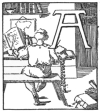 LL book-plates which do not have the flavor of age
about them, and which were made quite within the memory of the
collector, are classed as recent plates. This is a term of doubtful
application; but in a general way it has come to mean all plates made
since about 1830. Their number is legion, of course, and no attempt is
here made to enumerate them, or even a small part of them, but only to
note briefly those of the more recent additions which are especially
noteworthy. And now we part with the old styles of plates. The early
armorial, with the profuse denticulated mantling, is never used, the
pure Jacobean is not seen, the graceful Chippendale has been discarded,
and the Ribbon and Wreath, with its fanciful festoons and garlands of
roses, is also a thing of the past.
LL book-plates which do not have the flavor of age
about them, and which were made quite within the memory of the
collector, are classed as recent plates. This is a term of doubtful
application; but in a general way it has come to mean all plates made
since about 1830. Their number is legion, of course, and no attempt is
here made to enumerate them, or even a small part of them, but only to
note briefly those of the more recent additions which are especially
noteworthy. And now we part with the old styles of plates. The early
armorial, with the profuse denticulated mantling, is never used, the
pure Jacobean is not seen, the graceful Chippendale has been discarded,
and the Ribbon and Wreath, with its fanciful festoons and garlands of
roses, is also a thing of the past.
This is of course natural, as the armorial plates, which are the only
ones demanding any of these styles of decoration, are very little used
now. But we have still the Library Interior, the Literary, the
Pictorial, and the Allegorical; but these have changed their appearance
so much{341}
as to be hardly recognizable as the lineal descendants of those of the
same type which went before. Indeed, the recent plates have little in
common with the old,—new motives, new designs, new methods, and new
conceptions of what a book-plate can be have come in, and the change
produced is very marked.
Heraldic plates are still in use, and still being made, but the number
of plain armorials is quite small. Usually, now, those who wish to show
the family arms on the book-plate do not display it all by itself, but
accompanied by literary accessories, or pictorial, or with decorative
features to relieve what would to-day appear a bare and unfinished
plate, but which in the older days would have been the pink of
perfection.
Among the plain armorial plates of recent days may be mentioned that of
Henry B. Anthony, the late senator from Rhode Island, which, without
even a motto, presents the arms of the family, with the crest, and the
name. Another plain armorial plate is that of John H. Buck, of the
Gorham Manufacturing Company, and the author of “Old Plate.” This, too,
is perfectly plain, with no motto. Frank House Baer and Charles W.
Burrows, of Cleveland, both use the plain armorial style, relieved by
slight mantling or scroll work, and with the mottoes on ribbons beneath
the shield. Mr. Appleton Morgan has a plain armorial plate, quartering
the Morgan and Appleton arms. Mr. Daniel Ravenel, of Charleston, also
uses a plain armorial shield, relieved with sprays of marigold (the
Huguenot{342} emblem) and of wall-flower (the French name for which is
Ravenelle). A plain armorial plate, in colors, is used by the compiler
of “America Heraldica.” An imposing helmet with blue mantling surmounts
the shield, and the motto, Moins faire mieux faire, is given on a
ribbon which encloses the whole design. Harry Allen Castle, of
Hartford, uses a design borrowed from the plate of Mr. Thomas Bailey
Aldrich. The castle on its wreath is enclosed by a square frame in which
the name appears, with the words His Mark. In the corners of this
frame are the letters I.H.S.V., standing for the motto, In hoc signo
vinces. A punning friend, upon seeing this plate, remarked to Mr.
Castle, that the letters would seem to mean, “I have some volumes.” Dr.
J. S. H. Fogg, the late well-known collector of, and authority on,
autographs, used a plain armorial plate, with the motto, Aut pax aut
bellum. Prof. J. Max Hark, of the Moravian Seminary at Bethlehem,
Pa., has a plain heraldic plate, with thin mantling about the shield.
The motto occupies two lines above and below the shield, and is in
imitation of the ancient manner. What mon an Honeste Namen
doth owen, Too hym rycht glaedlie myn Bookes
i loan. But so too longen ye Bookes be kepit, He
shal forsooth be a Knave yclepit. This is printed with red
capitals, on very fine parchment paper with rough edges, and is a very
pretty plate. Dr. Joseph Henry Dubbs, professor in Franklin and
Marshall College, uses a plate which exhibits the arms on a shield which
is fastened to a spreading oak-tree.{343}

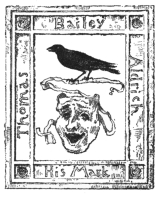
{344}


At either side, scrolls are drawn, which bear the motto, Ex recto
decus, and the following dates, which refer to the migrations of the
doctor’s ancestors: Styria, 1446; Helvetia, 1531; America, 1732. A
plate of unique history is that of The Rawle Law Offices, Established
A.D. 1783, Philadelphia. This inscription is given on a circular band
which encloses the shield of arms, and the motto, Morte, Virtute.
Below this, the name of the successive proprietors of the law-offices
are given, as follows: William Rawle, 1783-1836, William Rawle,
1810-1858, William Henry Rawle, 1844-1889, William Brooke Rawle,
1867. Melvin H. Hapgood, of Hartford, uses an oblong plate, which
exhibits the shield of arms at the left of the name space, and which is
surrounded by a fine running vine which bears both fruit and flowers,
and among the twistings of which the motto, Inter folia fructus, is
woven. The implements of the architect, and the secondary motto, Penna
ferro potentior, are also cleverly worked into the decorative frame.
Monsignor Seton, D.D., of Jersey City Heights, uses a{345}

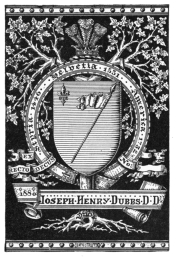
{346}
small heraldic plate, in which the arms are given in colors, and are
surmounted by the clerical hat and tassels. A plain armorial plate is
used by John F. Winslow, a descendant of Governor Winslow, and one to
whose means and energy we owe the building of the first “Monitor.” Prof.
Charles Eliot Norton, of Harvard, uses an heraldic plate, in which the
crest only is given. Beneath this, a pile of books is covered by a
scroll, which bears upon it the motto, Amici et amicis. The Rev.
Morgan Dix, of Trinity Church, New York City, uses an heraldic plate,
in which also the crest only is given. This is surrounded by a circular
garter, on which the motto, Quod dixi factum est, is printed. This
ends our list of plain armorial plates.
Whatever sarcasm and disgust may be stirred up by the assumption of arms
by persons not entitled to them, no word can be said against the display
of authenticated arms upon the book-plate. Many coats-of-arms run back
for several centuries, and an honored ancestry has borne them. A
rightful pride in such memorials of past family history induces many who
are entitled to them to use their arms thus; and while the plain
armorial plate has had its day, and has passed the stage of wide
popularity, it is still in use.
Coming, now, to the Library Interior style of book-plates, we mention
first the finest example of recent work in this style,—the plate of
Richard C. Lichtenstein, of Boston. Mr. Lichtenstein is one of the old
collectors of plates, a member of{347} the Council of the Ex Libris Society
of London, and a recognized authority upon American plates. As we would
expect, he has indicated his hobby in all details of his design. The
scene is laid in the corner of the owner’s den, in which are well-filled
shelves, framed prints, photographs, and the usual accessories. In the
immediate foreground, a Cupid is seated at a desk, and in his
outstretched hand holds a plate upon the globe which stands at hand,
while he reads, from an open book, the description, presumably, of the
treasure lately acquired. Two other Cupids are at his back: one bearing
the Journal of the Ex Libris Society, and the other returning from a
successful quest for plates, if we may judge by the packet under his
arm. The presence of the globe indicates the cosmopolitan character of
the collection the Cupids are examining and adding to. A finely foliated
border surrounds the interior picture; and in a space at the right side
is a package of mounted plates; and on the left, a tied-up bunch of
book-covers, in which Mr. Lichtenstein keeps his plates. The name
appears in white letters upon a black scroll at the bottom, and behind
it is seen a castle of white stone,—a play on the name of the owner.
The plate is dated 1893, and is signed by the engraver, George Moore,
and the designer, L. Y. Van Tiffele.
The plate of James Phinney Baxter reveals a most pleasing interior,
which is probably from the actual room. A tall clock is flanked by long
rows of books, a table and easy-chair are in the{348}
{349}
foreground, and bric-à-brac is disposed upon convenient shelving. At
the left of the picture, a portrait of the owner is given, with a
fac-simile of his autograph. The following motto, Who learns and learns
but does not what he knows, Is one who plows and plows but never sows,
is also given in fac-simile of handwriting.
The plate of William Vanamee shows what is also an actual interior,
probably. The stairs enter the room at the left, and the space under
them is occupied by books. Pictures adorn the walls, and a cosey bench
before the shelves invites the visitor to recline and read. The motto,
Carpe diem, is given above the picture, and the name below, both in
fac-simile of handwriting.
Actual comfort and enjoyment are expressed in the plate of Louis J.
Haber, of New York City. In this interior, a fire is blazing on the
andirons; the drowsy dog lies asleep before it; the hanging lamp sheds a
brilliant light over the room, and furnishes the means of reading which
the owner is enjoying, as he sits in an easy chair, in lounging-coat and
slippers. The rows of books at the far end of the room add to the effect
of comfort, and the motto which envelopes the whole design—My silent
but faithful friends are they—discloses the attitude of the owner
towards his volumes.
The plate of Albert C. Bates, of the Connecticut Historical Society,
at Hartford, is a reproduction of an early woodcut which represents the
interior of an old library (University of Leyden, 1614), with long rows
of books chained to their{350} desks. Globes are protected by brass covers,
the patrons salute each other in apparent silence, and over all there is
an air of repression and elevated learning. No seats are provided, and
light is admitted through long windows filled with small lozenge-shaped
panes of glass.
The beautiful colored plate of Gerald E. Hart, of Montreal, represents
the interior of a cell in some mediæval monastery; for the tonsured monk
is sitting upon his stone bench, illuminating a large volume. The Gothic
window admits light through its highly colored design, and rows of
vellum lie beside the desk of the old monk.
The plate of W. E. Baillie, of Bridgeport, Conn., represents a corner
of a modern library, furnished in the Louis XV. style, having some
half-dozen frolicsome Cupids, rolling on the rugs, peeking out of the
window, reading in arm-chairs, or discussing the volumes taken from the
elaborately carved case. This plate is the second one{351} to make use of
the half-tone process direct from the pencil sketch.
Continuing with the plates which come properly under the classification
“Literary,” we find them to be very numerous, very various in design,
and very unlike in shape and treatment. A plate which represents the
past is used by Henry M. Brooks, of Salem, Mass. In this the old
ink-pot and quill, the box of wafers, the wax and seal, and the sand for
blotting are disposed about the letter, which, being used before the
days of postage stamps and envelopes, bears the amount due and the
address upon the back of the sheet. The address seen is that of the
owner.

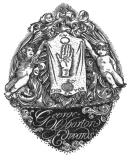
Going still further back in history E. Irenæus Stevenson has brought
the very serpent of the{352} Garden of Eden, with the fatal apple of
Knowledge in his fangs, into his book-plate. Slipping down between the
open pages of a large book, we see this form of his Satanic Majesty, and
read upon the apple which he offers Eritis sicut Deus, Ye shall be as
gods. This, from the Vulgate, is in Latin. Upon the open page we read
in Greek, Be ye wise as serpents. The Shekinah blazes out all about
the book. A very interesting and striking plate.
A very simple but effective reminder of the approach of old age is found
in the plate of George Alexander Macbeth, of Pittsburgh, Pa. In this,
an open book of coarse print lies upon the table, accompanied by a large
pair of spectacles. The motto appears in the upper left corner,—Give
me your favor: my dull brain was wrought with things forgotten.
Very many plates have a shelf of books, or a pile of them, accompanied
with a favorite quotation, a bust of some author, the arms of the owner,
or possibly his portrait. In the plate of Clifford Julius King, we see
the row of books, the smoke from the waning cigar, as it rises across
the open pages of a book, and the bust of Thackeray, while the motto, A
jollie goode booke, whereon to looke, is better to me than golde, is
suggestive of long evenings by the fireside, with choice editions to
read and fondle.
The shelf of books in the plate of Nathaniel Paine, of Worcester,
Mass., is enclosed within a frame which has suggestions of the heraldic
shield. Behind it the palm branches are placed,{353}
and the motto is below, on a ribbon,—Duce natura sequor. The crest is
found in its place above.
“Wrenwood” is the name of the home of George E. Leighton, if we may
judge by the name which appears on the top of the shield, which rests
against his books just inside the library window. The window is open,
flowers peek around the mullions, and a wren has hopped upon the sill to
examine the surroundings which have borrowed his name for their own.
A pile of three books, labelled Bacon, Lamb, and “Punch,” is shown
in the plate of David Murray. The legend, Some books are to be
tasted, some to be swallowed, and some to be chewed and digested, is
given on the back of the books. Above the volumes, the scales carrying
the heavy pen on one side, and the lighter sword on the other, is
surmounted by a liberty-cap, behind which, in a blaze of glory, appears
the motto, The pen mightier than the sword.
In the plate of George Imbrie Sill, three shelves of books are
enclosed within a frame of scrolls which bear the name. A shield is
placed across one end of the case, with the arms and crest upon it.
Now we come to a plate which takes us below the surface. A wondrous
mermaid, at the very depths, flanked by huge dolphins, is receiving a
perfect shower of books, which come tumbling down through the water.
This is the plate of H. W. Bryant, of Portland, Me.
Marshall C. Lefferts, of New York City, uses small leather labels on
which an open book bearing{354} his monogram is stamped in gold. Different
colors of leather are provided for different volumes. This is the only
instance of the use of leather for a book-plate in this country, if I
mistake not: a very handsome material, too, for the purpose, and
meriting wider use.
In the plate of John Herbert Corning, of Washington, Atlas, with
strained muscles, supports the world of letters. Litterae is inscribed
upon the immense globe which rests upon his shoulders.
Two children of the forest, a boy and a girl, with flowing hair and
meagre garments, come{355} towards us in the plate of A. L. Hollingsworth,
of Boston, bearing between them a panel on which is carved the motto Un
bon livre est un bon ami. The dense forest is close behind them, and
were it not for the reader, one feels as if no person would pass their
way to see their lofty sentiment. So thick, indeed, is the tangle of
brush, that the loss of their clothes must be laid to their passage
through it.
In the plate of Dr. George L. Parmelee, of Hartford, a herald in court
costume is proclaiming, through his long trumpet, the loss of a book.
The banner hanging from the horn shows the words he uses: Verloren!
Verloren! ein Buch.{356}
We are again taken far down below the waves, in the plate of William
Ashmead Courtenay, of Charleston, S.C. Down indeed, to the very bottom
of the ocean, where the weeds grow, and the dolphin feeds. Above, the
waves are rolling, and a far stretch of water is seen. The view is
enclosed within a square frame which bears the name.
The Rev. Wm. R. Huntington, rector of Grace Church, New York City,
uses a design which is adapted from a frontispiece by Walter Crane for
the “Fairy Tales” of the Brothers Grimm, and which represents a youth,
with long curls falling from under his cap, opening the door of a house,
with a huge key. Upon the roof, two cupids, in imminent danger of
sliding off, are making music with lyre and voice. A few stars shine
against the night, and the light of the moon falls across the face of
the structure, revealing the huge orange-trees in fruit, which flank the
doorway. The motto, In veritate victoria, is carved upon the steps,
and the name Huntington is given at the very top of the design.
Other plates whose principal features are “bookish” are those of Henry
A. Morgan, which has simply a large book, open, with blank leaves: on
one is inscribed The page in waiting; of Edward Denham, which has an
owl perched upon an open volume, upon whose pages are the following
names, Bede, Camden, Bradford, Chaucer, Shakspere, Sandys,
with the torch of knowledge and the wreath of victory behind it: the
wreath is tied with a ribbon which bears the
{357}
motto—Nulla dies sine linea: of Charles F. Jilson, Chicago, on
whose plate simply a closed book is seen, with a palette resting upon
it; the brush and the drawing tools reveal the art of the owner, while
the half-covered lyre upon the book-cover may be an indication of his
hobby;—of Alfred Trumble, of New York City, who displays a table
whereon the bust of Minerva, the student-lamp, the scroll, ink-stand and
quill, and the books jostle each other in delightful literary
confusion;—of the Hon. John E. Russell, of Boston, who shows the owl
of Minerva seated upon the books of the scholar: the globe, materials
for writing, and the lamp of knowledge are disposed about, and the whole
is encircled by an oval wreath of holly.
The plate of Thomas J. McKee, of New York City, represents a volume of
Shakespeare’s Works, open to the title-page, which is occupied
principally by a portrait of the famous author playwright. The arms and
name appear upon the fly-leaf of the book, other books are at hand, and
the following lines are given at the foot:—
Tu mihi currarum requies, tu nocte rel atra
Lumen, et in solis tu mihi turba locis.
The plate of Paul Lemperly, of Cleveland, designed by Garrett, shows
the open book, with the serpent circled about it. The stars shine
beyond, and the design is enclosed within a rectangular border of holly
leaves.
Another class of plates which claim attention to-day is that which is
representative of either the hobby or the vocation of the owner. For{358}
special collections, for certain kinds of books, plates are designed
which express the particular line of reading, or of collecting, which
they are to ornament. This style of plate is coming more and more into
use, and earnest pleas have been put forth for its wide adoption;
notably, one by Henri Pene Du Bois, in the “Book Lovers’ Almanac,” for
1894. In his worthy article on the “Art of the Book-plate,” this writer
argues forcibly for the expression of a genuine idea in the book-plate.
Not mere coats-of-arms, crests, pictorial designs or devices and
ornaments which look pretty, seem to him suitable for use as
book-plates, but an emphatic representation of an idea, a worthy idea,
clad in suitable form. He argues for special plates for special
collections, for a specific plate for a specific line of books; not an
ornamental label simply, to be placed in each book in one’s library, but
a different plate, with a reason for its existence, in each different
department. Very few, if any, in this country, carry the idea so far;
but many plates are now in use which convey at once an idea of the
pursuit of the owner, whether it be in literature, art, science, or
professional life. The plate of George Edward Sears, with its grinning
skull, is perhaps at first glance unpleasant in its effect, but when one
comes to unravel the plain meaning of the symbolism, the shudder dies
away, and we are prepared to regard the plate as one of the very highest
types, and most successful in its way. Mr. Sears has gathered a large
collection of books relating to the “Dance of Death,” and finding in{359}

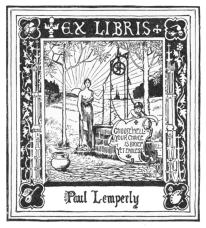
{360}
a 1754 edition of Matthew Merian’s work, this plate which seemed no part
of the series but an impromptu addition, he adopted it for his
book-plate. Mr. W. J. Linton engraved the block, reducing considerably
from the original. This plate is used only in the books relating to the
topic it suggests. In this plate the skull is placed upon an open book,
between a lighted candle and a few flowers in a vase. A wreath encircles
the smooth pate, and an hour-glass rests upon it, with the hovering
wings of Time, and the scales, just above. The lower half of the plate
has a very dark background, while the upper is filled with light.
Henry Blackwell, of New York City, uses a plate in his collection of
Welshiana which was designed for the purpose. In this plate we see the
sturdy oak raised in the centre of the scene. Upon the right side, the
bearded Druid is lopping off the branches of the mistletoe, which seem
to be growing with the oak. Opposite to him, the early Briton with his
harp makes wild music. A circular medallion upon the tree represents the
peak of Snowden, the highest mountain in Wales, and the motto, Cared
doeth yr encilion, is given upon the frame. This plate, like that of
Mr. Sears, was suggested by an illustration in an old book. A second
plate is used for the literature upon the famous voyage of Madoc to our
shores in A.D. 1170. In this plate we see the old-fashioned, high-sided
ship, with its bellying sails, plunging through the rolling waves, as it
passes out to sea with the hardy adventurer and his crew.{361}



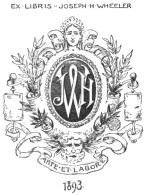
As examples of plates representative of the hobby of their owners, we
have the following: Dean Sage; an angling plate, very simple in design
and very fine in execution, with a large trout, and the rod and the
landing net crossed behind it: an enthusiastic fisherman, and the author
of a sumptuous volume on salmon-fishing in some of the Canadian rivers,
Mr. Sage uses this plate only in the books of his library which relate
to the gentle pursuit favored of Walton;—Howland; An angling plate of
very handsome design: the shield of arms is surrounded{362} with the
implements of the fisherman, with evidences of his success and with the
weeds which grow by the water side: the motto Piscator non solum
piscator floats on a ribbon above;—Lucius Poole; the masks of Comedy
and of Tragedy are brought together in this plate, as indicative of the
books collected by Mr. Poole;—Arthur Robinson Stone: a folio volume
of music is open to the Largo of the second part of the “Messiah,” by
Handel, and is copied from the original score preserved in the British
Museum:—in the plate of Martin Hayden two Cupids bear a shield on
which the name is given: each little Cupid also manages to hold a mask:
the motto, Upward, Onward.
Fred C. Schlaick: in this we see the uppermost part of a column and
its Corinthian capital. A little Cupid flies away from the finished
piece of work, carrying the veil which had concealed it from view. This
design hardly needs the word Architect, which is added just after the
name, to express the profession of the owner.
Edward Stratton Holloway: in this design, the owl is perched upon a
limb, with the palette, brushes, sketch-book, and pencils of the
illustrator within his clutch.
A most happy plate is that of Mr. Richard Hoe Lawrence, which is
designed for use only in the library housed at his country seat,
“Oscaleta Lodge,” and which is mainly botanical. In this plate the
partridge-vine, Mitchella repens, is shown in its proper colors, and
is surrounded by a double border of red lines, within which the motto,
from{363}
Rabelais, Fay ce que vouldras, is given in yellow. The plate was
designed by Miss Mary S. Lawrence.
For a Philatelical library, the plate of Mr. John K. Tiffany is
exceedingly appropriate, the design being enlarged from the old and rare
St. Louis Postmaster’s stamp of 1845. The book-plate was cut on wood by
the same man who designed the original stamp. It is an exact fac-simile
of the old stamp, giving the two bears holding between them the circular
frame which encloses the arms.
A very good example of the Allegorical book-plate is that of George H.
Ellwanger, of Rochester. This is designed to illustrate the LXX sonnet
of the Amoretti, of Spenser. With all the charming freshness of the
early vernal season about her, we see Spring, in graceful drapery,
carrying buds and blossoms in her hands, and crowned with a wreath of
flowers, approaching us. The garlands, the numerous birds, the new
leaves upon the trees, and the sense of warmth in the scene, clearly
depict the meaning of the artist.
Turning, now, to the pictorial plates, we find their number rather
small. Decorative features, bits of landscape and of interiors are found
in many plates; but these little ornamentations do not constitute a real
pictorial plate. One of the finest examples is the plate of E. G.
Asay, of Chicago. In this we find ourselves intruding upon the councils
of the Muses; for we see Art seated upon a throne, with the palette and
brushes idle in her lap, while about her, in graceful manner, recline
History, Music, and Literature.{364} The lyre of Music is quiet, as, with
her hand affectionately placed upon the shoulder of History, she listens
to the reading of the just-inscribed record. Art likewise gives
interested attention to the recital; and Literature, with her book
closed, leans upon the convenient globe, and listens.
Wholly different is the plate of Allen Wallace. In this, one of the
Naiadæ reclines upon the{365}
over-turned urn, from which the never-ceasing flow of water falls over
the rock, and slips away in a widening stream. With one hand she
caresses the limpid flow, as it emerges from the urn. At either side,
below her, two dolphins discharge quantities of water from their mouths
into an immense shell which receives the stream from the urn as well.
Tall sheaves of wheat rise above them, and directly behind the head of
the Naiad is the motto, Nil clarius aquis.
Mr. H. E. Deats, of Flemington, N.J., has a most beautiful specimen of
steel engraving which he uses in his numismatic library. In this, we see
a female figure clad in classic costume, with a diadem on her brow,
sitting on the clouds, and having at her side an oval shield, on which a
very important peacock is depicted as using the globe for his perch. On
either side, cornucopiæ of fruit and flowers barely hold their
quantities of produce. The motto, Instauratio saeculi felicis, is
placed upon the edge of the shield.
The plate of Frances Louise and Charles Dexter Allen represents a
female figure in classic robes seated upon a stone bench at the foot of
tall trees. It is twilight, and the glint of the weakening light is seen
through the leaves. Books, manuscript, and scrolls are strewn around the
solitary figure. The motto, Sapientiam veram petimus, is carved along
the top of the wall behind. One arm of the figure is thrown across the
top of an open book, on which the names of the owners are given. This
plate was suppressed at the request of the publishers of a magazine in{366}
New York City, as it so closely resembled the design on their cover.

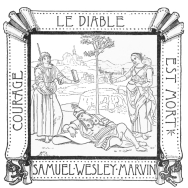
A very effective plate is that of F. W. Hoyt, of Albany, N.Y. In this
an Ionic column forms the whole design. Very beautifully engraved: the
lamp of Knowledge is continually burning, and continually fed on the top
of the capital, while the names of the “Immortals” are bound around the
shaft on a ribbon,—Homer, Dante, Cervantes, Shakespeare,
Shelley. The name of the owner is carved upon the base.
In the plate of Samuel Wesley Marvin, is depicted the sleeping knight,
to whom come{367}
Pleasure and Knowledge, each with her offer of satisfaction and reward.
The motto, Courage le diable est mort, is seen on the broad ribbon
which is laid about the picture.
The plate of Adam Van Allen, of Albany, is copied from the plate of
the brothers Goncourt, and represents the left hand with a pair of
dividers held by the third and fourth fingers, while the first and
second are placed upon a sheet of paper bearing the initials V A.
Several peculiar plates remain to be mentioned, which belong to no
style, but are examples of the individual taste of the owners, which is
now so marked a feature of book-plate designing. Not, as formerly, are
we controlled as to the style which we shall adopt, but each book-lover
can,{368} without appearing eccentric, place whatever design he chooses
within his book-covers.
The plate of the well-known litterateur, W. Irving Way, of Chicago,
is simply a very small bit of paper with his initials in cipher upon it.
The plate of Fred J. Libbie, of Boston, one of the largest collectors
of plates, is a cryptogrammic arrangement of the letters forming his
name.
An old plate of Richard Hoe Lawrence caricatures each of his three
names: the first, by the “dickey bird”; the second, by the agricultural
implement suggested by the middle name: and the third, by a picture of
the emaciated Saint Lawrence frying over a fire of flaming fagots. As he
fries, he reads from a book entitled, Lawrence on Gridiron.
The plate of Marcus Benjamin, of New York City, is a punning plate,
and represents the gentleman himself riding his hobby-horse, which is in
the form of a big folio. With a long quill for a lance, and wearing a
crucible for a hat, he rides his horse, full merrily. The plate of J.
Hiestand Hartman, of Lancaster, Pa., is very curious. In this, the
shield is borne by a skeleton, who stands erect, with the lance resting
in the right arm. A banner floats from the lance-head, ribbons rise in
profusion on either side, and the grinning sentinel is enclosed in the
fluttering ends. E. A. Hitchcock, of the United States Army, has a
plate of peculiar and hidden meaning. In this, the prominent feature is
a huge dragon, winged, scaly, with forked tail and snakelike head. With
the end of his tail in his mouth, he forms a frame of{369} oval form, and
repulsive kind, for a picture of a little girl, who seems to be sitting
upon a honeycomb, and who holds a necklace in her left hand. The motto,
Non nisi Parvulis, must contain some reference to the event recorded
in the book-plate.

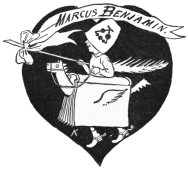
The plate of George Dudley Seymour has the unusual feature of a large
representation of an old door, with its carved posts, and pediment of
high-boy style. In the centre of the design, above this, at the right, a
small view is given of the whole house from which the door is taken, and
in the opposite corner a scroll bears the words: Captain Charles
Churchill, hys house at Weathersfield in the Colony of Connecticut in
Newe England, 1754-1885. This plate is by{370} W. F. Hopson, of New Haven,
Conn., and is very effective. Mr. Hopson’s own plate is also a very
beautiful specimen of his skill. In this, the central panel is filled
with three old folios in aged condition, tumbled together upon the
table. In the upper corners, a press for plate work and a painting on an
easel are seen. Below the central space, a closed portfolio affords
space for the record of the number of the volume. About all, are
elaborate scrolls of rustic design. Over the space, a small kettle holds
a number of fine brushes, and the motto is on a ribbon which is well
carried through the scrolled sides. The motto is an adaptation of one of
older date, and reads as follows: Old books to read, old prints to
scan, old wood to carve, old friends to greet.
As yet, we have but one example of the work of C. W. Sherborn, the
celebrated engraver, of London, among our American book-plates. This is
the beautiful plate of Mr. S. P. Avery, of New York City. This is not
heraldic, but of a decidedly personal bent, and very indicative of the
special lines of collecting to which the owner is devoted. The upper
part of the plate is filled with a conventionalized tulip design, which
is extremely rich in appearance and graceful in disposition. A ribbon
bearing the name, Samuel Putnam Avery, flutters in and out among the
curves of the tulip stems and leaves. Grouped at the lower edge of the
plate are a number of books, in artistic bindings, one being noticeable
as having a Grolieresque design. The titles of most of the books can be
read, and among them{371}

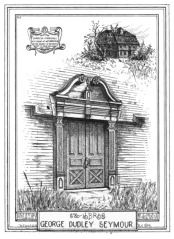
are De Bury, Shakespeare, Goethe, Emerson, Montaigne, Ruskin, Bewick,
and Washington Irving. Rembrandt’s “Three Trees,” also found among the
accessories at the foot, is indicative of the collector of etchings. The
graver, eye-piece, cushion, and block on which the portrait of
Washington is cut, denote the art of engraving, and the head of Minerva,
which rests proudly upon the volume of Ruskin, represents the patron of
Art. This plate is a fine example of the peculiar personal flavor which
Sherborn has infused into his revival of this particular kind of German
work. The grouping of the books at the bottom is excellent, and the
graceful sweeps of the tulip pattern, as it fills the upper two-thirds
of the plate, are very pleasing. The motto, Far more seemly were it for
thee to have thy Study full of Bookes than thy purse full of money
(Lilly), is placed beneath the design.
Two specimens of the work of Paul Avril, for American owners, are of
exceeding daintiness and delicacy in design and execution. The plate of
Clarence H. Clark represents Venus in gauzy drapery, with a
looking-glass in her hand, reclining upon a pile of books, some of which
are closed. A fragment of the scroll of a Chippendale frame, with one or
two roses about, complete the decoration. The motto, Amat victoria
curam, is seen upon the open page of a folio volume. The plate is very
light and pretty.
In the plate of George B. De Forest, by the same artist, we are
ushered into the library of the owner. Here a cherub draws back the
curtain,{372} and affords a view of the treasures upon the well-filled
shelves, not only to the beholder, but also to a scantily clad female
who, with one foot upon the step of the shelf-ladder, appears to halt in
an ecstasy of delight. An open book on the floor, and a portfolio
standing near the shelves, complete the accessories. The whole is
surrounded by a frame of foliated scrolls.
In the plates of Dr. Henry C. Eno we have examples of the owner’s
personal skill as an etcher. In one design, a lighted candle is placed
upon a closed book, which is labelled Ex Libris Volume, and is
presumably filled with rare treasures among our very early American
plates. The second plate represents a lighthouse, with rolling waves at
its foot. The broad bands of light stream from the lighted lantern,
across the black night. The scene is enclosed within a circular frame.
This is set upon a background, which may represent a fish-net, and is
finally enclosed by a border of rope. A bit of rope tied in a sailor’s
knot lies under the lighthouse picture, and supports the name, Ex
Libris H. C. Eno.
Among collectors, there has been of recent years a strong desire to
secure specimens of the plates of the ladies. In England, where the
heraldic features of a lady’s plate are required to be in some respects
very different from those of the gentleman, they may be said to
constitute a class by themselves. But with us, while of equal interest,
they do not show any marked difference in their design from the
gentlemen’s. Indeed,{373} most of them, if not all, would serve just as well
for one as for the other. The plate of Charlotte Cushman, which is
heraldic, is incorrect, if judged by the rules of the art. The arms are
not in a lozenge, the crest is given, and the motto is displayed. But
the plate has none the less a deep interest to the American collector,
who indeed can well afford to overlook any trifling irregularities which
may be pointed out by a student of a science not in vogue with us.
Habeo pro jus fasque is the motto on the plate. Two other heraldic
plates are now used by American ladies. The plate of Mrs. E. H. L.
Barker, of Warren, R.I., is designed by Mr. J. McN. Stauffer, and is
heraldically correct, in that no crest is given, and that the frame
enclosing the arms is of the required form. However, the motto is given,
and the animal of the crest is made to do service as a supporter of the
rod on which the shield rests. The plate is small, and very neat in
appearance. The plate of Miss Jessie Brewster, of Shelton, Conn., is a
plain armorial, displaying the arms claimed by the descendants of Elder
William Brewster of Massachusetts. Another Rhode Island plate, and one
which is representative of the hobbies of the owner, is that of Mrs.
Alonzo Flint, of Providence. This is a large plate, in the centre of
which is an arrow-head of flint, in reference to the name of the owner.
In the corners are displayed books, easel and palette, violin, music and
‘cello, and two cathedral spires,—all indicative of the likings and
pursuits of the user of the plate. A wreath of ragged chrysanthemums{374}
and ivy leaves surrounds the central design, on which a beehive is
placed, among hollyhocks. This is, as was intended, a plate whose every
part is illustrative of the interests of the owner, who was also its
designer.

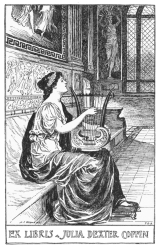
The plate of Mrs. Julia Dexter Coffin, of Windsor Locks, Conn., was
designed and is used wholly{375} for books of music, or in her library of
musical literature. The scene is within the choir of some temple. A
flood of light enters the lofty apartment from the open door at the far
end of the wall, and the small diamond panes of the large window reveal
nothing of the outside world. Seated upon the stone bench, in the
foreground, clad in classic robes, a member of the chorus, inspired by
some longing, has come alone, to pour forth her feelings in song. The
lyre in her hands is of old and ornamental design. Behind her, upon the
wall, runs a dado on which the sacred dance is pictured; and above this
a large mural painting can be seen. In the niche by the door stands a
statue of Terpischore. The sound of the music seems to fill the room.
Purely decorative, and having no particular meaning beyond illustrating
the motto, is the plate of Ophelia Fowler Duhme. The motto, Inter
folia fructas, is given at the top of the plate, and the strawberry
plant, bearing both flower and fruit, fills the whole space below.
Two Cupids disport themselves among sweet roses, in the plate of
Frances Louise Allen.
In the plate of Margaret M. Miller, a cherub, with the hair in a
Psyche knot, sits upon a closed book, and inscribes the names of the
“Immortals” upon a scroll.
In the plate of Miss Ada Stewart Shelton, of Derby, Conn., the motto,
Plus penser que dire, is given with the name and a single pansy
blossom within a rectangular frame which has pansies at each corner.{376}
In the plate of Mary Bayliss, we have a frame of Chippendale tendency.
The scrolls are edged with shell-work, and the flowers are free and
natural.
Very interesting and successful work in designing and engraving
book-plates is now being done by Mr. E. D. French, of New York City, Mr.
E. H. Garrett, of Winchester, Mass., and by Mr. W. F. Hopson, of New
Haven, Conn., all of whom are represented in this volume by prints from
the original coppers.
{377}
AMERICAN COLLECTORS AND COLLECTIONS.
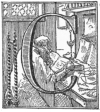 OLLECTORS of book-plates are not very numerous in the
United States; but, small as their number is, it has reached the present
figure almost at a bound, for we now count about seventy, who are
collecting, while, four years ago, there were scarcely a score.
OLLECTORS of book-plates are not very numerous in the
United States; but, small as their number is, it has reached the present
figure almost at a bound, for we now count about seventy, who are
collecting, while, four years ago, there were scarcely a score.
A survey of our collections shows that all are particularly interested
to collect American plates. The early American examples are few, and
daily becoming scarcer, as the search for them grows hotter, and the
competition between prospective owners increases.
The scarcity and value of our early specimens are not appreciated fully
by our brother-collectors over the sea, nor is our national pride in
keeping them within our borders realized. Having so few, we cannot be
lavish with the rare examples we are able to find; and so it comes about
that the demand for our plates is not met as it once was. The
book-plates of our ancestors are not so easily found as are those of the
past generation in the older countries. Books were fewer here,{378}
devastation by fire and pillage has ruined much that we lament over, and
the good old plates turn up but rarely now.
Our collections are not large as compared with the gigantic aggregations
which we hear of as being made in England. Think of one collector having
one hundred thousand specimens! The largest collection here will not
exceed six thousand, and those next nearest to that fall some two
thousand behind it. Our collections are good, representative of the best
foreign styles and dates, and do not include much that is valueless.
“Small, if need be, in numbers, but excellent in quality,” would seem to
be the maxim of those who collect over here. German plates, particularly
of the oldest engravers, French plates, and the English plates of men of
prominence, are well represented. Plain heraldic plates are not held in
high esteem, while the Pictorial, Literary, Library Interior, and
Ladies’ plates are all sought for.
Among the very first to enter the field as a collector of book-plates in
the United States was the late James Eddy Mauran, of Newport, R.I.
Mr. Mauran was a New Yorker by birth, the son of a West India merchant.
He was a painstaking collector, a close student, and a man fully
acquainted with the foreign languages, and the literature of the times
he felt an especial interest in. While deeply interested in other lines
of research and collecting, he found time to gather a good collection of
American and foreign book-plates, which were mounted with the nicety and
taste shown in all branches of his collecting.{379}
At the time of his death, in 1888, he had about 3500 plates in all, and
they were appraised by Mr. Hewins, a friend of Mr. Mauran, at three
hundred dollars, and were sold to a Philadelphia gentleman. Mr. Mauran
had a way of mounting his plates which was original and unique. He
pasted them down on pieces of marbled paper, and other kinds of paper
used in the ornamental binding of books. He was at pains to obtain from
binders, stationers, and booksellers all the pieces of paper of this
kind that could be found, in order to have as many different mounts as
possible. These papers were all mounted on stiffer white paper, and
formed a good substantial ground for the final mounting.
His titled plates were mounted on gold and silver paper; and the ladies’
plates on bits of silk, damask, satin, or old pieces of brocade and
other things pertaining to ladies’ wear. The American plates were
mounted on the older styles of marbled papers, and on fancy patterns and
colors in use years ago. They were numbered on the back, and were kept
in alphabetical order. Very often the back of the mount was covered with
notes about the owner of the plate. Portraits, autographs, views of
houses, and sketches of the owners from newspapers, were also mounted
and placed with the plate they were identified with. The plates were
kept in old book-covers of fine, polished calf, beautifully tooled on
the back and edges. An interesting history is connected with these
covers. Mr. John Austin Stevens, of New York, had made a fine collection
of the poetry,{380} ballads, and romances of the mediæval ages, which was
bound in the sumptuous style mentioned. Upon the occasion of a visit to
Europe, Mr. Mauran, who was a friend of Mr. Stevens, saw them carefully
packed in boxes, which were deposited in the vaults of the Chamber of
Commerce building in New York, and insured for ten thousand dollars.
During the absence of the owner, the negro janitor of the building broke
open the boxes, and, tearing out the insides of the treasured volumes,
sold them for waste paper! Portions were recovered; but the covers were
of no further use as originally intended, and they fell to Mr. Mauran,
who used them to hold his book-plates. This collection was quite rich in
the early plates of America; for Mr. Mauran, being well-nigh the first
in the field, had the cream of collecting for some time, and was able to
secure plates which now are not to be had.
Not very long ago, this collection changed hands again, as the first
purchaser, having no time to make use of the plates, was willing to sell
them to some collector who could make them of greater use among others
interested in the same topic. In some way the collection became
disrupted, and parts of it are owned by different collectors.
Mr. E. N. Hewins is one of the older collectors among us. Mr. Hewins has
a very interesting album of American plates, in which a goodly number of
the rarer specimens find a resting-place. Other albums are used for the
foreign examples, and the number of plates in the collection places it
well up towards the head of the{381} list of large and valuable collections.
The plates are classified by styles.
Mr. Richard C. Lichtenstein, of Boston, has a large collection of
book-plates. A part of his collection is arranged alphabetically in a
large quarto bound in brown morocco, with gold tooling, and made
especially for the purpose with leaves of very thin tinted paper.
Individual mounts are also used. This collection is one of the largest
and probably the best, as regards Americana, of all in the United
States.
Another Boston collector who has been collecting for some time, and who
has a valuable collection, is Mr. Fred J. Libbie. Mr. Libbie has a copy
of Warren, most beautifully bound in crushed levant, which is
extra-illustrated by the insertion of rare original plates, autograph
letters, portraits, and views. The volume is extended to fully three
times its original thickness, and is an elegant specimen of the
book-binders’ art, as well as a most valuable storehouse of fine
book-plates. Other works on the subject of book-plates are in process of
extra-illustration by Mr. Libbie, who is an enthusiastic collector,
confining himself to no specialties, but making an excellent collection
in all lines.
The largest collection of plates is that belonging to Mr. H. E. Deats,
of Flemington, N.J. This industrious collector, while a rather new
comer, has distanced all the older men, and, being the owner of the bulk
of the Mauran collection, has some very fine examples, as well as large
numbers, to boast of.{382}
Dr. Henry C. Eno, of Saugatuck, Conn., has a large and valuable
collection mounted in volumes bound in full levant.
We number among our collectors several ladies, and it is earnestly to be
hoped that here, as in England, we may have plates designed by lady
artists. Probably the earliest lady collector is Mrs. Richard J. Barker,
of Warren, R.I., who has several albums filled with good plates, and who
has contributed an interesting article on the subject of early American
plates to the literature of our topic. Other ladies who are collecting
are Miss Helen E. Brainerd, of Columbia College Library; Mrs. C. H.
Duhme, of Cincinnati; Mrs. E. M. Gallaudet, of Washington; and Miss
Louise Fitz, of Newton Centre, Mass.
The mounting and arrangement of plates are vexed questions among
collectors. The really satisfactory method has not yet been discovered.
Many ways are tried; and experience shows that while one may at
different times think he has found the very best way, its disadvantages
are sure to appear, and a new method will be looked for.
Mr. E. H. Bierstadt, of New York, keeps his collection in large albums
constructed for the purpose. The leaves are of double thicknesses of
heavy calendered manilla paper. The plates are pasted down on mounts of
a stiff white ledger paper, and are then placed in the book, four to the
page, by slipping the corners of the mounts into slits cut for the
purpose in the page. This allows the easy readjustment, the easy
exchange of{383} a poor specimen for a better one, the re-placing of a plate
wrongly classed, and the extension of alphabetical arrangement ad
infinitum. The appearance of the volume is handsome.
Mr. Henry Blackwell, of New York, is mounting all his plates on rather
large sheets of a stiff paper, of a dark tint, which shows off the
plates to good advantage. They are arranged in alphabetical order, and
are kept in neat wooden boxes.
The plates of Mr. Pickering Dodge, of Washington, D.C., are mounted on a
dove-colored mount, which is an advantageous tint. The plates are
arranged according to styles. This collector, however, is about to
change to albums.
Mr. Nathaniel Paine, of Worcester, Mass., has his plates mounted
directly upon the pages of an album made for them. Portraits, views,
etc., are also interspersed.
The present writer used originally the individual mount; but becoming
dissatisfied with that method, because of injury by careless handling,
adopted the albums, using in both instances the “hinges” of the stamp
collector to fasten the plates down with. He is now changing back to the
individual-mount plan, as it admits of more freedom in comparison, easy
changes, and the better display of the collection, either to a few, or
to an audience.
The larger part of our collectors do not mount their plates at all, or
have any system of arranging them. They are kept in odd envelopes,
boxes, between the leaves of books, or in a desk-drawer, and there await
the new arrival, or the shaking{384} up incident to the search for a
particular specimen. This is ruinous.
The larger part of our collectors are members of the Ex Libris Society,
of England, while many have also joined the societies in France and
Germany. No American Society has as yet been seriously proposed.
A LIST OF AMERICAN MEMBERS OF
THE EX LIBRIS SOCIETY. |
| Charles Dexter Allen | Hartford, Conn. |
| G. A. Armour | Chicago, Ill. |
| S. P. Avery | New York City. |
| William E. Baillie | Bridgeport, Conn. |
| Mrs. Richard J. Barker | Warren, R.I. |
| Walter R. Benjamin | New York City. |
| E. H. Bierstadt | New York City. |
| Henry Blackwell | New York City. |
| E. W. Blatchford | Chicago, Ill. |
| Boston Athenæum | Boston, Mass. |
| Boston Public Library | Boston, Mass. |
| Helen E. Brainerd | New York City. |
| William George Brown | Lexington, Va. |
| J. H. Buck | New York City. |
| William A. Butterfield | Boston, Mass. |
| Dr. Charles E. Clark | Lynn, Mass. |
| J. H. Corning | Washington, D.C. |
| Hon. W. A. Courtenay | Charleston, S.C. |
| Dr. R. B. Coutant | Tarrytown, N.Y. |
| George W. Cram | Norwalk, Conn. |
| H. E. Deats | Flemington, N.J. |
| Pickering Dodge | Washington, D.C. |
| Dr. J. H. Dubbs | Lancaster, Pa. |
| Mrs. E. H. Duhme | Cincinnati, Ohio. |
| George Wharton Edwards | New York City. |
| Dr. Henry C. Eno | Saugatuck, Conn. |
| F. W. French | Boston, Mass.{385} |
| E. H. Frost | Charleston, S.C. |
| Mrs. E. M. Gallaudet | Washington, D.C. |
| Christian Gerhardt | New York City. |
| Grolier Club | New York City. |
| E. N. Hewins | Boston, Mass. |
| A. L. Hollingsworth | Boston, Mass. |
| W. F. Hopson | New Haven, Conn. |
| Paul Lemperly | Cleveland, Ohio. |
| Fred J. Libbie | Boston, Mass. |
| Richard C. Lichtenstein | Boston, Mass. |
| George A. Macbeth | Pittsburg, Pa. |
| Montague Marks | New York City. |
| Charles T. Martin | Hartford, Conn. |
| Thomas L. Montgomery | Philadelphia, Pa. |
| Newberry Library | Chicago, Ill. |
| New York State Library | Albany, N.Y. |
| Nathaniel L. Paine | Worcester, Mass. |
| George B. Perry | Boston, Mass. |
| Daniel Ravenel | Charleston, S.C. |
| Henry S. Rowe | Boston, Mass. |
| Rowfant Club | Cleveland, Ohio. |
| J. Douglas Scott | Hyde Park, Mass. |
| Heromich Shugio | Washington, D.C. |
| Howard Sill | Glendale, Mass. |
| Fred Webber | Washington, D.C. |
| Horace W. Whayman | Newport, Ky. |
| John P. Woodbury | Boston, Mass. |
| Worcester Public Library | Worcester, Mass. |
Others who have collections, or who are interested in book-plates, but
are not members of the societies, are:—
| Samuel Auxer | Lancaster, Pa. |
| Albert C. Bates | Hartford, Conn. |
| Arlo Bates | Boston, Mass. |
| Robert A. Brock | Richmond, Va. |
| Henry M. Brooks | Salem, Mass. |
| Henry B. Bult | New York City. |
| H. B. Bryant | Portland, Me.{386} |
| Dr. Swan M. Burnett | Washington, D.C. |
| William J. Campbell | Philadelphia, Pa. |
| Beverly Chew | New York City. |
| Dartmouth College Library | Hanover, N.H. |
| Henri Pene Du Bois | New York City. |
| Howard Edwards | Philadelphia, Pa. |
| Paul Leicester Ford | Brooklyn, N.Y. |
| Frank B. Gay | Hartford, Conn. |
| Edward D. Harris | New York City. |
| Laurence Hutton | New York City. |
| Charles C. Moreau | New York City. |
| Edward W. Nash | New York City. |
| New York Historical Society | New York City. |
| Henry Thorpe | Brooklyn, N.Y. |
| Lyon G. Tyler | Williamsburg, Pa. |
| William H. Whitmore | Boston, Mass. |
{387}
THE EX LIBRIS SOCIETIES.
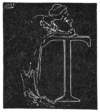 HE Ex Libris Society, of London, was organized in 1891,
and now has four hundred members, of whom about fifty are residents of
the United States. The Society publishes a handsomely illustrated
Monthly Journal, which is free to members. The Annual Dues are ten
shillings, sixpence. The Entrance Fee is two shillings, sixpence. This
Society will probably limit its membership and raise its dues before
long. All persons interested in the collecting of book-plates, except
dealers in plates, are eligible to membership. The pre-payment of the
Entrance Fee and the Annual Dues constitutes one a member.
HE Ex Libris Society, of London, was organized in 1891,
and now has four hundred members, of whom about fifty are residents of
the United States. The Society publishes a handsomely illustrated
Monthly Journal, which is free to members. The Annual Dues are ten
shillings, sixpence. The Entrance Fee is two shillings, sixpence. This
Society will probably limit its membership and raise its dues before
long. All persons interested in the collecting of book-plates, except
dealers in plates, are eligible to membership. The pre-payment of the
Entrance Fee and the Annual Dues constitutes one a member.
The Honorable Secretary of the Society is Mr. W. H. K. Wright, of
Plymouth, England. The Corresponding Secretary for the United States is
Mr. Charles Dexter Allen, Hartford, Conn.
DES EX-LIBRIS-VEREINS ZU BERLIN.
The German Society published the first number of its Quarterly in
October, 1891. This is{388} beautifully illustrated with many plates in
colors, and is free to all members. The Annual Dues are twelve marks.
The address of the Secretary is, Friedrich Warnecke,
Friedrich-Wilhelmsstrasse, 4. Berlin, W., Germany.
SOCIETE FRANÇAISE DES COLLECTIONNEURS D’EX LIBRIS.
The French Society was organized in 1893, and published the first number
of its Archives in January, 1894. This monthly is free to all members.
The Annual Dues are nineteen francs and fifty centimes. The address of
the Secretary is, 3 Foubourg Saint-Jacques, Paris.
{389}
BIBLIOGRAPHY.
AMERICAN, ENGLISH, AND FRENCH.
THE AMERICAN BIBLIOGRAPHY.
By Eben Newell Hewins.
Book-plate collecting in the United States is of such recent growth that
the literature on the subject is naturally limited, consisting of only a
few scattered magazine and newspaper articles.
The following list is believed to be nearly, if not quite, complete.
The compiler desires his thanks to all who have assisted him in his
work; and especially would he thank Mr. H. W. Fincham and Mr. James
Roberts Brown, for kind permission to use their exhaustive English
Bibliography, which is here reprinted from the journal of the Ex Libris
Society; and also Mr. Walter Hamilton, for permission to use his
Bibliography, prepared for his “Hand-Book of French Book-Plates.”
Additions to this list are desired, and correspondents having knowledge
of articles not noted here will confer a favor by communicating with
either the author or compiler.
1. The Heraldic Journal. Vol. I., American book-plate engravers; Thomas
Johnson, p. 6; Nat. Hurd, p. 19; John Cole, Jun., pp. 95-108. Vol. II.,
American book-plate engravers; Thomas Turner, p. 94. Vol. III., The
Harris collection of book-plates, pp. 21-24; Thomas Child’s book-plate,
p. 190. Vol. IV., The Spooner book-plate, p. 45; the William King
Atkinson book-plate, p. 119; Heraldic Painters and Engravers, p. 192.
J. K. Wiggin, Boston, 8vo, 1865-1868.
2. Whitmore (William H.). Elements of Heraldry.
Boston, 1866.
Contains copies of book-plates and notices of early American book-plate
engravers.{390}
3. Winsor (Justin). A catalogue of the collection of books and
manuscripts formerly belonging to the Rev. Thomas Prince, ... now
deposited in the public library of the city of Boston, v., viii.,
illustrated.
Boston, U.S.A., 4to, 1870.
Describes the various book-plates of the Rev. Thomas Prince,
1687-1758.
4. Brown (John Coffin Jones). The Coffin family, its armorial bearings,
and origin of the name, illustrated.
Boston, 8vo, 1881.
5. Literary World. A Library Pest, July 2, 1881. The Study of
Book-plates. A review of Warren, Aug. 13, 1881. (By Rev. Dr. Joseph
Henry Dubbs.)
Boston, U.S.A., 1881.
6. Leach (Frank Willing). The Right to bear Arms, illustrated. The
Continent, Vol. III., pp. 513-523.
Philadelphia, Penn., U.S.A., April 25, 1883.
Many of the illustrations given are copies of book-plates.
7. Lichtenstein (Richard C.). Early Book-plates. The Boston Daily
Globe, April 22, 1885.
8. Book-Mart. Original stanzas for insertion on the fly-leaves of lent
books, III., 27.
Pittsburgh, Penn., U.S.A., 8vo, 1885.
9. The Book Buyer. A List of American Book-plate Collectors, III., 165.
The Original and Imitation Washington Book-plate, illustrated, III.,
234. Practical Suggestions for Book-plates, illustrated, III., 377.
New York, Scribner, 4to, 1886.
10. Hutton (Laurence). Some American Book-plates, illustrated. The Book
Buyer, Vol. III., 7-9, 63-65, 112-114, 159-161.
New York, Scribner, 4to, 1886.
These articles were reprinted in the Ex Libris Journal, Vol. II., pp.
42, 52, 69.
11. New York Genealogical and Biographical Record, Vol. XVIII., No. 1.
Samuel Provoost, First Bishop of New York. An address to the
Genealogical and Biographical Society. Illustrated with portrait and
book-plate of Bishop Provoost.
New York, January, 1887.
{391}
12. Lichtenstein (Richard C.). Early New England and New York Heraldic
Book-plates. New England Historical and Genealogical Register, XL.,
295-299. Published under the direction of the New England Historic
Genealogical Society.
Boston, 8vo, 1886.
Also privately printed with additions.
13. Lichtenstein (Richard C.). Early Southern Heraldic Book-plates. New
England Historical and Genealogical Register, XLI., 296. Published
under the direction of the New England Historic Genealogical Society.
Boston, 8vo, 1887.
14. Lichtenstein (Richard C.). American Book-plates and their Engravers,
illustrated. The Curio, 11-17, 61-66, 110-114; Washington’s Library,
illustrated, 246-252.
New York, U.S.A., R. W. Wright, folio, 1887.
The Curio was discontinued after the sixth number.
15. Martin (Charles Towneley). Book-plates and their Early Engravers.
City Mission Record.
Hartford, Conn., 1888.
16. Dubbs (Rev. Dr. Joseph Henry). Peter Miller’s Book-plate. Reformed
Church Messenger (Whitehall Papers, second series, No. V.).
Philadelphia, Penn., U.S.A., June 19, 1889.
17. The Century Magazine, Vol. XXXIX. The Grolier Club, 87.
New York and London, 8vo, 1889.
Contains the book-plate of the Grolier Club.
18. The American Book Maker. Book-plates, illustrated. Vol. XI., No. 2,
8vo, August, 1890; Vol. XIII., No. 3, 8vo, September, 1891.
New York, U.S.A.
19. The Book Lover. Edited by Ingersoll Lockwood, Phil. Bibl.
Book-plate, A Classical, by Rhead, 60; An American, 35; An Artistic, by
Rhead, 79; Book-plates, by Rhead, 53, 91; Centennial, by A. B. Bogart,
69; Design for, 23; for Cultured Collectors, 115; Book-plates, 13. All
the above articles are illustrated.
New York, William Evarts Benjamin, 8vo, 1890.
Publication discontinued after twelfth number.
{392}
20. The Sunday Sun. South Carolina Book-plates.
Charleston, S.C., January 4, 1891.
21. Dubbs (Rev. Dr. Joseph Henry). Hobbies and How to Ride them. The
Interior, June 11, 18, 1891.
Chicago, Ill., 1891.
These articles do not directly refer to book-plates, but contain
incidental allusions.
22. Providence Sunday Journal. Collecting Book-plates, Mrs. E. H. L.
Barker.
Providence, R.I., U.S.A., November 15, 1891.
23. The News and Courier. A Bibliographical Hint. Something about
Book-plates.
Charleston, S.C., U.S.A., March 1, 1892.
24. Stevenson (E. Ireneus). The Book-plate and How to Make it. The
Christian Union.
New York, U.S.A., April 30, 1892.
25. The Collector. Some Historic Book-plates (Rev. Dr. J. H. Dubbs), V.,
151-152, 164-165, 176-177; German Book-plates of Pennsylvania (Rev. Dr.
J. H. Dubbs), VI., 3-5; The Book-plate of Jacob Sargeant, illustrated
(Charles Dexter Allen); Collection of Book-plates, VI., 29.
New York, Walter Romeyn Benjamin, 4to, 1892.
26. Hutton (Laurence). From the Books of Laurence Hutton. On Some
American Book-plates, chapter i., 3-29.
New York, Harper & Bros., 12mo, 1892.
A reprint of the articles which appeared in the Book Buyer, 1886,
and also in the Ex Libris Journal, Vol. II.
27. American Dictionary of Printing and Book-making, Part iv., 180, 181.
Ex Libris, illustrated.
New York, Howard Lockwood & Co., 4to, 1892.
28. The Book Buyer. Some English Book-plates. A review of Mr. Castle’s
book, illustrated, V., pp. 19-22. Some French Book-plates. A review of
Mr. Hamilton’s book, illustrated, V., pp. 65-67.
New York, Charles Scribner’s Sons, 4to, 1893.
29. The Library Journal. Note of the Ex Libris Society of London.
New York, May, 1893.
{393}
30. Jamaica Plain News. Book-plates. A review of Mr. Castle’s book,
illustrated.
Jamaica Plain, Mass., U.S.A., July 8, 1893.
31. The Critic. Book-plates of New England Authors. A review of Mr.
Castle’s book, illustrated, Vol. XIX., pp. 82, 83. Some American
Book-plates, illustrated, Vol. XX., pp. 88, 89.
The Critic Company, New York, folio, 1893.
32. The Hartford Post. Hundreds of Book-plates in the Collection of a
Hartford Gentleman, illustrated.
Hartford, Conn., U.S.A., August 19, 1893.
33. The Richmond Despatch. Arms of the Virginia Company. An interesting
historical book-plate. R. A. Brock, Secretary Southern Historical
Society, September 17, 1893. That old Book-plate. Note on the Arms of
the Virginia Company, October 15, 1893.
Richmond, Va., U.S.A., 1893.
34. The Richmond Despatch. Note on the Ex Libris Journal.
Richmond, Va., December 3, 1893.
35. The Albany Argus. Note on Book-plate of the Albany Library Society.
Albany, N.Y., U.S.A., November, 1893.
36. Magazine of Art. “Ex Libris.” A review of Mr. Castle’s book.
New York, folio, December, 1893.
37. The Book-Lover’s Almanac. The Art of the Book-plate, by Henri Pene
DuBois, with seven caricature designs by Henriot. The Carroll
Book-plate, by Charles Dexter Allen, illustrated.
New York, Duprat & Co., 1893.
38. The Art Amateur. Ex-Libris Notes, illustrated, Vol. XXX., pp. 92,
121, 148, 173.
New York, Montague Marks, Publisher, 25 Union Square, folio, 1894.
39. The Dial. Private Book-marks. A note of Mr. Hardy’s book, p. 88.
Chicago, Ill., February 1, 1894.
{394}
40. The Collector. A Current Record of Art, Bibliography,
Antiquarianism, etc. Published semi-monthly.
Alfred Trumble, 454 West 24th Street, New York.
The following numbers contain brief articles on book-plates: Vol.
IV., Nos. 13, 14, 20; Vol. V., No. 1, 1893; Vol. V., Nos. 8, 9,
1894. This is not to be confounded with The Collector, published
by Walter R. Benjamin.
41. The Inland Printer. The Book-plate, its Literature, etc., by W.
Irving Way, illustrated, Vol. XII., No. 6, pp. 460-461.
The Inland Printer Co., Chicago, Ill., March, 1894.
42. Book Reviews. American Book-plates, by Charles Dexter Allen.
New York, Macmillan & Co., Vol. II., No. 1, May, 1894.
* * *
Allusions to book-plates, or reproductions of interesting plates, are
found in the following works:—
Bridgman (Thomas). The Pilgrims of Boston and their Descendants.
Book-plate of Peter Kemble, Esq.
Boston, Phillips, Sampson & Co., 8vo, 1856.
Magazine of American History. November, 1880, Kissam book-plate, p. 376;
February, 1881, Washington’s book-plate, p. 88; March, 1881, Kissam
book-plate, pp. 225, 302; April, 1881, W. Smith’s book-plate, p. 274;
August, 1884, Roger Morris; book-plate of Henry Clinton, grandson of Sir
H. Clinton.
Ralph Waldo Emerson. His Maternal Ancestors. With some Reminiscences of
Him. By David Greene Haskins, D.D. Boston, Cupples, Upham & Co., 12mo,
1886.
Book-plate of Rev. William Emerson, father of Ralph Waldo.
Lion Gardiner and his Descendants, by Curtis E. Gardiner.
St. Louis, 1890.
Book-plates of John Gardiner, Fifth Proprietor of Gardiner’s
Island, and John Lyon Gardiner, Seventh Proprietor.
{395}
History of the Centennial Celebration of the Inauguration of George
Washington as First President of the United States.
New York, Appleton & Co., 1892.
Book-plate of George Washington.
Pene DuBois (Henri). Four Private Libraries of New York.
New York, Duprat & Co., 8vo, 1892.
Book-plates of C. Jolly-Bavoillet and George B. DeForest.
Customs and Fashions in Old New England. Book-plates, p. 286. Alice
Morse Earle.
New York, Charles Scribner’s Sons, 1893.
Jamaica Plain News. Sketch of a “talk” on Book-plates, by Mr. E. N.
Hewins.
Jamaica Plain, Mass. U.S.A., March 3, 1894.
Origin and Growth of the Library of the Massachusetts Historical
Society. A paper presented at a Meeting of the Society, November 9,
1893, by Samuel Abbott Green, M.D. Pamphlet.
John Wilson & Son, University Press,
Cambridge, Mass., 1893.
Describes the various book-plates used by the Society, and is
illustrated with several fac-similes.
The Jaunceys of New York. Pamphlet, 24 pp.
New York, 1876.
William Jauncey’s book-plate for frontispiece.
Annals of the Van Rennselaers in the United States, by Rev. Maunsell Van
Rennselaer, D.D., LL.D.
Albany, 8vo., pp. 241. 1888.
Book-plate of K. K. Van Rennselaer, to face page 214.
Pennsylvania Magazine of History and Biography, Vol. IX., page 14.
Book-plate of Sir John St. Clair. Notices on him by Charles R.
Hildeburn. 1885.
{396}
THE ENGLISH BIBLIOGRAPHY.
By H. W. Fincham, Esq., and James Roberts Brown, F.R.G.S.
[Reprinted by their kind permission.]
1. Bartsch (Adam). Le Peintre Graveur, Vol. VII., for plates by Dürer
and others.
Vienna, 21 vols., 8vo, 1803-1821.
2. Moule (Thomas). Bibliotheca Heraldica Magnæ Britanniæ, pp. 367-388.
London, royal 8vo, 1822.
Moule used the cut on the title-page as his book-plate.
3. The Gentleman’s Magazine. Remarks on the invention of book-plates,
Part ii., 613.
London, 8vo, 1822.
4. The Gentleman’s Magazine. Book-plates (C. S. B.), Part i., 198-199.
London, 8vo, 1823.
5. Wadd (William). Mems., Maxims, and Memoirs, pp. 146-147.
London, Callow & Wilson, 8vo, 1827.
6. Parsons (Rev. Daniel). On Book-plates. Third Annual Report of the
Oxford University Archæological and Heraldic Society, pp. 17-25.
Oxford, J. Vincent, royal 8vo, 1837.
7. Notes and Queries, 1st Series. Book-plates, whimsical one, vi., 32;
motto, i., 212; early, iii., 495; iv., 46, 93, 354; vii., 26; xi., 265,
351, 471; xii., 35, 114.
London, 1849-1855.
8. Dennistoun (James). Memoirs of Sir Robert Strange ... and Andrew
Lumisden, ii., 283-284.
London, Longman, 2 vols., 8vo, 1855.
Gives the dates of three book-plates engraved by Strange.
9. Notes and Queries, 2d Series. Book-stamps, armorial, x., 409.
London, 1856-1861.
10. Notes and Queries, 3d Series. Book-plates, armorial, vi., 306; their
heraldic authority, xii., 117, 218.; by R. A., wood engraver, viii.,
308. London, 1862-1867.{397}
11. Beaupré (M.). Notice sur quelques Graveurs Nancéiens du XVIII
Siècle. Nancy, Lucien Wiener, 8vo, 1862.
Contains description of a number of book-plates engraved by
Dominique Collin.
12. See American Bibliography, No. 1.
13. See American Bibliography, No. 1.
14. See American Bibliography, No. 2.
15. Leighton, F.S.A. (John). Book-plates, Ancient and Modern, with
examples, illustrated. Gentleman’s Magazine, 4th Series, Vol. I., pp.
798-804.
London, 8vo, June, 1866.
Reprinted in the Ex Libris Journal, July, 1891; also reprinted in
the British and Colonial Printer and Stationer, August 6, 1891.
16. Hugo, M.A. (Thos.). The Bewick Collector, illustrated, pp. 303-322.
London, Reeve & Co., 8vo, 1866.
17. Larousse (Pierre). Ex Libris, mots latins qui signifient
littéralement des livres, d’entre des livres, faissant partie des
livres, avec le nom du propriétaire. Ces mots s’inscrivent ordinairement
en tête de chaque volume d’une bibliothèque avec la signature du
propriétaire. On connait ce trait d’ignorance d’un financier, homme
d’ordre avant tout, qui avait ordonné à son chapelier de coller
soigneusement au fond de son chapeau, “Ex Libris Vaudore.” Grand
Dictionnaire Universel du XIX Siècle, Vol. 7. Paris, 16 vols., 4to,
1866-1877.
18. See American Bibliography, No. 1.
19. See American Bibliography, No. 1.
20. Notes and Queries, 4th series. Book-plates, armorial, iv., 409, 518;
v., 65, 210, 286; ix., 160; exchanged, x., 519.
London, 1868-1873.
21. Hugo, M.A. (Thos.). The Bewick Collector Supplement, illustrated,
pp. xxiii., 152-155.
London, Reeve & Co., 8vo, 1868.
22. Howard, LL.D., F.S.A. (Joseph Jackson). Miscellanea Genealogica et
Heraldica, illustrated, Vol. I. Examples of Armorial Book-plates:
Hooke, 1703; Rogers, 1700; Rogers, Gage, 1805; Dallaway, 284;
Billingsley, Egerton, 1707; Snell, 299.
London, royal 8vo, 1868.
{398}
23. Bibliophile Français. Gazette illustrée des amateurs, de livre
d’estampes, et des hautes curiosités.
Paris, 7 vols., royal 8vo, 1868-1873.
This work incorporates the “Armorial du Bibliophile” of Guigard.
24. Bachelin-Deflorenne, bookseller, of Garrick Street, Covent Garden,
London, December, 1869. Catalogue of, describes two book-plates dated
respectively 1279 and 1314. Vide The Book Fancier, P. Fitzgerald, p.
129.
25. Guigard (Joannis). Armorial du bibliophile, avec illustrations dans
le texte.
Paris, Bachelin-Deflorenne, 2 vols., 8vo, 1870-1872.
Contains about 1400 cuts of super-libris.
26. Tourneaux (Maurice). Ex Libris. Amateur d’autographes. April, 1872.
An article on the collection of ex libris in the possession of M. Aglaüs
Bouvenne.
27. Notes and Queries, 5th Series. Book-plate, R. T. Pritchett’s, ix.,
29, 75; query, x., 428; armorial, i., 386; exchanged, i., 60, 199; ii.,
159; punning, iv., 464; v., 35; handbook of, vi., 465; vii., 36, 76;
heraldic, vi., 369, 543; vii., 28, 36, 76, 233, 435, 515; earliest
known, vii., 76, 235; mottoes on, vii., 427; viii., III, 258;
collections, vii., 435, 515; viii., 38, 79, 118, 158, 178, 360; xi.,
260; dated, viii., 200, 298, 397, 517; ix., 198; xi., 446; xii., 33; how
to arrange collections, ix., 20; papers on, ix., 360.
London, 1874-1879.
28. Poulet-Malassis (A.). Les Ex Libris Français, depuis leur origine
jusqu’à nos jours. Plates.
Paris, P. Rouquette, royal 8vo, 1874.
29. De Rieffenberg. De Marques et devises mises à leur livres par un
grande nombre d’amateurs.
Paris, 1874.
30. Athenæum. “Les Ex libris Français.” Review of Poulet-Malassis’ book
“Les Ex Libris Français.”
London, p. 469, October 9, 1875.
31. Longpérier-Grimoard (Comte de). Etude sur les Ex Libris.
Senlis, 8vo, 8 pp., 1875.
A paper read before the Comité-Archéologique de Senlis, December
11, 1874.
{399}
32. Longpérier-Grimoard (Comte de). Letter to Monsieur Aubry on a
Super-Libris of Crozat. Bulletin de Bouquiniste, No. 416. Paris,
Aubry, April 15, 1875.
33. Poulet-Malassis (A.). Les Ex Libris Français. Nouvelle edition,
revue, très-augmentée et ornée de vingt-quatre planches.
Paris, P. Rouquette, royal 8vo, 1875.
34. Tooke (M. A.). Notes on Book-plates, illustrated. The Art Journal,
new series, XV., 267-270.
London, Vèrtue, folio, September, 1876.
35. Longpérier-Grimoard (Comte de). Une marque inconnue (College du
cardinal le Moine).
Paris, Aubry, 1876.
Reprinted from the Bulletin de Bouquiniste, December 1 and 15,
1876.
36. Van de Haeghen. Dictionnaire des devises des hommes des lettres,
imprimeurs, libraires, bibliophiles, etc.
1876-1879.
37. Howard, LL.D., F.S.A. (Joseph Jackson). Miscellanea Genealogica et
Heraldica, Vol. II., illustrated. Examples of Armorial Book-plates:
Barker, 505; Beddington, 244; Bowdon, 525; De Burgo, 1720, 287;
Cary-Elwes, 556; Furneaux, 170; Gomm, 184; Haslewood, 128; Hilliard, 87;
Lorimer, 421; Palmer, 487; Potter, 570; Waldy, 583.
London, royal 8vo, 1877.
38. Pall Mall Gazette. Occasional Notes, “Old Bookworm,” p. 4, November
19; p. 5, December 18.
London, 1877.
39. The Genealogist, Vol. II. Book-plate of Anthony Stewart,
illustrated, 192.
London, Golding & Lawrence, 8vo, 1878.
40. Warren, M.A. (The Hon. J. Leicester). Guide to the Study of
Book-plates. Plates.
London, John Pearson, 8vo, 1880.
41. The Bookseller. A Guide to the Study of Book-plates. Review of
Warren’s book, “A Guide to the Study of Book-plates.”
London, October 6, 1880.
{400}
42. The Graphic. The Reader. Review of Warren’s book, “A Guide to the
Study of Book-plates.”
London, October 16, 1880.
43. Saturday Review. Book-plates. A review of Warren’s book, “A Guide to
the Study of Book-plates.”
London, October 20, 1880.
44. The Academy. Art Books. Review of Warren’s book, “A Guide to the
Study of Book-plates.”
London, November 13, 1880.
45. The Antiquary, edited by E. Walford, M.A., Vol. I. Notes on
Book-plates, 75-77; Book-plates (W. Hamilton), 117-118; Book-plates,
189; Notes on Curious Book-plates, 236-237; Another Chapter on
Book-plates (Alfred Wallis), 256-259.
London, Elliot Stock, 4to, 1880.
46. The Antiquary, edited by E. Walford, M.A., Vol. II. A Supplementary
Chapter on Book-plates, 6-10; An Essay on Book-plates (E. P. Shirley),
115-118; Book-plates, 133, 272.
London, Elliot Stock, 4to, 1880.
47. Howard, LL.D., F.S.A. (Joseph Jackson). Miscellanea Genealogica et
Heraldica, Vol. III., illustrated. Examples of Armorial Book-plates:
Andrews, 171; Bedford, 189; Carson, 156; Burr, 156; Courthope, 327;
Dalton, 438; Fenwick, Note respecting Bewick, 433; Gregory, 290;
Harrington, 1706, 195; Hoblyn, 353; Hyett, 95; Jackson, 402; Millard,
445; Mitchell, 101, 143; Nott, 1763, 233; Ridgway, 1871, 47; St. George,
82; Strangways, 22; Tomes, 273; Waggett, 182; Walters, 226, 252; White,
1878, 206; Woodroffe, 65.
London, royal 8vo, 1880.
48. Notes and Queries, 6th Series. Book-plates, collections of, i., 2,
178, 197, 266, 386; ii., 272, 302; vi., 161, 298; x., 24; of Lord Keane
and others, i., 336; ii., 34, 94, 255; “As” on, i., 516; armorial, ii.,
367, 396, 427; iii., 73, 126, 278, 298; xi., 267, 410; their removal,
ii., 445, 491; iii., 31; their arrangement, iii., 28, 130, 195; dated,
iii., 204, 302; iv., 206, 247, 466, 486; v., 9, 78, 151; vi., 357; vii.,
146, 166; ix., 480; x., 34; accumulated,{401} iii., 289, 473; iv., 16;
Burton, iii., 386; their collection, 402; cryptographic, 403; with
astronomical symbols, 429; something new in, 506: Austro-Hungarian, 508;
with Greek mottoes, iv., 266, 414, 497; v., 296, 457; vi., 136, 218,
398; vii., 295, 304, 336; viii., 278; their mounting, iv., 305; their
exchange, v., 46; curious, v., 226, 305, 374, 457; vi., 15, 76; Bishop
of Clonfert’s, 1698, v., 346; portrait, v., 407; vi., 14, 157; Joseph
Ignace’s, vi., 68, 237; Rev. Adam Clarke’s, vii., 304; foreign, viii.,
268, 298; John Collet’s, 1633, ix., 308, 437; Boteler, x., 27;
unidentified, 129; German, 269, 373; Arthur Charlett’s, xi., 267, 411,
433, 451; ancient, xii., 8, 78; heraldic, 10, 429; parochial, 69, 152;
typographical, 288, 352, 415; their antiquity, 512.
London, 1880-1885.
49. Stoeber (Auguste). Petit Revue d’ex libris Alsaciens.
Mulhouse, 12mo, 1880.
50. Nouvelle étude sur l’université de Pont-à-mousson.
Nancy, 1880.
51. The Antiquary, Vol. III. Reviews. A Guide to the Study of
Book-plates, 77.
London, Elliot Stock, 4to, 1881.
52. The Antiquary, Vol. IV. Last Words on Book-plates, 106-111.
London, Elliot Stock, 4to, 1881.
53. Dobson (Austin). The Book-plate’s Petition: a poem.
Notes and Queries, Jan. 8, 1881.
54. Hamilton, F.R.G.S. (Walter). Leaves from a Library, on Book-plates.
West Middlesex Advertiser, March 26; April 2, 9, 16, 23, 30; May 7,
14.
London, Shields, Sloane Square, 1881.
55. The Genealogist, Vol. V. “A Guide to the Study of Book-plates” (a
review of Warren), illustrated, 74-77. Grant of Arms to John Leyland,
illustrated with book-plate, 184. London, George Bell & Sons, 8vo, 1881.
56. Palatine Note Book, Vol. I. Book-plates, 15, 16, 30, 52, 53, 69,
114, 195; illustrated, 217; of Jesus Coll., Camb., 128; Walpole’s, 209.
Manchester, 4to, 1881.{402}
57. Paper and Printing Trades Journal. Ex Libris, illustrated. March, p.
48; September, p. 19.
London, 4to, 1881.
58. Western Antiquary, Vol. I., edited by W. H. K. Wright, F.R.H.S.
Book-plates, Francis Drake’s, 32, illustrated; proposed work on, by
Walter Hamilton, 174.
Plymouth, 4to, 1881.
59. Daily News. A leader on book-borrowers, book-plates, and mottoes.
London, April 29, 1881.
60. Lang (Andrew). The Library, pp. 42-59.
London, Macmillan, 8vo, 1881.
61. See American Bibliography, No. 5.
62. Hardy (W. J.). Book-plates. The Globe, November 3.
London, 1881.
Reprinted in Turnovers from the Globe.
London, The Globe office, 8vo, n.d.
63. The Antiquary, Vol. V. Book-plates, 85, 86.
London, Elliot Stock, 4to, 1882.
64. Antiquarian Magazine and Bibliographer, edited by E. Walford, M.A.,
Vol. I. Notes on English Book-plates, No. 1 (W. J. Hardy), illustrated,
173-177.
London, Reeves, royal 8vo, 1882.
65. Antiquarian Magazine and Bibliographer, edited by E. Walford, M.A.,
Vol. II. Notes on English Book-plates, No. 2 (J. Harrop), 53-55,
illustrated; on Book-plates (F. J. Thairlwall), 277-280, illustrated;
Book-plates, 48, 106, 161, 322.
London, Reeves, royal 8vo, 1882.
66. Palatine Note Book, Vol. II. Book-plates, 18, illustrated.
Manchester, 4to, 1882.
67. Printing Times and Lithographer. Curiosities of Book-plates, viii.,
265-268, 290-292.
London, Wyman & Sons, 4to, 1882.
68. Western Antiquary, edited by W. H. K. Wright, F.R.H.S., Vol. II.
Book-plates, local, 197; Armorial, 211, 212, illustrated.
Plymouth, 4to, 1882.
{403}
69. Paper and Printing Trades Journal. A Curious Book-plate,
illustrated, No. 40, p. 45.
London, 4to, September, 1882.
70. The Antiquary, Vol. VII. Book-plates, early reference to, 231.
London, Elliot Stock, 4to, 1883.
71. Antiquarian Magazine and Bibliographer, edited by E. Walford, M.A.,
Vol. III. Book-plates (D. P.[arsons]), 2-7, 53-56, illustrated (R. Day),
272-273; Book-plates, 104, 161, 274.
London, Reeves, royal 8vo, 1883.
72. Antiquarian Magazine and Bibliographer, edited by E. Walford, M.A.,
Vol. IV. Book-plates (W. Hamilton), 110, 111.
London, Reeves, royal 8vo, 1883.
73. Palatine Note Book, Vol. III. Book-plates, 51, 97, 191, 233,
illustrated.
Manchester, 4to, 1883.
74. Benoit (Arthur). Les Ex Libris de Schœpflin, illustrated.
Paris, 8vo, 1883.
An extract from “Le Bulletin de la Société pour la conservation des
monuments historiques d’Alsace,” 2d Series, xii., 30-33.
75. Benoit (Arthur). Les Ex Libris dans les trois évêches, Toul, Metz,
Verdun, 1552-1790.
Paris, 8vo, 1883.
76. Antiquarian Magazine and Bibliographer, edited by E. Walford, M.A.,
Vol. V. A Bibliography of Book-plates (W. Hamilton), 78-80; Book-plates,
106, 107, 162, 217.
London, royal 8vo, 1884.
77. Griggs (W.). Eighty-three examples of Book-plates from Various
Collections. Plates. Privately printed.
W. Griggs, Hanover Street, Peckham, London, 4to, 1884.
78. Howard, LL.D., F.S.A. (Joseph Jackson). Miscellanea Genealogica et
Heraldica, Vol. IV., illustrated. Examples of Armorial Book-plates:
Carew, 154; Clutton, 300; Collins, 274; Fletcher, 214; Gidley, 19;
Hayman, 54; Heysham, 375; Heywood, 202; Humphry, 314; Littleton, 166;
Lynch, 387; Meade, 6; Pole, 131; Pringle, 190; Symons, 250; Soltau, 250;
Traherne, 102; Underhill, 78; Wickham, 67; Wilmer, 238; Wilmer Ex Dono,
1599, 238.
London, royal 8vo, 1884.
{404}
79. Benoit (Arthur). Les bibliophiles, les collectioneurs, et les
bibliothèques des monasteres des trois évêches, 1552-1790.
Paris, royal 8vo, 1884.
80. See American Bibliography, No. 8.
81. Day, F.S.A., M.R.I.A. (Robert). Notice of book-plates engraved by
Cork artists. Journal of the Royal Historical and Archæological
Association of Ireland, illustrated, No. 61, Vol. VII., January, 1885.
Privately reprinted, 7pp., 8vo. Reprinted in the Ex Libris
Journal, August, 1891.
82. Day, F.S.A., M.R.I.A. (Robert). “Ex Libris.” Journal of the
Birmingham Central Literary Association, illustrated.
Privately reprinted, 7 pp., 8vo, 1885.
83. See American Bibliography, No. 7.
84. Western Antiquary, edited by W. H. K. Wright, F.R.H.S., Vol. IV.
Book-plate of J. O. H. Glynn, 38, illustrated.
Plymouth, 4to, 1885.
85. The Antiquary, Vol. XIII. Book-plate, 231, 278.
London, Elliot Stock, 4to, 1886.
86. See American Bibliography, No. 9.
87. See American Bibliography, No. 9.
88. See American Bibliography, No. 9.
89. East Anglian, edited by the Rev. C. H. Evelyn White, F.S.A.
Pretyman’s Book-plate, New Series, i., 246.
Ipswich, 8vo, 1886.
90. Fitzgerald (Percy). The Book Fancier, 128-131.
London, Sampson Low, 8vo, 1886.
91. Howard, LL.D., F.S.A. (Joseph Jackson). Miscellanea Genealogica et
Heraldica, 2d Series, Vol. I., illustrated. Examples of Armorial
Book-plates: Brownlowe, 1698, 221; Chauncy, 28; Chetwode, 85; Lady Mary
Booth, Chetwood, 122; Conder, 61; Dade, 311; Dering, 1630, 285;
Elizabeth, Countess of Exeter, 268; Murray, 347; Shank, 235; Smith, 347;
Walpole, 364.
London, royal 8vo, 1886.
{405}
92. See American Bibliography, No. 10.
93. See American Bibliography, No. 12.
94. Locker-Lamson (Frederic). The Rowfant Library, a catalogue of the
printed books, manuscripts, autograph letters, ... collected by F.
Locker-Lamson.
Printed for presentation, royal 8vo, 1886. Contains three varieties
of F. L.-L.’s book-plates, and at p. 176: “Note.—I think Sir
William (Stirling-Maxwell) designed above a hundred book-plates for
himself and his friends. F. L.”
95. Notes and Queries, 7th Series. Book-plates, English mentioned in
1720, i., 65; heraldic, i., 448; ii., 15, 56; Græme, ii., 49, 98, 154;
with inscription, 364; “I love my books,” etc., ii., 410, 455; date of,
iii., 248; owner of, iv., 109; spurious, iv., 148, 212; engraved by
Heylbrouck, v., 48, 174; of Suffolk, vi., 508; Friedrich Nicolai’s, xi.,
109, 213, 333; Ex Libris Society, 160, 360.
London, 1886-1891.
96. Quentin-Bauchart (E.). Les Femmes bibliographiles de France
(XVIe, XVIIe, et XVIIIe Siècles). Avec 43 Planches d’Armoiries.
Paris, 2 vols., 8vo, 1886.
97. Franks, F.R.S., V.P.S.A. (Augustus W.). Notes on Book-plates, No. 1,
English-dated Book-plates, 1574-1800.
Printed for private distribution, 8vo, 32 pp., 1887.
98. See American Bibliography, No. 14.
99. See American Bibliography, No. 14.
100. See American Bibliography, No. 13.
101. Dobson (Austin). The Book-plate’s Petition. Ballads of Books, A.
Lang.
London, 1888.
102. Encyclopædic Dictionary. “Book-plate, a piece of paper stamped or
engraved with a name or device and pasted in a book to show the
ownership.”
London, Cassell, royal 8vo, 1888.
103. Gentleman’s Magazine Library. Literary Curiosities, Book-plates,
82-86, 325.
London, Elliot Stock, 8vo, 1888.
{406}
104. Howard, LL.D., F.S.A. (Joseph Jackson). Miscellanea Genealogica et
Heraldica, 2d Series, Vol. II., illustrated. Examples of Armorial
Book-plates: Bartlett, 294; Biss, 152; Draper, 24; Owen, 368;
Scheurl-Tucker, by A. Dürer, 104, 105, 120; Gibson, 196.
London, royal 8vo, 1888.
105. Tit-Bits. Book-stealing, 107.
London, May 26, 1888.
106. Western Antiquary, edited by W. H. K. Wright, F.R.H.S., Vol. VII.
Curious Book-lines, by George Wightwick, 160, 161.
Plymouth, 4to, 1888.
107. The Antiquary, Vol. XIX. Book-plates, proposed magazine for, 39.
London, Elliot Stock, 4to, 1889.
108. The Bookworm. Book-plates and their mottoes, 205. London, Elliot
Stock, 8vo, June, 1880.
109. Chambers’ Encyclopædia. Book-plates, New Edition, Vol. II, 309.
London, W. & R. Chambers, 8vo, 1889.
110. Howard, LL.D., F.S.A. (Joseph Jackson). Miscellanea Genealogica et
Heraldica, 2d Series, Vol. III., illustrated. Examples of Armorial
Book-plates: Burfoot, 396; Barton, 188; Rachel, Dutchess of Beaufort,
1706, 276; Conduit, 188; Darwin, 1737, 17; Darwin, 1771, 17; Dering,
1630, 56; Dering, 56; Hopkins, 261; Keith, 88; Monypenny, 56;
Shuckburgh, 256; Tollet, 72; Taddy, 261; Webster, 37. London, royal 8vo,
1889.
111. Quaritch (Bernard). Catalogue of fifteen hundred books remarkable
for the beauty or age of their bindings, or as bearing indications of
former ownership by great book-collectors and famous historical
personages.
London, Bernard Quaritch, 8vo, 1889.
112. Rylands, F.S.A. (J. Paul). Notes on Book-plates (ex libris), with
special reference to Lancashire and Cheshire examples, and a proposed
nomenclature for the shapes of shields. Plates.
Liverpool, privately printed, demy 4to, 1889.
Also in “Transactions of the Historic Society of Lancashire and
Cheshire,” pp. 1-76, illustrated.
Liverpool, Printed for the Society, 8vo, 1890.
{407}
113. Carlander (C. M.). Svenska Bibliotek och Ex Libris auteckningar,
med 84 illustrationer.
Stockholm, Adolf Johnson, 8vo, n.d. (1889).
114. Aveling (S. T.). Heraldry: Ancient and Modern Book-plates, 370-371,
illustrated.
London, F. Warne & Co., 8vo, 1890.
115. The Book-Plate Collector’s Miscellany, a monthly supplement to the
Western Antiquary, illustrated. Edited by W. H. K. Wright, F. R. Hist.
Soc.
Plymouth, W. H. Luke, 4to, 1890-1891.
116. Howard, LL.D., F.S.A. (Joseph Jackson). Miscellanea Genealogica et
Heraldica, 2d Series, Vol. IV., illustrated. Examples of Armorial
Book-plates: N. D’Eye, 25; Ball, R. Ball Dodson, 41; Paul Jodrell, 89;
Vassall, 120; Cooke, 1712, 136; Sr. G. Cooke, 1727, 152; Harrison, 1698,
168; Langley, 184; Wyndham, 201; Prentice, 216; Yardley, 1721, Yardley,
1739, 232.
London, royal 8vo, 1890.
117. Demmin (A.). Papier u. andere Beschreibstoffe Schreibgeräth,
Handschrift, Buch, Buchandel, u. Zeitungswesen, Buchdruck—u.
Buchbinderkunst, Buchdrucker—u. Bucherzeichen (Ex Libris), Initialen,
Zieleisten. With 46 illustrations.
Wiesbaden, 8vo, 1890.
118. Guigard (Joannis). Nouvelle Armorial du Bibliophile, Guide de
l’Amateur des Livres Armoriés. Contenant la Reproduction de 2500
Armoiries et Riches Reliures Armoiriées. Paris, Emile Rondeau, 2 vols.,
8vo, 1890.
119. Warnecke (F.). Die Deutschen Bücherzeichen (Ex Libris). Von ihrem
Ursprunge bis zur Gegenwort. Twenty-one illustrations in the text, and
26 plates.
Berlin, T. U. Stargardt, royal 8vo, 1890.
120. Rogers (Walter Thomas). A Manual of Bibliography, 103-105, with
diagrams.
London, H. Grevel & Co., 8vo (1890), 1891.
121. Bouchot (Henri). Les Ex Libris et Les Marques de Possession du
Livre. Fifteen plates.
Paris, Edouard Rouveyre, 8vo (1890), 1891.
{408}
122. The Antiquary, Vol. XXIII. A notice of the Ex Libris Society, 142.
London, Elliot Stock, 4to, 1891.
123. The British Bookmaker. Book Notes, a review of “Les Ex Libris”
(Bouchot), illustrated, Vol. IV., No. 47, p. 5. “Ex Libris,”
illustrated, Vol. IV., No. 48, p. 4. Book-plates, Vol. V., No. 49, p. 8.
London, Raithby, Lawrence & Co., 4to, 1891.
124. Hardy, F.S.A. (W. J.). Book-plates. The Library, iii., 47-53,
93-98.
London, Elliot Stock, 8vo, 1891.
125. The Library. Record of Bibliography. Reviews of “Die deutschen
Bücherzeichen” (Warnecke) and “Les Ex Libris” (Bouchot), iii., 17-19.
London, Elliot Stock, 8vo, 1891.
126. The Daily Chronicle. Book-plates, April 1. A note of the Ex Libris
Society, July 22.
London, 1891.
127. Oxford University Herald. The Ex Libris Society.
Oxford, May 23, 1891.
128. See American Bibliography, No. 20.
129. Journal of the Ex Libris Society, illustrated.
London, A. & C. Black, for the Society, 4to, 1891.
130. British and Colonial Printer and Stationer. The Ex Libris Society,
July 16. Book-plates, Ancient and Modern, with illustrations (a reprint
of No. 15), August 6. Book-plates, October 15.
London, 1891.
131. The Daily Free Press. A leading article upon collecting Book-plates
and the Ex Libris Society.
Aberdeen, July 17, 1891.
132. The Globe. Book-plates.
London, July 25, 1891.
133. The Saturday Review. Book-plates, a review of the Ex Libris
Journal.
London, July 25, 1891.
134. The Daily News. A note of the Ex Libris Society.
London, August 3, 1891.
135. The Publishers’ Circular. Book-plates.
London, August 8, 1891.
{409}
136. Answers. The Collecting Fad.
London, 4to, December 12, 1891.
137. Griggs (W.). Examples of Armorial Book-plates, Second Series.
Plates.
London, W. Griggs & Sons, Ld., 4to (1891), 1892.
138. Carlander (C. M.). Svenska Bibliotek och Ex Libris anteckningar
II., med 22 illustrationer.
Stockholm, Gernandts Boktoyckeri-Aktiebolag, 8vo, 1891.
139. Le Livre Moderne, Vol. IV. Remarques sur Quelques Ex Libris
Contemporains, illustrated, 1-18; Quelques Nouveaux Ex Libris,
illustrated, 323-330.
Paris, Maison Quantin, small 4to, 1891.
140. La Curiosité Universelle. À propos d’Ex Libris, No. 228. Le Plus
Grand Ex Libris, Nos. 248, 250, 251, 252, et 254. Review of the German
Ex Libris Society’s Journal, No. 258.
Paris, 4to, 1891.
141. Ex Libris. Zeitschrift für Bücherzeichen Bibliothekenkunde und
Gelehrtengeschichte. Organ des Ex Libris zu Berlin, illustrated.
Berlin, C. A. Starke, 4to, No. 1, October, 1891.
142. Benoit (Arthur). Le Serpent Emblème des Chirurgiens et des
Médecins.
6 pp., n.d.
Treats of serpents appearing on book-plates. An extract from Revue
Nouvelle d’Alsace-Lorraine.
* * *
Illustrations of Book-plates are to be found in the following works,
apart from the bibliography of the subject:—
143. Grace, F.S.A. (Sheffield). Memoirs of the Family of Grace.
London, royal 8vo, 1823.
Illustrated with above a dozen book-plates of Grace family, some
144. Dibdin, D.D. (Thomas Frognall). A Bibliographical Tour in the
Northern Counties of England and Scotland. Trotter Brockett’s book-plate
by Bewick, illustrated, i., 392.
London, 8vo, 1838.
{410}
145. Eyton, F.S.A. (Joseph Walton King). Catalogue of the Library of.
London, large paper, royal 8vo, 1848.
Illustrated with three examples of J. W. King Eyton’s book-plates,
one of which is in colors.
146. Palmer, F.S.A. (Charles John). The Perlustration of Great Yarmouth.
Great Yarmouth, 3 vols., 4to, 1872-1875.
A number of book-plates are used here to illustrate the arms of the
families mentioned.
147. Siennicki (S. J.). Les Elzévirs de la Bibliothèque de l’Université
Imperiale de Varsovie.
1874.
Contains eighteen fac-similes of remarkable book-plates in Warsaw
University Library.
148. Warnecke (F.). Heraldische Kunstblätter.
Görlitz, C. A. Starke, 3 vols., folio, 1876.
Contains many fac-similes of German book-plates.
149. Siennicki (S. J.). Recueil des éditions des imprimeurs célèbre de
l’Italie, de la France, et de la Belgique conservées dans la
Bibliothèque de l’Université Imperiale de Varsovie.
1878.
Contains fac-similes of remarkable book-plates in Warsaw University
Library.
150. Leighton, F.S.A. (John). Suggestions in design, ... with
descriptive and historical letter-press, by J. K. Collings, F.R.I.B.A.
Blazon, Heraldry, Rebuses, &c., plates, 50, 51, 52, 53, 54.
London, Blackie & Son, 4to, 1880.
151. See American Bibliography, No. 6.
152. Asta Libraria Antiquaria Catalogo, N. 42.
Florence, Franchi & Co., February, 1886.
The catalogue contains fac-similes of a Medicean Super Libros, and
of another not identified.
153. Griggs (W.). Illustrations of Armorial China. Plates.
Privately printed, folio, 1887.
Contains a number of fac-similes of book-plates.
154. See American Bibliography, No. 17.
155. The Strand Magazine, Vol. II.
London, 4to, 1891.
Page 120, the book-plate of H. Stacy Marks, R.A.
{411}
156. Blackburn (Henry). Randolph Caldecott, a personal reminiscence,
194-196.
London, Sampson Low, Marston & Co., 8vo, 1891.
Contains a description of the “Seaman” book-plate by R. Caldecott,
with illustration.
157. Theydon Mount: its Lords and Rectors. Edited by J. J. Howard,
Farnham Burke, and the Rev. L. N. Prance.
Privately printed, 4to, n.d. (1891).
Contains a fac-simile of the book-plate of “Sir Edward Smith, of Hill
Hall, Co. Essex, Bart.,” and another.
158. See American Bibliography, supplementary list.
* * *
The following articles having appeared since the English list was
prepared, are here inserted:—
The Yellow Book. An Illustrated Quarterly. Cuts of book-plates by Aubrey
Beardsley and R. Auning Bell, p. 251.
London, Elkin Mathews and John Lane.
Boston, U.S.A., Copeland & Day, Vol. I., 8vo, April, 1894.
The Strand Magazine. The handwriting of Mr. Gladstone, with fac-similes.
Vol. VIII., No. 43.
London, 8vo, July, 1894.
Fac-simile of early book-plate of Mr. Gladstone.
Daily News. Book-plate collecting. A review of Mr. Hamilton’s “Dated
Book-plates, Part I.”
London, July 17, 1894.
Quakerana, No. 5, July, 1894, page 77. Note of Ex Libris Society’s
exhibition in July, 1894, with special reference to book-plate of
William Penn.
London, Edward Hicks, Jun., 14 Bishopsgate Street Without, E.G.
The Studio, edited by Gleeson White, has contained several articles on
book-plates. Vol. III., No. 16, July 16, 1894: result of a prize
competition for a book-plate design, with 22 designs reproduced; Vol.
III., No. 17, August 15, 1894: cuts of three book-plates and review of
Hamilton’s “Dated Plates.”
London, 1894.
{412}
ADDITIONAL BIBLIOGRAPHY OF BOOK-PLATES.
By H. W. Fincham and James Robert Brown, F.R.G.S.
[Reprinted from the Journal of the Ex Libris Society.]
1. Historic Society of Lancashire and Cheshire. Proceedings and Papers.
Description of a Warrington Book-plate (Dr. J. Kendrick), illustrated,
134-135.
Liverpool, 8vo, 1854.
2. See American Bibliography, No. 3.
3. Portalis (Le Baron Roger) et Beraldi (Henri). Les Graveurs du
Dix-Huitième Siècle, illustrated, 3 vols. in 6.
Paris, Morgand et Fatout, 8vo, 1880-1882.
Contains lists of book-plates by many French engravers.
4. Spectator. “A Guide to the Study of Book-plates.” (A review of
Warren.)
London, October 13, 1880.
5. St. James Gazette. “A Guide to the Study of Book-plates.” (A review
of Warren.)
London, October 14, 1880.
6. The Athenæum. Mr. Thorn’s book-plate.
London, May 21, 1881.
7. See American Bibliography, No. 4.
8. Beraldi (Henri). Les Graveurs de XIX Siècle, illustrated, 12 vols.
Paris, L. Conquet, 8vo, 1885-1892.
Contains lists of book-plates by many French engravers.
9. Forening for Boghaandvaerk. Aarsskrift 1890 und 1891. Mit einer
Buchdruckfarbentafel, zalreichen Autotypien und Holzschnitten,
Schriften, Druckerzeichen, Ex Libris und Einbände reproducirend.
Kopenhagen, 2 vols., 4to, 1891.
10. Ledien (Alcius). Les Reliures Artistiques et Armoriées de la
Bibliothèque Communale d’Abbeville, illustrated.
Paris, Gruel-Engelmann, 4to, 1883.
{413}
11. See American Bibliography, No. 18.
12. See American Bibliography, No. 27.
13. The Antiquary. Unique Book-plates. Erasmus and Dr. Hector Pomer (H.
W. Pereira). Illustrated, xxv., 242-244.
London, Elliot Stock, 8vo, 1892.
14. The Bookworm. A Hunt for Book-plates in Paris (W. Hamilton),
171-173; the Avery Book-plate, 202. London, Elliot Stock, 8vo, 1892.
15. Castle (Egerton), M.A., F.S.A. English Book-plates, an illustrated
handbook for students of Ex Libris.
London, George Bell and Sons, imp. 16mo, 1892.
Second and enlarged edition, 1892.
16. See American Bibliography, No. 25.
17. La Curiosité Universelle. Un souvenir de la Terreur, illustrated;
Franc-Maçonnerie; Le plus grand Ex Libris, No. 262; Publication sur les
Ex Libris, Nos. 265, 266, 267, 268, and 269; Ex Libris d’Auvergne
(Ambroise Tardien), illustrated; Appel aux Collectionneurs d’Ex Libris,
No. 269; Ex Libris Rares et Inedits (Ferd. Reiber); Un grand Ex Libris
(Fr. Perot); Un autre souvenir de la Terreur (L. B.); Ex Libris
Alsaciens; Sociétés des Collectionneurs d’Ex Libris, No. 288; Les Ex
Libris Oratoriens (P. Ingold), illustrated, No. 299.
Paris, 4to, 1892.
18. Dictionary of English Book Collectors. Billibald Pirkheimer (M.
Kerney), illustrated, Part i.
London, Bernard Quaritch, 8vo, 1892.
19. Fincham (H. W.) & Brown (James Roberts) F.R.G.S. A bibliography of
book-plates.
Plymouth, printed for private distribution, 8vo, 24 pp., 1892.
20. Griggs (W.). One hundred and forty-seven Examples of Armorial
Book-plates from various collections (second series). Plates.
London, W. Griggs & Sons, 4to, 1892.
21. Hamilton (Walter). French Book-plates. A handbook for Ex Libris
Collectors, illustrated.
London, George Bell & Sons, imp. 16mo, 1892.
{414}
22. Hildetrandt (Professor Ad. M.). Heraldic Book-plates. Twenty-five Ex
Libris invented and drawn by.
Berlin, J. A. Stargardt, 8vo, 1892.
23. See American Bibliography, No. 26.
24. Incunabula, geographica et chalcographica, illustrated. Munich,
Ludwig Rosenthal’s Antiquariat, folio, 1892.
A catalogue of early woodcuts, containing a number of very early
German Ex Libris, among them being that of Hildebrand Brandenburg,
and the hedge-hog of Johannes Knabensperg, called Igler, circa
1450.
25. Ingold (C. P.). Les Ex Libris Oratoriens, illustrated. Paris, C.
Poussielque, 15 Rue Cassette, 8vo, 16 pp., 1892.
26. The Library. Record of Bibliography. Review of Fincham and Brown’s
Bibliography of Book-plates, iv., 262.
London, Simpkin, Marshall, Hamilton, Kent & Co., 8vo,
1892.
27. The Morning Post. Book-plates, June 14; Literary Notes, August 25.
London, 1892.
28. See American Bibliography, No. 23.
29. Notes and Queries, 8th Series. Book-plates: Boyer, i., 7; royal, i.,
126, 175; Rabelais’s, ii., 147; armorial, ii., 188, 274, 490; iii., 97;
iv., 168; Mountaine and Burden, engravers of, i., 247, 324; book-lending
and book-losing, i., 322; Ex Libris Society, ii., 500; English
Book-plates, a review, iii., 79; portraits as book-plates, iii., 81,
129, 210; French Book-plates, a review, iii., 160; Book-plates, a
review, iii., 419.
London, 4to, 1892.
30. Ris-Paquot, Dictionnaire Encyclopédique des Marques et Monogrammes,
Chiffes, Lettres, Initials, Signs, Figuratifs, etc., etc., contenant
1200 Marques.
Paris, R. H. Laurens, 6 Rue de Tournon, 2 vols., 4to,
1892.
31. Archives de la Société Française des Collectionneurs d’Ex Libris,
illustrated.
Paris, 3 Faubourg Saint-Jacques, 4to, No. 1, December,
1893.
32. The Athenæum. The Laws of Book-borrowing (G. H. Powell).
London. December 23, 1893.
{415}
33. The Bookman. Wm. Cowper’s copy of Robert Burns’ Poems, containing
his book-plate, illustrated, September, October.
London, folio, 1893.
34. See American Bibliography, No. 40.
35. El Coleccionista Argentina. Ex Libris, January; Ex Libris y
Eliquetas de libreros, March; The Journal of the Ex Libris Society,
April; Ex Libris, illustrated, June; Ex Libris, illustrated, September.
Buenos Ayres, 8vo, 1893.
36. Ex Libris Imaginaires et supposés de personnages célèbres anciens et
modernes. Plates.
Paris, L. Joly, 8vo, 1893.
37. The Globe. The Latest Hobby.
London, March 29, 1893.
38. Hardy (W. J.), F.S.A. Book-plates. Plates.
London, Kegan Paul, Trench, Trübner & Co., 8vo, 1893.
39. See American Bibliography, No. 32.
40. Kissel (Clemens). Symbolical Book-plates. Twenty-five Ex Libris
designed and drawn by.
London, H. Grevel & Co., 8vo (1893), 1894.
41. Miscellanea Genealogica et Heraldica (Dr. J. J. Howard, LL.D.,
F.S.A.), Vol. V., illustrated. Examples of Armorial Book-plates: Richard
Pritchett, 89; John Bennett, 104; (Phillipps, 1892), 136; (Thomas
Carter), 166; Sir John Collum and Dame Susanna, 1760; John Cullum, Rev.
Sir John Cullum, Richard Merry, Thomas Gery Cullum, Sir Thomas Gery
Cullum, Mary Hanson, 1773; Thomas Gery Cullum, Rev. Sir Thomas Gery
Cullum, Mary Anne Cullum, S. A. Milner Gibson Cullum, Gery Milner Gibson
Cullum, Reginald Gurney, Arethusa Robertson, Gery Milner Gibson Cullum,
193. Irish Book-plates: Thomas Ridgate Mannsell, Sisson Darling, 264;
Richard Baldwin, John Butler, 281.
London, royal 8vo, 1893.
42. The Portfolio. A description of the Burlington Fine Arts Club
Book-plate, by Mr. C. W. Sherborn, xxi.
London, Seeley & Co., folio, 1893.
{416}
43. The Scottish Review. Book-plates, xxi., 315-329.
London, 8vo, April, 1893.
44. The Studio. Designing for book-plates, with some recent example
(G.[leeson] W.[hite]), illustrated, 24-28; some recent book-plates, with
seven examples, illustrated, 148-150, 253.
London, 4to, 1893.
45. Teske (Charles). The Book-plates of Ulrick, Duke of Mecklenburgh.
Plates.
Berlin, J. A. Stargardt, 4to (1893), 1894.
46. Tit-Bits. Who has the finest collection of book-plates in this
country?
London, October 21, 1893.
47. Vicars (Arthur), F.S.A. Ulster King of Arms. Book-plates (Ex
Libris), Series I., Library Interior Book-plates; Series II., Literary
Book-plates; Series III., Book-piles, illustrated.
Plymouth, 4to, 1893.
For private circulation. Reprinted, with additions and corrections,
from The Journal of the Ex Libris Society.
48. Wheatley (H. B.). Diary of Samuel Pepys. Pepys’ book-plates, i.,
xv., lv.
London, George Bell & Sons, 8vo, 1893.
49. The Muses. The Study of Ex Libris and Book-plate collecting,
illustrated, 17-20 (H. Berkeley Score, F.R.G.S.).
Ormskirk, William Leak Hutton, 4to, 1894.
* * *
Illustrations of book-plates, apart from the bibliography of the
subject, are contained in the following articles:—
50. Lines written in Jerpoint Abbey.
London, 8vo, 1820.
One of Sheffield Grace’s book-plates.
51. Benson (Robert), M.A. Memoirs of the Life and Writings of the Rev.
Arthur Collier, from 1704 to 1732.
London, 8vo, 1837.
52. See American Bibliography, No. 11.{417}
53. Fragmenta Genealogica, Vol. I., 58.
Private press of Frederic Arthur Crisp, 4to, 1889.
Book-plate of “William Cowper, Esqr., Clerk of the Parliaments.”
54. The Bookman.
London, May, 1892.
Mr. Gladstone’s book-plate.
55. See American Bibliography, supplementary list.
56. See American Bibliography, supplementary list.
57. Revue Encyclopédique. Les livres en vente publique, 14-18.
Paris, 4to, 1892.
Several modern French book-plates.
58. The Christian Pictorial. Cowper’s Retreat.
London, April 6, 1893.
William Cowper’s book-plate.
59. Dictionary of English Book Collectors.
London, Quaritch, 8vo, Part ii., 1893.
The book-plate of the Huth Library.
60. Leslie (G. D.), R.A. Letters to Marco.
London, Macmillan, 8vo, 1893.
61. The Sketch. Mr. W. Herrics Pollock.
London, folio, July 7, 1893.
Mr. Pollock’s book-plate.
62. The Sketch. Mr. Clement K. Shorter.
London, folio, July 18, 1893.
Mr. C. K. Shorter’s book-plate.
63. Visitation of England and Wales. Edited by Joseph Jackson Howard,
LL.D. (Maltravers Herald Extraordinary), and Frederic Arthur Crisp. Vol.
I.
London, Mitchell & Hughes, 4to, 1893.
64. Warren (John Leicester), Lord de Tabley, M.A., F.S.A. Poems,
Dramatic and Lyrical.
London, Elkin Mathews & Lane, 8vo, 1893.
Mr. J. L. Warren’s book-plate.{418}
* * *
THE FRENCH BIBLIOGRAPHY.
BEING A LIST OF THE PRINCIPAL WORKS REFERRING TO FRENCH
EX LIBRIS.
[Reprinted by kind permission of Walter Hamilton, Esq.]
A Guide to the Study of Book-plates (Ex Libris). By the Hon. J.
Leicester Warren, M.A., London.
John Pearson, 1880.
Although not dealing especially with French ex libris, this guide is
an almost indispensable book of reference to every collector of
book-plates.
L’Amateur d’Autographes, April, 1872.
This contains an article by M. Maurice Tourneux, on the collection of
book-plates in the possession of M. Aglaüx Bouvenne, a well-known artist
and designer of book-plates.
Armorial du Bibliophile. Avec illustrations dans le texte. Par Joannis
Guigard.
Paris, Bachelin-Deflorenne, 2 vols., royal 8vo, 1870-1873.
Contains many illustrations of super libris, which are frequently
useful in assisting to discover the owners of anonymous French
armorial book-plates. (See also “Nouvel Armorial du Bibliophile.”)
Bibliophile Français. Gazette illustrée des amateurs de livres,
d’estampes, et de hautes curiosités.
Paris, 7 vols., royal 8vo, 1868-1873.
This work incorporates the “Armorial du Bibliophile” of Joannis
Guigard.
Les Bibliophiles, les Collectionneurs, et les Bibliothèques des trois
évêchés, 1552-1790. Par Arthur Benoit (illustrated).
Paris, royal 8vo, 1884.
The Book-plate Collector’s Miscellany. Edited by Mr. W. H. K. Wright,
Borough Librarian, Plymouth. Quarto, illustrated, 1890-1891.
Plymouth, W. H. Luke.
The Bookworm. May, 1892. A Hunt for Book-plates in Paris. By Walter
Hamilton.
London, Elliot Stock.
{419}
Bulletin du Bouquiniste. Paris, No. 416, April 15, 1875.
Letter from the Comte de Longpérier-Grimoard on a Super Libris of
Crozat, December 1 and 15, 1876. A letter from the Comte de
Longpérier-Grimoard, “Une Marque inconnue.”
La Curiosité Universelle.
A small weekly newspaper published at 1 Rue Rameau, Paris. This has
contained several articles and letters on the topic of French ex
libris, and advocates the formation of an Ex Libris Society in
Paris. No. 228, June 1, 1891, À propos d’Ex Libris; No. 262,
January 25, 1892, illustrated; No. 268, March 7, 1892, Article on
ex libris; No. 269, March 14, 1892, illustrated.
Dictionnaire des devises des hommes de lettres, imprimeurs, libraires,
bibliophiles, etc. Par Van de Haeghen, 1876-1879.
Étude sur les Ex Libris. Par le Comte de Longpérier-Grimoard.
Senlis, 8vo, 8 pp., 1875.
A paper read before the Comité Archéologique de Senlis, December
11, 1874.
Les Ex Libris Français, depuis leur origine jusqu’à nos jours. Par A.
Poulet-Malassis. Nouvelle édition, revue, très augmentée, et ornée de
vingt-quatre planches.
Paris, P. Rouquette, royal 8vo, 1875.
Les Ex Libris, et les Marques de Possession du Livre. Par Henri Bouchot,
du Cabinet des Estampes. Paris, Edouard Rouveyre. With numerous
illustrations, 104 pp., 8vo, 1891.
Les Ex Libris dans les trois Évêchés, Toul, Metz, Verdun, 1552-1790. Par
Arthur Benoit.
Paris, 8vo, 1883.
Les Ex Libris Oratoriens. Par le P. Ingold. Paris, Libraire Charles
Poussielgue, Rue Cassette, 15, 1892.
Crown 8vo, 16 pp. With thirteen illustrations.
Les Ex Libris de Schoepflin. Par Arthur Benoit.
Paris, 8vo, 1883.
Reprinted, with illustrations, from “Le Bulletin de la Société pour
la conservation des Monuments historiques d’Alsace.” Second series.
{420}
Les Femmes Bibliophiles de la France. Avec 43 Planches d’Armoiries. Par
E. Quentin-Bauchart.
Paris, 8vo, 1886.
The Journal of the Ex Libris Society. A. and C. Black, Soho Square,
London. Quarto, illustrated, 1891-1892. (In progress.)
A monthly journal containing numerous articles on French
book-plates.
Le Livre Moderne, Revue du Monde Littéraire.
Paris, Maison Quantin, 1891.
No. 19 (July, 1891) contains an article by M. Octave Uzanne,
entitled, “Remarques sur quelques Ex Libris contemporains,” with
fac-similes of 36 interesting examples. No. 24 (December, 1891)
contains an article in continuation of the above, entitled,
“Quelques Nouveaux Ex Libris,” also by M. Octave Uzanne, with many
illustrations.
Des Marques et devises mises a leur livres par un grand nombre
d’Amateurs.
Paris, De Rieffenberg, 1874.
Notice sur quelques Graveurs Nancedins, du XVIII siècle. Par M. Beaupré.
Nancy, Lucien Wiener, 8vo, 1862.
This work contains descriptions of a number of book-plates engraved
by Dominique Collin.
Nouvelles Etudes sur l’Université de Pont-à-Mousson. Par M. Favier
(illustrated).
Nancy, 1880.
Nouvel Armorial du Bibliophile, Guide de l’Amateur des Livres Armoriés.
Contenant la Reproduction de 2500 Armoiries et riches Reliures
armoiriées. Par Joannis Guigard.
Paris, Emile Roudeau, 2 vols., 8vo. 1890.
Petite Revue d’Ex Libris Alsaciens. Par Auguste Stoeber. Avec un
fac-simile d’un ancien Ex Libris (C. Wolfhardt).
Millhouse, Veuve Bader, 12mo, 1881.
The author of this charming little pamphlet died a few years ago.
Le Serpent Embleme des Chirurgiens, et des Médecins Par Arthur Benoit.
6 pp. n.d.
An extract from “La Revue Nouvelle d’Alsace-Lorraine,” which treats of
serpents shown on book-plates.{421}
CONCLUSION.
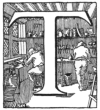 HE end of our pleasant task is reached; and it only
remains to thank the gentle reader who has kindly followed us, and to
re-assert as a parting word, that this work does not aspire to cover
every point which collectors may wish to have decided. Its modest
purpose will be served if any reader is led to take an interest in the
subject, if collectors find it useful as an assistant in intelligent
collecting, or an instigation to further and more careful research.
HE end of our pleasant task is reached; and it only
remains to thank the gentle reader who has kindly followed us, and to
re-assert as a parting word, that this work does not aspire to cover
every point which collectors may wish to have decided. Its modest
purpose will be served if any reader is led to take an interest in the
subject, if collectors find it useful as an assistant in intelligent
collecting, or an instigation to further and more careful research.
Undoubtedly, there lie in old garrets, book-cases, and forgotten
cupboards, dust-covered books, in which some fortunate searcher will one
day discover plates as yet unknown. It is hoped that any such will
publish their success for the benefit of the steadily increasing number
who find something interesting in these memorials of the past, and who
take pleasure in their preservation and pride in their possession.
{422}
INDEX.
A,
B,
C,
D,
E,
F,
G,
H,
I,
J,
K,
L,
M,
N,
O,
P,
Q,
R,
S,
T,
U,
V,
W.
 dams, John, 15, 85.
dams, John, 15, 85.
John Quincy, 85, 86.
Hannah, 18.
Akin, James, 117.
Albany Society Library, 84.
Aldrich, Thomas Bailey, 101, 343.
Allan, John, 7.
Allardice, S., 117.
Allegorical book-plates, 57.
Allen, Charles Dexter, his collection, 383.
Mrs. Frances Louise, 375.
Frances Louise and Charles Dexter, 365.
John, 46.
American Academy Arts and Sciences, 126, 163.
American Antiquarian Society, 78.
American collections, 377.
American collectors, 377, 385.
American members Ex Libris Society of London, 384.
Anderson, Alexander, 79-117, 120.
Andrew, John, 388.
Andrews, Henry, 57, 59.
Annin and Smith, 122.
Anthony, Henry B., 341.
Apprentices’ Library, 121.
Apthorp, 79.
Armorial book-plates, 35.
Arnold Arboretum, 72, 73.
Asay, E. G., 363.
Assheton, William, 9.
Atkinson, Theodore, 106.
Atlee, 8.
Avery Architectural Library, 72.
Avery, Samuel Putnam, 370.
Avril, Paul, 371.
Baer, Frank House, 341.
Baillie, W. E., 350.
Baldwin, Simeon, 18.
Bancker, Abraham, 143.
Bancroft, George, 31;
his motto, 32.
Barker, Mrs. E. H. L., 373;
her collection, 382.
Barrett, Lawrence, 102.
Bates, Albert C., 349, 350.
Bates, Arlo, 101.
Baxter, James Phinney, 347, 348.
Bayliss, Mary, 376.
Belcher, Jonathan, 9.
William, 171.
Benjamin, Marcus, 368, 369.
Betton, Thomas Forrest, 18.
Bibliography, American, 389.
English, 396.
French, 418.
Bierstadt, E. H., his collection, 382, 90.
Blackley, Absalom, 172, 173.
Blackwell, Henry, 33, 360;
his collection, 383.
Blanc, William, 9.
Bloomfield, 154.{423}
Book-plates:
metals used, 2.
used first in Southern colonies, 3.
literary, 6.
addresses on, 7, 8.
profession on, 9, 10.
essentials, 16.
dated, 18.
phrases on, 18.
armorial, 35.
purpose of, 35.
first, 35.
styles named, 37.
Early English, described, 37.
Jacobean, described, 41.
Chippendale, described, 47.
Ribbon and Wreath, described, 54.
Pictorial, 57.
Allegorical, 57.
Portrait, 78.
of special interest, 79.
reasons for grades of value, 79, 82, 85.
destruction of early, 80, 81.
signed, 82.
dated, 82.
of presidents of U.S., 85.
of royal officers, 86.
of loyalists, 88.
of titled Americans, 88.
of early authors, 89.
of early physicians, 89.
of early statesmen, 89.
of early clergymen, 89.
of early printers, 89.
of Revolutionary soldiers, 90.
of signers of the Declaration, 90.
heraldry on early, 113.
Booth, Edwin, 102.
Boston Public Library, 77.
Bowen, Abel, 67, 122.
Boyd, John, 123.
Brainerd, Miss Helen E., 382.
Brewster, Miss Jessie, 373.
British soldiers take books from Columbia College, 86.
Brooks, Henry M., 351.
Brothers in Unity, 67, 77.
Brown, 7.
Browne, Peter A., 118.
Bryant, Hubbard Winslow, 353.
Buck, John H., 341.
Burnet, John, 84.
Burrows, Charles W., 341.
Cabell, 9.
Callender, Joseph, 56, 123.
Campbell, John, 19.
Canadian plates.:
| | LIST NUMBER. |
| Kingston: St. John College, | 459 |
| Livius, | 505 |
| Stewart, | 826 |
| Uniacke, | 873 |
| Waterhouse, | 914 |
Carmichael, Hon. William, 39, 181.
Castle, Harry Allen, 342.
Chambers, John, 136.
Chandler, Gardiner, 146.
John, Jr., 53, 108.
Chase, Samuel, 79.
Childs, Cephas G., 127.
George W., his motto, 32;
his plate, 98.
Chippendale plates described, 47.
Chippendale plates by Hurd, 105.
by Dawkins, 131.
Clap, John, 18.
Clark, Clarence H., 371.
Clergymen’s plates, 89.
Cleveland, Stephen, 79, 80.
Clinton, De Witt, illus., 55.
Coffin, Mrs. Julia Dexter, 374.
Cole, J. N. Candee, his motto, 24.
Colesworthy, D. C., his severe motto, 21.
Collectors of book-plates, defence of, 11.
College book-plates, 57, 67.{424}
Columbia College Library, 81.
Congressional Library, 67.
Connecticut Historical Society, 75.
Connecticut plates:
| | LIST NUMBER. |
| Alsop, | 15 |
| Belcher, | 73 |
| Bull, | 118 |
| Chester, | 156 |
| Conn. Theol. Inst., | 178, | 179 |
| East Windsor Lit. Assn., | 246 |
| Farmington Library, | 266, | 267, | 268 |
| Goodwin, | 314 |
| Guilford Library, | 335 |
| Guilford Union Library, | 336 |
| Hanchett, | 346 |
| Hartford Library Co., | 350 |
| Ingersoll, | 404 |
| Jarvis, | 423 |
| Johnson, | 434-5 |
| King, | 457 |
| Knight, | 466 |
| Lord, | 516 |
| Musgrave, | 603 |
| Pease, | 651-2 |
| Pierpont, | 682 |
| Reed, | 723 |
| Robbins, Philemon, | 731 |
| Robbins, Thomas, | 732 |
| Sargeant, | 758 |
| Smith, Samuel, | 799 |
| Stowe, | 833 |
| Waldo, | 901 |
| Wethersfield Library, | 923 |
| Wetmore, | 924 |
| Williams, | 938-9 |
| Wolcott, | 953 |
| Woodbridge, | 955 |
| Yale College: Brothers in Unity, | 964-5-6 |
| Yale College: Linonian Society, | 967-8-9 |
| Yale College: Moral Library, | 970 |
| Yale College: Philotechnian Library, | 971 |
Cooper, Myles, 49.
Corning, John Herbert, 354.
Count Rumford, 158.
Courtenay, William Ashmead, 122, 356.
Cowan, Thomas C., his motto, 126.
Craven, 86.
Curtis, T. W., 18.
Curry, George (D. D.), his motto, 33.
Cushman, Charlotte, 373.
Dated plates, 82.
Dawkins, Henry, 6, 53, 127.
Dearborn, Nathaniel, 132.
Deats, H. E., 150, 365;
his collection, 381.
De Blois, Lewis, 79, 109.
Defence of book-plate collecting, 11.
De Forest, George B., 371.
Delaware plates:
| | LIST NUMBER. |
| Bayard, | 64 |
| Fisher, | 273 |
Denham, Edward, 356.
Dering, Thomas, 79, 84, 106.
Dickinson, David, 18.
Dinwiddie, Robert, 53.
Dix, Edward Spencer, his motto, 33.
Dix, Rev. Morgan, 346.
Dodge, Pickering, his collection, 383.
Doolittle, Amos, 132.
Drayton, 9.
Dubbs, Joseph Henry, 342, 345.
Du Bois, Henri Pene, his theory about book-plates, 358.
Dudley, Joseph, 38.
Duer, William, 195, 322.
Duhme, Mrs. Ophelia Fowler, 375, 382.
Dumaresque, 53.
Dummer, Jer., 39.
Durand, John, 47.
Early authors’ plates, 89.
Earliest dated plates (American), 82.{425}
Earliest plate by an American engraver, which is both dated and signed, 84.
Early English style described, 37.
Edwards, George Wharton, 351.
Eggleston, Edward, 102.
Elam, Samuel, 8, 13.
Elliston, Comptroller, 8, 86.
Ellwanger, George H., 340, 363.
Engravers, celebrated, 14.
Eno, Dr. H. C., 372;
his collection, 382.
Ernst, Harold Clarence, his motto, 32.
Eustace, Colonel, 8, 199.
Evarts, Jeremiah, 386.
Ewing, 200, 201.
Ex Libris Societies.
France, 388.
Germany, 387.
London, 387.
Fairman, Gideon, 134.
Farmington, Library of, 7, 62, 63, 65.
Field, Eugene, 35, 101.
First book-plate in America, I.
Fitz, Miss Louise, 382.
Flint, Mrs. Alonzo, 373.
Fogg, Dr. J. S. H., 342.
Forbes, Eli, 135.
Francis, Samuel W., his motto, 26.
Franklin, John, 79, 156.
Fraunces, Andrew G., 205.
French, Edwin Davis, 376.
Furnass, John Mason, 134.
Gallaudet, Edward, 136.
Elisha, 136.
Mrs. E. M., 382.
Garden, Francis, 159.
Gardiner, John, 9.
Garrett, Edmund H., 138, 376.
Georgia plates:
| | LIST NUMBER. |
| Belcher, | 74 |
| Wright, | 959 |
Gibbs, John Walters, 9.
Gilpin, Henry D., 127.
Godwin, Abraham, 137.
Goelet, John, 208, 209.
Goodwin, George, 6, 132.
Graeme, Elizabeth, 97.
Greenleaf, Daniel, 25.
Greene, Benjamin, 84.
Grolier Club, 73, frontis.
Haber, Louis J., 343, 349.
Hale, Robert, of Beverly, 8, 107.
Hapgood, Melvin H., 344.
Hark, J. Max, 342.
Harison, Richard, 150, 214, 215.
Harris, S., 137.
Harrison, Charles P., 138.
Hart, Gerald E., 350.
Hartman, J. Hiestand, 368.
Harvard College, 67, 112.
Hasty Pudding Society, 67, 68.
Hayden, Martin, 362.
Hays, Barrack, 218, 219.
Heraldry on early plates, 113.
on American plates, 346.
Hewins, Eben Newell, his collection, 380.
Hicks, Whitehead, 130.
Hill, Samuel, 78, 138.
Hitchcock, E. A., 368.
Holland, J. G., 99.
Hollingsworth, A. L., 29, 355.
Holloway, Edward Stratton, 362.
Holmes, Oliver Wendell, 32, 98.
Holt, Thomas, 18.
Holyoke, Edward Augustus, 79, 105.
Hone, Philip, 16.
Hooper, 59.
Hopson, W. F., 104, 370, 376.
Houx, J. W., his motto, 24.
Howland, 361.
Hoyt, F. W., 366.
Huntington, Rev. Wm. R., 356.
Hurd, Jacob, 158.{426}
Hurd, Nathaniel, 6, 38, 44, 46, 52, 67, 79, 104.
Hutton, Laurence, 101, 102.
Ingersoll, Jared, 8.
Jacobean plates described, 41.
Jacobean plates by Hurd, 109.
Jackson, Jonathan, 111.
Jackson, W., 55.
Jarvis, Samuel Farmar, 226, 227.
Jauncey, William, 226, 229.
Jayne, D. W., his motto, 21.
Jeffries, Dr. John, 89.
Jilson, Charles F., 357.
Jocelyn, S. S., 138.
Johnson, Rossiter, 103.
Johnson, Thomas, 6, 138.
Johnston, Thomas (engraver), 139
Johnston, Thomas (plate), 56, 230, 231.
Jones, Emanuel, 18.
Jones, Gabriel, 36.
Kearney, Francis, 139.
Keith, Sir William, 86.
Kempe, John Tabor, 86.
Kentucky plates:
| | LIST NUMBER. |
| Raphael, | 718-9 |
King, Clifford Julius, 352.
Kinloch, Francis, 79.
Kip, 59.
Kissam, Benjamin, 129, 51.
Kunze, Johan Christopher, 18.
Labels, 16, 18, 19.
Ladies’ plates:
Adams, Hannah, 18.
Allen, Frances L., 375.
Barker, Mrs. E. H. L., 373.
Bayliss, Mary, 376.
Brainerd, Helen E., 382.
Brewster, Jessie, 373.
Coffin, Julia S., 374.
Cushman, Charlotte, 373.
Duhme, Ophelia F., 375.
Flint, Mrs. Alonzo, 373.
Graeme, Elizabeth, 97.
Iselin, Helen, 225.
Miller, Margaret M., 375.
Shelton, Ada Stewart, 375.
Lady collectors, 382.
Lambert, John, his motto, 24.
Lawrence, Richard Hoe, 362, 368.
Lefferts, Marshall C., 352, 353.
Leighton, George E., 353.
Lemperly, Paul, 357, 359, 421.
Lenthall, John, 79, 153.
Lenox, 8.
Lewis, 7.
Lewis, W., 18.
Libbie, Fred J., 368;
his collection, 381.
Library book-plates, 57.
Library of Congress, 67.
Lichtenstein, Richard C., his plate, 346;
illus. 160;
his coll., 381;
his opinion of the George Washington plate, 91.
Linonian Library, 67, 69, 70.
Livingston, Edward, 237, 238.
Livius, 88.
Lodge, Abraham, 240.
Longfellow, Henry W., his motto, 30.
Lord, William, 5.
Loyalists who had book-plates, 88.
Lowell, John, 115.
Ludwell, 8.
Macbeth, George Alexander, 79, 352.
Maine Historical Society, 75.
Maine plates:
| | LIST NUMBER. |
| Gardiner, | 297 |
| Morrison, | 597 |
| Vaughan, Benjamin, | 889 |
| Vaughan, Samuel, Jr., | 892 |
| Vaughan, William, | 893{427} |
Malvians, 312, 339.
Manigault, Peter, 52.
Mann, John Preston, 59, 245.
Mann, Timothy, 27.
Martin, Luther, 155.
Marvin, Samuel Wesley, 366.
Maryland plates:
| | LIST NUMBER. |
| Baltimore Liby. Co., | 50 |
| Bonaparte, | 89 |
| Bozman, | 101 |
| Calvert, | 133 |
| Carmichael, | 135 |
| Carroll, | 138 |
| Chalmers, | 144 |
| Chase, | 150 |
| Duvall, | 243 |
| Forman, | 280 |
| Georgetown College, | 299, 300 |
| Guinaud, | 337 |
| Johnston, | 436 |
| Kerr, | 452 |
| Key, | 453 |
| McTavish, | 544 |
| Maxcy, | 569 |
| Read, | 722 |
| Roberts, | 733 |
| Sprigg, | 816 |
| Stewart, | 824 |
| Tayloe, | 845 |
Massachusetts Historical Society, 78.
Massachusetts plates:
| | LIST NUMBER. |
| Adams, J., | 3 |
| Adams. J. Q., | 4, 5, 6, 7 |
| Agar, | 8 |
| Allen, | 13 |
| American Academy, | 17 |
| Andover Theol. Inst., | 19 |
| Andrew, | 20 |
| Andrews, | 22, 23, 24 |
| Apthorp, | 26, 27, 28, 29 |
| Atkinson, | 38, 39 |
| Auchmuty, | 42 |
| Baldwin, | 46, 47 |
| Barrell, | 58 |
| Barroll, | 59 |
| Beck, | 68 |
| Belcher, | 71, 72 |
| Blake, | 82 |
| Boston Architectural Library, | 983 |
| Boston Shakespeare Circulating Library, | 93 |
| Boston Social Law Libr’y, | 94 |
| Bowdoin, | 97 |
| Bowdoin College, | 98 |
| Boylston Med. Libr’y, | 99, 100 |
| Brazer, | 103 |
| Brown, | 112 |
| Cabot, | 126 |
| Callender, | 132 |
| Cary, Alpheus, | 140 |
| Cary, Thomas, | 142 |
| Chandler, Gardiner, | 147 |
| Chandler, John, Junr., | 148 |
| Chandler, Rufus, | 149 |
| Chauncey, | 151, 152, 153 |
| Child, Isaac, | 158, 159 |
| Child, Thomas, | 160 |
| Cleveland, | 170 |
| Coffin, | 173 |
| Coffin, Hector, | 174 |
| Coffin, John, | 175 |
| Cooley, | 182 |
| Courtenay, | 184 |
| Cranch, | 187 |
| Curwen, | 192 |
| Cushing, | 193 |
| Dana, E. T., | 200 |
| Dana, Francis, | 201 |
| Dana, R. H., | 202 |
| Danforth, | 203 |
| Dartmouth College, | 204 |
| Dartmouth College, Social Friends, | 205 |
| De Blois, L., | 212 |
| Dedham: Scripture Society, | 214 |
| Dering, N.H., | 218 |
| Dering, T., | 219, 220 |
| Dexter, | 222 |
| Dill, | 223 |
| Dolbeare, | 225 |
| Duane, | 232 |
| Dudley, | 233 |
| Dumaresque, | 236 |
| Dummer, | 237 |
| Emerson, | 256 |
| Erving, | 258, 259 |
| Evarts, | 261 |
| Everett, | 263 |
| Forbes, | 279 |
| Foster, | 281 |
| Foster, I., | 282 |
| Fownes, | 284 |
| Foxcroft, | 285 |
| Francis,{428} | 286 |
| Franklin, | 287 |
| French, | 291 |
| Gardiner, | 296 |
| Gray, | 322 |
| Green, F., | 323 |
| Green, Garrett, | 324 |
| Green, T., Jr., | 325 |
| Greene, B., | 326, 327 |
| Greene, D., | 329 |
| Greene, T., Jr., | 330 |
| Greenleaf, | 331 |
| Greenough, | 332 |
| Hale, | 339 |
| Hallowell, | 343 |
| Harris, | 347 |
| Harvard Coll. Libr’y, | 351-5 |
| Harvard College Hasty Pudding Society, | 356 |
| Harvard College Porcellean Libr’y, | 357, 358, 359 |
| Haverhill Library, | 987 |
| Heath, | 371 |
| Henderson, | 373 |
| Hill, | 380 |
| Hoar, | 381 |
| Holyoke, E. A., | 385 |
| Holyoke, | 386 |
| Humphrey, | 396 |
| Hurd, | 401 |
| Jackson, Jas., | 418 |
| Jackson, Jon., | 419 |
| Jeffries, | 426-7 |
| Jenkins, | 429 |
| Johnson, Thomas, | 432 |
| Jones, | 441 |
| Lisle, H. M., | 490 |
| Livermore, | 491 |
| Lodge, | 510 |
| Loring, | 517 |
| Lowell, John, | 520 |
| Lowell, John, Jr., | 521-2 |
| Lowell, John Amory, | 523 |
| Mann, | 550 |
| Marston, | 556 |
| Mason, | 560 |
| Mass. General Court, | 561 |
| Mass. Historical Society, | 562 |
| Mass. Medical Society, | 563 |
| Mass. Normal School, | 564 |
| Minot, | 579-80 |
| Murray, | 600 |
| Newburyport Athenæum, | 606 |
| Newell, | 607 |
| Newton, | 609 |
| Oliver, Andrew, | 625 |
| Oliver, Francis J., | 991 |
| Osborne, | 628 |
| Otis, Harrison Gray, | 629 |
| Otis, James, | 630 |
| Parker, B., | 639 |
| Parker, James, | 641 |
| Parker, Samuel, | 642 |
| Parkman, | 643 |
| Parsons, | 644 |
| Peirson, | 649 |
| Pepperell, | 664 |
| Perkins, | 665 |
| Phillips, | 673 |
| Phillips Academy, Andover, | 674 |
| Phillips Academy, Exeter, | 675 |
| Pickering, | 679 |
| Pierpont, | 681 |
| Poor, | 687 |
| Prescott, William, | 696 |
| Prescott, William H., | 697 |
| Price, | 700 |
| Prince, | 704 |
| Putnam, | 711 |
| Quincy, | 712 |
| Rivoire, | 730 |
| Royall, | 743 |
| Russell, | 747 |
| Sargent, Daniel, Junr., | 759 |
| Sargent, Epes, | 760 |
| Sargent, Winthrop, | 761 |
| Scotton, John, | 768 |
| Sears, | 769 |
| Secombe, | 771 |
| Selfridge, | 773 |
| Sheppard, | 777 |
| Simpson, | 783 |
| Smith, Hezekiah, | 790 |
| Smith, William, | 803 |
| Spooner, | 813 |
| Stearns, | 820 |
| Sumner, Thomas W., | 839 |
| Sumner, W. H., | 840 |
| Swan, | 842 |
| Swett, | 843 |
| Thomas, | 853 |
| Thorndike, | 858 |
| Tracy, | 863 |
| Tufts, | 868 |
| Tuttle, | 869 |
| Tyler, Andrew, | 870 |
| Tyler, Joseph, | 871 |
| Tyng, | 872 |
| Vassall, | 888 |
| Vaughan, | 891 |
| Vose, Benjamin,{429} | 899 |
| Vose, Solomon, | 900 |
| Warren, John C., | 908 |
| Warren, J. Mason, | 909 |
| Webster, | 918 |
| Wetmore, | 926 |
| Wheelwright, | 929 |
| Williams, | 934 |
| Williams, | 942 |
| Williams, John, | 937 |
| Williams, John, | 940 |
| Williams, John C., | 941 |
| Willis, | 944 |
| Wilson, David, | 945 |
| Wilson, James, | 946 |
| Winthrop, William, | 949 |
| Winthrop, John, | 950 |
| Worcester Circulating Library, | 956 |
| Young, | 974 |
Matthews, Brander, 99.
Mauran, James Eddy, 16, 98;
his collection, 378.
Maverick, Peter, 142.
Peter Rushton, 6, 56, 140.
McGinley, Mary, 19.
McIlvaine, Bloomfield, 57, 157.
McKee, Thomas J., 357.
McMurtrie, 59.
Member of the Ex Libris Society, 384.
Middleton, Peter, 10.
Miller, Margaret M., 375.
Minot, 40.
Moat, Horatio Shepherd, 56.
Moral Library, 6, 7.
Morgan, Appleton, 341.
Morgan, Henry A., 356.
Mottoes, use of, 16, 17.
different kinds, 21.
languages used on, 21.
against book-borrowing, 21-27.
from the Bible, 21, 22.
school-boy, 23.
care of books, 25-27.
poetical, 24-26, 28.
generous, 27.
in praise of books and reading, 28.
quotations used, 28.
Mounting plates, ways of, 382.
Murray, David, 353.
John, Rev., 252, 253.
Name-labels, 16, 18, 19.
New England book-plates, 4, 87.
New Hampshire plates:
New Jersey plates:
| | LIST NUMBER. |
| Antill, | 25 |
| Bloomfield, | 87 |
| Brearly, | 104 |
| Edgar, | 986 |
| Kemble, | 450 |
| Ogden, | 621 |
| Read, | 721 |
| Stockton, | 830 |
| Trenchard, | 864 |
| Wallace, | 904 |
New London Public Library, 73.
New York plates:
| | LIST NUMBER. |
| Anonymous (French style), | 1 |
| Agnew, James, | 9 |
| Albany Society Library, | 11 |
| Allan, John, | 12 |
| Anderson, | 18 |
| Ball, | 48 |
| Bancker, | 51 |
| Bay, | 63 |
| Bedlow, | 69 |
| Betts, | 77 |
| Blackley, | 81 |
| Booth, | 91 |
| Brasher, | 102 |
| Bridgen, | 105 |
| Brooks, | 108 |
| Brown, | 110 |
| Bruen, | 115 |
| Burnet, | 120, 121 |
| Cadena, | 127, 128, 129 |
| Chambers, | 146 |
| Champion, | 984 |
| Clarke, Alfred, | 164 |
| Clarke, Geo., | 165 |
| Clarkson, David,{430} | 167 |
| Clarkson, M., | 168 |
| Clinton, | 171 |
| Cock, | 172 |
| Colden, | 176 |
| Columbia College Libr’y, | 177 |
| Connolly, | 180 |
| Constable, | 181 |
| Cooper, | 183 |
| Cushman, | 194 |
| Cutting, | 198 |
| Cuyler, | 199 |
| De Peyster, | 216 |
| De Witt, | 221 |
| Duer, W. A., | 234 |
| Duer, W., | 235 |
| Duncan, J. H., | 238 |
| Duncan, R. H., | 239 |
| Dunning, C. E., | 240 |
| Dunning, C. S., | 241 |
| Durand, | 242 |
| Edwards, | 248 |
| Ellery, | 252 |
| Elliott, | 253 |
| Elliston, | 254, 255 |
| Erasmus Hall Library, | 256 |
| Eustace, | 260 |
| Everdell, | 262 |
| Fish, | 272 |
| Foot, | 276 |
| Fraunces, | 289 |
| Gallaudet, | 293 |
| Gardiner (Gardiner’s Island), | 294 |
| Gardiner, John (Gardiner’s Island), | 295 |
| Gibs, | 306 |
| Giles, | 308 |
| Goelet, | 313 |
| Gourgas, | 316 |
| Gracie, | 317 |
| Hamersley, | 344 |
| Hanson, | 348 |
| Harrison, | 349 |
| Hawks, | 360 |
| Herbert, | 374 |
| Hicks, Elias, | 376, 377 |
| Hicks, Whitehead, | 378 |
| Hoffman, | 382 |
| Horsmanden, | 394 |
| Hunter, | 400 |
| Inglis, | 406 |
| Iselin, | 416 |
| Jauncey, | 424 |
| Jay, | 425 |
| Johnson (Sir Wm. ?), | 430 |
| Johnson, J. I., | 431 |
| Johnston, John, | 437 |
| Johnston, Thomas, | 439 |
| Jones, S., | 442 |
| Jones, W. G., | 443 |
| Judah, | 444-5 |
| Keese, J., | 446-7 |
| Kempe, | 451 |
| King, | 456 |
| Kip, I. L., | 461 |
| Kip, L., | 462-3 |
| Kissam, | 465 |
| Lenox, | 483 |
| Lewis, Morgan, | 486 |
| Livingston, Brockholst, | 492 |
| Livingston, Edward, | 493 |
| Livingston, John R., | 494 |
| Livingston, Maturin, | 495 |
| Livingston, Mortimer, | 496 |
| Livingston, Peter R., | 497 |
| Livingston, Robert L., | 498 |
| Livingston, Robert R., | 499-500 |
| Livingston, Walter, | 501 |
| Livingston, Wm., | 502 |
| Livingston, Wm. Smith, | 503 |
| Lloyd, | 507-8 |
| de Lotbiniere, | 518 |
| Low, | 519 |
| Ludlow, Gary, | 524 |
| Ludlow, Charles, A.M., | 525 |
| Ludlow, Gabriel Verplank, | 526 |
| Ludlow, Gab. Wm., | 527 |
| Ludlow, George, | 528 |
| Ludlow, John Cooke, | 529 |
| McCoun, | 534 |
| McLean, | 541 |
| Malvians, | 989 |
| Masterton, | 565 |
| Maxwell, | 570 |
| Meredith, | 573 |
| Middleton, | 575 |
| Moat, | 584 |
| Moore, Lambert, | 585 |
| Moore, Nath’l F., | 586 |
| Moore, Samuel W., | 587 |
| Morris, Gouverneur, | 591 |
| Morris, James, | 593 |
| Murray, | 601 |
| New York City: |
| Apprentices’ Library, | 610 |
| College of Pharmacy, | 611 |
| College of Phys. and Sur., | 612 |
| Society Library, | 613-4-5 |
| Typographical Soc.,{431} | 616 |
| Ogden, | 620 |
| Orphan Asylum, | 626 |
| Panton, Francis, | 636 |
| Panton, Francis, Jr., | 637 |
| Pasley, | 646 |
| Paulding, J. K., | 647 |
| Paulding, W., | 648 |
| Philipse, | 671 |
| Pierce, | 680 |
| Pintard, | 685-6 |
| Popham, | 688 |
| Pride, | 701 |
| Provoost, John, | 707 |
| Provoost, Samuel, | 708-9 |
| Pruyn, | 710 |
| Ray, | 720 |
| Rickets, | 728 |
| Robinson, | 737 |
| Roome, Jacob, | 739 |
| Roome, John L. C., | 740 |
| Rosseau, | 741 |
| Russell, | 746 |
| Rutgers, | 748 |
| Rutherford, | 749 |
| St. George’s Church, | 752-3 |
| Schuyler, Philip, | 762 |
| Schuyler, Samuel, | 763 |
| Sedgwick, | 772 |
| Seton, | 775 |
| Silvester, | 782 |
| Sitgreaves, | 785 |
| Smith, G. A., | 791 |
| Smith, James Scott, | 792 |
| Smith, John Adams, | 794 |
| Smith, Thomas, Junr., | 801 |
| Smith, Thomas J., | 802 |
| Smith, William, | 804 |
| Smith, William, A.M., | 805 |
| Smith, William P., | 808 |
| Spry, | 817 |
| Stanford, | 818 |
| Stephens, | 821 |
| Stewart, | 825 |
| Stone, | 831 |
| Stringer, | 834 |
| Sturges, | 836 |
| Stuyvesant, | 837 |
| Sword, | 844 |
| Ten Broeck, | 851 |
| Thompson, | 855 |
| Tillotson, | 861 |
| Tomlinson, | 862 |
| Tripp, | 865 |
| Van Berckel, | 878 |
| Van Buren, | 879 |
| Van Cortlandt, | 880 |
| Van Ness, | 881 |
| Van Rensselaer, Jer., | 882 |
| Van Rensselaer, K. K., | 883 |
| Van Rensselaer, P., | 884 |
| Van Rensselaer, Stephen, | 885 |
| Van Wyck, | 886 |
| Varick, | 887 |
| Wall, | 903 |
| Watkins, | 916 |
| Watts, | 917 |
| Wetmore, | 925 |
| Whitebread, | 931 |
| Wilkes, | 933 |
| Williams, | 935 |
| Wisner, | 952 |
| Wynkoop, Augustus, | 960 |
| Wynkoop, C. C., | 961 |
| Wynkoop, Peter, | 962 |
| Yates, Christopher C., | 972 |
| Yates, Peter W., | 973 |
New York State Agricultural Society, 70.
New York Society Library, 60, 61, 62, 74.
New York plates, 87.
Newell, Timothy, 3.
Nomenclature, 37.
North Carolina plates:
| | LIST NUMBER. |
| Edwards, | 249 |
| Hooper, | 388 |
| Innes, | 414 |
| Iredell, | 415 |
| Spaight, | 812 |
| University of North Carolina, | 619 |
Norton, Charles Eliot, 346.
Oliver, Andrew, 50.
Orphan Asylum, 70.
Otis, Harrison Gray, 11.
Page, Francis, 9, 41, 82.
Paine, Nathaniel, 352;
his collection, 383.
Panton, Francis, 258, 259.
Parker, James, 57, 58.
Parker, Samuel, 57, 260.
Parmelee, George L.,{432} 355.
Pelton, Oliver, 145.
Penn, Edmund, 7.
Penn, William, his motto, 30, 82, 86, 263.
Pennington, Edward, 34, 59.
Pennsylvania Historical Society, 75.
Pennsylvania plates:
| | LIST NUMBER. |
| Abercrombie, James, | 2 |
| Aitkin, Robert, | 10 |
| Allison, Joseph J. | 14 |
| Assheton, | 35, 37 |
| Atlee, | 40 |
| Bancker, | 52, 53, 54, 55 |
| Bartram, | 61 |
| Bayard, | 65 |
| Beatty, | 67 |
| Bond, | 90 |
| Boudinot, | 96 |
| Brown, | 109 |
| Browne, | 113 |
| Chambers, | 145 |
| Chauncey, | 154 |
| Chawney, | 155 |
| Child, | 157 |
| Day, | 209 |
| Denny, | 215 |
| Ewing, | 264 |
| Gallitin, | 292 |
| Gilpin, | 310-311 |
| Graeme, | 318 |
| Graham, | 319 |
| Griggs, | 334 |
| Gurney, | 338 |
| Hall, | 340 |
| Hamilton, | 345 |
| Herman, | 375 |
| Hopkinson, F., | 390 |
| Hopkinson, J., | 391 |
| Inglis, | 408 |
| Ingraham, | 409 |
| Ingraham, E. D., | 410-13 |
| Keith, | 449 |
| Kingston, | 458 |
| Kunze, | 988 |
| Lardner, | 472 |
| Lenox, | 482 |
| Lewis, J. S., | 484 |
| Lewis, M., | 485 |
| Logan, Charles, | 512 |
| Logan, James, | 513 |
| Logan, William, | 514 |
| Loganian Library, | 515 |
| McFarlan, | 536 |
| McMurtrie, | 542-3 |
| Matthews, | 567 |
| Miller, | 577 |
| Mitchell, | 582 |
| Morgan, | 589 |
| Morris, J., | 592 |
| Norris, Geo. W., | 617 |
| Morris, Isaac, | 618 |
| Osborne, | 627 |
| Penn, Thomas, | 655 |
| Penn, William, | 656 |
| Penn (anonymous), | 657 |
| Pennington, | 658 |
| Pennington, Edward, | 659-60 |
| Pennington, T. H., | 661 |
| Pennsylvania Historical Society, | 662-3 |
| Philadelphia: |
| Apprentices Library Co., | 667-8 |
| Carpenters Company, | 669 |
| Library Company, | 670 |
| Poulson, | 689 |
| Powel, Samuel, | 690 |
| Powell, Hare Samuel, | 691 |
| Powell, John H., | 692 |
| Priestley, | 702 |
| Proctor, | 706 |
| Riddle’s Circulating Library, | 729 |
| Rush, | 745 |
| St. Clair, | 751 |
| Shippen, Edward, | 779 |
| Shippen, Robert, | 780 |
| Smith, | 795 |
| Stille, | 827 |
| Taylor, | 848 |
| Thomas, | 852 |
| Vaux, | 894 |
| Warren, | 911 |
| Weiberg, | 994 |
| Wiseman, | 951 |
| Wood, | 954 |
Philadelphia plates, 88.
Philipse, Frederick, 42.
Phœnix Society, 76.
Physicians’ plates, 89.
Pictorial book-plates, 57.
Pike, Nicolas, 17.
Pinfold, Charles, 9.
Pintard, John, 79, 120.
Plates by Dawkins, 131.
Plates of special interest,{433} 79.
Poole, Lucius, 362.
Porcellian Club, 67.
Portrait plates, 78.
Potter, William W., 17.
Power, James, 269, 270.
Prescott, William, 32.
Presidents of U. S. who have book-plates, 85.
Prichard’s Circulating Library, 71.
Prince, Thomas, 84.
Printed labels, 16, 18, 19.
Professions named on book-plates, 9.
Quincy, Josiah, 87.
Randolph, Peyton, 9.
Ravenel, Daniel, 341.
Rawdon, R., 146.
Rawle Law Offices, 344.
Recent plates, 340.
Reed, Elijah F., 7.
Revere, Paul, 6, 146;
his plate, 148.
Revolutionary soldiers’ plates, 90.
Reynolds, Hannah, 17.
Rhode Island plates:
| | LIST NUMBER. |
| Barton, | 60 |
| Brown, | 111 |
| De Blois, N. J., | 213 |
| Elam, | 250 |
| Fowler, | 283 |
| Gilpin, | 312 |
| Marchant, | 553 |
| Redwood Library, | 608 |
| Spooner, | 814 |
| Warren, | 910 |
Ribbon and Wreath plates described, 54.
Ribbon and Wreath plates by Hurd, 111.
Robbins, Thomas, 6.
Roberts, George C. M. (M.D.), 6.
Rollinson, 56, 149.
Rowe, Henry S., 376.
Rowfant Club, Cleveland, 75.
Royal officers who had book-plates, 86.
Russell, John E., 357.
Russell, Thomas, 59, 125.
Sage, Dean, 360, 361.
Sandham, Henry, 77.
Sargeant, Jacob, 46.
Schlaick, Fred C., 362.
School-boy doggerel, 23.
Scott, Winfield, 103.
Sears, George Edward, 358.
Selfridge, Thomas O., 22.
Seton, Monsignor, 344.
Seymour, George Dudley, 369, 370.
Shelton, Miss Ada Stewart, 375.
Sherborn, C. W., 370.
Signed plates, 82.
Signers of the Declaration who used book-plates, 90.
Sill, Geo. Imbrie, 353.
Smith, G. A., 159.
Smith, Samuel, 282, 283.
Smith, William P., 44, 45.
Smithers, J., 151.
Social Friends Society, 67.
Social Law Library, 66.
Society for Propagating the Gospel in Foreign Parts, 65, 66.
South Carolina plates:
| | LIST NUMBER. |
| Beresford, | 76 |
| Drayton, | 228 |
| Drayton, J., | 229 |
| Drayton, W., | 230 |
| Drayton, W. H., | 231 |
| Gibbes, E. A., | 302 |
| Gibbes, J. S., | 303 |
| Gibbs, J. W., | 304, 305 |
| Hall, | 341 |
| Hayne, | 364 |
| Hayward, | 367 |
| Hayward, T., | 370 |
| Horry, | 393 |
| Inglis,{434} | 406 |
| Johnson, W. L., | 433 |
| Johnston, | 438 |
| L——, | 469 |
| Laurens, | 473 |
| Mackey, | 546 |
| Manigault, | 548 |
| March, | 552 |
| Middleton, | 574 |
| Petigru, | 666 |
| Phœnix Society, | 676 |
| Pownall, | 695 |
| Preston, | 698 |
| Prioleau, | 705 |
| Protestant Episcopal Society, | 811 |
| Rutledge, | 750 |
| Shubrick, | 781 |
| Smith, William, | 806 |
| Smith, William L., | 807 |
| Strobel, | 835 |
| Taylor, | 847 |
| Waties, | 915 |
| Whitridge, | 932 |
| Young, | 976 |
Southern book-plates, 3, 81, 88.
Sparrow, T. (engraver), 20, 151.
Specially interesting plates, 79.
Spooner, Joshua, 44, 110, 111.
Sprigg, Richard, 20.
Statesmen’s plates, 89.
Stauffer, J. McN., 373.
Stedman, Alexander, 17.
Edmund Clarence, 100.
Stevenson, E. Irenæus, 351.
Stewart, Anthony, 48.
Stone, Arthur Robinson, 362, 364.
Styles of book-plates, 37.
Sullivan, John, 56.
Sutro Library, San Francisco, 73.
Swett, J. B., 59, 289.
Tayloe, 7, 291.
Tazewell, 8.
Terry, William D., 152.
Thackara, James, 152.
Thaxter, Thomas, 17.
Thomas, Isaiah, 83.
Thomas, I. G., 18.
Ticknor, George, his motto, 24.
Tiffany, John K., 363.
Titled Americans who have book-plates, 88.
Trenchard, Lieut. E., 10, 12.
Trenchard, James, 152.
Trumble, Alfred, 357.
Tuberville, 2, 8.
Turner, James, 6, 79, 155.
Tyler, Andrew, 46, 111.
Tyler, John, 85.
Uncertain plates, 11.
Union Circulating Library, Philadelphia, 71.
United States:
University Club, Washington, 75.
Vallance, John, 157.
Van Allen, Adam, 367.
Vanamee, William, 349.
Varick, Richard, 295.
Vassal, John, 79, 114.
Vaughan, Samuel, 53.
Vermont plates:
| | LIST NUMBER. |
| Stevens, | 822-3 |
Virginia book-plates, 8.
Council plate, 297.
Virginia plates:
| | LIST NUMBER. |
| Ambler, | 16 |
| Andrews, | 21 |
| Archer, | 21, 32 |
| Armistead, | 33 |
| Banister, | 57 |
| Bathurst, | 62 |
| Bayley, | 66 |
| Beverley, | 78-80 |
| Bolling, | 88 |
| Boucher, | 95 |
| Brimage, | 106 |
| Bruff, | 116 |
| Burke, | 119 |
| Byrd,{435} | 123 |
| Cabell, Dr. George, | 124 |
| Cabell, Samuel J., | 125 |
| Carroll, | 136, 137 |
| Cary, | 141 |
| Cay, | 143 |
| Chin, | 985 |
| Craven, | 188 |
| Custis, George W., | 195 |
| Custis, John P., | 196 |
| Davenport, | 206 |
| Dinwiddie, | 224 |
| Dove, I., | 226 |
| Dove, S. E., | 227 |
| Fairfax, | 265 |
| Fauquier, | 269 |
| Fitzhugh, | 274 |
| Fitzhugh, William Junr., | 275 |
| Gilmer, | 309 |
| Hay, | 361 |
| Holladay, | 383 |
| Hubard, | 395 |
| Inglis, | 407 |
| Jones, | 440 |
| King, | 454 |
| Kinloch, | 460 |
| Lee, | 476 |
| Lee, E., | 477 |
| Lee, P. L., | 479 |
| Leiper, | 480 |
| Lightfoot, Philip, | 487 |
| Lightfoot, William, | 488 |
| Ludwell, | 530 |
| McKenzie, Kenneth, | 539 |
| McKenzie, William, | 540 |
| Mackay | 545 |
| Manning, | 551 |
| Marshall, | 555 |
| Mercer, Hugh, | 571 |
| Mercer, John, | 572 |
| Milner, | 578 |
| Murray, James, | 598 |
| Murray, John, | 599 |
| Murray, Earl Dunmore, | 602 |
| Nelson, | 604 |
| Page, | 633 |
| Parke, | 638 |
| Phillips, | 672 |
| Power, | 694 |
| Randolph, John, | 713 |
| Randolph, John of Roanoke, | 714 |
| Randolph, John, Jr., | 715 |
| Randolph, Peyton, | 716 |
| Randolph, Ryland, | 717 |
| Routh, | 742 |
| Scott, Gustavus, | 765 |
| Scott, Winfield, | 767 |
| Semple, | 774 |
| Skelton, | 786 |
| Skipwith, | 787 |
| Smith, John A., | 793 |
| Smith, Robert, | 797 |
| Smith, Thomas, | 800 |
| Spotswood, | 815 |
| Stith, | 828 |
| Stott, | 832 |
| Tayloe, | 846 |
| Tazewell, | 850 |
| Thompson, | 854 |
| Thornton, | 859 |
| Thruston, | 860 |
| Tuberville, | 866 |
| Tucker, | 867 |
| Virginia Council Chamber, | 897-8 |
| Waller, | 905 |
| Washington, Bushrod, | 912 |
| Washington, George, | 913 |
| Welford, | 921 |
| Wormeley, | 957-8 |
| Wythe, | 963 |
Volapük motto, 34.
Wadsworth, Jeremiah, iv.
Wallace, Allen, 364.
Waller, 8.
Warren, John C., 299, 300.
W., 300, 301.
Washington, Bushrod, 95, 96, 300.
Washington, George, his plate, 90;
his motto, 30, 79;
fraudulent, 91;
genuine, 94.
Washington, D.C., plates:
| | LIST NUMBER. |
| Lenthall, | 481 |
| Ruff, | 744 |
Watkinson Library, Hartford, 75.
Way, W. Irving, 368.
Webster, Daniel, 97.
Welsh mottoes, 33.
Weld, John (of Pomfret, Conn.), 18.
Wentworth,{436} 53, 107.
West India plates:
| | LIST NUMBER. |
| Ashwell, | 34 |
| Assheton, | 36 |
| Beete, | 70 |
| Blanc, | 83 |
| Blenman, | 86 |
| Byam, | 122 |
| Campbell, | 134 |
| Edwards, | 247 |
| Heming, | 372 |
| Hunter, | 399 |
| Jamaica, Bishop of, | 421 |
| Knox, | 468 |
| Martin, | 557 |
| Pinfold, | 683, 684 |
| Robertson, | 736 |
| Royall, | 743 |
| Salter, | 754 |
| Vaughan, | 890 |
| Williams, William, | 936 |
| Wilson, John, | 947 |
| Wilson, John, | 948 |
Wethersfield Library plate, 133.
Wetmore, Prosper, 56.
Wetmore, William, 147.
Wheeler, Joseph H., 361.
White, Richard Grant, 101.
Williams, Chauncey Lawrence, 364.
Williams, John, 54.
Williams, Rev. John, 82.
Williams, John C., 111.
Wilson, Francis, 376.
Winslow, John F., 346.
Woolworth, Aaron, 17.
Worcester Circulating Library, 23.
Wormeley, 8.
Wynkoop, Richard, 56.
{437}
*** END OF THE PROJECT GUTENBERG EBOOK 47682 ***
![]() will bring up a larger version of the illustration.
will bring up a larger version of the illustration.
